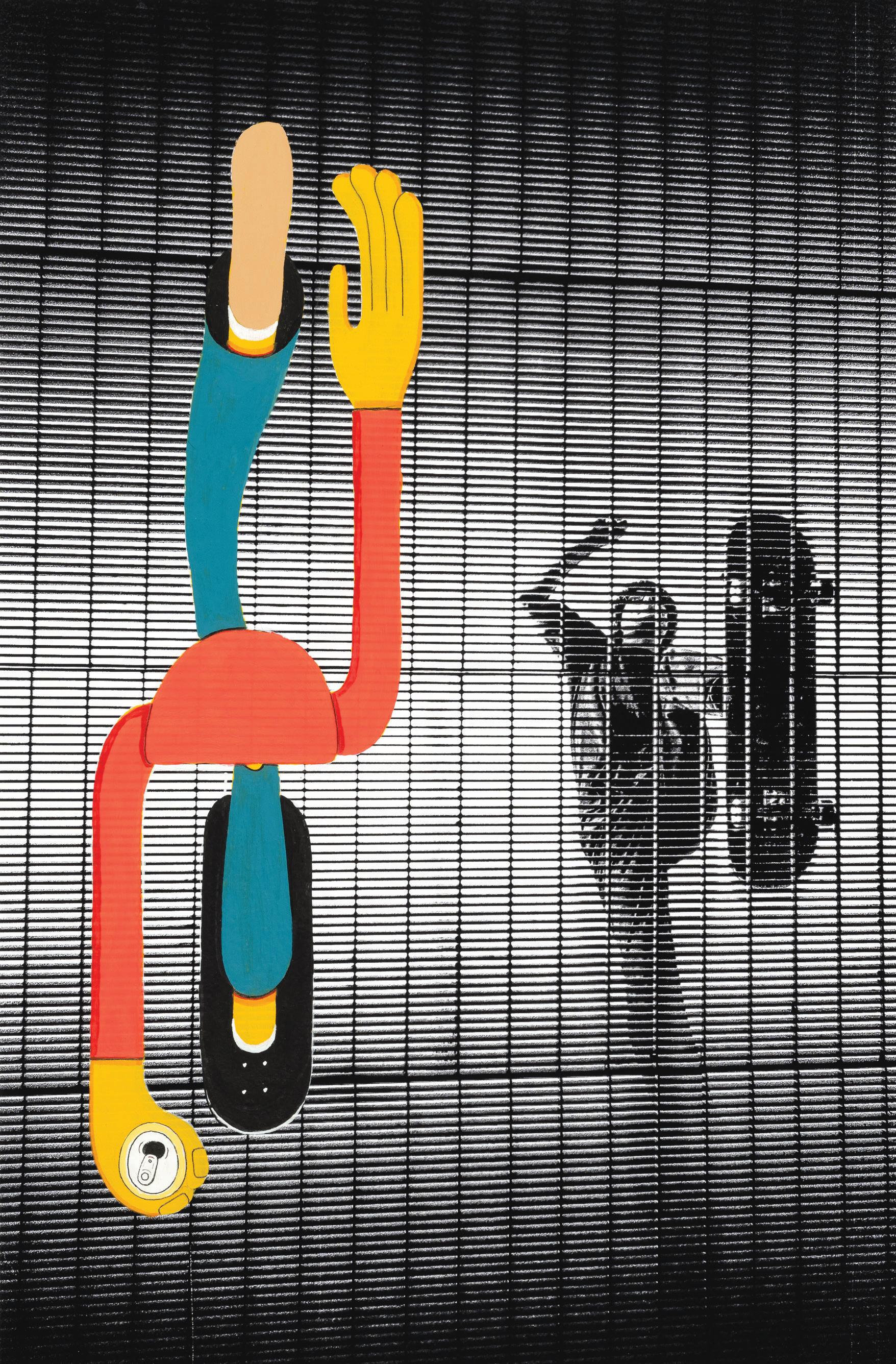
 Photo & Art Annual Bomb Snow.
Photo & Art Annual Bomb Snow.
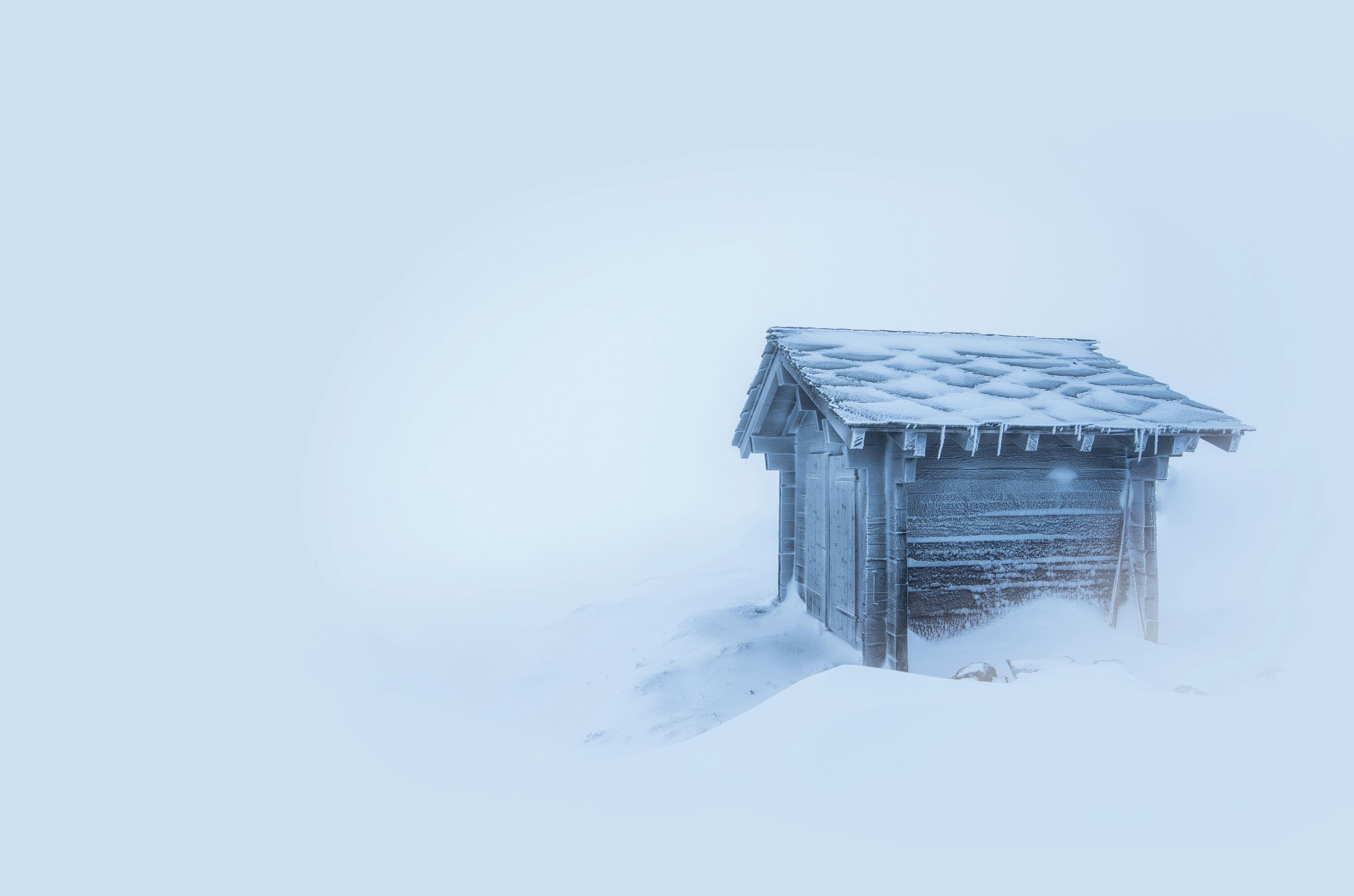



永遠に変わることの無いものは、ここから生みだされる

BERINGIA.world BOZEMAN | TOKYO | WANAKA | VERBIER
Photo: Diego Schläppi
Materials
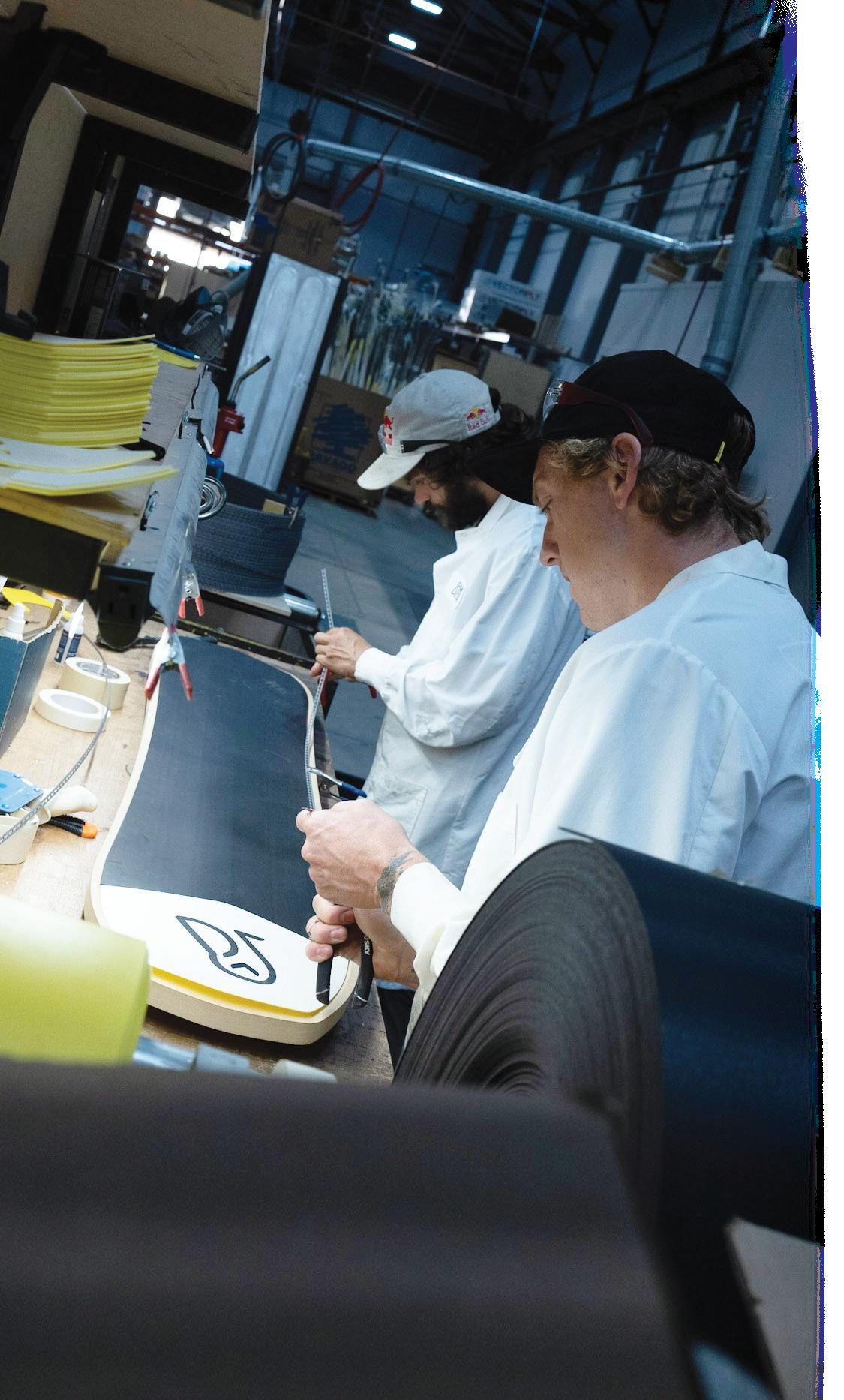
WNDR Alpine’s new BelleTour splitboard and BelleAire solid are equipped with SpiralMade™ materials built from reclaimed production waste, and AlgalTech® materials made from microalgae oil, featuring better chatter-reducing properties than the petroleum-based materials that preceded them.

.


Join the biomanufacturing revolution: wndr-alpine.com Pep Fujas | Team Rider & Marketing Manager: Alex Andrews ALGAE IN , © 2022 WNDR. All rights reserved. WNDR® and the Owl Design Logo are trademarks of Checkerspot and WNDR.
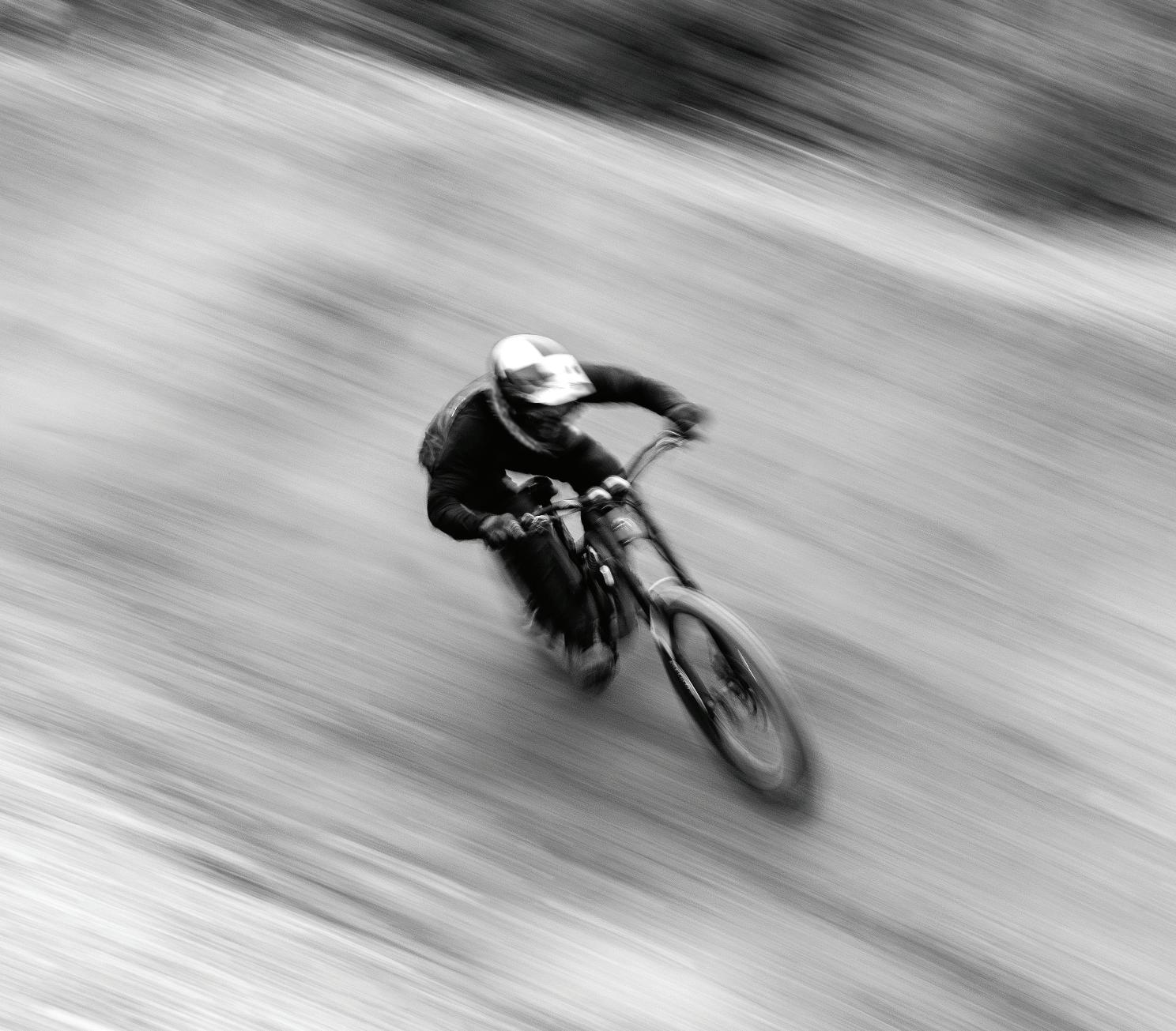
































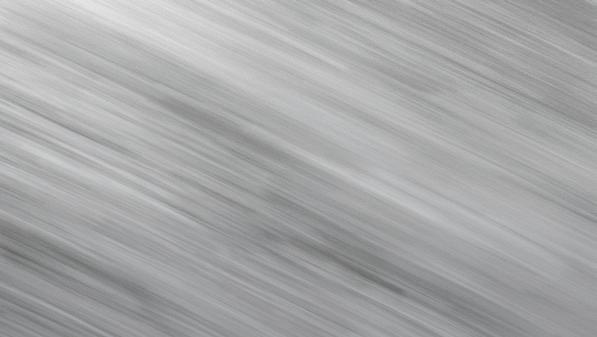















Making art precipitates self-doubt, stirring deep waters that lay between what you know you should be, and what you fear you might be.
- David Bayles, Art and Fear
Art is a funny thing. There’s a voice within us all that wants to create. A mysterious consciousness of sorts that is equal parts curiosity, self-expression, and fear. For some of us, this is a constant psychological poke, while for others, it might be something they remember from childhood but lost touch with in their adult years. Either way, from where I see it, our individual artistic yearnings are part of a much bigger elemental need to create as a civilization. The universe demands it. The particles that make us up also want us to be fulfilled. Electrons full of purpose and passion. Protons in pursuit of freedom. Ingenuity motivated at a cellular level. Ask any artist you know and I’m sure they will have something to say about this idea. A fire exists within all of us, we just have to remember to let it burn.
For better or worse, I have let this inner fire consume me. Relationships, jobs, deadlines, sanity, and friendships have all suffered over the years. My yearning to create has
become both a blessing and a curse. But the energy must flow outwards… or else. Yin needs yang. At times, I have pretended that this tension doesn’t exist within me, but soon enough, doubt sets in. Heavy days of boredom and uninspired living spent working unwanted jobs only to fulfill mortgage payments and bills and to keep my gas tank full of that ever expensive – and toxic – petrified sunshine. I don’t wish this type of soul stalemate on anyone.
So, at the end of the day, art always wins. The need to create and express and participate in the wilderness of being alive takes control. Take it from me, a guy who just spent the last four nights sleeping on the floor of his office just so he could make this issue happen: Always follow the voice that tells you to make something. Never quit, no matter how crazy it might seem. Unfurl your flag and let the wind destroy you. Life lives in the surrender.
-Todd Heath
Never Quit by Roberlan Borges | roberlan.com | 05 INTRO | Chief
Motivator (on good days)
Feeling discomfort from financial woes? Run out of your home by some multi-millionaire in brand new Wranglers charging too much for rent?
Here’s a solution: Resist the Aspenization of the Mountain West and
Who knows, maybe your new landlord will buy some art from you, just like so many of them bought into the idea of being fake cowboys thanks to Kevin Costner.
And, if you don’t make art, please make sure you support someone who does before another member of our creative class gets run out of town.
Of course, if all else fails, always remember to
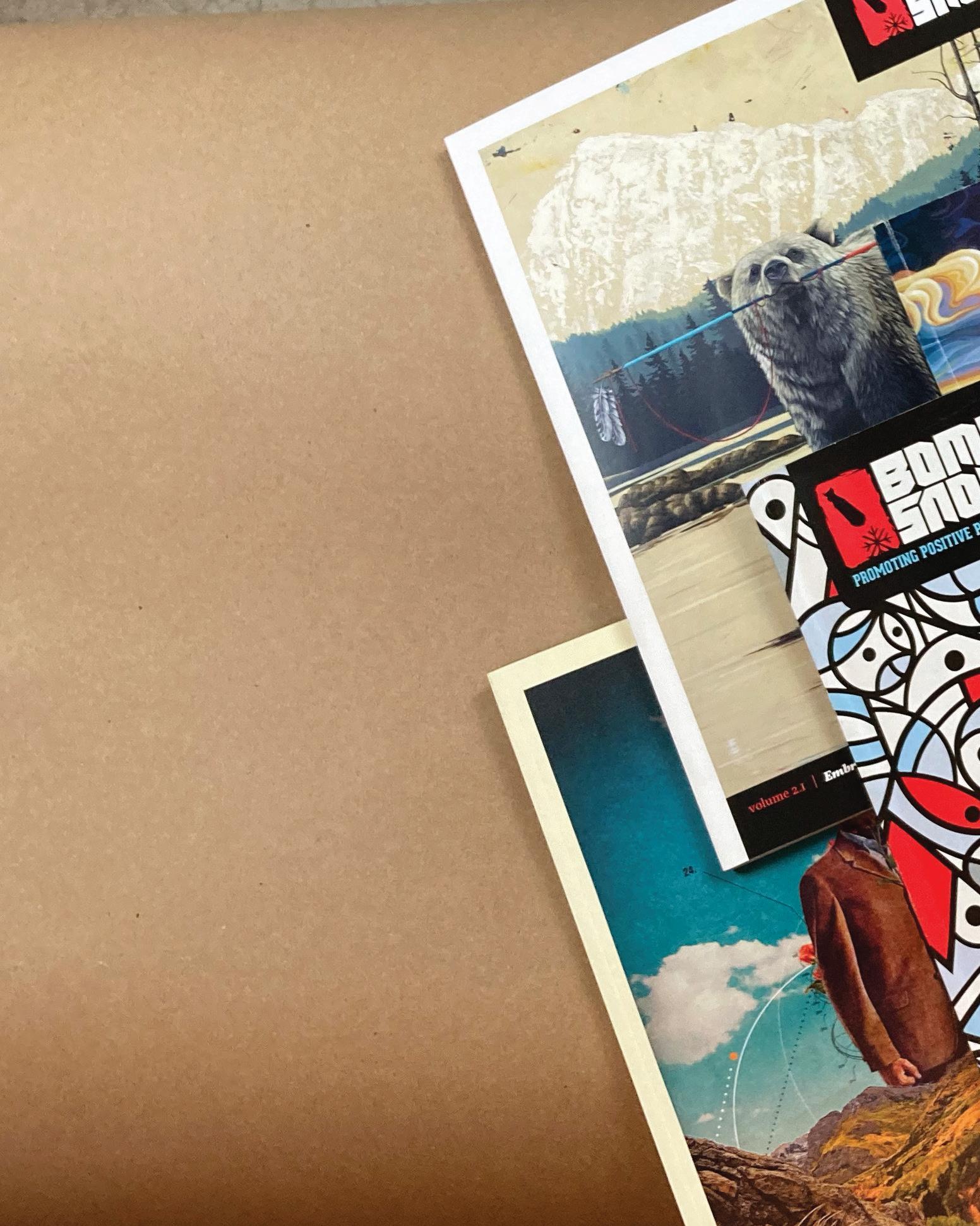

MAKE .
#fknsndr bombsnow.com


 Snowboarding allows endless creativity under any circumstances, even when the snow barely exists. Blotto | Jeremy Jones, Mt. Hood
Snowboarding allows endless creativity under any circumstances, even when the snow barely exists. Blotto | Jeremy Jones, Mt. Hood
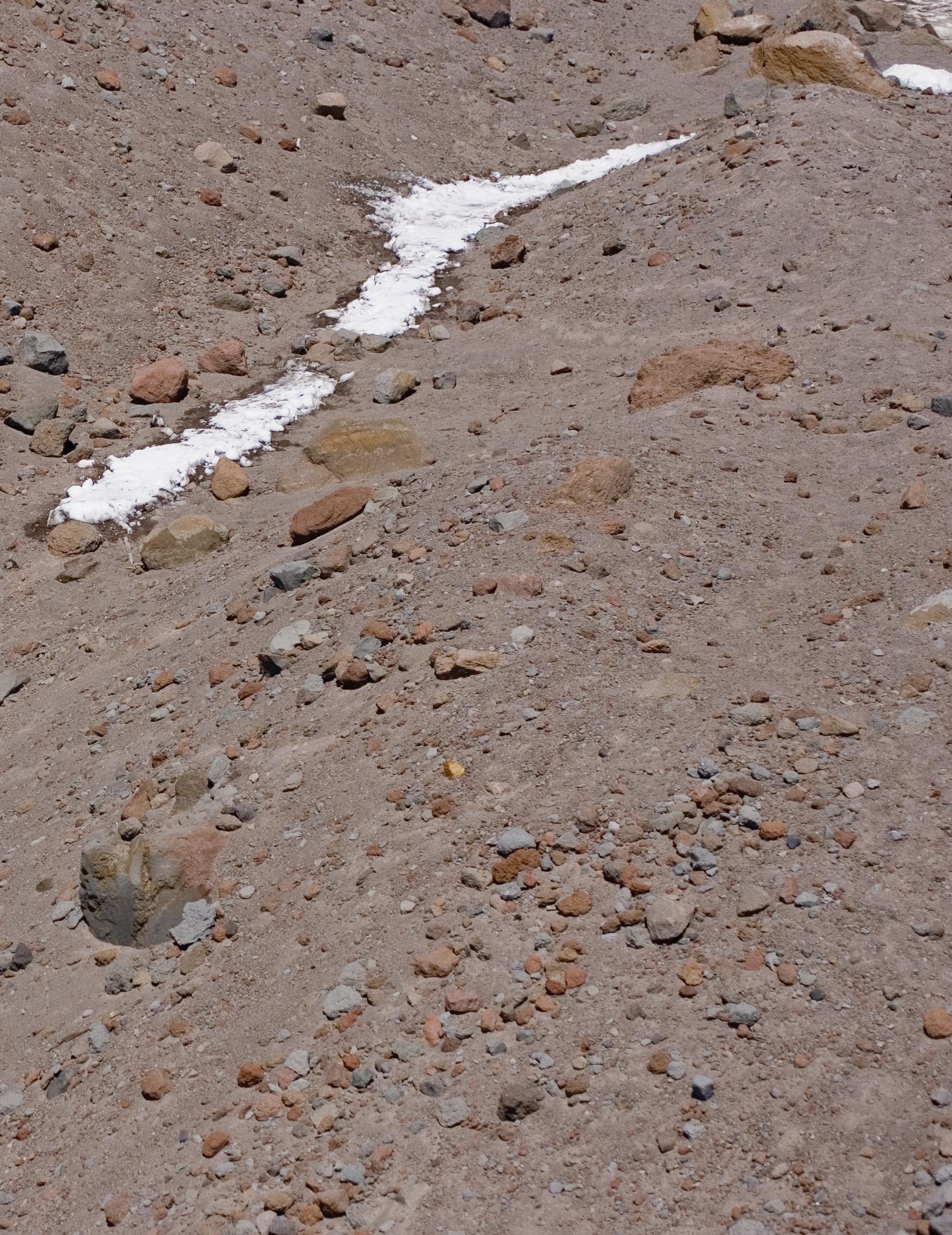
Chief Motivator Todd Heath Editor at Living Large ETHAN A. STEWART Photo Editor Dan Armstrong Sales Associate M. DAVID JOHNSON Copy Editor RIKKA WOMMACK Cont. Designers michaela Nestelberger GEOFFREY SCHLEY Senior Photographer Travis Andersen Cont. Photographers BOB ALLEN BRANDEN AROYAN JIMMY CHIN SETH DEROULET LIAM DORAN ERICH ELLESON SARAH grANGEON DEAN (BLOTTO) GRAY GRANT GUNDERSON AMY JIMMERSON RICK RIDGEWAY KEEGAN RICE TAL ROBERTS DANIEL STEWART COLTON STIFFLER EMILY TIDWELL NOAH WETZEL Cont. Writers JESSICA BYERLY KRISTOPHER DRUMMOND MIKE HARRELSON TIM HAWKE PARKER THOMPSON EMILY TIDWELL Cont. Artists ADAM AMBROS MIGUEL ALMEIDA LUCAS BEAUFORT ROBERLAN BORGES ANDY CLINE ASHLEY DREYFUS Phil Morgan CY WHITLING Cover Artists PHIL MORGAN + TAL ROBERTS Special Thanks TO ALL OF OUR SPONSORS Spirit Animal RICHARD ASPEN Issue 26 | Volume 3.0 Bomb Snow, LLC 410 N. Broadway, Bozeverly Hills. bombsnow.com
Seems like skiers always want to be surfers. But this lineup shot is more high alpine than you might think. That “cloud” is a huge explosion of whitewater, the surfers in the foreground having just paddled over the beast before it broke. Seth de Roulet


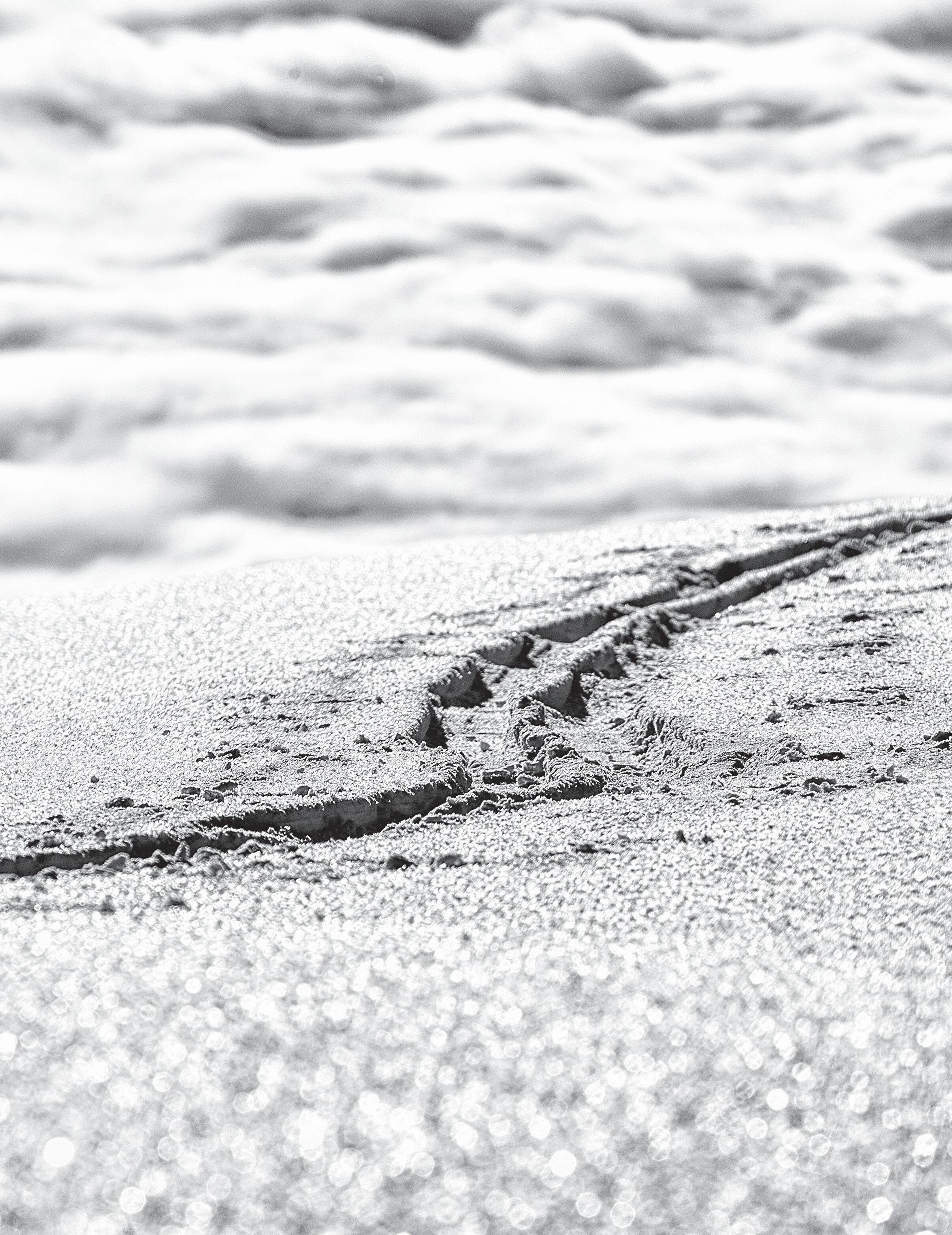

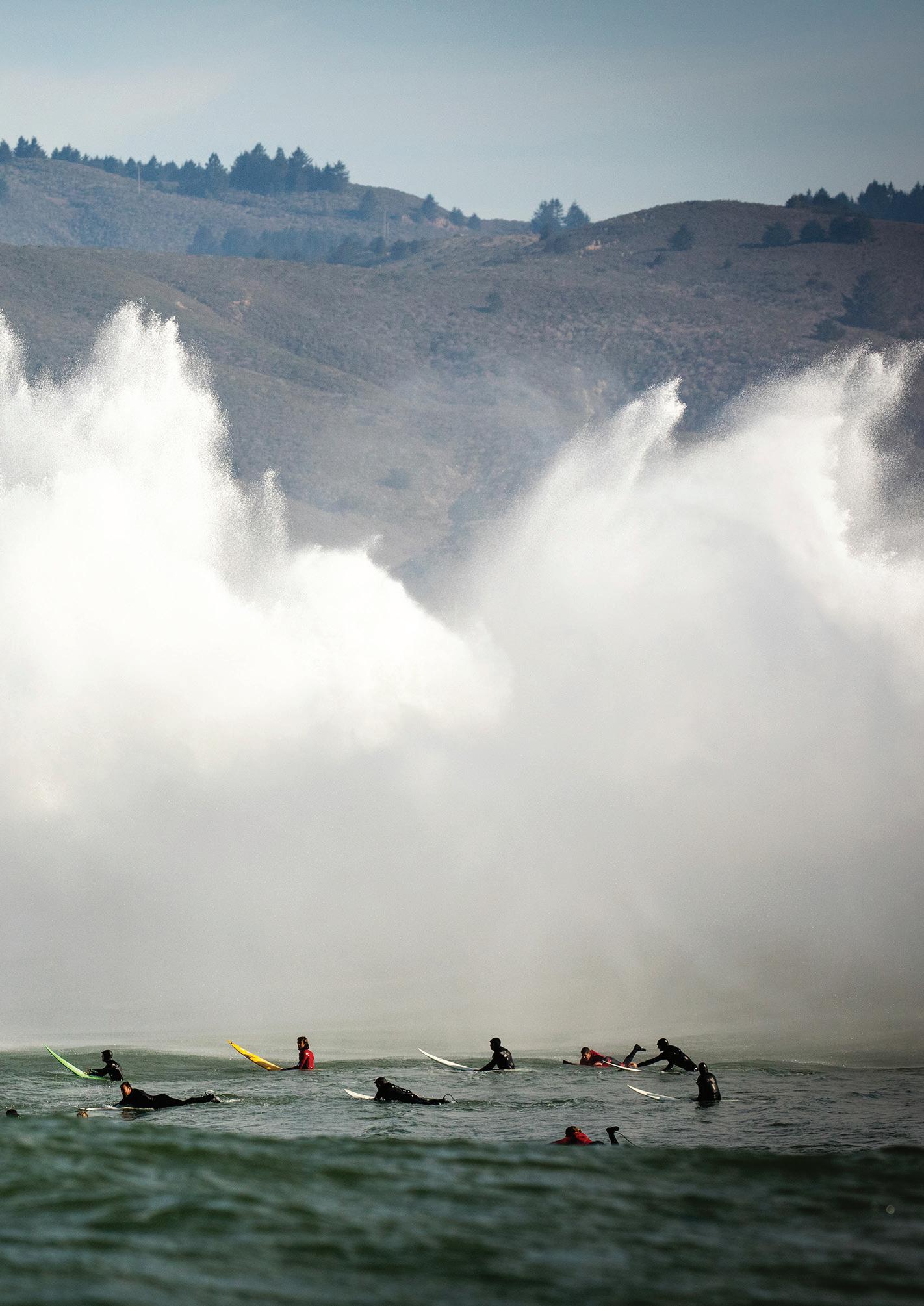

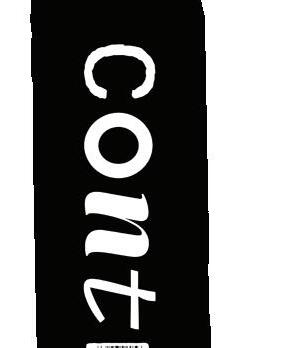

ENT 18 | 30 | 25 | 46 | 84 | 97 | 103 | 110 |


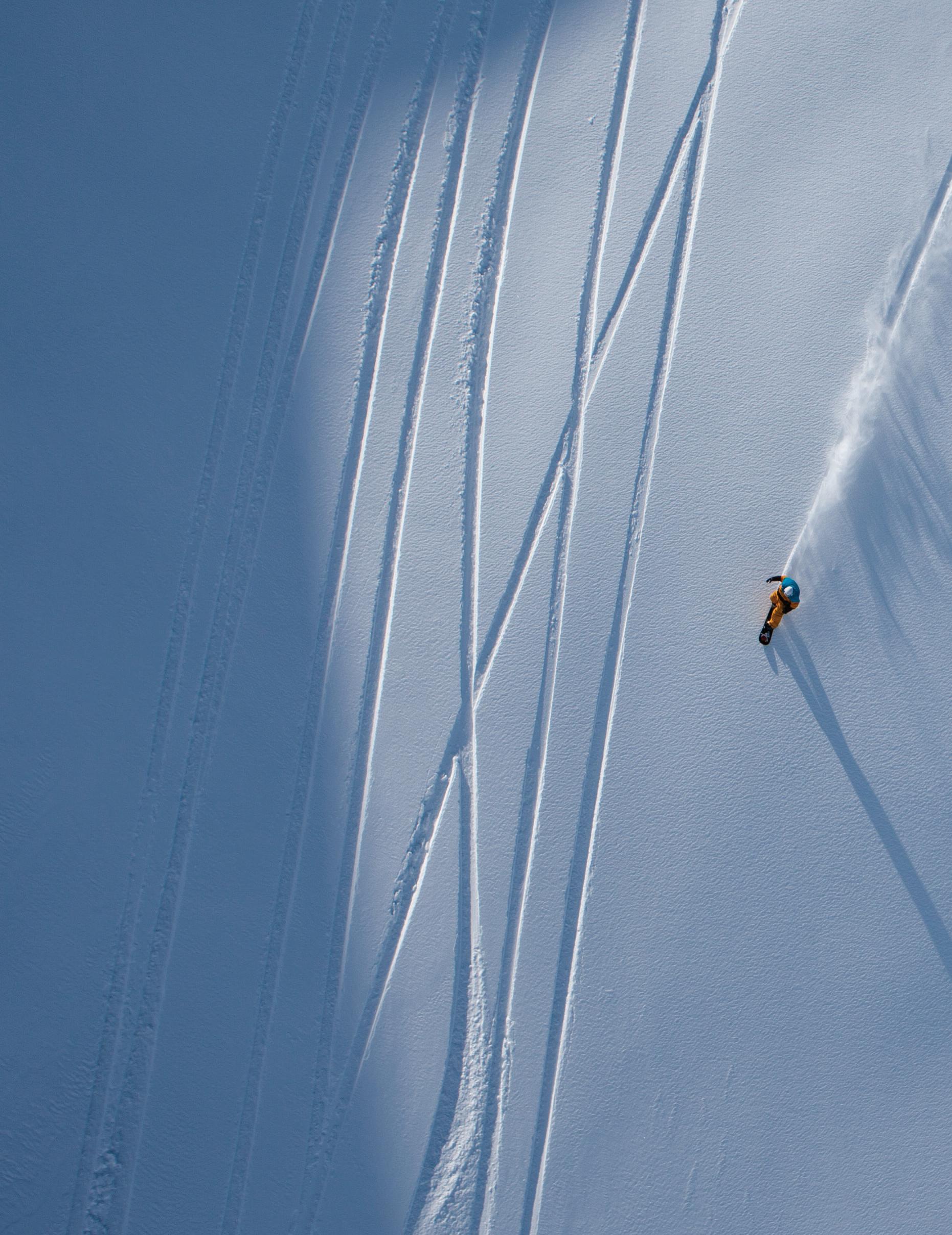
 A good clean run-out for Frederik Kalbermatten, so satisfying for both the rider and film crew. Blotto
A good clean run-out for Frederik Kalbermatten, so satisfying for both the rider and film crew. Blotto

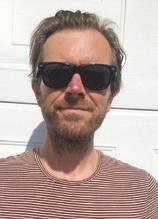





EMILY TIDWELL is an action and lifestyle photographer based in Reno, NV. She believes that the process of learning is forever golden and that no goal is ever fully achieved. She also has a major appetite for powder off the beaten path and single track that snakes through beautiful landscapes. No day is done in Emily’s world until she’s got some dirt under her fingernails and some mud – or mustard – on her shirt.
PHIL MORGAN’S work is the ultimate in post-modern street art, taking wellknown elements from worldwide pop culture and repurposing them with a wink, a smile and, fairly often, a middle finger. Morgan borrows from the aesthetics of previous eras – including ‘70s psychedelia, ‘80s technology and ‘90s street culture – and drags them firmly up to the present day in new and twisted forms. He currently lives in his hometown of Penarth, Wales, UK.
Ashley Dreyfus is a mixed media artist and muralist based in Boise, Idaho. Her art is inspired by her experiences and interactions in everyday living. The big blobby blue characters that show up in a lot of Ashley’s work are described as “Alter Egos” of humans. They live in a world with no judgement or conformity. Ashley’s goal with creating is to evoke joy and curiosity through her vibrant environments in her art.”
Raised on a steady diet of the mountains and rivers of the Rockies, AMY JIMMERSON was inspired by her mother at a young age to live life to the max. She is very much the fruit of the earth, grown from the grounds of Montana, Oregon, and Alaska. Her work as a photographer has evolved not only to showcase her passions, but, more to the point, to help her realize her deep desire to live a life unchained from the norms of a traditional day to day grind.
RIKKA WOMMACK grew up on the Maine coast, but came west for a master’s in creative writing at the University of Montana. She went on to teach high school English in Switzerland and the Bahamas for three years, but couldn’t stay away from Montana. She now teaches writing at Montana State and works as a ski instructor at Big Sky Resort.
Hailing from north of the border, Ottawa-born photographer DANIEL STEWART first moved out west to British Columbia to attend university. Of course, it was really an elaborate ploy to play more in the mountains. Home is now Revelstoke, and Dan is privileged to work and shoot with some of the best outdoor athletes in the game. When he’s not snowboarding, biking, or kayaking, you can probably find him chucking another mulligan on the local disc golf course.
This Photo and Art Annual would not have been possible without our old friend DAN ARMSTRONG stepping in and helping make the magic happen.
A Montana native, Armstrong got his first camera as a teenager, a gift from his father that would soon become the compass rose for his professional life.
A degree in photojournalism from Montana State gave Dan the foundation he needed to turn his passion for outdoor adventure into a full-blown career. He has traveled the world (still waiting on that Antarctica trip, though) with a camera in hand, documenting beauty and stoke wherever he finds it. “I am a photographer and will always be a photographer,” says Dan. “My passion to learn new techniques and see things differently will always keep me behind the lens.”


ORS

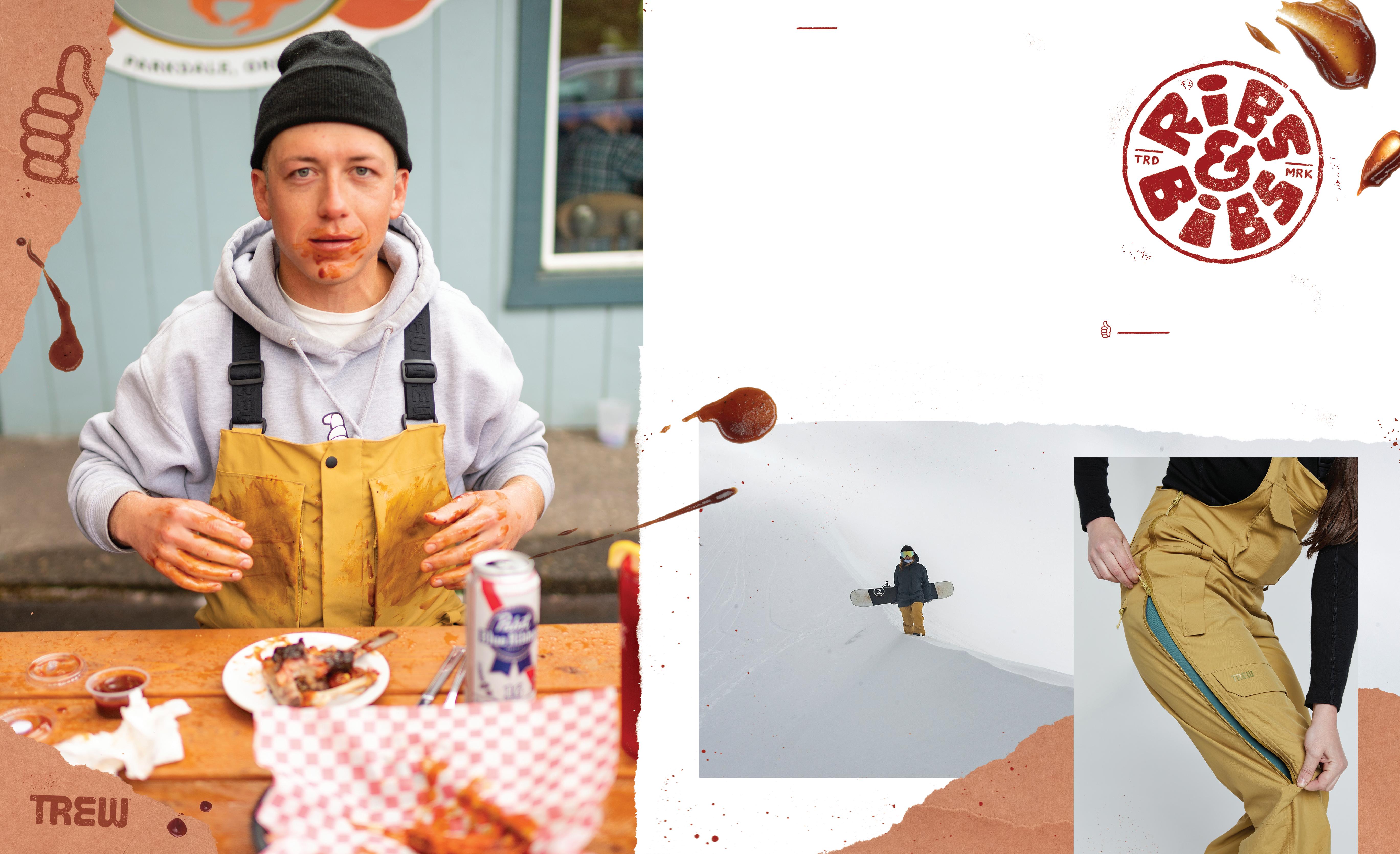






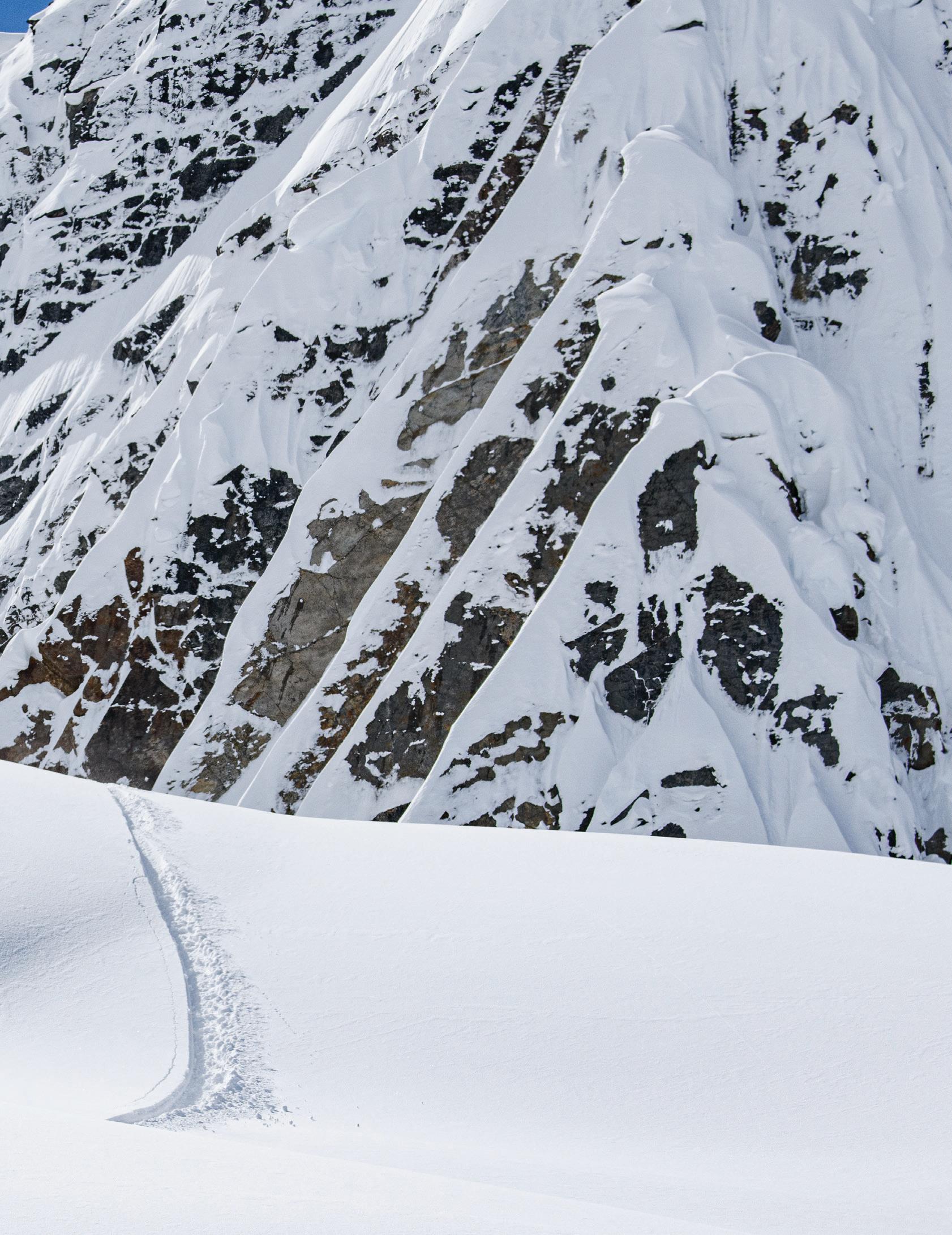
It can always be a gamble heading for a spring backcountry tailgate mission at this undisclosed location in the Rockies of BC. You’ve got to gamble with the weather and hope that you get a window or two. This trip we scored and received 50 cm of fresh throughout the week along with the cold, bluebird conditions that you dream of on our last day. Here’s James “Dozer” Coombs paving a line in. Daniel Stewart

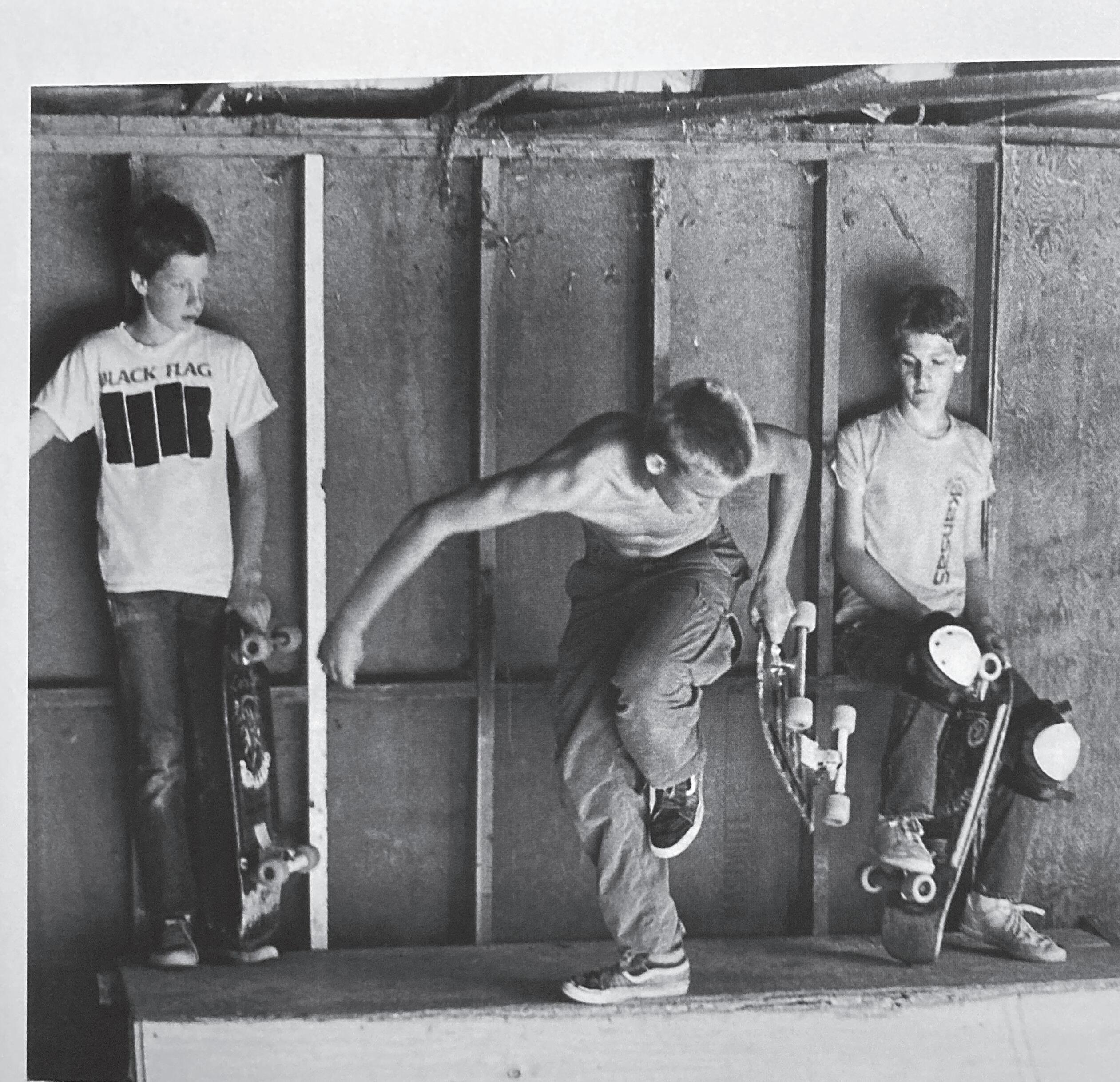
Although the time period and subject of this photograph maps perfectly with Hawke’s op-ed, we poached it from Jeff Johnson’s new book, Way High Kick
The book itself is reviewed near the back of this magazine.
i26 Photo & Art Annual |
18 |
Turn.
Erich Elleson

“Punk is not really a style of music. It’s more of a state of mind.” -Mike Watt
I grew up punk. In Montana. In the 1980’s. This was not easy. And by “punk,” I’m not talking about the misguided idea of delinquent kids tearing up the town. We were smarter than that. It was the idea of being 100% yourself and not apologizing for it – social norms be damned. There was no Internet to explore this raw new music filtering its way across the prairie in cassette tapes that wound up in boomboxes next to the skate ramps we built. We had a massive half-pipe scabbed together from scraps we pilfered from construction sites after twilight. There were some hand-printed and photocopied fanzines that made their way around the West and helped define the culture. Some skateboard videos (on VHS) got passed around amongst the tribe and clued us in to a good band or two. It was very much a grassroots and underground movement, and that made it even more genuine.
Some think that punk is just angry music for violent people. That was never the point for us. Yes, we were screaming along at the top of our lungs, flailing around in circles in front of the stage, behaving somewhat like drunken chimpanzees attempting to perform a whirling dervish, but there was a solid community of like-minded freaks, and we looked out for each other. If someone went down in the pit, everyone stopped to peel them off the sticky floor before they got trampled. When someone dove head-first off the stage, we all gathered to catch them quickly to avoid a cracked cranium.
“In fact, punk rock means exemplary manners to your fellow human beings.”-Joe Strummer
There was a more important and pervasive ethos, though, one that hit me deep and persists to this day. Do it yourself. What is it you want? Do it.
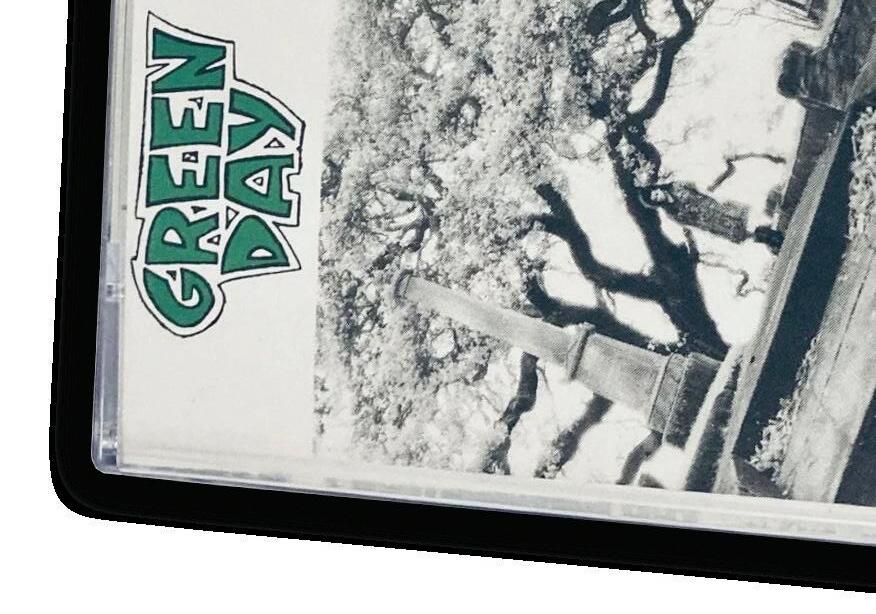
ABOVE.
WORDS Hawke
Want to start a band and make an album? Do it. Record it in your friend’s parent’s basement. Get them pressed and packaged and sell them to your friends. Want to see a punk show? Do it. Rent your local VFW for the night. Rent a stage/PA system and print some flyers. Do. It. Yourself. Early punk was full of fired up people that just made it happen. My best friend and I took it to heart, and brought Green Day and the Offspring to Billings in 1990 when we were naive 18-year-old punks. They were driving a van across the country and booking their own gigs. We paid Green Day $350. We weren’t bonded/licensed/insured. My artist of a sister provided flyers and banners and t-shirts. No one died. We did it with passion. We had an idea and we made it happen. My best friend, Sean, stuck with it, and now has a successful venue in Billings that puts on shows most nights of the week. Turns out, this approach works.
The point is, do it yourself. No matter what you are chasing. This applies to all of you skiing/ biking/climbing/fishing dirtbags as well. What do you see lacking in your community? What do you want to change? Do you have a grand idea? Make it happen. Gather a crew of like-minded people and make a plan.
“I got tired of waiting because I found out there’s a very fine line between biding one’s time and wasting one’s time. Know what I mean?”
-NOMEANSNO
I often hear people complain about what we do or don’t have around the valley in the name of traditional or progressive playgrounds. I, for one, honestly think we have it fairly good here in the Last Best Place. Things are pretty much worldclass-meets-Western as far as places to play, but they could be better. The reality is that the government agencies that manage our public lands have had their budgets whittled down to the bare

I gathered some like-minded and fearless friends and made a plan. We started the non-profit Southwest Montana Mountain Bike Association and BEGAN pestering the government for permission to make trails. We got people to write letters of support. We spread the word, but it took years to get a green light.

minimum. They don’t have the funding necessary to even maintain what they have, much less create more opportunities for our ever-growing populace.
And yes, this is a punk encouraging you all to help out our government. The irony is not lost on me. But the reality is that those in charge are (for the most part) really good people. Some might even consider themselves punk – though they likely have to keep that in the closet until the weekend. There are some of us who would prefer to go renegade, and just do whatever we want with our public lands, permission be damned. But that mindset doesn’t help the greater cause. In fact, it’s a major setback for those of us who are trying to make a lasting difference.
Even though a lot of the original punks embraced the concept of anarchy, many of us came to realize that you can do a lot more to change the system from within. If you tear it all down, then you are responsible for rebuilding it. It’s a lot more productive to work within the existing structure to help create the world you want to see.

“Punk rock isn’t something you grow out of. Punk rock is an attitude, and the essence of that attitude is: Give us some truth!” -Joe Strummer
I used to wonder why I had to drive all the way to Utah to ride on technical, “bike optimized” trails in the desert. The trip would take me past lots of dry and incredible terrain right here in southwest Montana. So I summoned my inner punk and decided to make it happen. I gathered some likeminded and fearless friends and made a plan. We started the non-profit Southwest Montana Mountain Bike Association and began pestering the government for permission to make trails. We got people to write letters of support. We spread the word, but it took years to get a green light. Once we did, we jumped in like we were diving off a stage. And the crowd caught us. People showed up in droves, enthusiastic about our idea for the Copper City Trails. Some gave money, others gave us a hand sculpting dirt. Even better, a few people gave hundreds of hours of their lives to write grants, design shirts, organize fundraisers, and build trail signs. They got involved! Our passion was contagious, and, in time, we created what we wanted all by ourselves.
“Don’t care what they may say—we’ve got that attitude! Don’t care what you may do—we’ve got that attitude! Yea, we’ve got that PMA [positive mental attitude]!”-Bad Brains
Whatever your pleasure, be it deep powder or whitewater or pedaling ribbons of packed dirt, there’s a group of people just like you already out there, working to maintain access
i26 Photo & Art Annual |
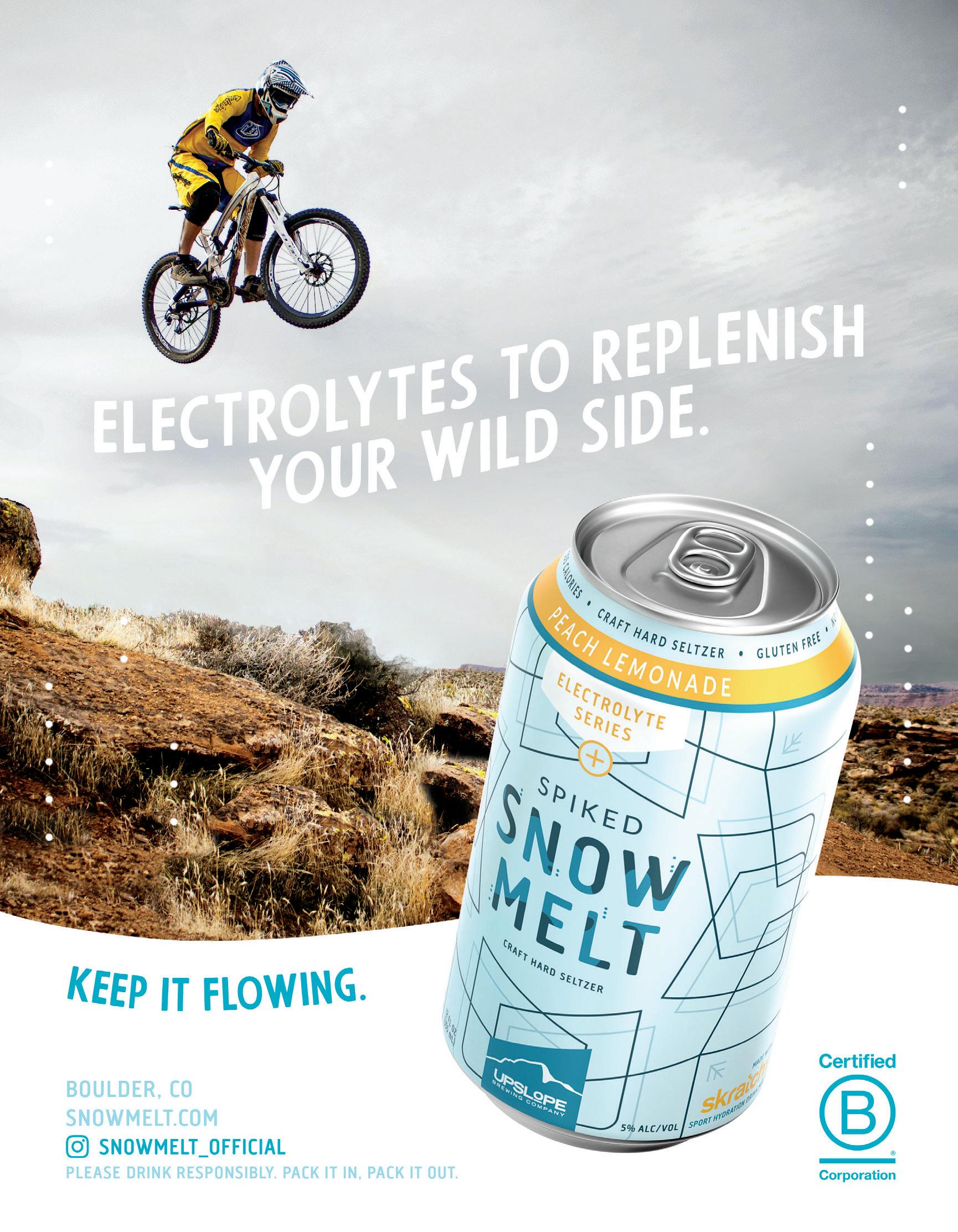
ABOVE.
and create new, sustainable, and responsible ways to blow off steam in the Great Outdoors. I guarantee they could use your help. It’s pretty easy these days to find out who’s making things happen: right there on your phone, on the other side of a Google search. You don’t have to wait for some cool kid with a mohawk from Denver to move to town and turn you on to the goods. In fact, Bomb Snow is going to make it even easier. The QR code at the end of this article will link you to the websites of groups from southwest Montana and beyond who are working hard to keep you playing hard. Please check it out. There are some simple ways to help. Every one of these groups hold events, be it a trail workday, a fundraising raffle, or a movie night. Getting involved is fun. And if you are fortunate enough to be blessed with some disposable income, they could always use a little financial support. Sustaining members are the ones who make it happen for these ragtag red-tape rustlers.
I honestly believe that the best thing that can happen is to chase your passion all the way to the ground. Everyone reading this has an idea. Some of you are waiting for others to make it happen, while some of you, I’m sure, are already getting your hands dirty. What is it that you want to see? How do you want to play? This column is not meant to be a brag about the amazing feats my crew and I pulled off. It’s meant to be a call to arms. I want you to think about the crazy ideas simmering in your head. Maybe they aren’t that crazy. We weren’t any different from you. Start a band. Gather a tribe. Print some flyers. Do it with passion. Get busy…



“We are born with a chance. Rise above! We’re going to rise above! And I am going to have my chance. Rise above! We’re going to rise above!” - Black Flag
 | Shea Dugall with Muzbe the pup. Copper City.
| Shea Dugall with Muzbe the pup. Copper City.
i26 Photo & Art Annual |
RISE
Bob Allen
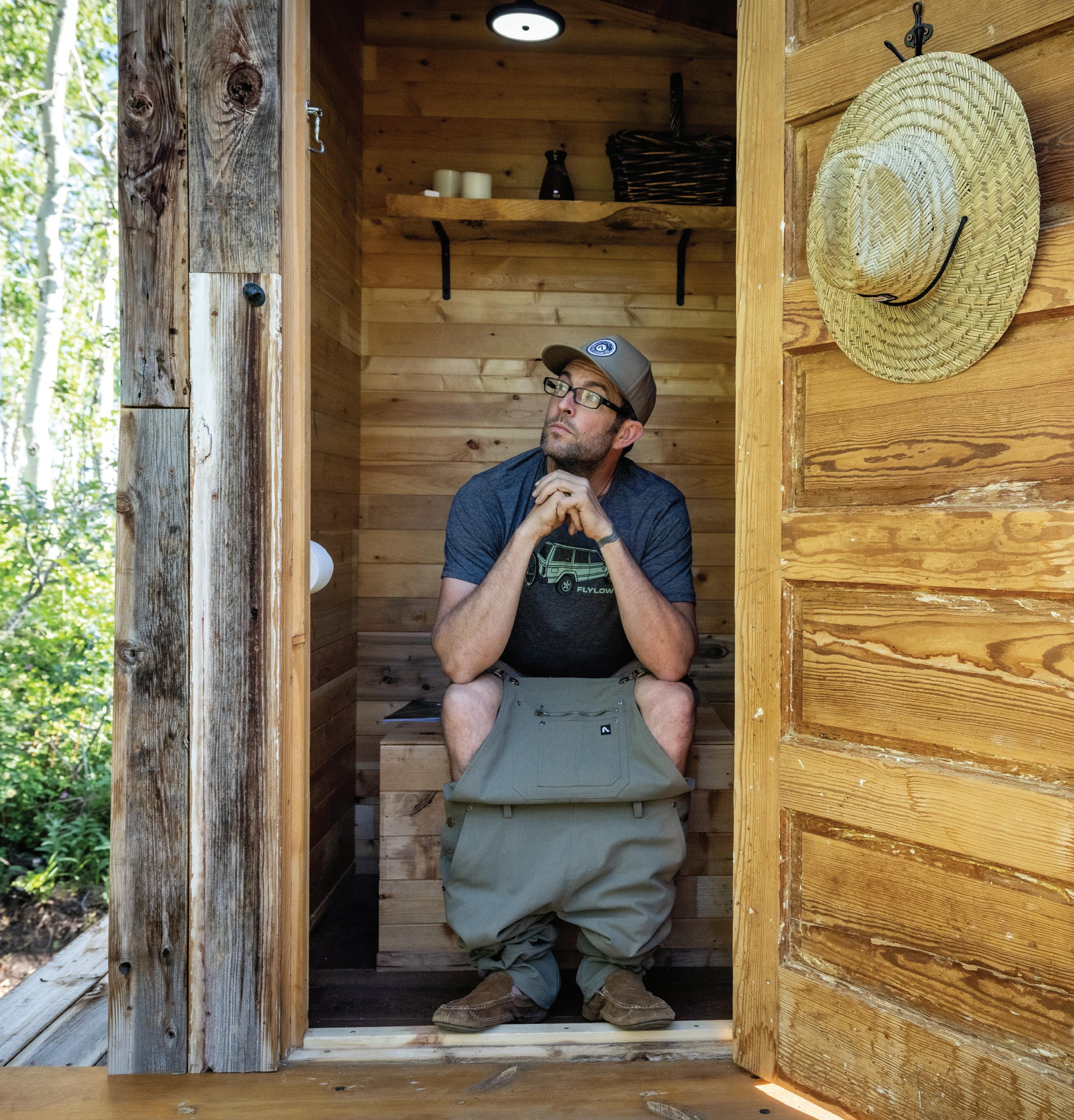

is your your LIFE
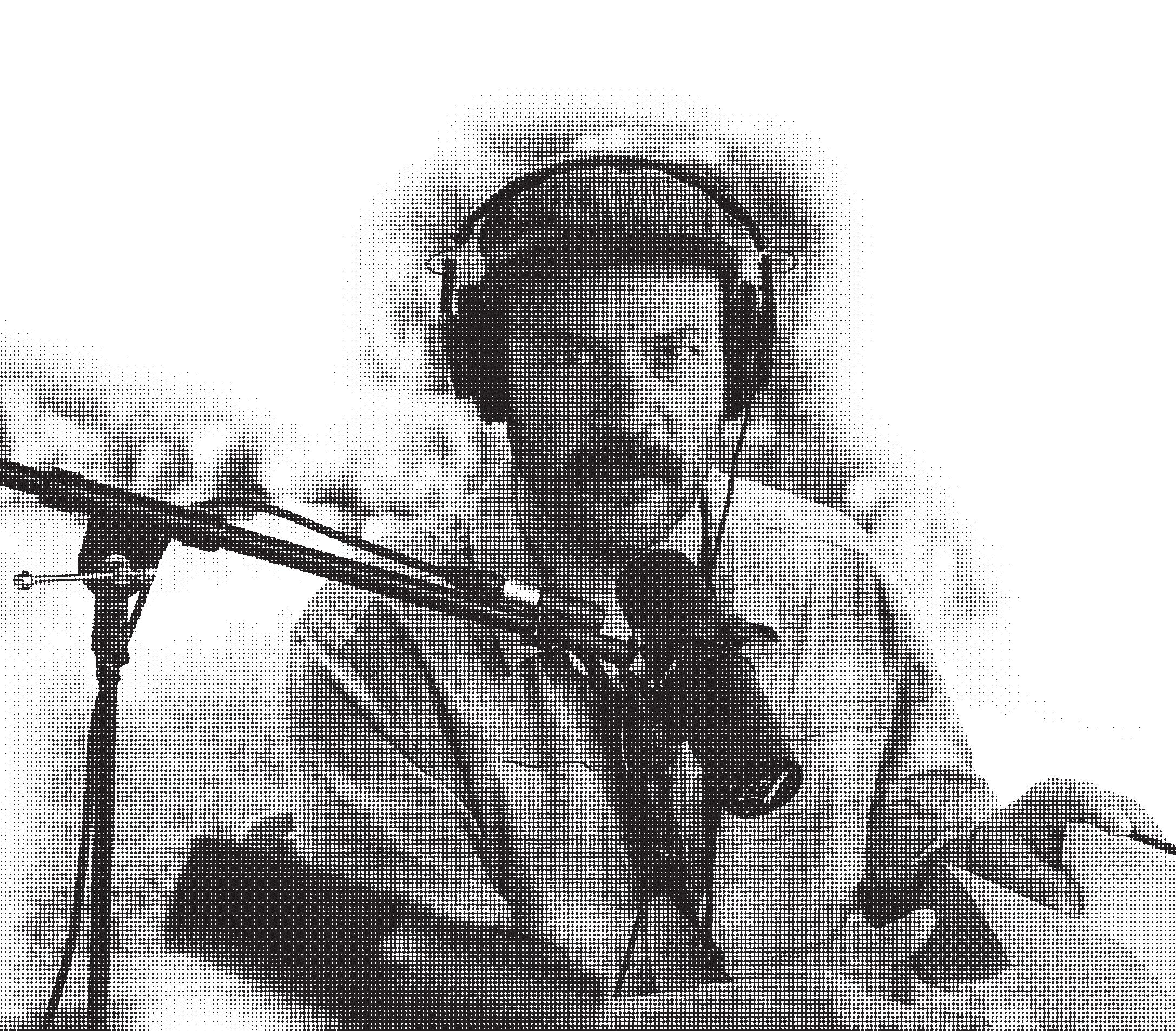 WORDS Ethan A. Stewart Tate Chamberlin’s Tension-Filled Trajectory
WORDS Ethan A. Stewart Tate Chamberlin’s Tension-Filled Trajectory
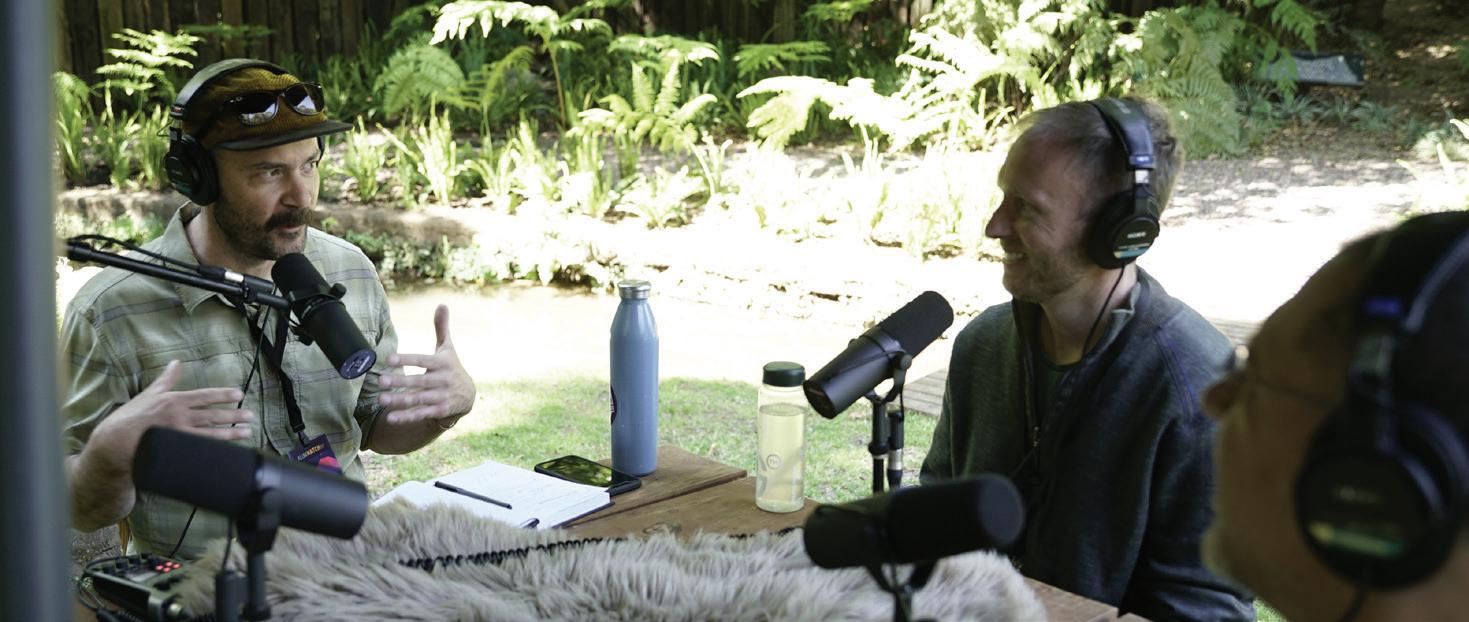
There is a paradox at the heart of Tate Chamberlin’s life. A tension that illuminates his path. He is a man who cares deeply, a self-described introvert who can’t get enough of humanity and the stories that bind us.
There is a curiosity at the heart of Tate Chamberlin’s life. A wondering about how we might all live a little better in a world that seems committed to conflict. He is a man who seeks to understand, a facilitator of progress who welcomes the disagreement.
“I like to tell people to pay attention to their neck hair,” said Chamberlin. “When something makes your neck hair stand up or catch fire, that’s when you’re supposed to lean in. Trust is built through tension.”
A classically trained graphic designer, the Colorado-raised Chamberlin has charted a less than ordinary path since graduating from Montana State University nearly two decades ago. His aesthetic acumen and social scientist leanings led to the creation of Chamberlin Productions, a company that quickly became a force in southwest Montana and beyond for putting on concerts, music festivals, and assorted
other artistic and cultural events. It was a good path for a guy who has “always liked promoting shit,” and it was also a great training ground; a dojo of sorts for a young man developing a diverse skill set for being able to turn visions and hopes into reality.
But Chamberlin was after more than just throwing parties and creating singular social experiences. To hear him tell it, he has a bit of an inner activist, and working in traditional event production started to feel a tad too one-dimensional. “People engaging in where their hearts are leading them – activism in all its forms – energizes me,” explained Chamberlin. “Eventually, I had to chase that.”

tegrative approach can be found even amongst the most divergent of ideas. It was only a matter of time before Chamberlin Productions began to evolve. That’s not to say that Tate abandoned event production; far from it, actually. It would be more accurate to say that he began to build off it and expand into a new space and way of working with his skills and interests. Such is the alchemy of an artful life. Such is the origin story of Blunderbuss.
He also has an intellectual fondness for philosopher Ken Wilbur’s Integral Theory, the idea that all the various social and professional paradigms we live with can be understood in such a way that a mutually enriching and in-
Located on a sprawling property just west of Bozeman city limits, Blunderbuss (named after a legendary pirate firearm that was capable of firing off nearly anything and everything that could be wedged down its barrel) is a place that defies mainstream description. It is a hostel for artists and entrepreneurs, a place where you can drop anchor for anywhere from three to eighteen months and focus on your creative pursuit of choice while surrounded by a transcendent atmosphere
| 25 Jacobo López | Decentralization of Systems recording in Valle De Bravo, Mexico.

“The aim is to create momentum through localized action and exchange and get people in the community—Bozeman, the Gallatin Valley, Montana, and beyond—to conceptualize the United Nations’ goals for sustainable development on a small, local scale, and then act.”
of support. It is a meeting space and a maker space and a place for social chemistry. It is a print shop that is also home to a few frisbee golf holes, tiny houses, art studios, fire pits, breakout rooms, and limitless exploration. With 38.5 kilowatts of solar power, an emerging food forest, and an elaborate water catchment system, Blunderbuss, which, at any given moment, is home to 24 different people from around the world, is also a beacon of sustainability.
Which brings us to the latest evolution of Chamberlin’s artistic life. Much like his graphic design work led to his production work which led to Blunderbuss, his role as innkeeper has led to his current incarnation as a journalist, podcaster, and agitator for systematic change. He is still following his unique thread of tracing where activism and art meet humanity and media, but he is doubling down on the efforts with his company, I AM INTERCHANGE. “I got tired of going to like five or six different media websites to unpack the news and better understand the various tensions and conflicts around the world. I AM INTERCHANGE is my response,” said Chamberlin.
is your art.
A “HUMAN-based media company,” I AM INTERCHANGE combines Chamberlin’s work as an Integral Theory-based facilitator with his passion for meaningful

conversation and his appetite for both conflict and problem solving. Moreover, the organization is intentionally aligned with the United Nations’ 17 Sustainable Development Goals (SDG), a set of guiding principles adopted in 2015 that range from sustainable communities, clean water, and eliminating hunger to education, gender equality, and responsible consumption. The SDGs are meant to provide a framework for building a better future. For his part, Tate has served as a delegate to the United Nations’ annual Media for Social Impact Summit and the Sustainable Development Goals Media Summit. For the last seven years, much of what he has done both personally and professionally has attempted to be a reflection of the SDGs.
To that end, I AM INTERCHANGE creates podcasts, written stories, interviews, photojournalism, live events, and carefully curated thought salons meant to investigate some of the more controversial and “taboo” subjects in today’s public discourse. Prior topics have included the question of if water is a human right, Native American reconciliation, wealth gap inequities, the various meanings and interpretations of “OK, Boomer,” the future of work, and the promises and pitfalls of Web 3.0. “The goal is to hold space for the polarities [on a subject], keep calm, and then try and explore what is behind those surface tensions,” said
i26 Photo & Art Annual | |“Is Water A Human Right?” Debate at the Filling Station. Ben Johnson
I think that government, in all its traditional forms, won’t be able to adapt fast enough to the change that is happening.”
 | High above the Blunderbuss compound.
Dan Armstrong
| High above the Blunderbuss compound.
Dan Armstrong
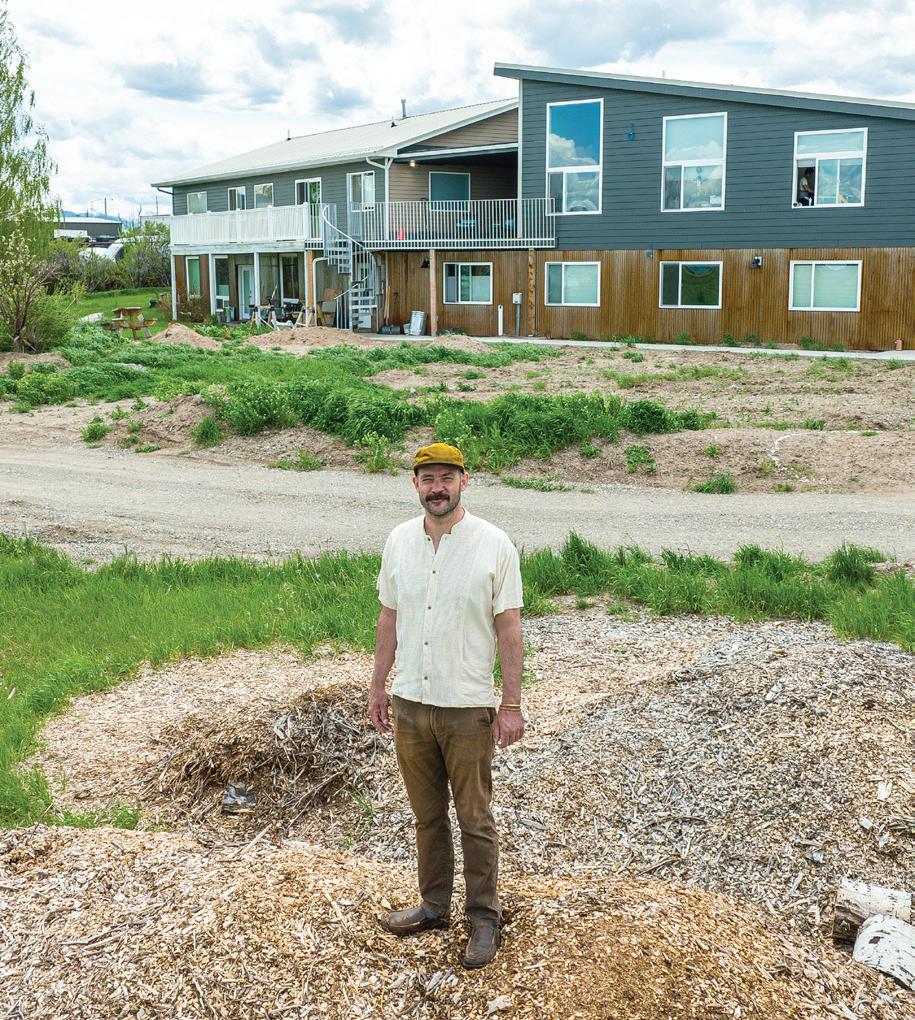
“You have to get into the tensions that surround something if you want to understand and solve a problem.”
Chamberlin. “You have to get into the tensions that surround something if you want to understand and solve a problem.” The end result is a deep and nuanced dive into topics that traditional media typically reduces into a few rhetorical sound bites. In short, I AM INTERCHANGE is holistic journalism done with hope for a better tomorrow.
A recent partnership with Hatch, a Bozeman-based but internationally focused non-profit dedicated to ideas, innovation, and problem solving informed by the United Nations’ SDGs, has helped super-size the network that Chamberlin is able to draw from for his various adventures in modern journalism. Taking a page from the hands-on and exploratory ethos of Blunderbuss, Chamberlin isn’t one to just stay home and use Zoom to make some interviews happen in a safe and isolated way. Instead, he often travels to where the stories or interesting conversations are happening. Be it a Farm Bill impact lab in Kansas City, a jungle in Mexico, or a boat in Egypt, he engages people directly at their point of interest and puts his finger on the pulse in real time. There is, after all, an unalienable authenticity in being where


the action is, and that authenticity helps create a relatability that too much media misses these days.
“I’m creating journalism around these endeavors as they are emerging in real time,” said Chamberlin.
“The podcasts and stories encapsulate the whole experience of a topic so that it might look and feel like something communities around the world can relate to…By facilitating through tension, Interchange delivers truly informed storytelling.”
To Learn More about I AM INTERCHANGE go to www.iaminterchange.com or check them out wherever you find your favorite podcasts.
your LIFE

[
Ben Johnson | Cultural Exchange VS Cultural Appropriation debate
Dan Armstrong | Quoin Letterpress Studio at Blunderbuss

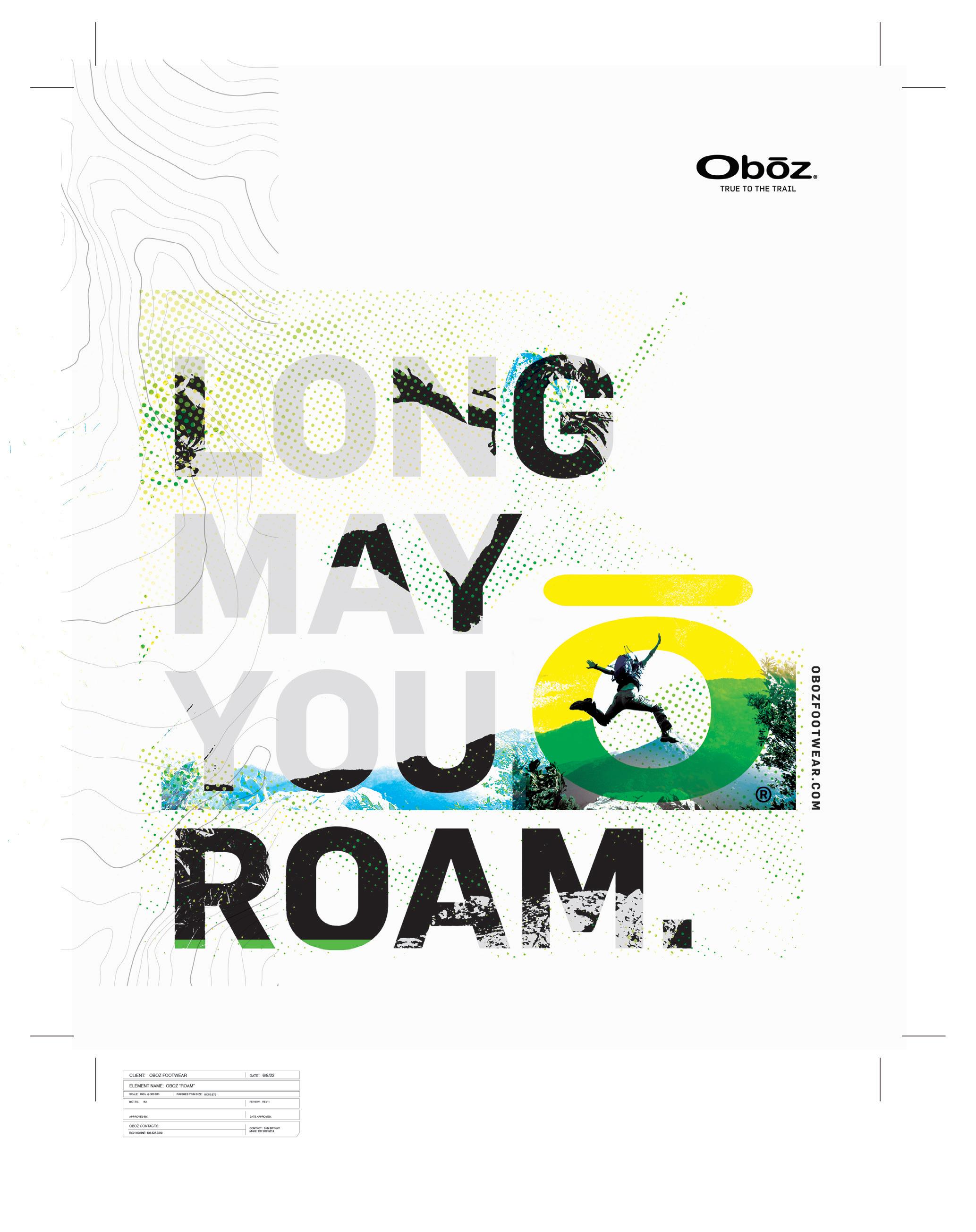

LIFE
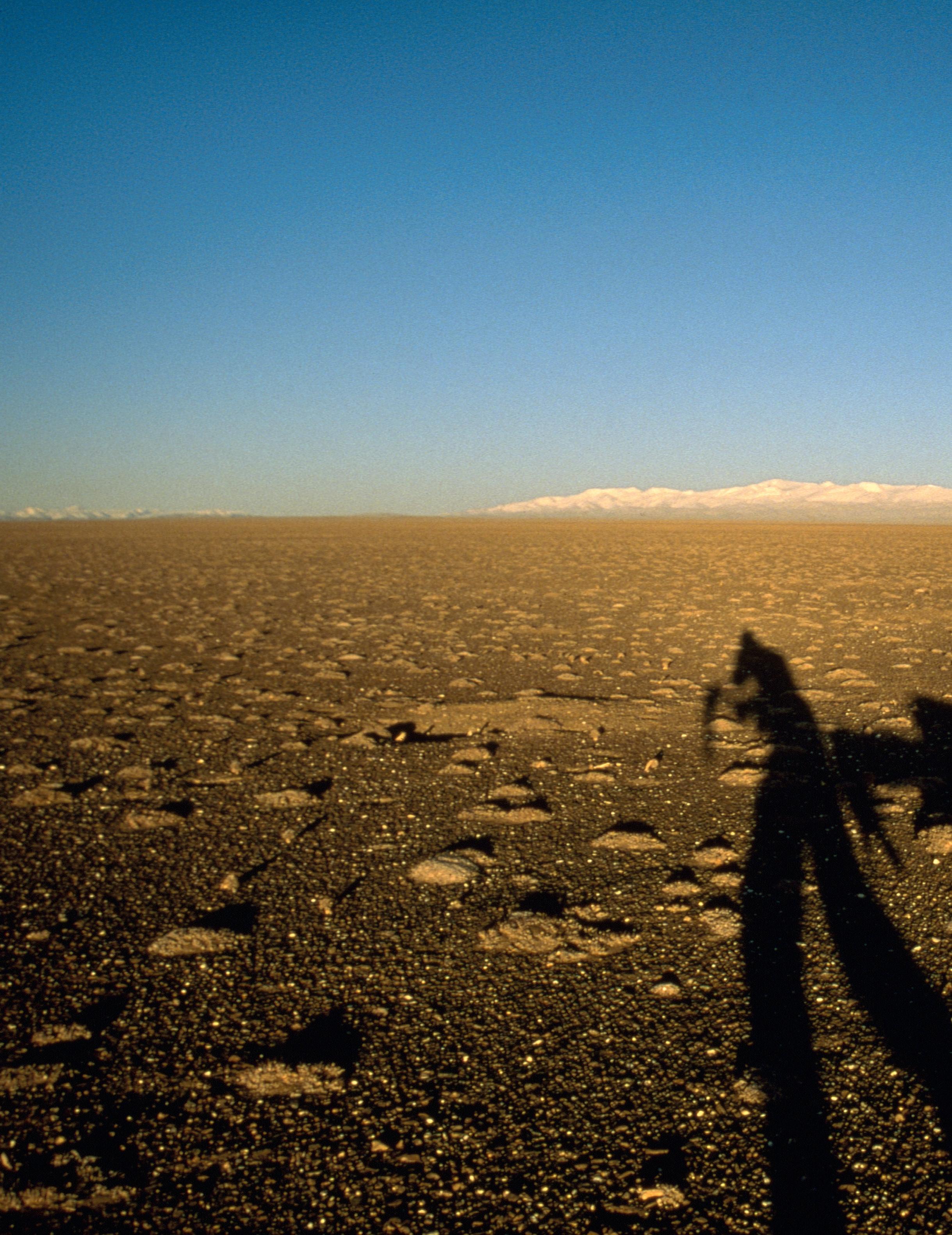
The Dharma of
30 |
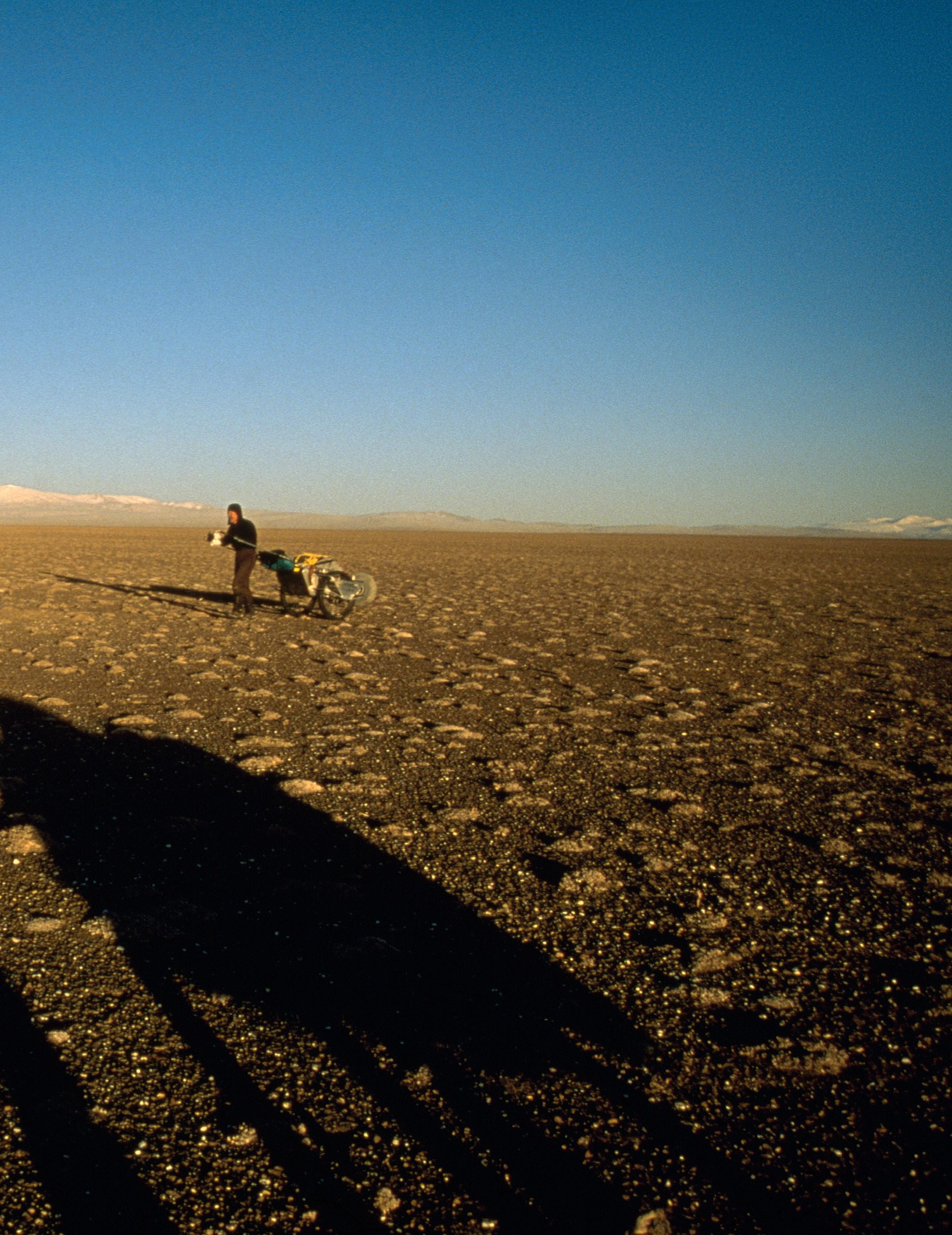
WORDS Ethan A. Stewart
Into the Maw of Meaning with Famed Mountaineer and Author Rick Ridgeway
For 275 miles there were no signs, not even neolithic artifacts, that human beings had ever lived in this remote corner of the planet.
Galen Rowell
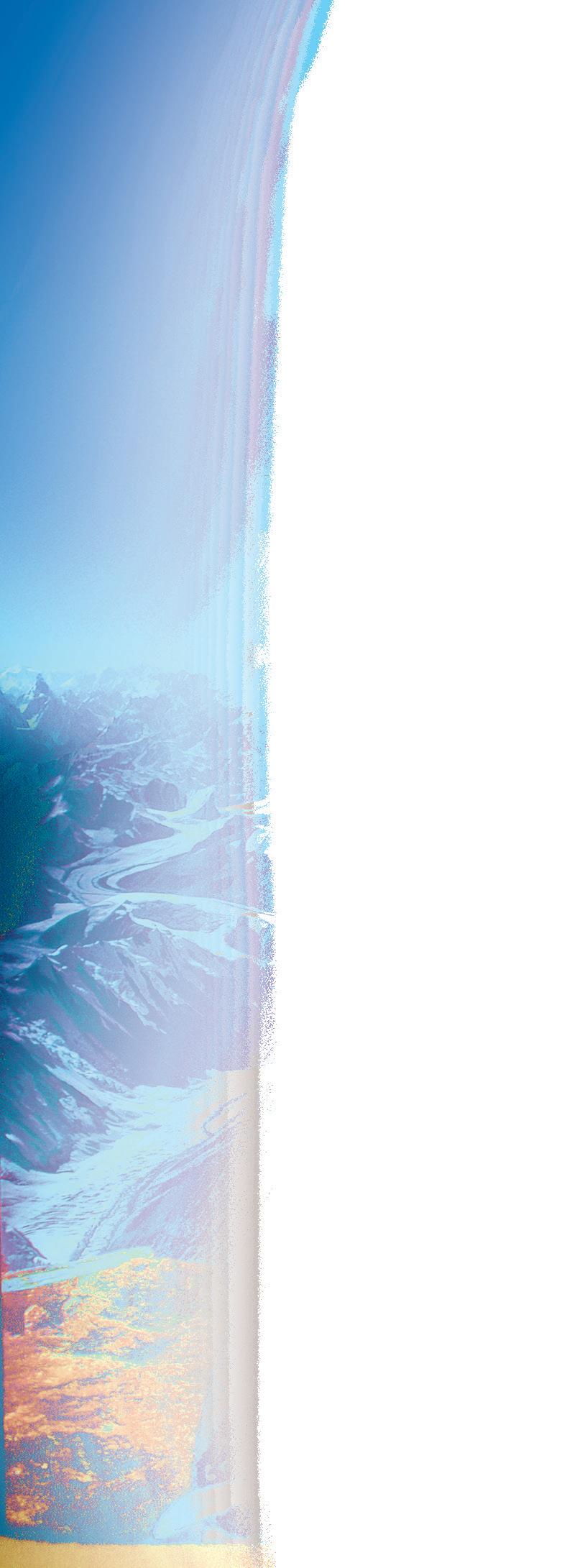
is a gateway drug. A gateway to a richer, more vibrant, and story-filled life. A gateway to discovering what it means to be alive on this big, blue planet. Just ask Rick Ridgeway.
Soon to be 73 years young, Ridgeway has lived a life of adventure about as impressive as they come. It started with snorkeling with his father in the waters off Catalina Island as a young boy, his old man being one of the first in the U.S. to own one of Jacque Cousteau’s Aqua-Lungs. His father would hunt abalone and lobster in the depths of the Pacific, and Rick would hold his breath, dive down, try and get as close to the action as he could, and stay there as long as he could. The adventure hook had been set.
Most of his teens and early twenties was an exhilarating blur of sailboats on the open ocean to places like the South Pacific, and climbing adventures in the Sierras, the volcanoes of mainland Mexico, and the Peruvian Andes. College happened in Hawaii, but his eyes were set on horizon lines far beyond the tropical breezes of our 50th state. He was on the American Bicentennial Everest Expedition in 1976, and then, in 1978, was part of the first American team to summit K2. Ridgeway and a few friends even managed to pull it off without supplemental oxygen. He was a core team member of the original Seven Summits expeditions in the early 1980s. The list goes on and on: Borneo, Bhutan, China, Chile, the Amazon, Antarctica, Panama, Kenya, Easter Island, and Russia to name only a few. Ridgeway has been on expeditions on every continent, toting with him his unique skill set of film and video camera chops, journalistic writing habits, mountain and ocean survival knowledge, and a relentless

determination. By his own reckoning, he has spent more than five full years of his life sleeping in a tent on some sort of farflung expedition.
He didn’t get a “regular job” until 2004, when he became a VP at Patagonia, a role that saw him doing a bit of everything, from heading up their sustainability programs and Freedom to Roam campaign to helping start their publishing company and producing the cult classic adventure film 180 South. He counts Yvon Chouinard (Patagonia’s founder) and the late Doug Tompkins (The North Face’s founder) as two of his closest friends, a group that also includes larger-than-life people like Tom Brokaw and Doug Peacock. Devoted husband, father, and grandfather are also on his resume. When a Rolling Stone article referred to him as a “real life Indiana Jones,” they weren’t too far off the mark, only Ridgeway is arguably even more of a badass.
Of course, a life this big doesn’t happen without equally big challenges and losses. Ridgeway is no stranger to death. More to the point, he is no stranger to having to bury people he loves, often decades before they should have departed. His hard-earned wisdom and empathy is palpable within five minutes of meeting him. The man has a pace and a presence that somehow conjures both bulldog and Tibetan monk.
His new book, Life Lived Wild: Adventures at the Edge of the Map, is a thrilling read that recounts 25 of his most memorable and important adventures. It is a page-turner that, at times, feels like it couldn’t possibly be describing real life. Such is the scale of his adventure resume. Adding to the excellence is the fact that Ridgeway has been a committed daily journal keeper since college, a practice that allowed him to breathe life into his book in a spectacular way, quoting people and sketching details such that you can feel the page breathing with a life force all its own. So stacked is the lineup of stories that a tale as wild as being thrown in prison in Panama for smuggling emeralds didn’t even make the cut. It is a must read for anyone who fancies a bit of rough-around-the-edges fun in the Great Outdoors.
Bomb Snow connected with Rick earlier this spring to talk story and glean some deep life lessons from the wise wizard himself. What follows is an edited excerpt from that conversation. We hope you enjoy it as much as we did.
i26 Photo & Art Annual |


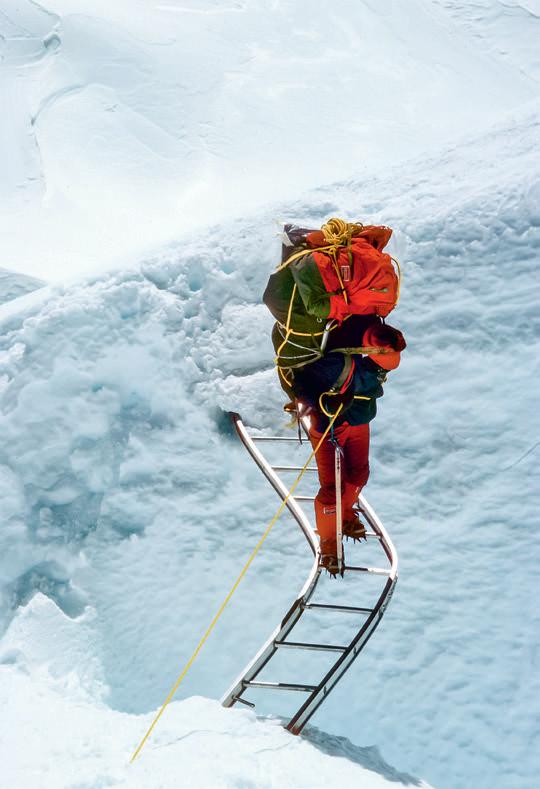

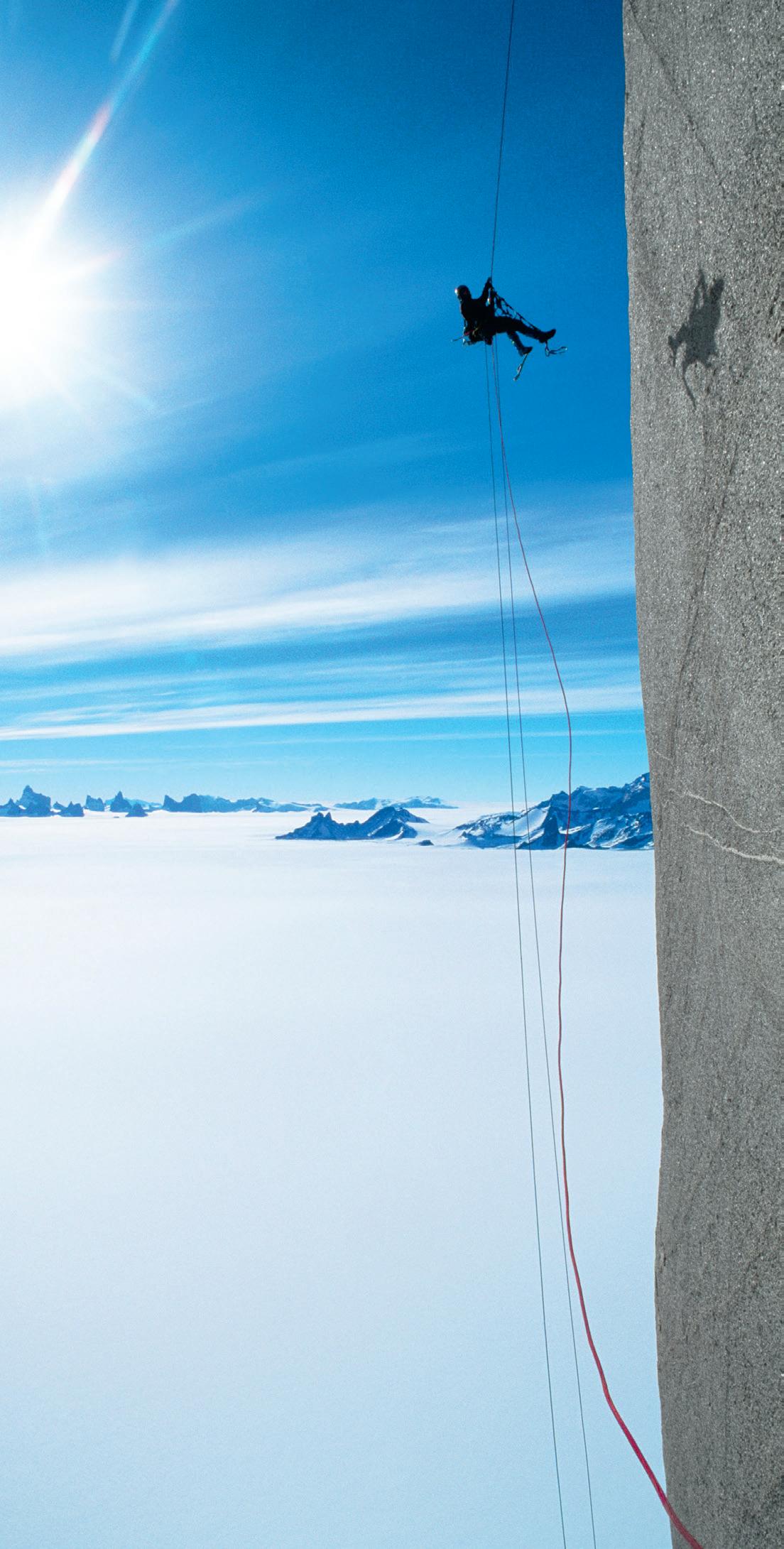
My positiveness and my commitment to living life fully; it comes from my understanding of nature.
-Rick Ridgeway
You know you’re off the edge of the map if you burn the map. Rick Ridgeway
Gordon Wiltsie
Scaling that rock wall in Antarctica was as close to being on another planet as you could be on our own Earth.
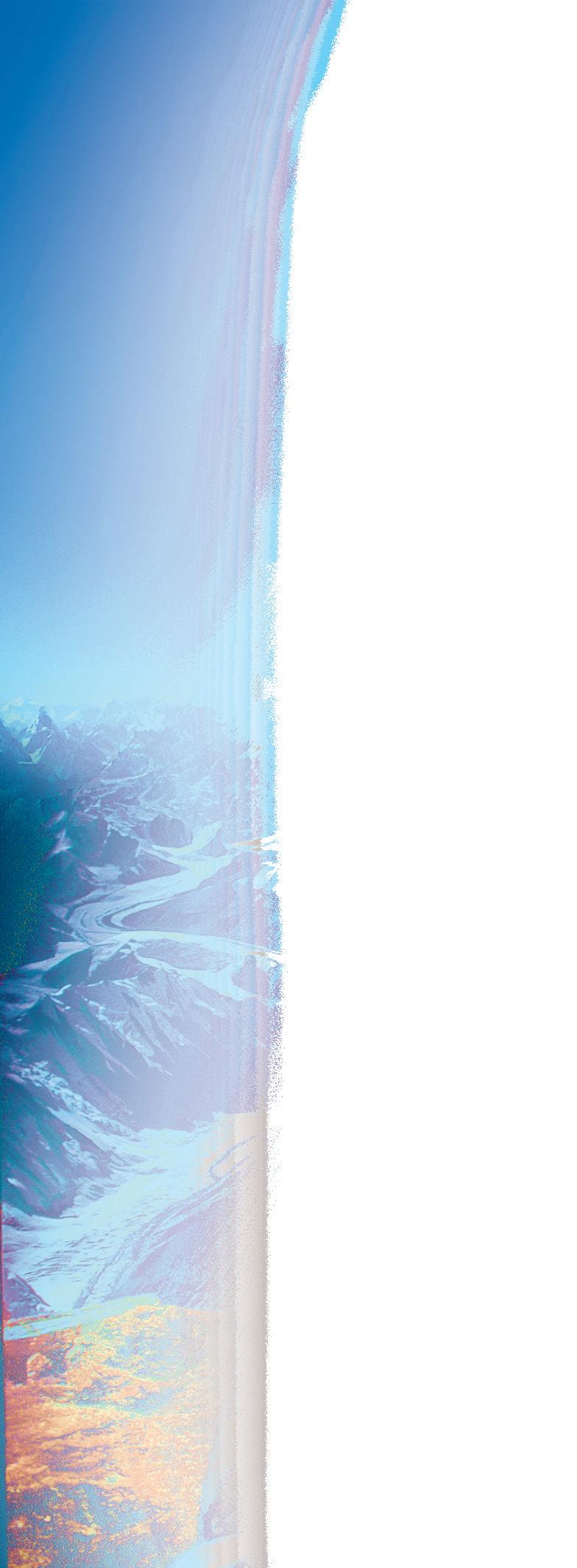
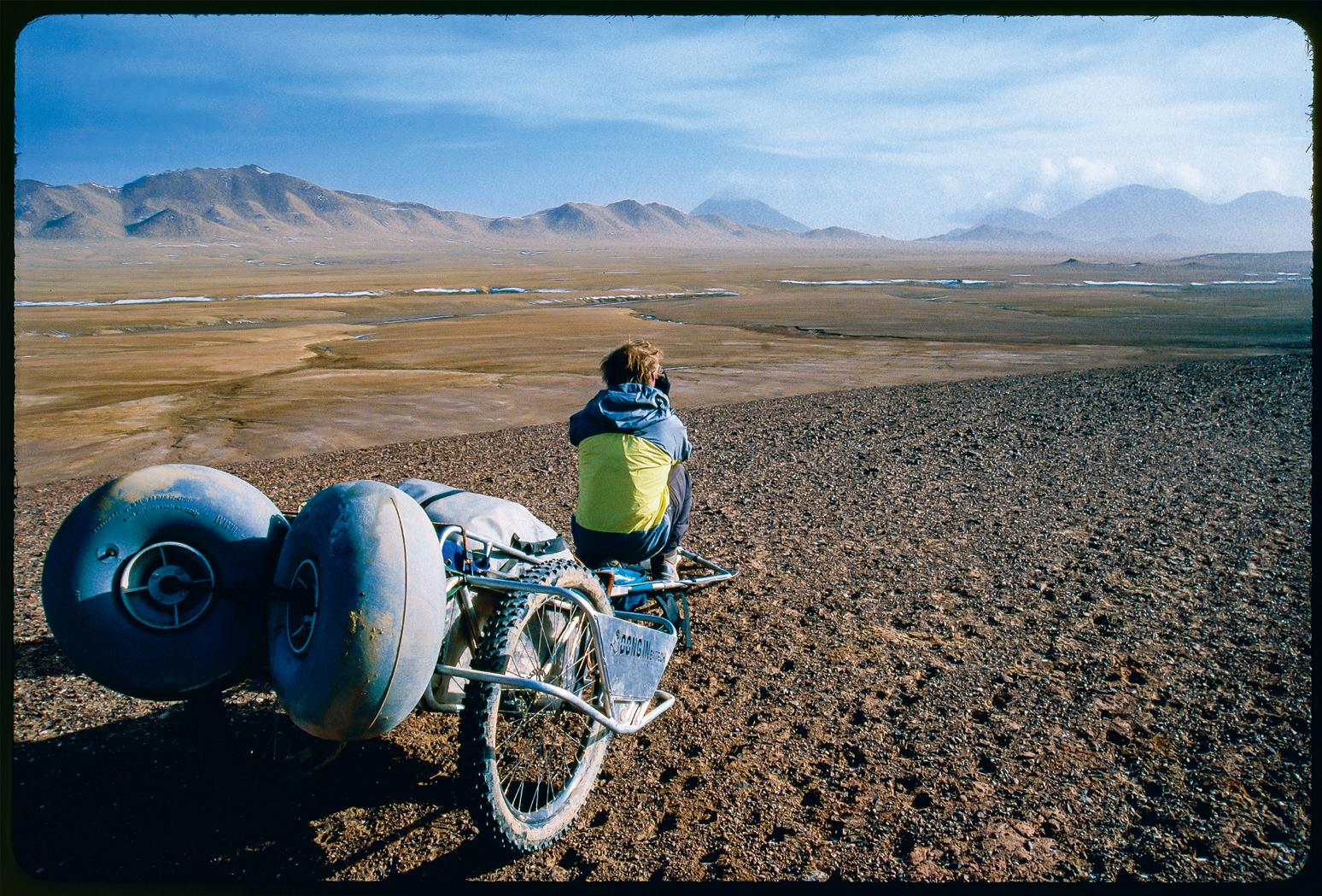
ON SPIRITUALITY & RELIGION
Ethan Stewart: You make the statement early on in Life Lived Wild that you are not a religious man and yet, from my perspective, the book sparkles with spirituality, a spirituality that seems to serve you well as you navigate the various challenges and brutalities of a life lived in pursuit of nature. Talk a little bit about how you parse the secular from the spiritual?
Rick Ridgeway: Most religions are built around some idea of an afterlife and some idea of a God – or Gods – whose hand has created our world. I’m skeptical of both of those things. But, as I write in the book, my wife, though she wasn’t aligned with any organized religion, she was religious in her sense of being open to all possibilities. She believed in spirits and believed in other parallel lives. She was open to any possible explanation, and she taught me not to close any ideas out of the realm of possibility, and I follow her advice to this day. I truly believe that any sort of explanation remains possible;
I just personally remain skeptical that there is an afterlife that has any form similar to life as we know it in the here and now on our planet Earth.
Similarly, I’m also not convinced that there is a mastermind overseeing the universe. But rather, I believe the universe is operating, like nature does, in some grand, self-willed way, that is beyond the pale of understanding for our species, at least at this point in our evolution…Now, all of that rolls up into kind of spirituality. So, yes, I do consider myself a spiritual person in that sense. And one thing I’ve noticed in myself over time is that the older I get, the more emotionally connected I seem to be getting from an empathetic point of view to all life on earth. I find myself doing this much more than I was in my younger years. It’s interesting to see how that’s evolving in me personally, to where I just feel a more empathetic alignment with all of the creatures on the planet. For example, when I woke up this morning, there was a spider in the sink that had fallen in and was crawling desperately to try to get out. There were so many years of my life when I would just turn on the faucet and down it goes. But nowadays, I react differently. I took such care this
Day two of our foot traverse across the uninhabited and unexplored northwest corner of the Chang Tang Plateau, Tibet. Ridgeway is surveying that day’s route during the self-supported trek pulling rickshaws each with 250 pounds of food and supplies.
Jimmy Chin

morning to gently pick the spider up so that I wouldn’t injure it, and then I took it outside and let it go. And I didn’t even think about it. It was like a reflex. It was only afterwards that I thought, “Wow, I didn’t always act that way with sink spiders. I wonder, what is this about?”
ES: An evolving spiritual vantage point perhaps?
RR: Maybe so…I was in New York last week and I got an award from the Explorers Club, the Adventurer’s Award, which is kind of their highest honor. I’m not really into medals and I certainly don’t need merit badges. I mean, at this point in my life, I don’t necessarily even like flags anymore, or what they represent, anyway. And that organization is all about those things in the main. But there were other people there receiving recognitions, including two of my heroes, Beverly and Dereck Joubert. They
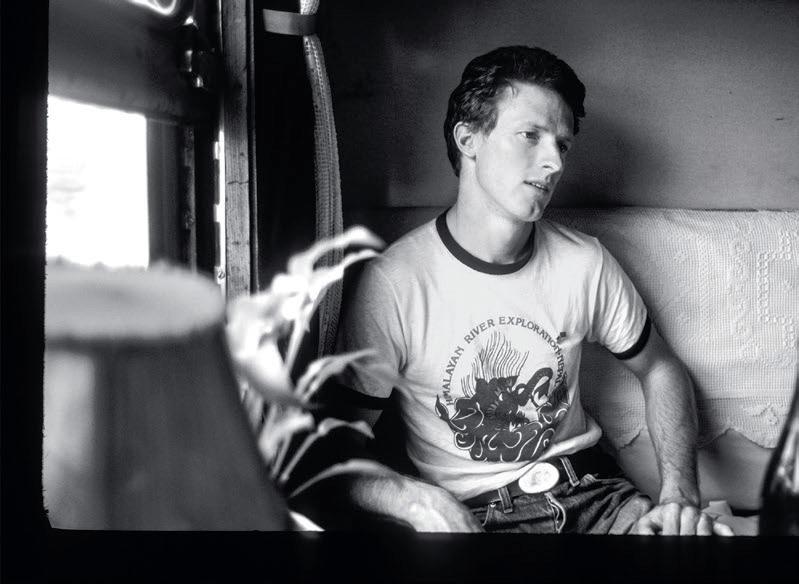
Doug Tompkins, Rick Ridgeway, and Yvon Chouinard (L to R) on the summit of a previously unclimbed and unnamed peak in what in 2008 was still the future Patagonia National Park, in southern Chile.
Jimmy Chin
had this film clip that they showed: a pride of lions attacking a juvenile elephant somewhere in Africa. It was so violent and the elephant was crying in terror and pain. It totally shut the audience down. And it released an empathy in me. It did that for everybody, I’m sure, but for me it was deeper than anything I ever would have felt in an earlier part of my life. I was inside of the lions and the elephant, deeply understanding the realities of both predator and prey. I was experiencing the attack from a place of knowing and relation.
And then the elephant fell. It went down and the lions really went to work on it. The violence was only getting worse. But then, all of a sudden, after another 15 or 20 seconds of the elephant seemingly being eaten for lunch, it jumps up on its feet and violently shakes off the lions. It thrashes and desperately swipes

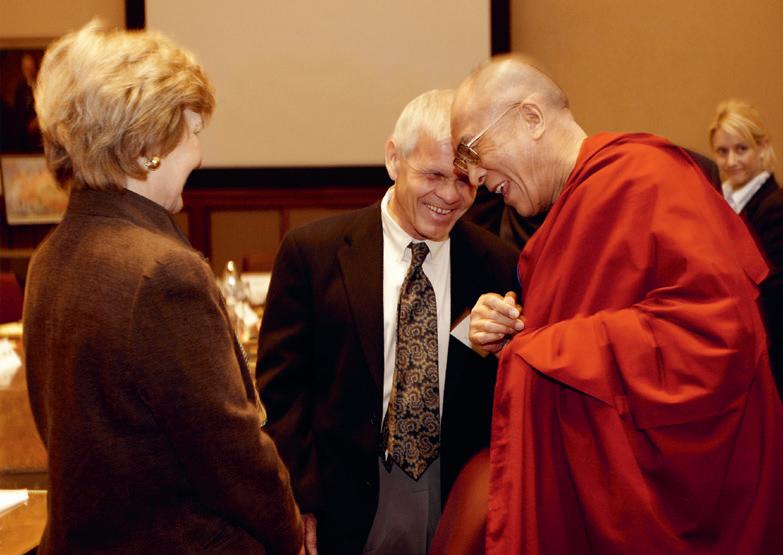
and knocks them out. This juvenile elephant that we all were certain was about to die gets up and recovers and survives.
ES: Woah.
RR: The whole audience was in shock when the clip ended. Nobody was saying anything. And then Derek and Beverly very quietly speak into the microphone: “That’s the lesson.” I tell you this story because I think it relates to your question about my spirituality or my religion or my lack thereof. That experience I had of feeling as though I was in the heads of those animals, that I had some deeper understanding of what was happening, that could relate to it in some profound way- that is what life on earth is all about. That’s what spending a lot of time in nature, in wild nature, is all about: a deepening understanding of how nature really works and how I’m a part of that. To me, that is spirituality.
Ridgeway with The 14th Dalai Lama
Rebecca Hale
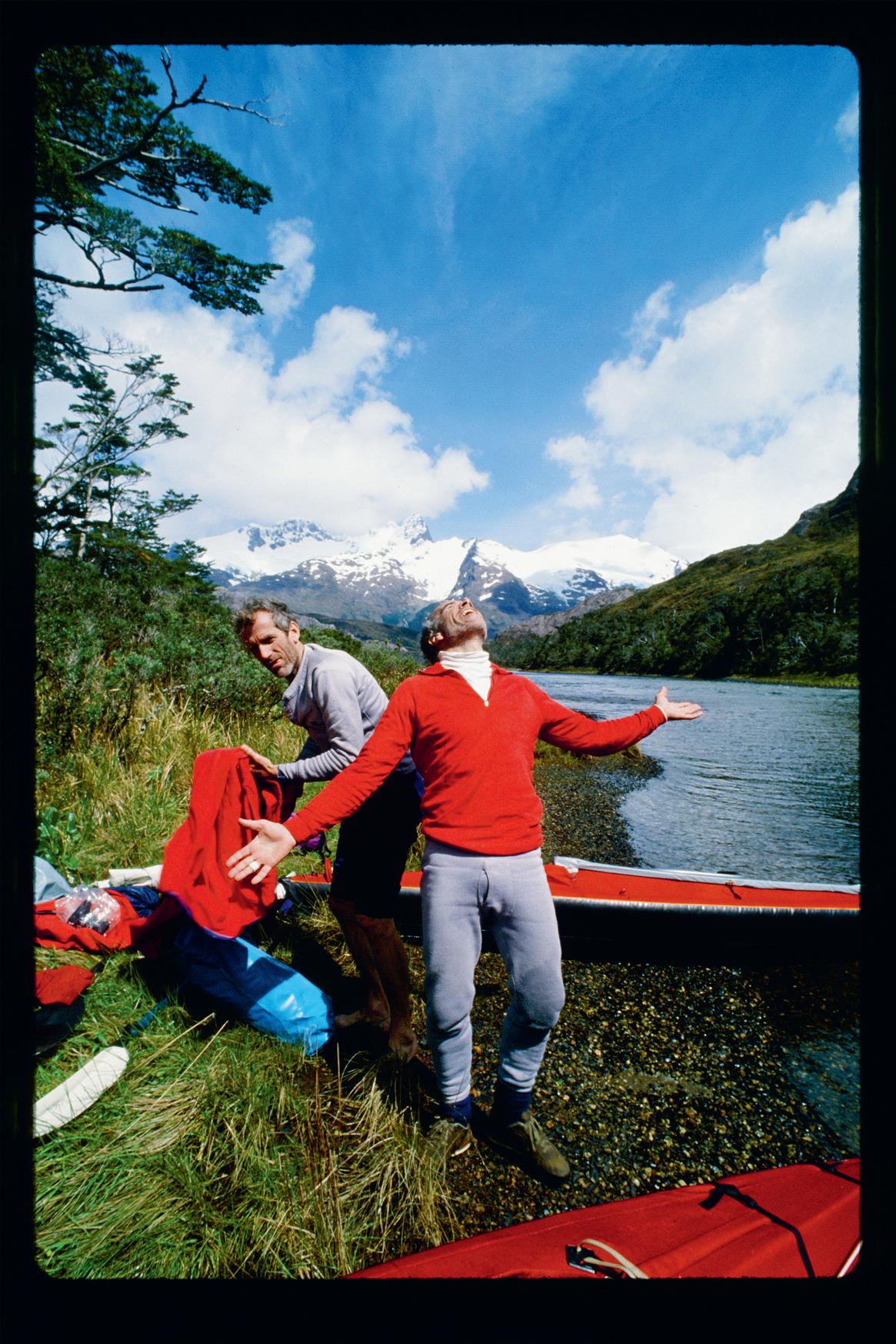
It’s a life following not just passions, but obsessions, and I think that’s the kind of life that I’ve lived.
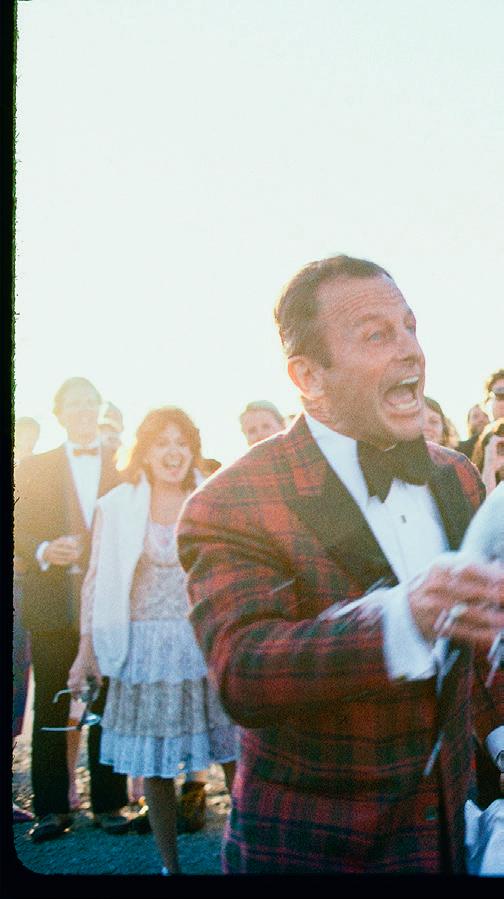
Rick Ridgeway
Dick Bass (left) and Frank Wells at the black-tie Seven Summits celebration at the top of the tram at Snowbird.
Jim Donini (left) and Doug Tompkins celebrate the only sunny day on the entire sea kayak and climbing adventure in the southern fjords of Chile.
Rick Ridgeway

INTENTION VERSUS LUCK
ES: Your story develops in a what seems to be a series of happy accidents, or not so happy accidents, as was the case on more than one occasion. This remarkable life of adventure and success and friendships and hard lessons learned seems to unfold as organically as a blooming wildflower. And yet, there is a sense of purpose to it all. An intention, if you will. Have you lived an intentional life?
RR: Well, it is intentional, but it’s maybe a different kind of intention than what you are suggesting. On one hand, there is the kind of intention where a young man or woman sees his or her path and clearly identifies where they want to go. They commit to getting there and they live that kind of an intentional life in order to arrive at their desired destination. But there’s another kind, which would represent my path, where people who have a tendency towards obsession, which I think I do, identify something of interest that they obsessively go after, so
much that you could label it intention or intentional. But that’s a little bit of a different kind of an intentionally lived life. It’s a life following not just passions, but obsessions, and I think that’s the kind of life that I’ve lived.
ES: And what is that obsession for you? How would you define it?
RR: It’s when you run into something that really captures your fancy and you just go deep into it. More to the point, you go into it with a razor focus such that most everything else falls out of view. Outdoor adventures and explorations in wild parts of the world have been a lifelong obsession of mine. And I’ve gone after that with razor focus and intention, to use that word again. From the outside, that perhaps makes me look like I’ve led an intentional life, when really I’ve led a life simply following my obsessions.
ES: Obsession is an interesting word to use in this context. Too often we think of “obsession” as a negative thing when, clearly, that isn’t always the case.
RR: You know, this whole conversation, at least for me, brings up the topic of luck. Because a lot of people live their lives going down one path, and then they encounter something or some outside influence or event that sends them down an entirely new path. Certainly I’ve done a bit of that, and you probably have as well. Often, this gets chalked up to “luck.” This happens especially when someone who might be envious of another’s lot in life sees how someone was “lucky” to have met someone or encountered some situation that led them in a new direction in life and resulted in some sort of success. We often hear people say, “Oh, they were just so lucky.”
But I always want to look at that word and the assumption that is behind it a little more carefully. When you dig into it a little deeper you often discover that what is one person’s “luck” is another person’s ability to identify an opportunity and to seize it. There is a big difference between those two things.
So certainly the ability to have a sense of where you want to go and then have a radar that can identify an opportunity when it comes across your bow, that’s a pretty important talent. Maybe it is an instinct, an instinct for recognizing when there is a chance to take a bit of a turn and perhaps go down a different path, or, if you are going to stay on the same path, maybe it gives you the chance to approach things differently and get better results.
An example of that from my life is when I sought out the conservation biologist George Shaller in the late nineties. Asia Wright had asked me to take her back to Minya Konka in Tibet to find her father’s grave on the mountain. As you know, this is something I write about in the book. I wanted to take her on a climb as part of the trip as I knew her father would’ve wanted to do that. But I was horrified at going any place in the Himalayas where there was avalanche danger, as that is
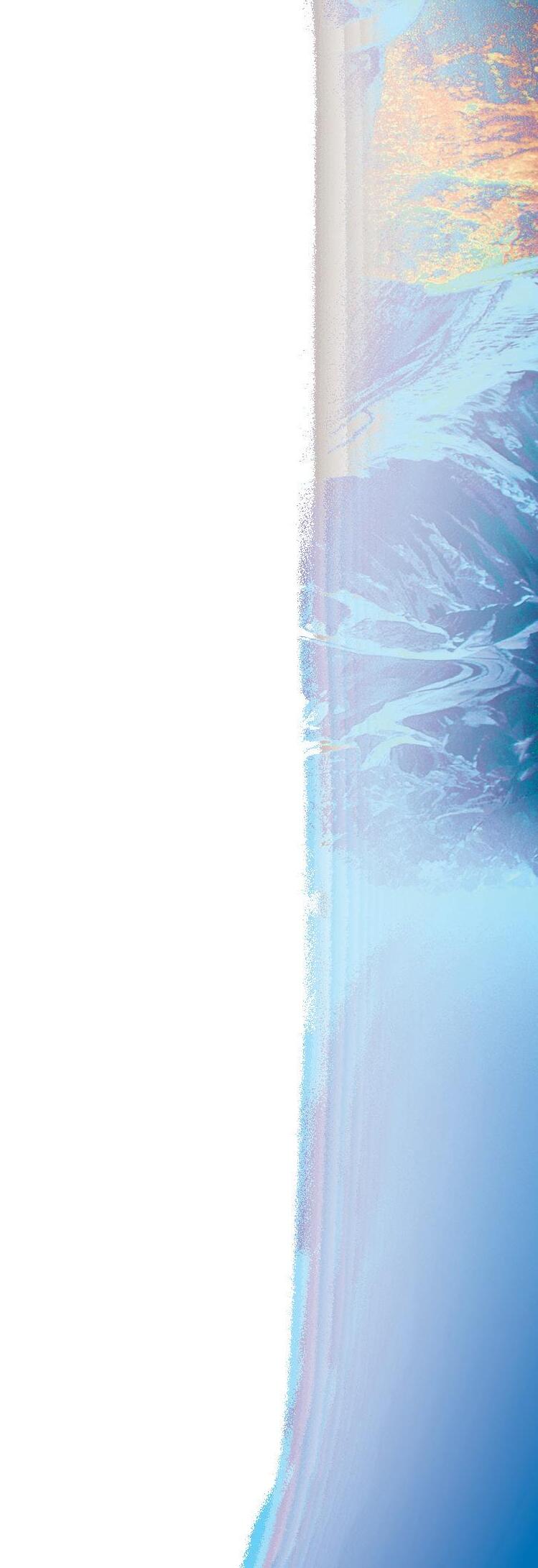
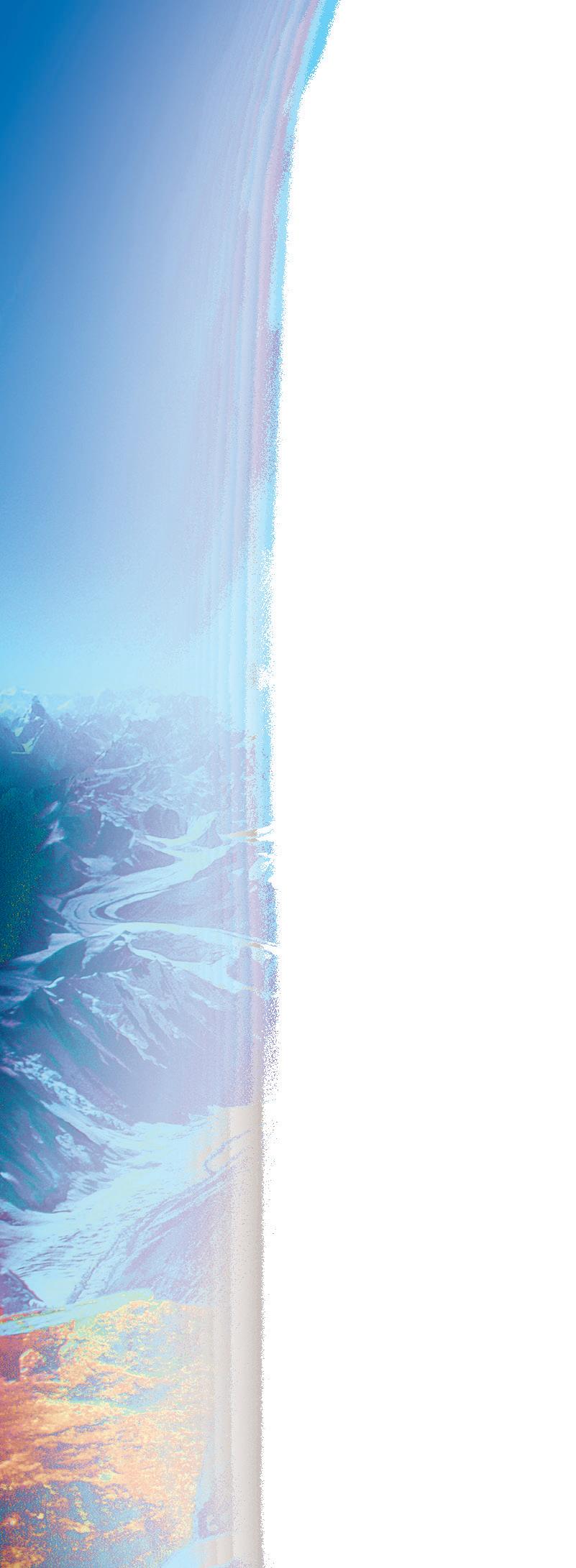
how we lost her dad. And the only place I could think of that didn’t have much avalanche danger was out on the west side of Tibet where there isn’t much snowfall, and what they do get is really dry and consolidated. But that’s also a place that is really hard to access.
I remembered reading that Shaller was basically the only outsider who had explored that region in modern times, so I sought him out for some insight on how best to access that region of northwest Tibet. And he did help me out a great deal. It was during that conversation, almost in passing, that he started telling me about these Tibetan antelopes called chiru, and how he had been trying to find their calving grounds. But the place was so remote and rugged that he could never get there. He even tried to find it with a camel caravan crossing the Kunlun Mountains from China, but it was so extreme that the animals started dying before they could find the breeding grounds. In order to better protect the chiru, he really needed to figure it out, and he needed to do it before the poachers.
I’m not denigrating anybody here, but a lot of people just would listen to that story and think, “Oh, that’s cool. Wow. Good luck.” But, as he was telling it to me, my little mind was going, “Jesus, calving grounds, he can’t get there. Could I get there?” That’s where my mind went immediately. And then a whole line of thinking followed about of how to possibly pull off that expedition. Could I get some of my climbing buddies, people who have the skills to be self-supported and know how to be tough, could I put together a team and possibly find this place? We were physically strong enough to walk long distances in the mountains, and we knew how to stay alive. Maybe we could follow those animals on foot and let them lead us to their calving grounds. That moment of wondering became the origin of the most rewarding expedition of my life. Sure, some might say I was “lucky” to run into George and hear about the chiru problem, but no, no it wasn’t. It wasn’t luck. It was an opportunity, and I knew it straight away.
ON ADVENTURE & THE ENVIRONMENT
RR: I’ve been very fortunate in my life to see so many different places on this planet. I’ve also been fortunate for whatever reason— be it physiological or mental or some combination of the two— to equally enjoy being in such radically different climates and landscapes. They are all challenging in their own way as well as attractive. I equally enjoy all of them. I love the Arctic and the Antarctic and everything in between. That includes the oceans. It’s really hard for me to
favor one over the other. If it’s wild nature, I deeply love it.
ES: What are some of those extremes?
RR: Probably the coldest I’ve ever been was 70 below zero up near the summit of Vinson Massif, the highest mountain in Antarctica. And that’s not windchill temperature. That’s absolute temperature. That is probably the most brutal I have been in. And then, in the Kalahari Desert, I’ve been out in temps up to 51 degrees Celsius. So, what’s that? About 123 or 124 degrees Fahrenheit?
ES: Woah.
RR: Yeah. that’s the extremes. And I was able, in a weird way, to enjoy it all. I don’t run into too many people that have that kind of a temperature range that they can be okay in, so I suppose I have been a bit gifted in that regard.
ES: You’re built to last.
RR: (laughs) So far so good.
ES: Where does the confidence come from to take on something like that, be it an expedition into the extreme cold or the extreme heat or, in the case of the chiru, into the complete unknown?
RR: Well, with the chiru, it was an extension of using our climbing skills to figure out how to walk on foot that far and at that elevation following those animals. And we had no idea if we were going to succeed. Probably the biggest moment of unknown for us was when we got to the place where the vehicles dropped us off. We had driven completely off road for like 2 weeks straight, going just under 1000 miles off road in mostly muddy conditions. It was like driving from Los Angeles to Portland, Oregon entirely in 4wd. Eventually we got to this place in northwest Tibet where we just couldn’t go any further. So we assembled our rickshaws and started loading them up. The truck turned around and went the other way, headed home in the direction that it had come. And there we were, the nearest human beings maybe about 300 miles away. Fifty miles ahead of us was a stretch of country that no outsider had ever seen before. The average elevation of the route was above 16,000 feet. We had a general idea of what was going to be there, because we had some basic satellite information, so it wasn’t completely unknown. And yet, for the early part of the 21st century, it was as unknown as you could possibly get on planet Earth on any terrestrial landscape.
i26 Photo & Art Annual |
ES: Now that’s an adventure.
RR: We didn’t know if we could find the chiru, so that was probably the biggest unknown for us. We were pretty confident that, one way or another, the four of us – myself, Conrad Anker, Galen Rowell, and Jimmy Chin – we could get out to the other side alive. We had thought it through. We had enough water bottles to have three or four days of water. We made the commitment, despite all the weight, to force ourselves to always carry three to four days of water at all times. And then we had our food sorted like you would for any challenging overland expedition. And then we asked ourselves, well, what if one of the carts breaks? Or, what if somebody gets sick? What if somebody gets injured and we have to abandon one of the carts and carry somebody in the other one? We thought through all those things and came up with solutions. For example, if we miscalculated and we were going really slowly and we ran out of food, we had wrist rockets with us, high powered slingshots to shoot rabbits. Rabbits are one of the only mammals that live out in that region other than the chiru. We were ready. We had backup plans and contingency plans, so I felt good about being able to get out the other side. But when it came to finding the calving grounds, we weren’t so sure we would be successful, but it turned out that we did.
ES: That’s one of my favorite parts of the book. I really enjoyed that story. Such an impressive feat. And it seems like that experience for you was seminal in helping crystallize some of the environmental thinking that has shaped much of your life in recent years.
RR: Well, the environmental thinking was already going in that direction. That’s why I wanted to do that expedition in the first place. I was kind of over climbing mountains just to get to the summit. That sort of goal wasn’t resonating with me as much as it did when I was a kid. But trying to use the skills I developed reaching summits to try and do what I could, and my buddies could, to contribute to the preservation of an endangered species was something I really wanted to do. It was easily the most fulfilling adventure in my life.

 The day after the avalanche we tried to carry Kim out on a jury-rigged stretcher, but it was too painful on his broken vertebrae. Instead, we gave him morphine, and he walked the remaining three days to the trailhead.
Rick Ridgeway
Chris Chandler on the summit of Everest, in extreme wind, holding onto a survey tripod placed by a Chinese team the previous year. Bob Cormack
The day after the avalanche we tried to carry Kim out on a jury-rigged stretcher, but it was too painful on his broken vertebrae. Instead, we gave him morphine, and he walked the remaining three days to the trailhead.
Rick Ridgeway
Chris Chandler on the summit of Everest, in extreme wind, holding onto a survey tripod placed by a Chinese team the previous year. Bob Cormack

ES: Wow. Yeah, I can see why. I mean, it was a really impressive accomplishment, but it was done with a much larger purpose, right? It’s much more than the individual accomplishment.
RR: Exactly. It’s not about you. It’s about how you can be more than yourself.
ES: Somewhat related, I’m curious what you make of contemporary adventure and expeditions. WiFi is often easier to find than water. Everything is mapped. Satellites are ubiquitous. Being self-centered has become a legit career path. There is no doubt that the nuts and bolts of adventure have fundamentally changed. So, what’s still left out there? Are there still wild places? Or have we got to a point where wild places need to be preserved more than they need to be explored?
RR: It is my hope that anybody who wants to live in nature or experience nature can commit to also doing something about saving and protecting nature. At this point, that’s the work that we simply must do…But, to your question about modern adventure, while there may not be any blanks on the maps like there were for me in my younger years, there’s still so much more exploring to do in the wild parts of this world that remain and elsewhere. Even the places that you might think you already know. That’s been one of the silver linings of the pandemic for me, how I was basically forced to stay in my own backyard. As a result, I was able to get to know my particular part of the world better than I ever had
before. Just going into the hills above and around my hometown of Ojai, here in California, and trying to get deeper into the natural world that surrounds me – that has been very gratifying. As much so as many big, international expeditions. My enthusiasm for more far-flung adventures was already being dampened because I don’t want to burn the fossil fuels to get there. I have really valued this opportunity to discover so much more about where I live. So, there’s these opportunities to live close to nature and discover its magic available for anybody today, even though that discovery has a little different coloring and tone to it now than it did in my youth.
RESILIENCE
ES: Much is made these days about the importance of resilience. It is a concept that kept coming to mind as I read your book. Clearly, you are a man who knows a thing or two about resilience, be it physical, psychological, or emotional. Do you think resilience is a muscle that you develop, or is it something you just come into this world with?
RR: It’s definitely a little bit of both. My instinct is that you are born with it or not. But then I’ve also seen plenty of times where life experience encourages you to develop it…To me, resilience is born of an awareness that death is the prerequisite for life. That awareness has to get deep into your bones so you can put death in its proper context. You can’t have life without death. Knowing this creates resilience, not only against death but against many
other crises in our lives, even things like a pandemic. This is something the Greeks and the Romans and the Stoics, in general, knew long ago. They had this deep understanding that all of us, in our individual lives, are going to face hardships and tragedies. Seeing these hardships and tragedies in the context of the understanding that we are all going to die, that creates the resilience. The more you practice this and the more you let the truth of death being a prerequisite for life deep into you, the more you are able to live with resilience on a daily basis.
ES: So resilience is, maybe, the result of awareness?
RR: To me, the deepest origin of this understanding is in the understanding of how nature really works. And that ladders right back to where you and I were discussing the film clip of the lions and the young elephant.
ES: What is the fuel for that? What powers resilience on an expedition or even in everyday life? Is it mental or physical?
RR: That’s a good question. I would actually say that mental side is a little bit more important, but clearly you have to have both. But if I had to pick one, I’d say that the mental part is probably more important than the physical part. And the mental part, it needs to include more than just tenacity. The whole task of doing something like that rickshaw expedition is easier when your mental attitude includes an ability to remain positive, and, dare I say, joyful under hardship.
i26 Photo & Art Annual |
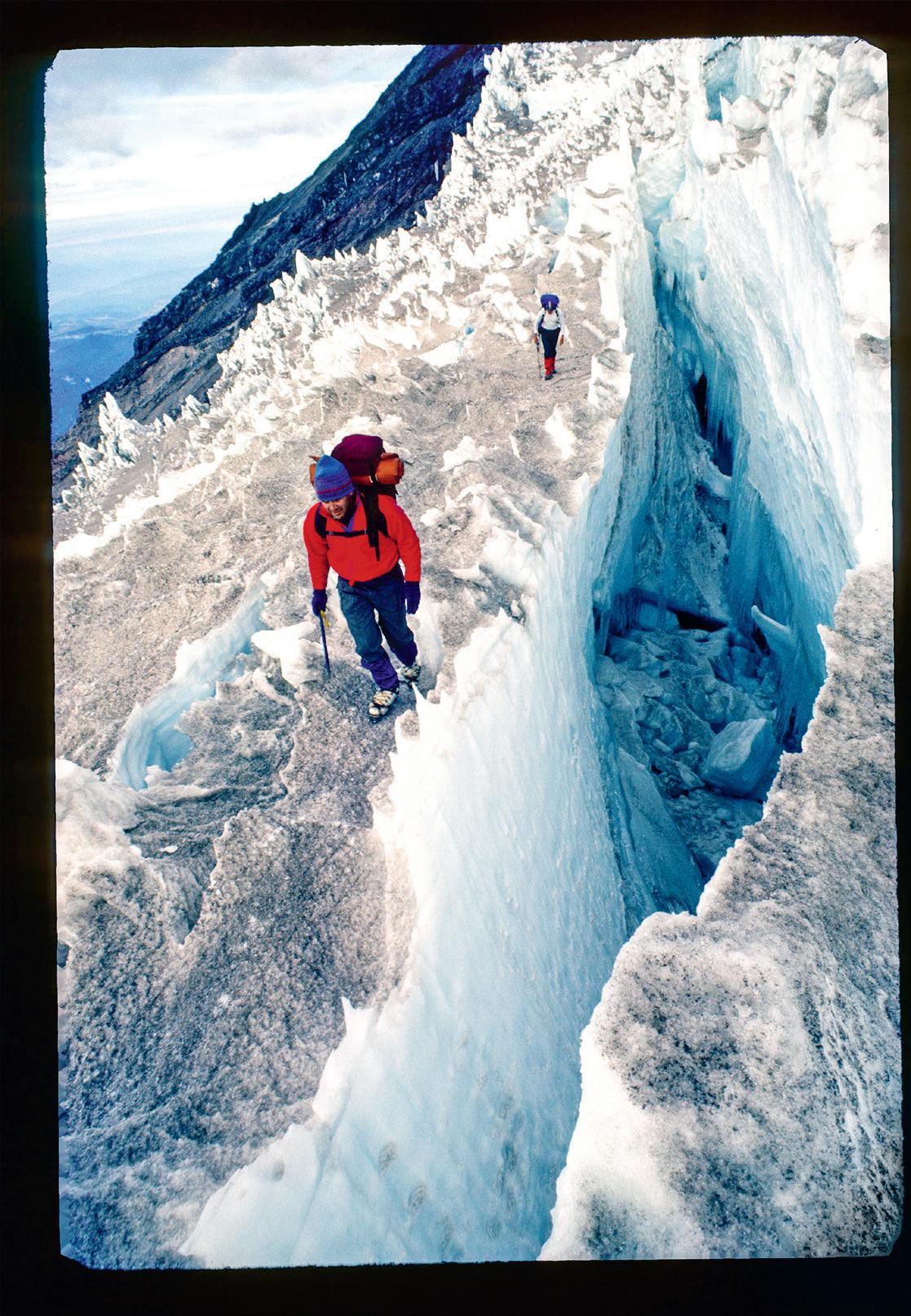
It’s not about you. It’s about how you can be more than yourself.
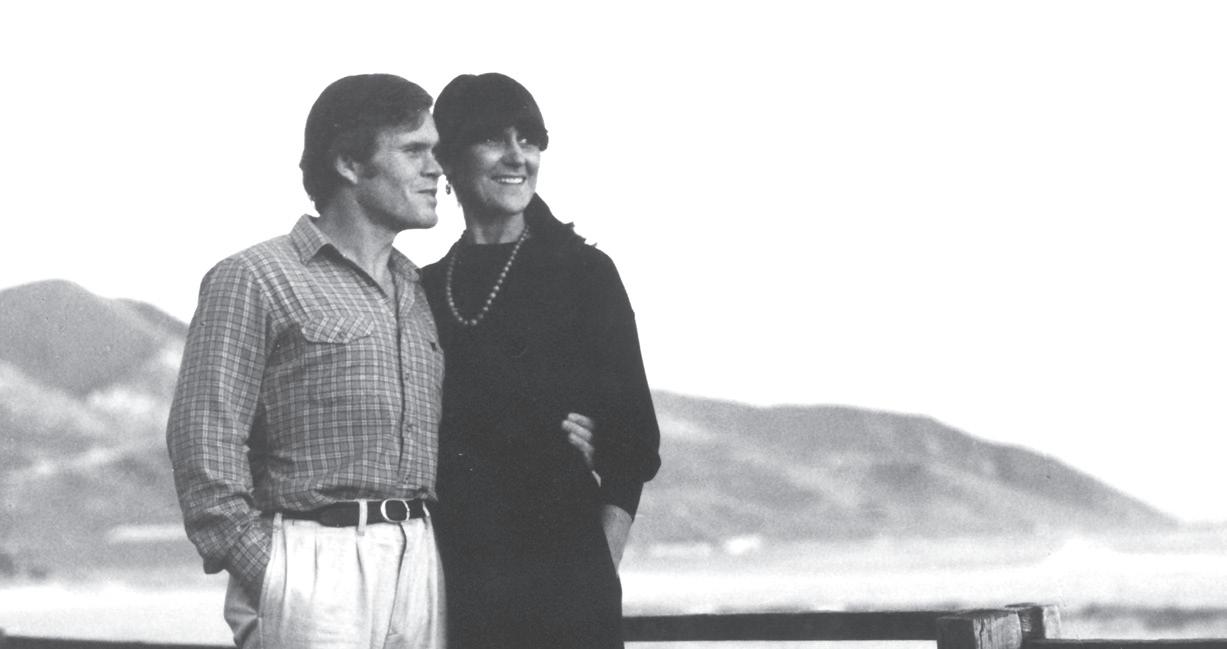 Lear Levin Jennifer and Rick in 1982 shortly after we married, in front of my surfer’s shack “just south of Montecito.”
Tom Brokaw, on his first snow and ice climb, skirts a crevasse on the Kautz Glacier, Mount Rainer. Rick Ridgeway
Lear Levin Jennifer and Rick in 1982 shortly after we married, in front of my surfer’s shack “just south of Montecito.”
Tom Brokaw, on his first snow and ice climb, skirts a crevasse on the Kautz Glacier, Mount Rainer. Rick Ridgeway

ES: Smiling while suffering.
RR: Yes. And that’s the reason Conrad had identified this young kid named Jimmy Chin as somebody that we might want to consider bringing along on the chiru trip, even though he wasn’t that experienced at the time. He was only 29 years old, but Conrad had been around him enough to recognize that this young man had that special ability to laugh at adversity. Not laugh at it in any sort of trite way, but rather, no matter how hard the going went, he could always have a little smile on his face because, at the end of the day, he was enjoying himself. He was enjoying where he was and enjoying being with the rest of us. And we were enjoying being with him.
ES: That was one of Jimmy’s first big expeditions?
RR: Yes. And that attribute of his personality, that ability to smile and suffer at the same time, that was why we chose him. And I think that’s why he’s been so successful in what he’s done in the years since. Of course, it’s not the only reason, but it’s a very significant component of Jimmy’s success.
ES: How did that show up during the rickshaw mission?
RR: Well, in lots of ways, but I remember this one time early on in the trip. We were pulling our carts through this really rough area and he was struggling to get his cart over a rock. He tilted it too far, and all of a sudden the cart flipped over. We were attached to these carts by aluminum poles and harnesses, so the cart flip and fall violently whipped Jimmy upside down and planted his head into this rock pile. I ran over and helped him unclip his harness and pulled him out, blood visibly running down one side of his head. And then I noticed the back of his shirt, a big, fresh blood stain was coming through. Turns out, he had pretty sizable cut and hole in his back from slamming into the sharp rock. So I get him unhooked and help him sit down before digging out the first aid kit. He’s sitting there with his back against a rock, visibly bloody and beaten, and instead of cursing or anything, he’s got this funny smile on his face. He looks at me and says with a laugh, “Rick, you never told me that carting is a contact sport.” He was laughing at himself for letting the cart flip him upside down. That’s what I’m talking about. That attitude and that ability to laugh in the face of adversity or smile at it, actually grin at it, is one of the things that got him through. And it’s one of the big reasons why he has been so successful.

Rick, you never told me that carting is a contact sport.
-Jimmy Chin
 Chris Chandler (kneeling) and I puzzle-out a potential route through the Khumbu Icefall. This is the most dangerous part of climbing Everest from the Nepal side. Today teams of Sherpas scout and maintain the route for clients paying guide services over $100,000. Back in the 1970s, we had to establish the route ourselves. Johan Reinhard
Rick Ridgeway sporting one of the carts from his Tibetan Plateau expedition while en route to a booksigning event last December in Bozeman. Conrad Anker
Chris Chandler (kneeling) and I puzzle-out a potential route through the Khumbu Icefall. This is the most dangerous part of climbing Everest from the Nepal side. Today teams of Sherpas scout and maintain the route for clients paying guide services over $100,000. Back in the 1970s, we had to establish the route ourselves. Johan Reinhard
Rick Ridgeway sporting one of the carts from his Tibetan Plateau expedition while en route to a booksigning event last December in Bozeman. Conrad Anker

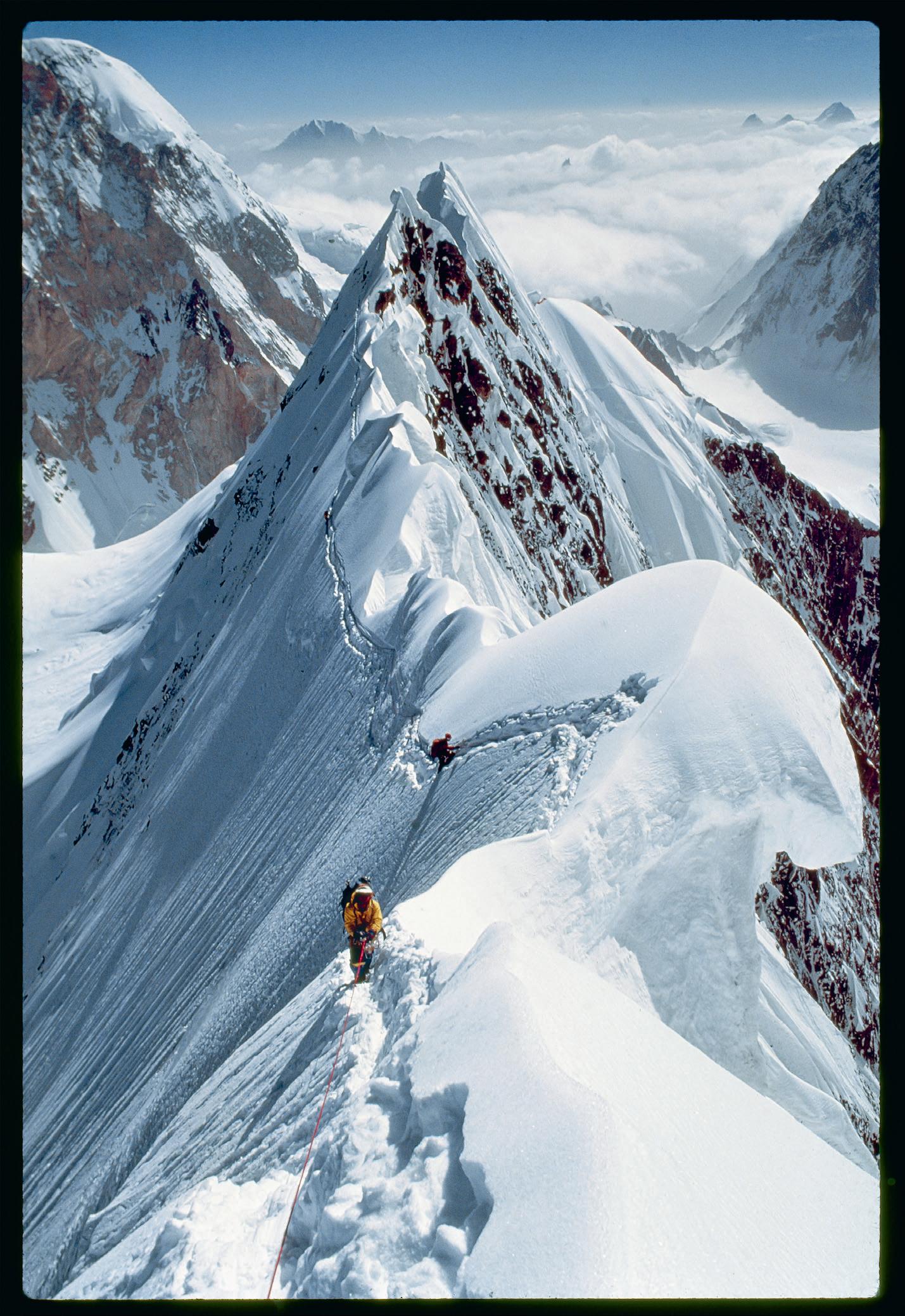
The northeast ridge of K2, the
can just see the tents at
knife-edge. Ridgeway in the foreground with Lou Reichardt behind as we approach Camp IV at about 23,000 feet. You
Camp III at the far end of the knife-edge. John Roskelley

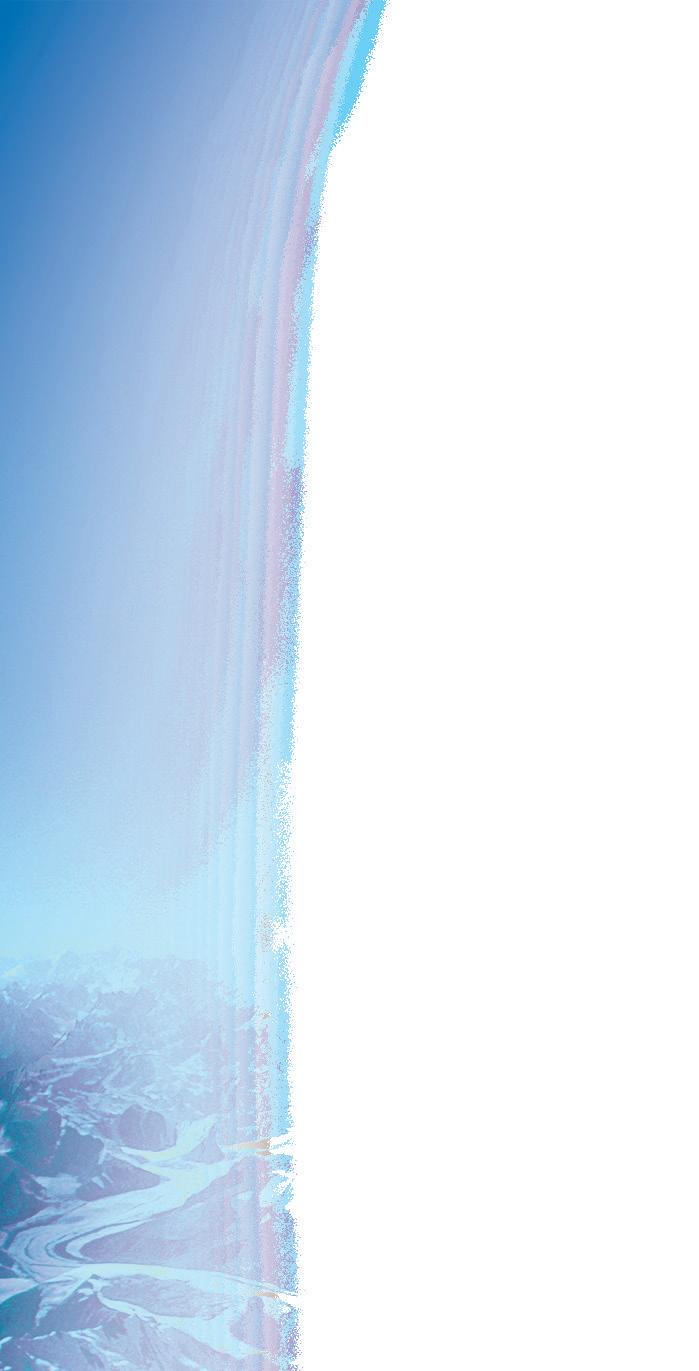
DEATH & THE COURAGE TO CONTINUE
ES: You are no stranger to loss. And brutal loss at that, having had to say goodbye far too soon to your wife and some of your best friends and mentors. How do you carry on?
RR: To answer that, I would go back to where we started our conversation, with that discussion about spending a lot of time in nature. And then, from that time in nature, learning, as I said earlier, that death is the prerequisite of life. That’s where my own ability to find a meaningful path in my life, even after the death of my wife and the deaths of other friends, that’s where it comes from. My positiveness and my commitment to living life fully; it comes from my understanding of nature. And I hope that message is the main one that comes through to readers of Life Lived Wild. I hope my sharing of these stories helps people to see that the fullness of life is rooted in spending deep time in nature, and wild nature.
ES: So would you consider the original sin, so to speak, of modern man is when we decided, at least in a broad sense, that we were separate from nature?
RR: That’s certainly part of it, but the larger, deepest sin is not only thinking ourselves separate, but thinking ourselves superior to nature. That is the biggest sin. The ultimate hubris. The sin of believing that nature is here merely to serve our needs instead of the other way around. That’s probably the biggest sin of our species, because that’s the sin that has landed us in the predicament that all human beings are facing right now with the environment. It’s as existential as it gets.

LIFE LIVED WILD: ADVENTURES AT THE EDGE OF THE MAP
was published by Patagonia Books in 2021. You can find it at your favorite bookstore or online at: patagonia.com.
For more of Rick’s adventure yarns, go to: rickridgeway.com
i26 Photo & Art Annual |
On the summit of K2, September 1978, the first American ascent and first ascent without oxygen. John Roskelley
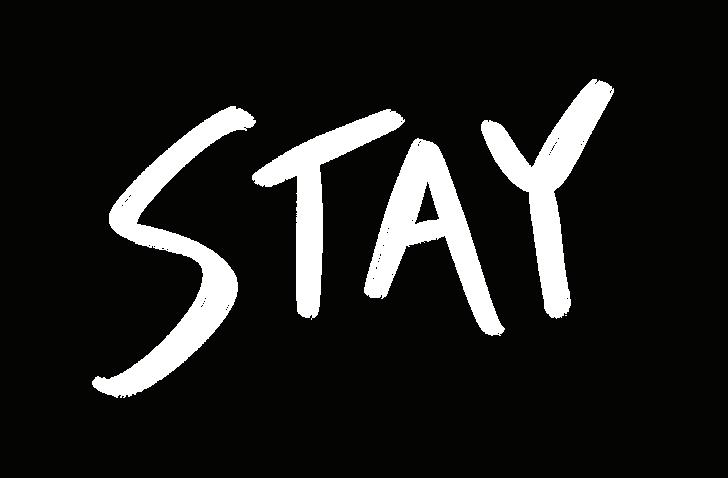

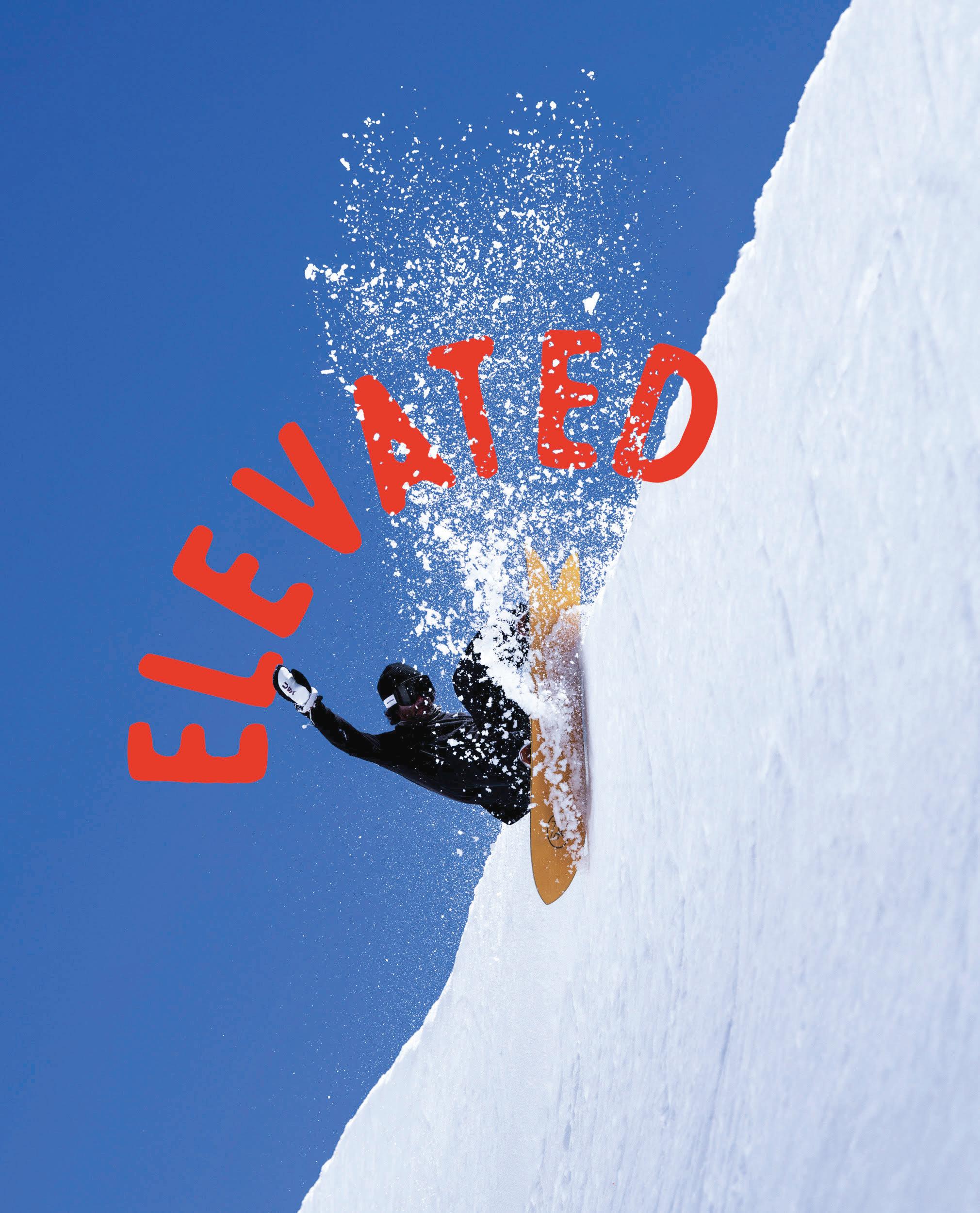


@el eva t ed sur f cr af t Rider : @ j j thomas Photogra her : @m i kedawsey Boar d: 4 ’ 10 Gol dFish

BAJAS WE neeD
46 |
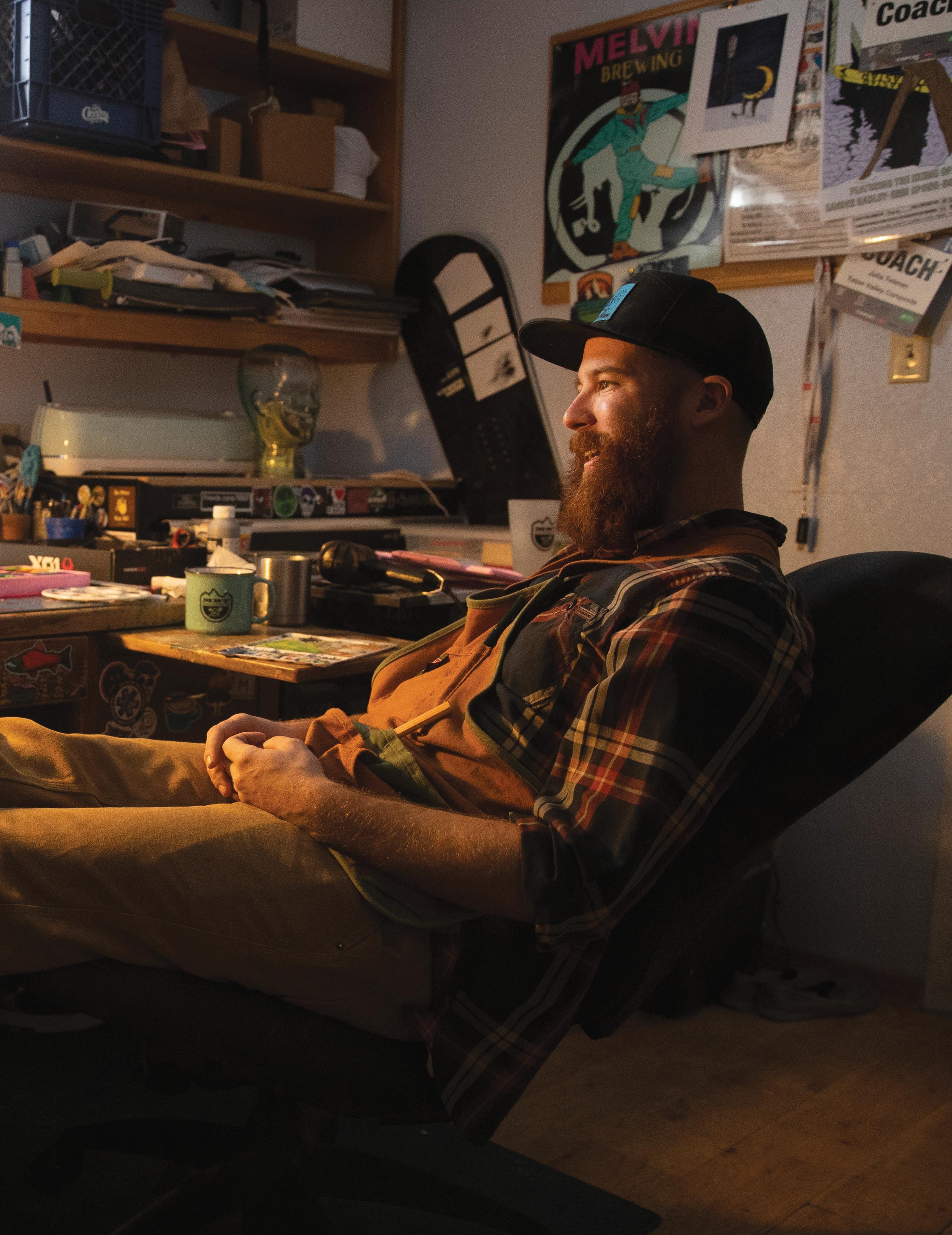
Cy Whitling’s an Artist and an Asset
WORDS + PHOTOS Emily Tidwell
“I’ll pick you up at 9,” chimed
Cy Whitling on the phone the night before our plans to go skiing. It was late December of 2021, and when I pulled open the door the next morning at my best friend’s house in Driggs, Idaho, sure enough, there was Cy. He stood out front with his red grizzly man beard flecked in snow, his silver Subaru Baja blurring into the backdrop of last night’s accumulation and a whipping wind. He wore a brimmed hat pulled low to keep the spindrift from his eyes. The hat was hand-painted with pine trees, their branches laden with a winter’s worth of snowpack. The art was not dissimilar from the landscape around us.
“We’re gonna need to do some Tetris to get all the skis in the back but, really, this is our most winter ready car – we got it yesterday,” joked Cy as he and his wife, Julia, attempted to pretzel my skis into the short bed of the Subaru. Avril Lavigne blared from the stereo of the cab and a sticker declaring
“At least it’s not a Sprinter” was slapped dead center on the back window. As we pulled out of the snow-drifted driveway and jetted towards Teton Pass, tour skis rattling in the back behind us, I thought to myself, this really isn’t a Sprinter. It’s the complete opposite, really. This is Cy Whitling and this is his rig. He’s the Baja to the Sprinter. A man who does not fit the mainstream mold. Despite his artistic successes, he remains non-pretentious, refreshing in his approachability and practicality. His quirky, often humorous, and relatable illustrations have created a path where once there was none, leaving room for a new generation to follow in his steps. He is a Baja, and we, the people of the outdoor community, need more Bajas.
Cy’s art creates a unique world of whimsy meets reality, all of it set in the west with a tinge of action sports romanticism. His is a blend of illustrations that look like sketchbook doodles splashed with watercolor and crosshatched with pen. It is mountain bikers soaring off dirt jumps through groves of yellow and orange aspens. It is ski patrollers placing bamboo poles and snow makers inspecting their equipment, both immortalized in stained glass illustrations. You can feel the way Cy values these moments he captured, their importance to daily life in a mountain town celebrated by deep blues and ruby reds. Some of his most popular and regular works are done comic strip-style: truth-telling, topical and humorous depictions of the dynamic relationships and conversations you encounter in the mountains west. If you live in “Wydaho,” you’ve likely seen his work displayed in your town.
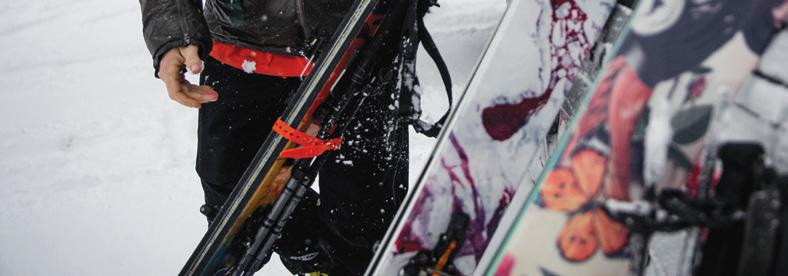

Further afield, Cy’s work can be found everywhere from magazines and online articles to ski top sheets, graphics on skins, and even, rumor has it, in a forest service restroom or two.
I first met Cy nearly a decade ago while working for a website called Newschoolers, where frothy Gen Z’s and elder millennials came together online to talk gear, skiing, and photos in a forum-style chat. Cy was taking pictures for a living and was my first friend at the job, dishing out photography advice right as I was getting into the game. “I was really set on being a professional [photographer] at that time,” remembered Cy during our impromptu interview on a snowy skin track. Back then he was working both as a writer and photographer for Newschoolers as well as the popular podcast and website Blister Gear Review. He was going pretty hard in a pretty traditional direction. That is until fate, with a little nudge from Mother Nature, decided to intervene.
“One year, there was a bad snow season in Northern Idaho. Where I was living there was nothing to shoot,” Cy explained while ripping skins at the top of our line.
“That was the same year that the Bomb Snow 10-year
i26 Photo & Art Annual |
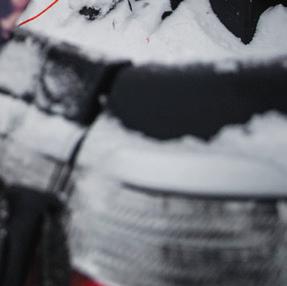

That issue [of Bomb Snow] really inspired me to start painting. It introduced me to ‘mountain . ’
anniversary book came out. I remember it came with a postcard of Rachel Pohl’s art and a gallery of Chili Thom…” The conversation had to be put on pause as we decided to drop in. However, back at the Baja, once again figuring out how to fit our gear in the short bed, Cy continued. “That issue [of Bomb Snow] really inspired me to start painting. It introduced me to ‘mountain art.’ I had always doodled, drawing in notebooks and on school assignments or whatever. I’d taken a grand total of one elective art class ever. But, since there was nothing to shoot that winter, I started drawing things that I wanted to be shooting.”
After our backcountry lap, with the snow still falling, we stopped by Cy’s home studio in Teton Valley. “I paint the stuff I like to do. Mountain biking, skiing, really anything I like to do outside,” he explained, dipping his brush into a green speckled tin cup. The room, tucked in the back of the house, had a lone wooden desk plastered with stickers against one wall, a sea of paint brushes and color-smeared pallets, and stacks of skis, boots, ropes, and assorted other outdoor gear. His collection of snowblades, totaling five,
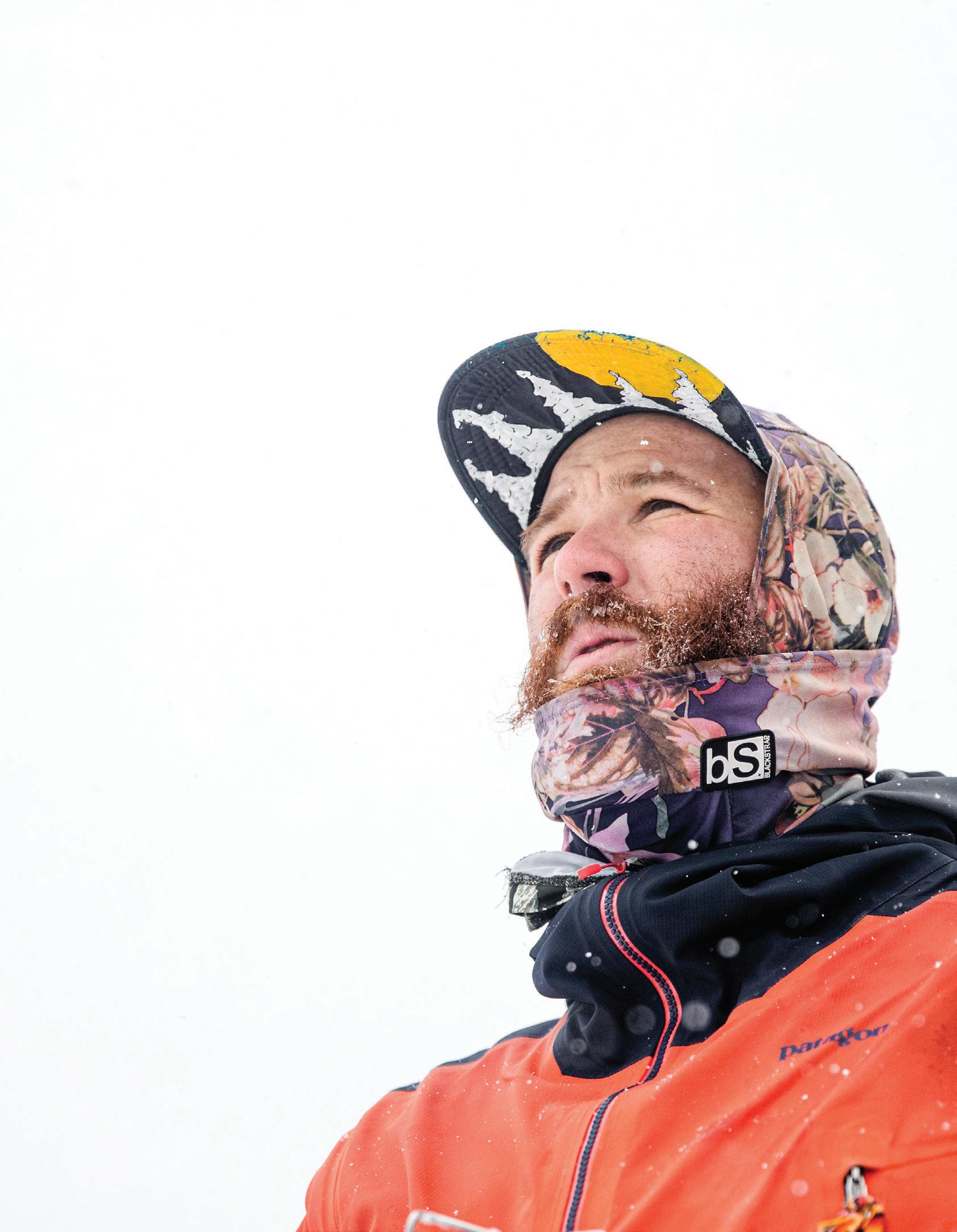
 -Cy Whitling
-Cy Whitling
I paint the stuff I like to do. Mountain biking, skiing, really anything I like to do outside.
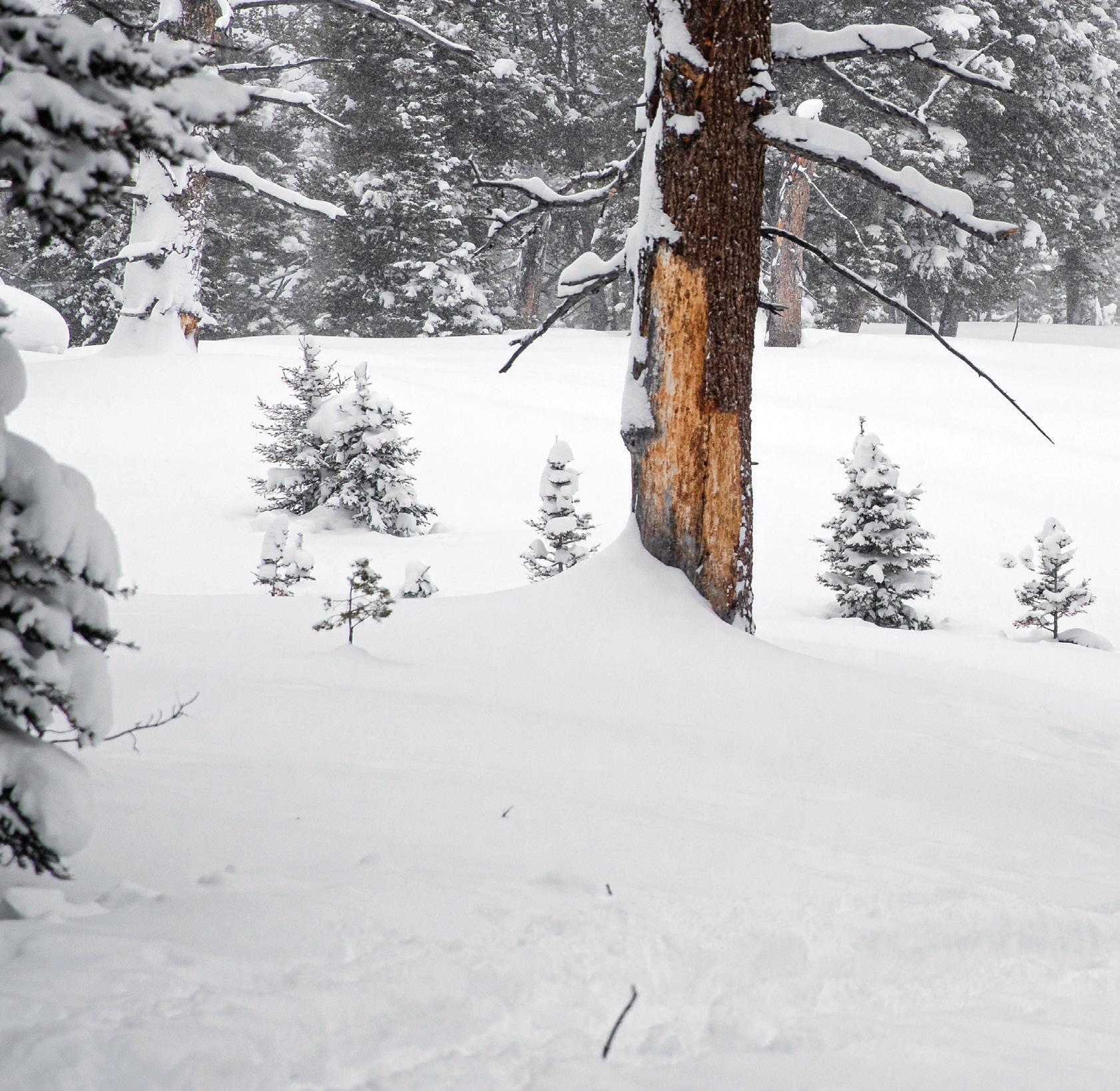

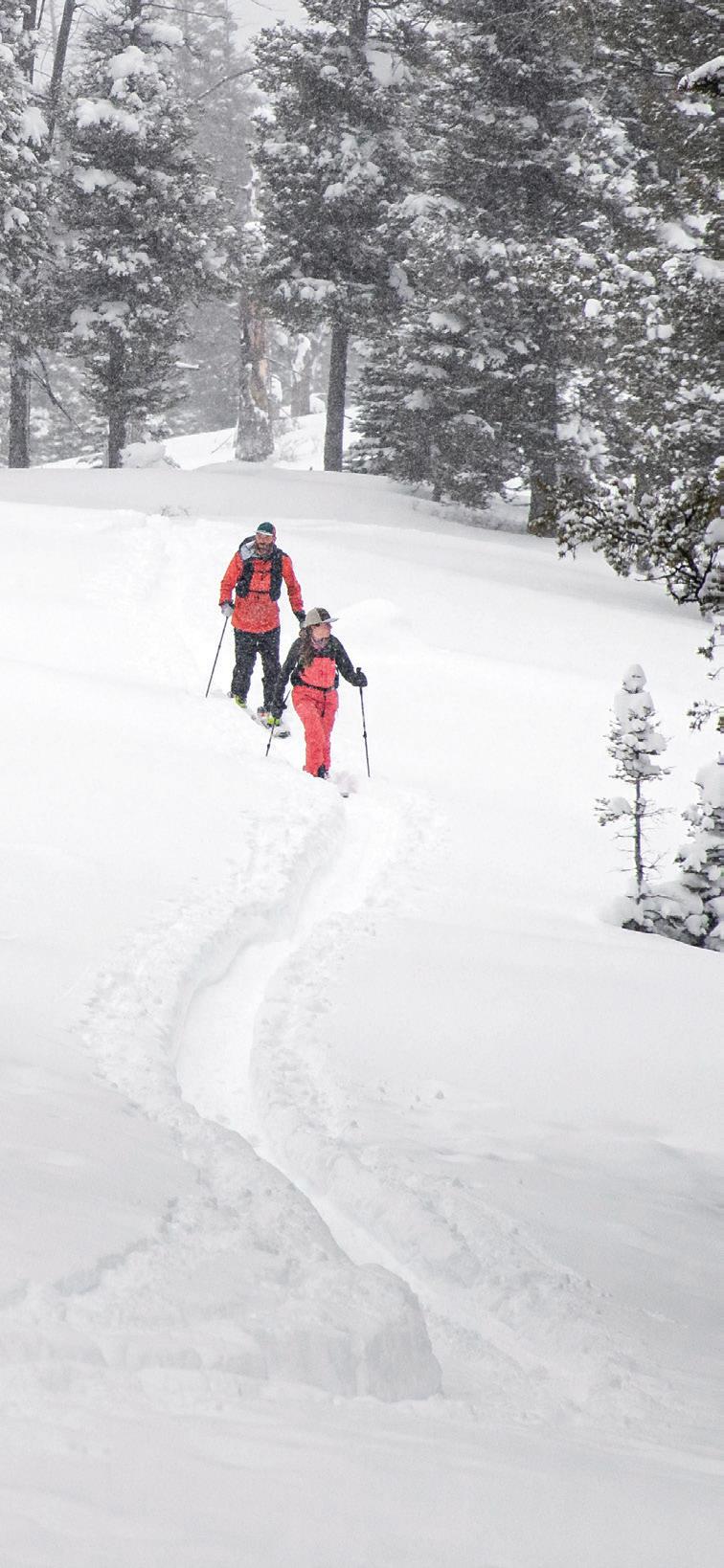
is worth noting. “It’s purely practical,” chuckled Cy as an explanation, hinting at his personal brand of humor. Paintings filled the walls where gear did not. Portraits of grizzled men carrying skis on their back were mixed with fantastical illustrations of yetis and mountain bikers with moose heads and tiger bodies ripping dirt jumps together under the light of a giant harvest moon. “I don’t see the mountains like a lot of other outdoor illustrators see them,” he said of his style, “but I also like certain things being very precise in my drawings. I’m gear-oriented, so if I’m drawing a mountain bike, I’m drawing a very specific bike. Even if it’s tiny in the frame, I make sure it’s technically correct.”
Though it wasn’t always obvious on first look, most of Cy’s earlier work, especially his line work, was being done digitally. That is, until Covid turned everything upside down. Like many of us, the lockdowns of 2020 upended Cy’s professional balance. “I found out, in one day, that essentially two-thirds of my income had disappeared,” he said with a nervous little laugh. “Everything became really uncertain really fast.” However, thanks to a set of gouache paints sitting unused in a drawer in his studio, Whitling’s economic anxiety and forced time at home became the launching pad for his next creative venture. The Paintings to Poop to series was born.
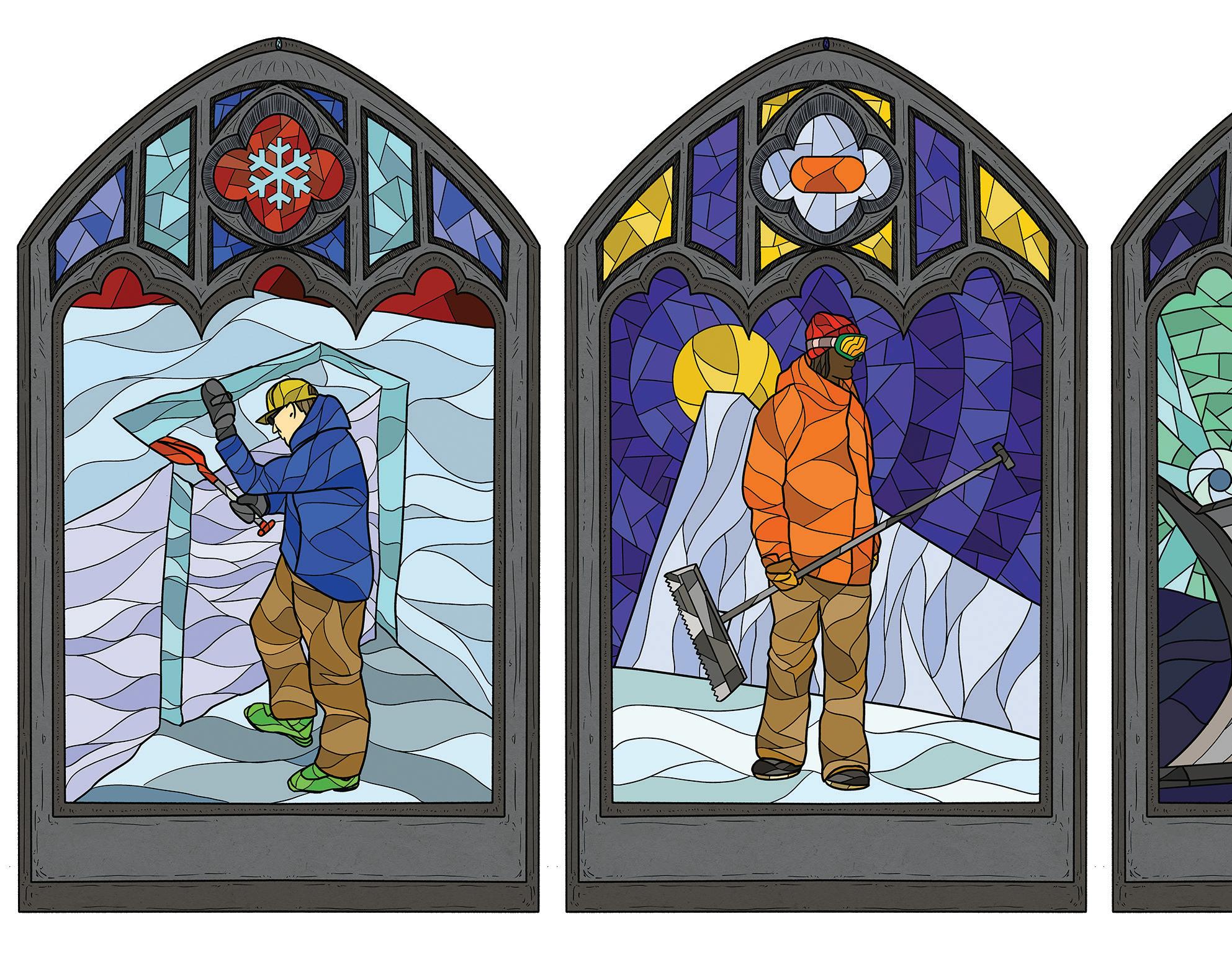
Cy remembers most bathrooms from his childhood having some crappy paintings in them. The watercolor of daffodils to the right was his inspiration to create the series, Paintings to Poop To. “ I don’t mind it, I just like bikes and skis more than flowers.”
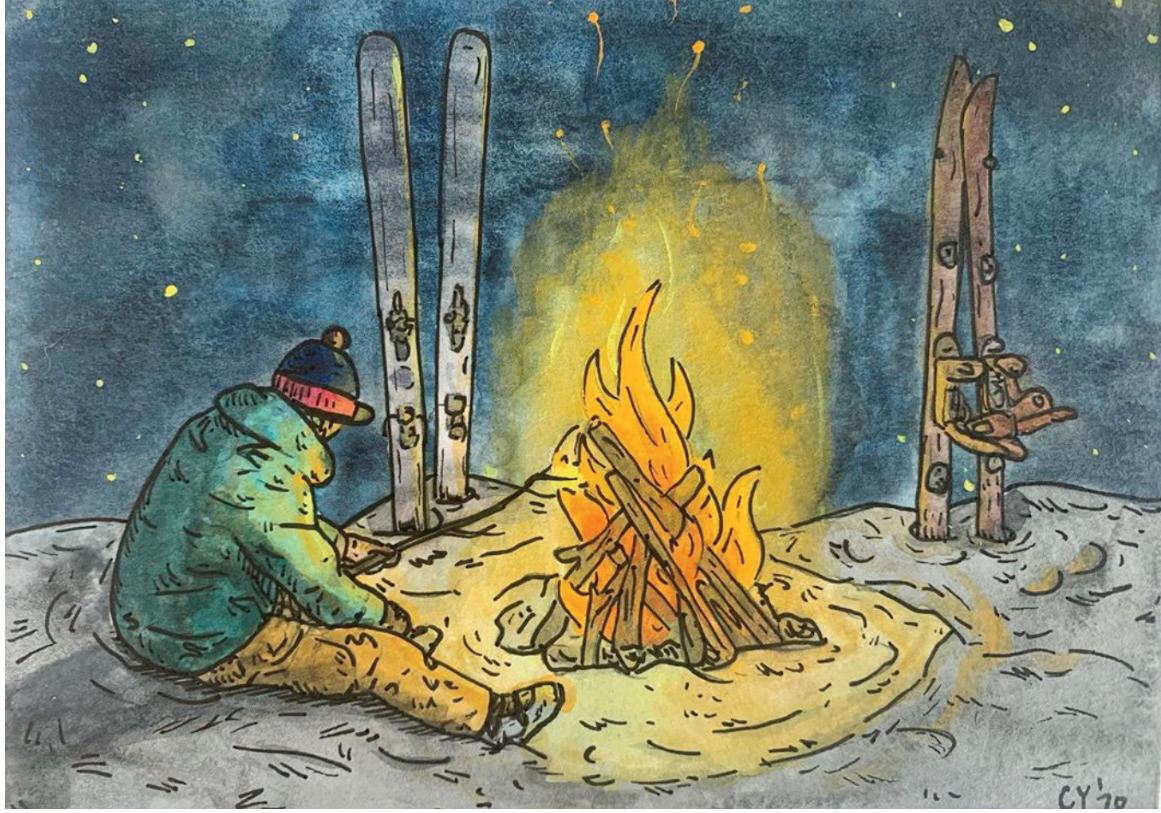
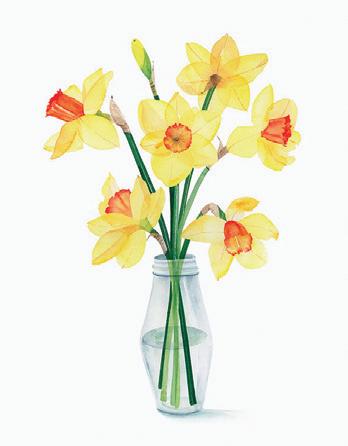


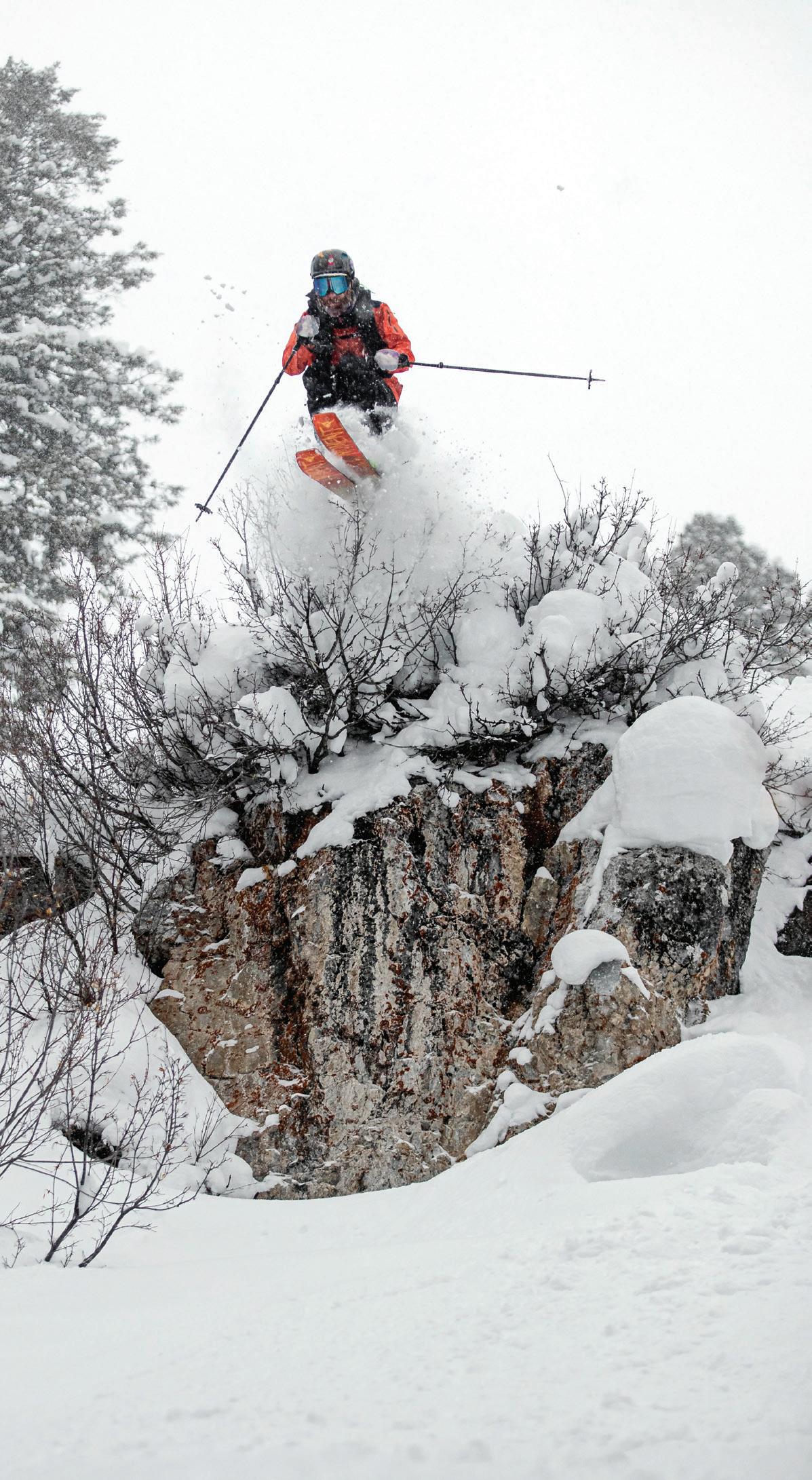
So I called them Paintings to Poop to… Because they make pooping better.
Featuring anything from trail maintenance gnomes toting shovels and chainsaws in forests of morel mushrooms to giant crawfish attacking Tucker snowcats equipped with artillery guns, his Paintings to Poop to series is a perfect example of Cy’s humor and hustle. Some, quite literally, prominently feature toilets while skiers blast through pillows of snow in the background. All of it was inspired by the bad art often encountered in other people’s guest bathrooms. (Think washed out lilies in a vase, or some uninspired butterfly.) The gouache set and too much extra free time had Cy regularly painting pieces that he knew were too small and too informal for a gallery. But then he thought of all the crappy art he sees on the walls around people’s second shitter. “I realized I was making paintings for your guest bathroom. That’s the exact subject matter and level of skill and talent I was putting into them,” Cy recalled. “So I called them Paintings to Poop to…Because they make pooping better.”
Regardless of the inspiration, or lack there of, the series proved successful. Cy did a painting a day for the first 130 days of Covid closures, and started putting them up for sale on Instagram with little expectation. “I threw them up there as a ‘first come, first serve, Venmo me what you can, I’m just learning how to paint’ type of thing. And people actually liked it,” said Cy, “I sold all 130 of them. Some people gave me $4, and some people paid my rent for a month by buying three of them. I was grateful for all of it. It was really nice. I felt like it connected me with people during a time when we all needed it.”
And therein lies one of my favorite things about Cy; he cares. He wants to feel connected to the people around him. It’s written in the kindness of his eyes and heard in the bubbly laugh he often lets out without warning. His illustrations, while bite-sized and fun, bring up
i26 Photo & Art Annual |
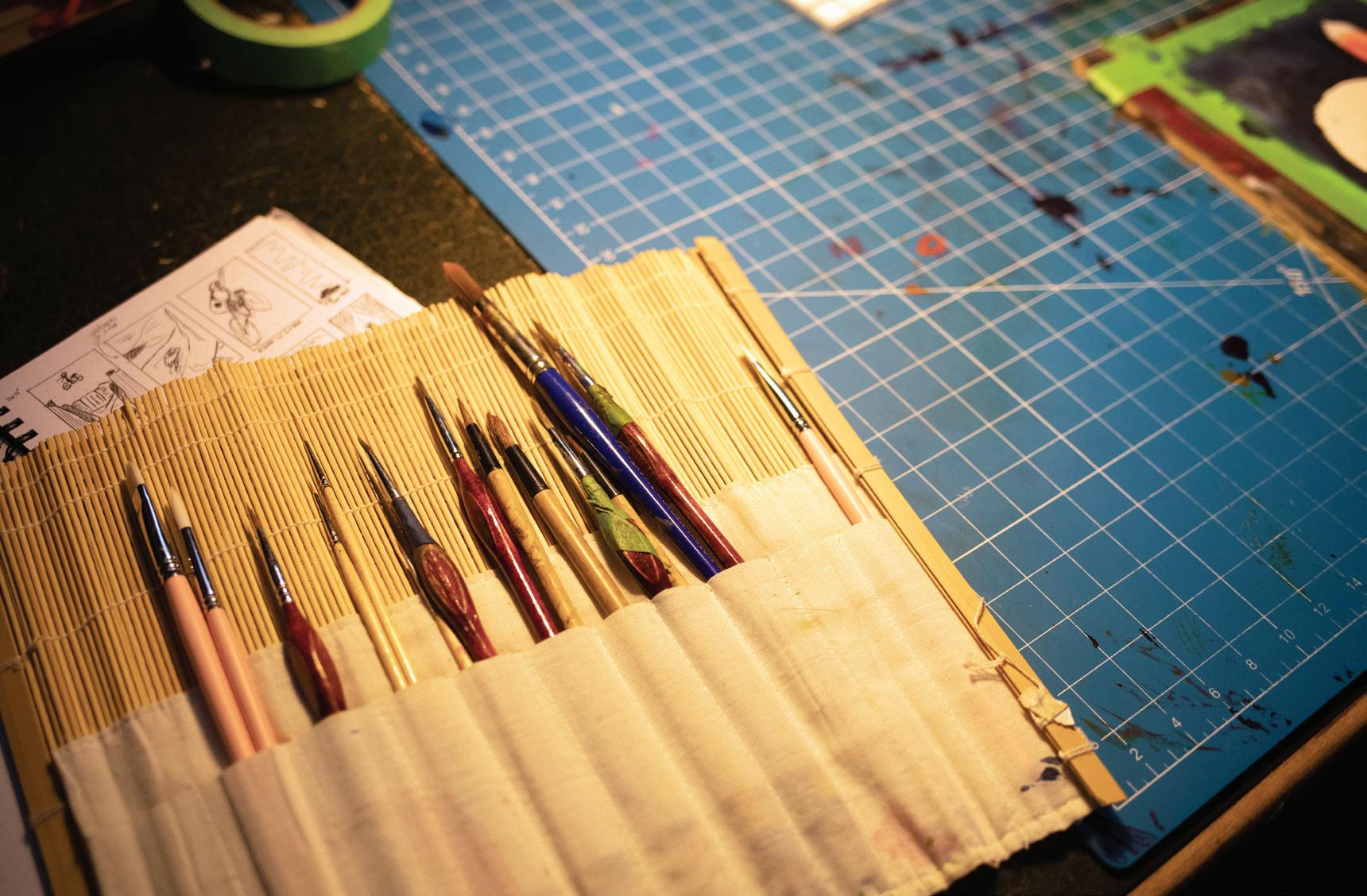
important, real life issues about mountain life and the people who live it. His art takes on everything from snowpack concerns and backcountry safety to the housing crisis in the mountains west and the importance of getting involved with local politics. His primary theme in all his work, though maybe not always at the forefront of every piece, is felt all the same: be careful out there, and care for each other along the way.
After a day of getting to hang in his orbit, Cy dropped me off and said farewell, the snow now drifted twice as high as it was when we met that morning. Our day had been filled with good conversation, great snow, ample laughs, and beautiful art. As I watched his Baja blast away into the snow globe, I was left with one final thought, something I felt summed up Cy more than anything else I learned that day. While chatting in his studio I’d asked him “Who do you want Cy Whit ling to be?” Without skipping a beat, he responded, “That’s easy. I want to be an asset to every community I’m a part of. Whether it’s the art community or the outdoor community or the community of Teton Valley, I want to help, and I never want to be a liability.”
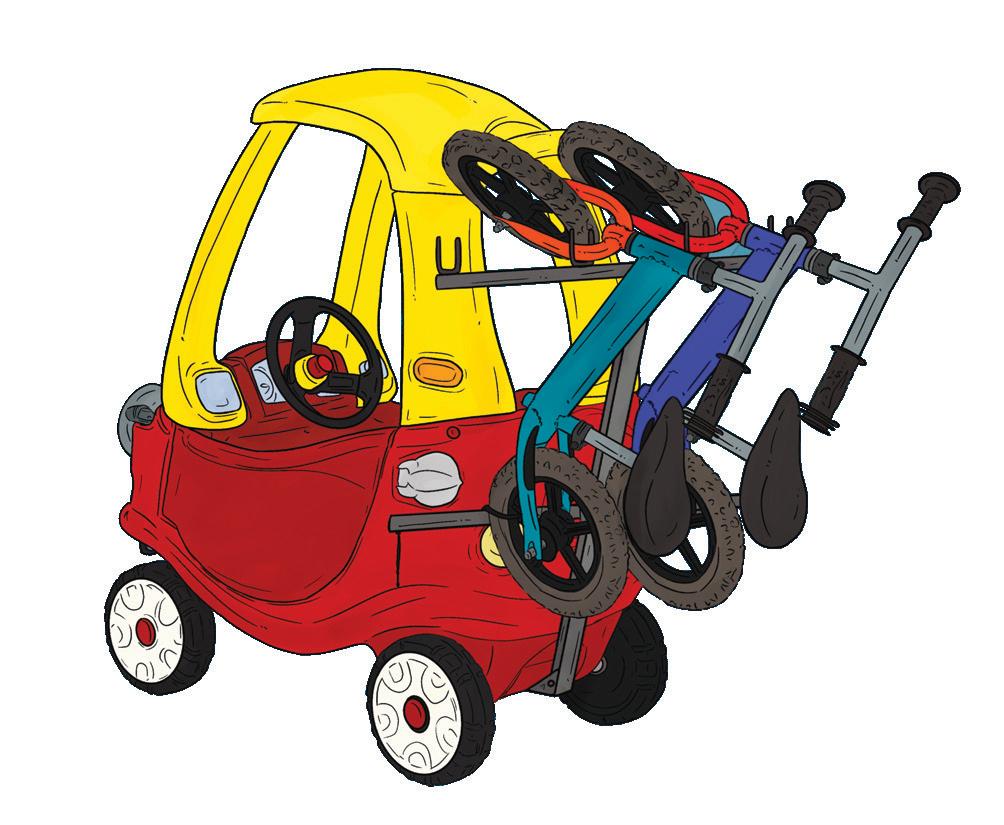
To Learn More about CY and WHAT He’s up to, check out: BEMORESTOKED.COM [ I WANT TO BE AN ASSET TO EVERY COMMUNITY I’M A PART OF.

Prepare to get frothy.
What follows are some the juiciest, most inspiring, stoke-inducing images that have come across our transom over the last year. Silence your phone and tell the kids or roommates to chill, you have some page-turnin’ and day dreamin’ to enjoy. It’s a certifiable hootenanny of action-born art curated





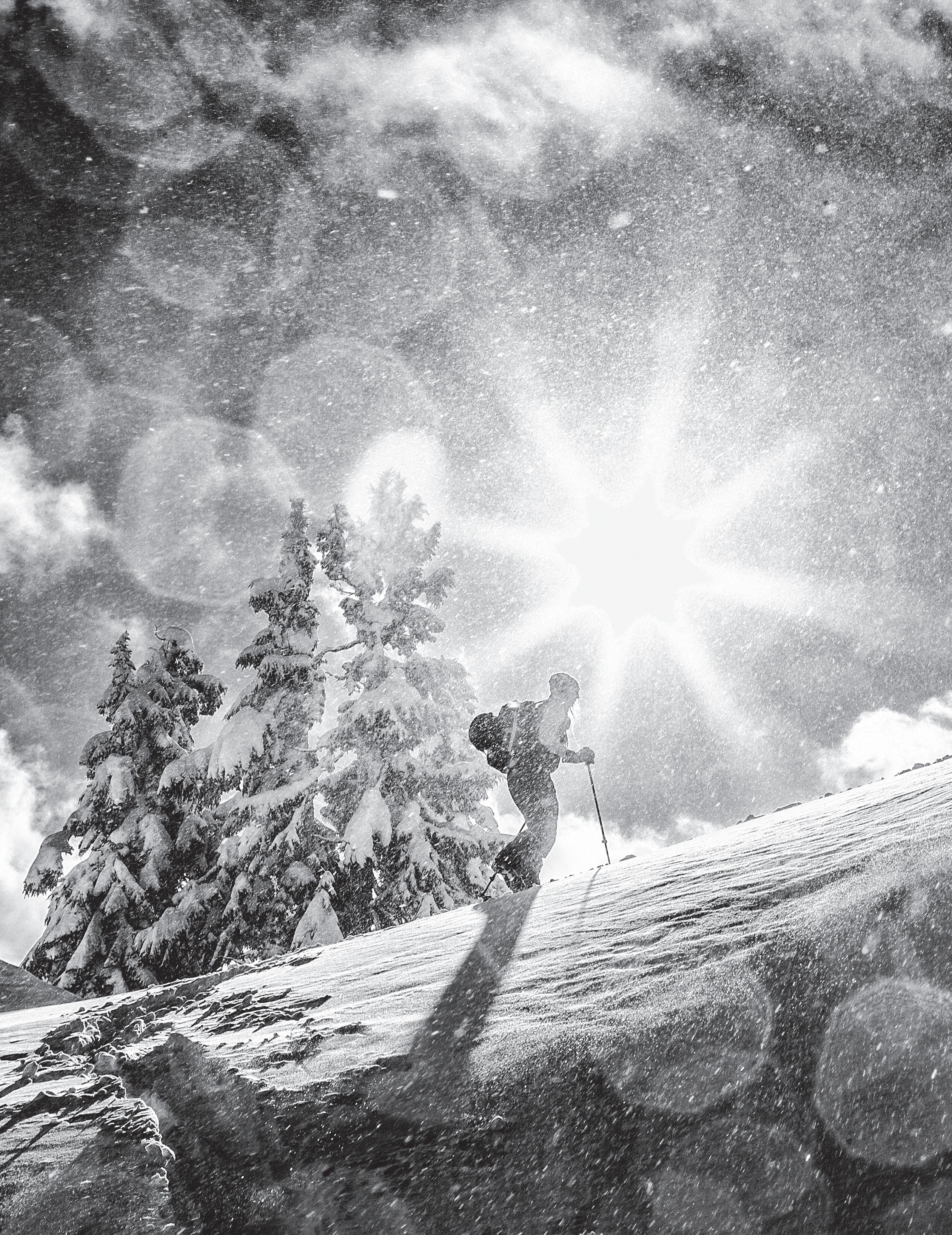
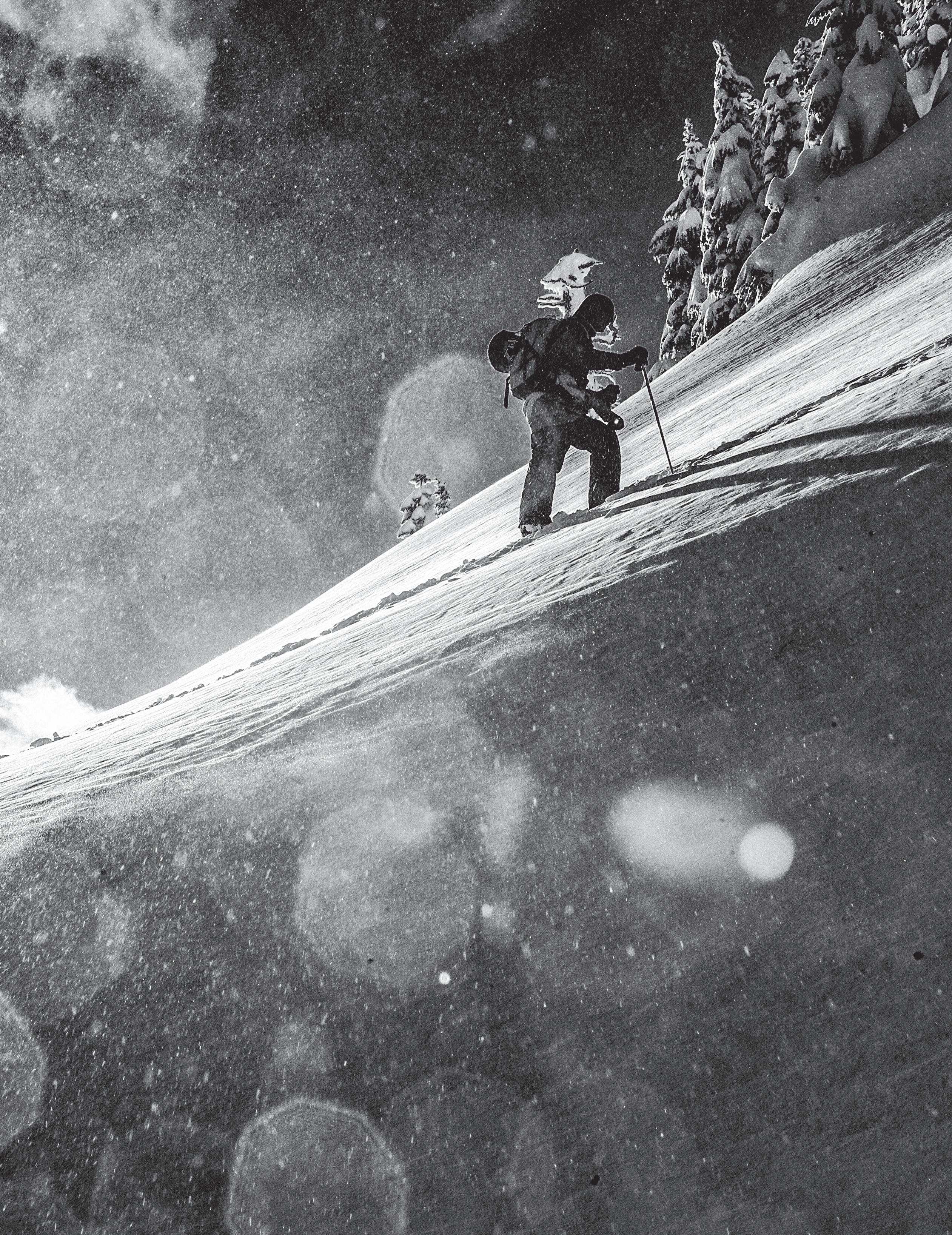 Grant Gunderson
Grant Gunderson
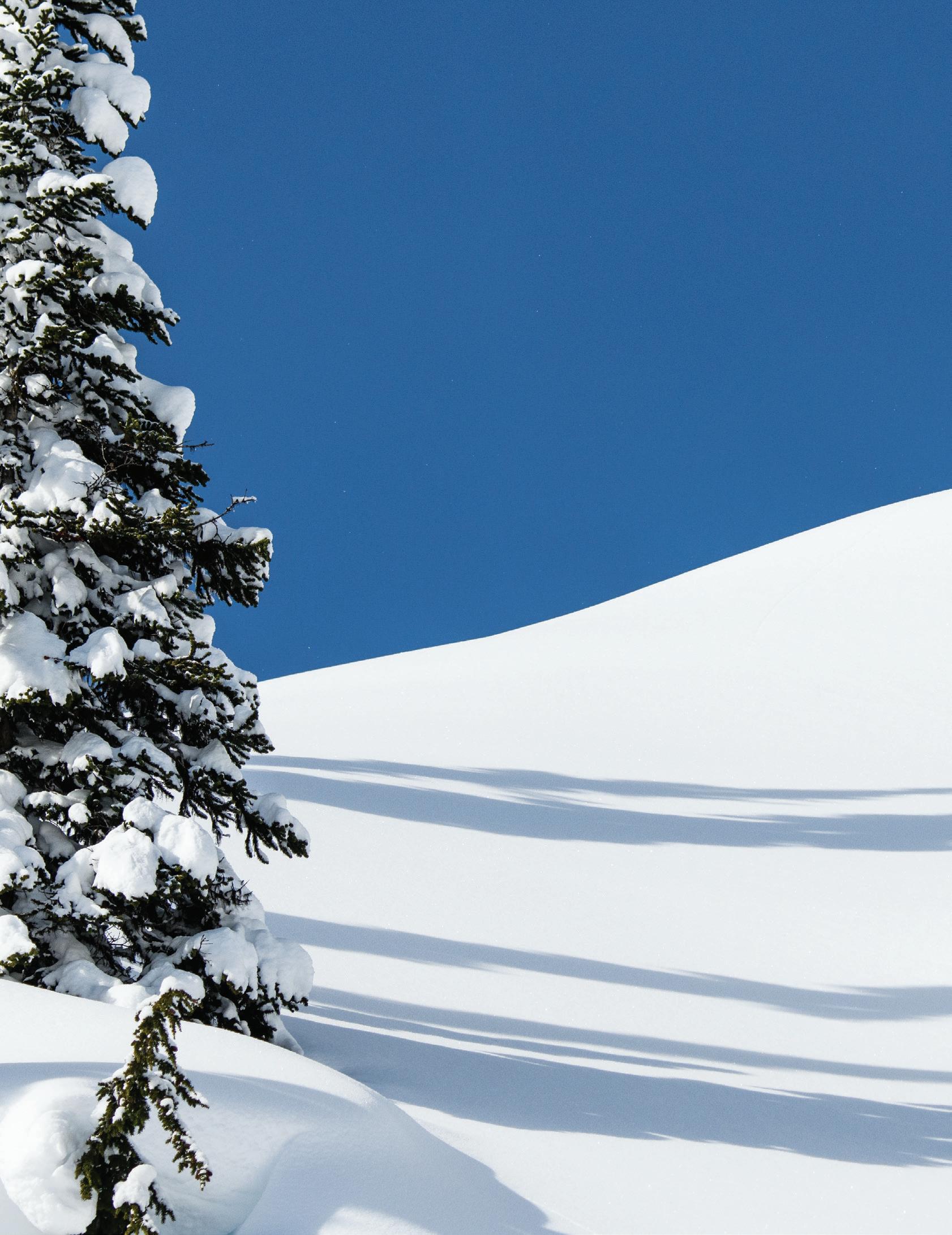 | Henrik Harlaut was in town visiting and shredding with Sammy, and we thought it’d be dope if they got in a doubles line to start up the day. Another magic day in the mountains.
Daniel Stewart
| Henrik Harlaut was in town visiting and shredding with Sammy, and we thought it’d be dope if they got in a doubles line to start up the day. Another magic day in the mountains.
Daniel Stewart
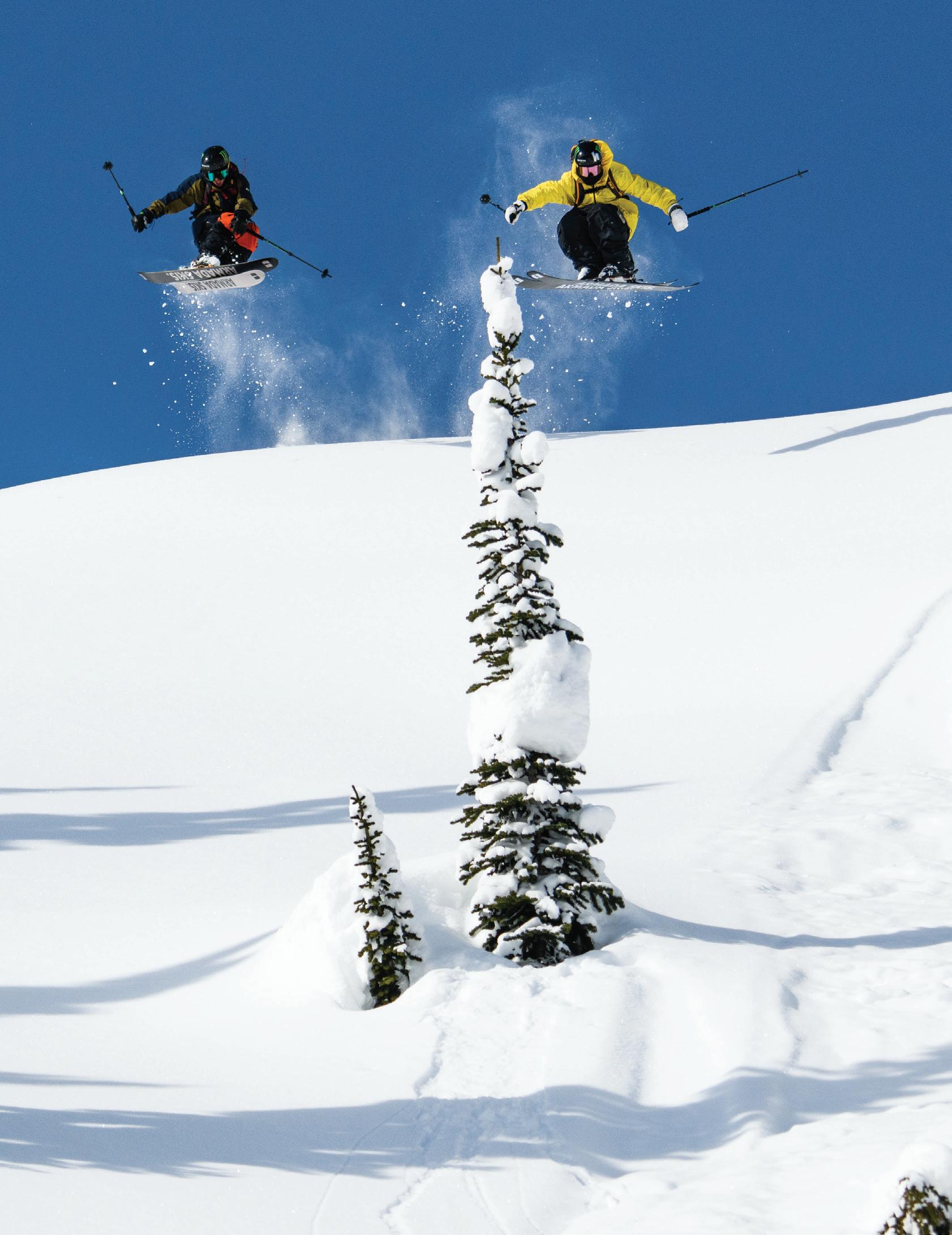

“everyTHING iS ENERgy”
- ALBERT EINSTEIN
Tal Roberts | Eagle Pass, Double Exposure
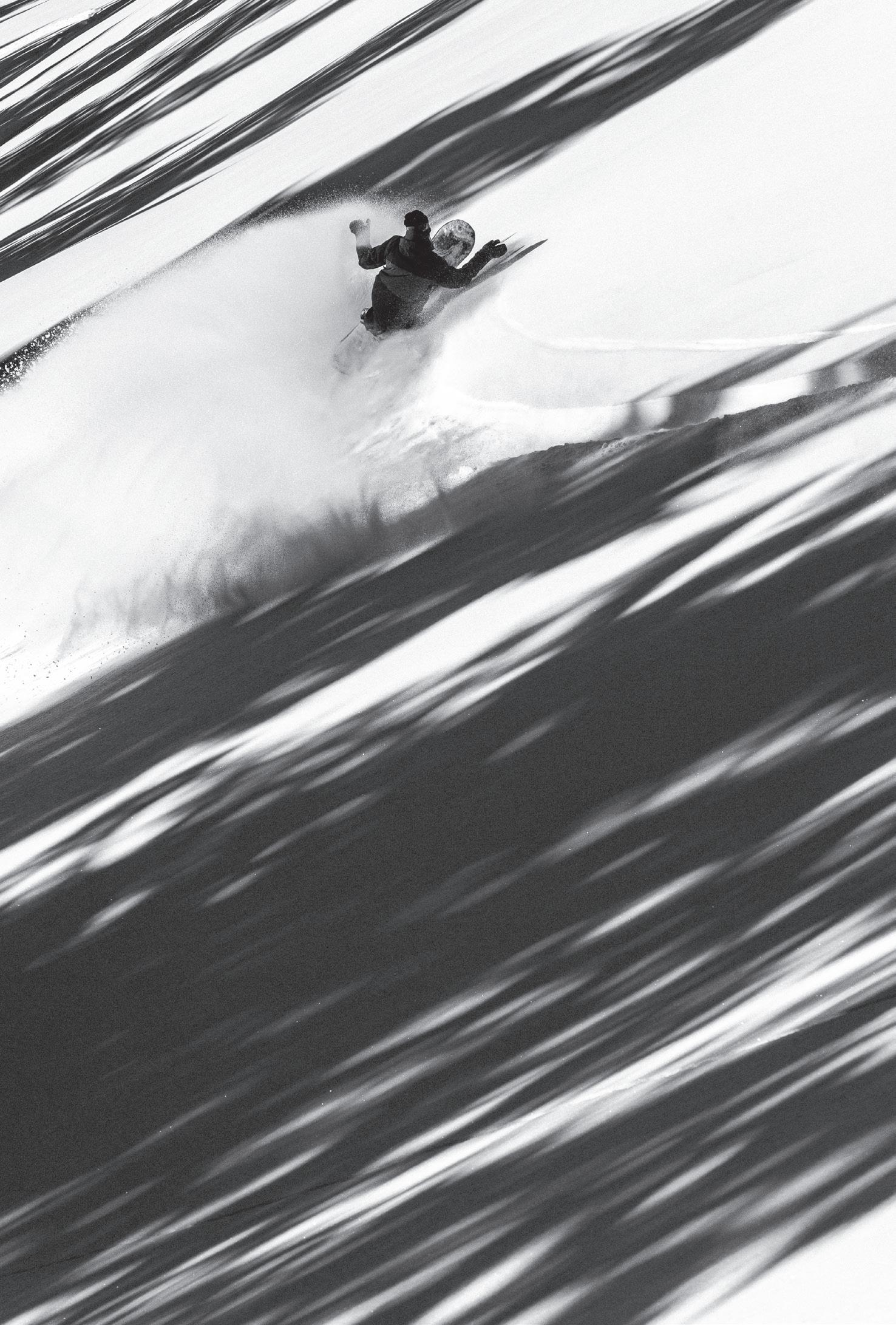 Tal Roberts | Chase Josey
Tal Roberts | Chase Josey

 | The alpine meadow a day or two after the storm, in a highly trafficked meadow in Revelstoke. Even on this day we found the goods. You just gotta keep exploring around the next corner.
Daniel Stewart
| The alpine meadow a day or two after the storm, in a highly trafficked meadow in Revelstoke. Even on this day we found the goods. You just gotta keep exploring around the next corner.
Daniel Stewart


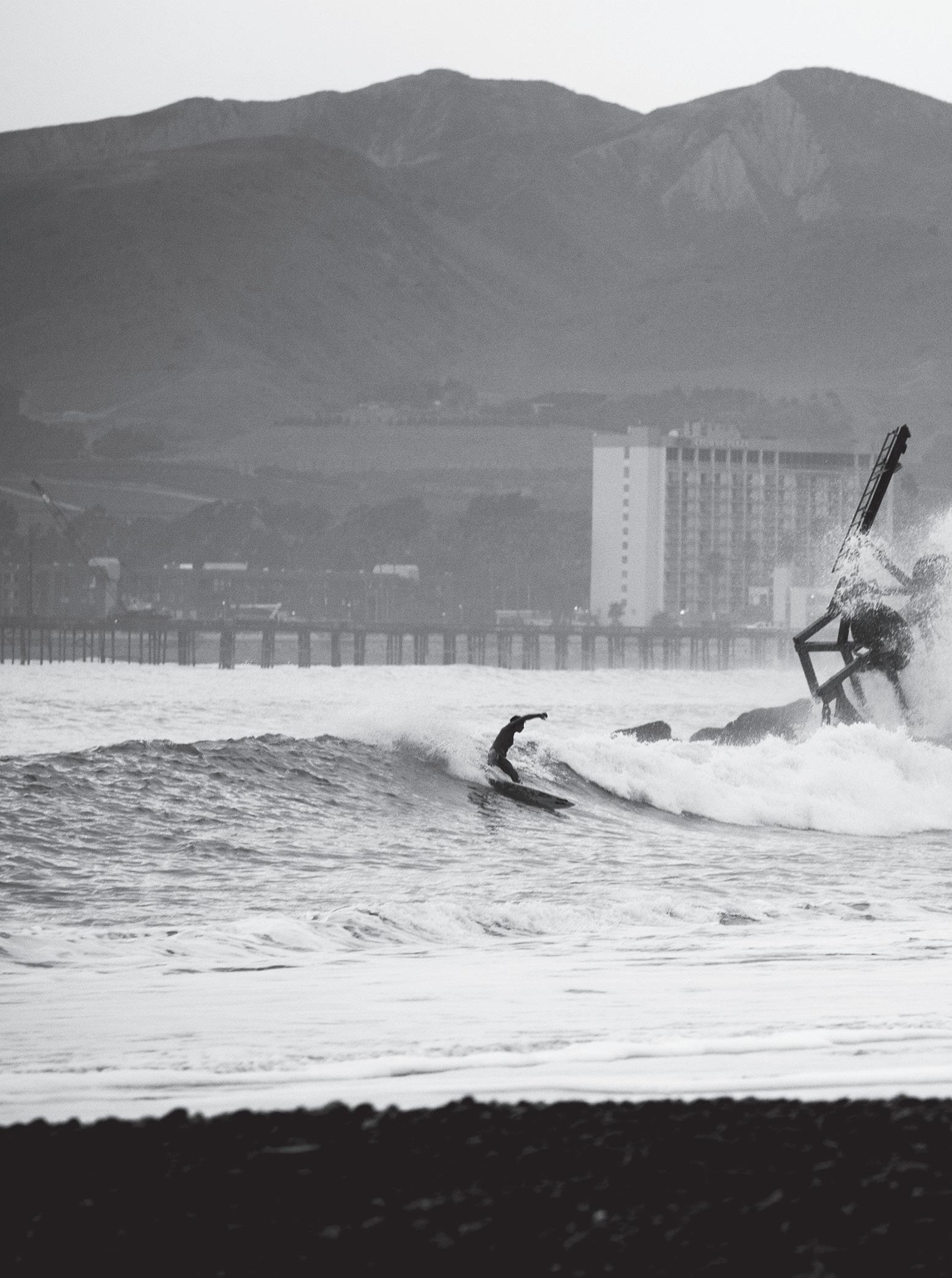
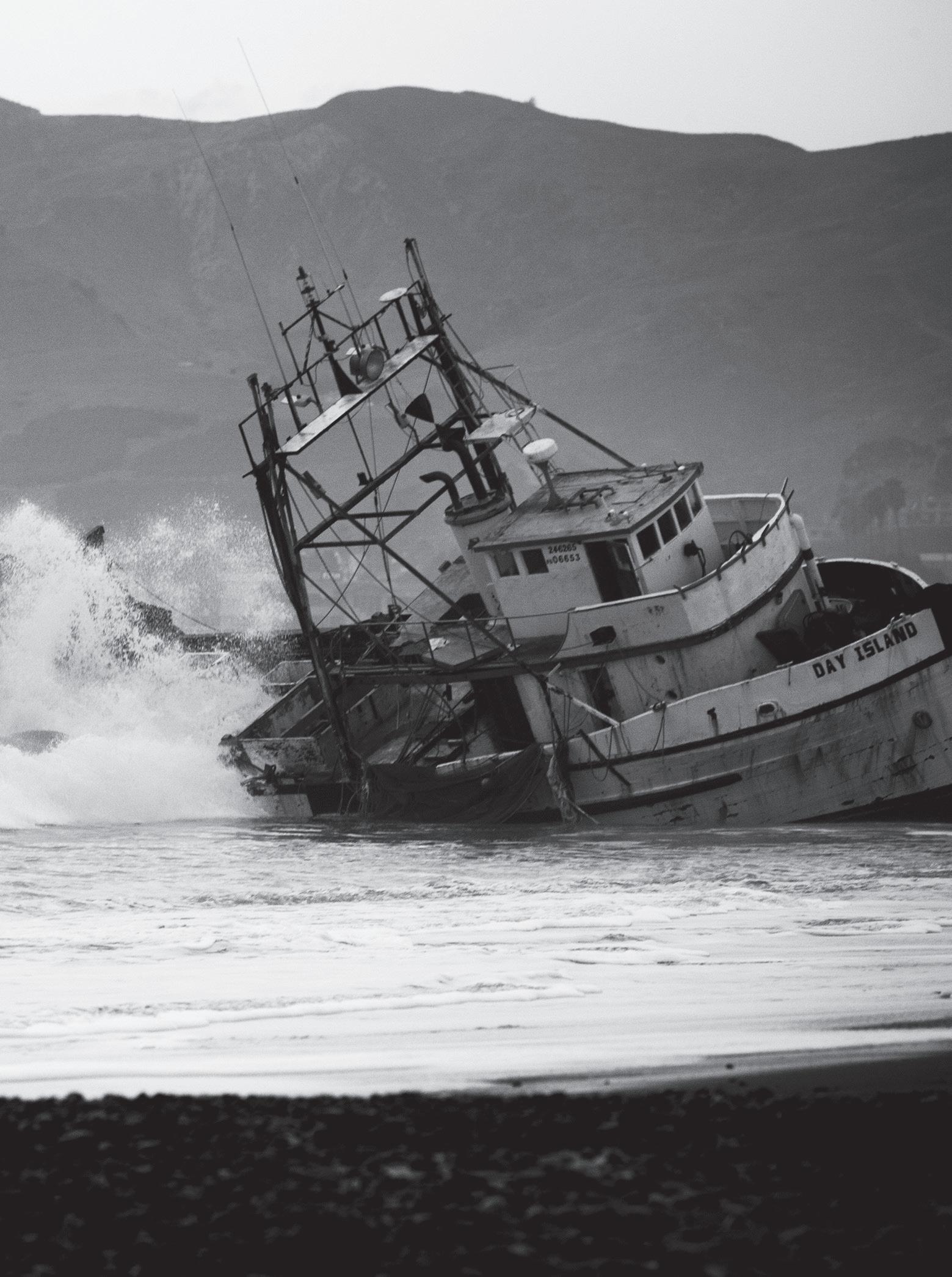 | One man’s shipwreck is another man’s sandbar. Cutting back to the source in a faraway land.
Seth de Roulet
| One man’s shipwreck is another man’s sandbar. Cutting back to the source in a faraway land.
Seth de Roulet

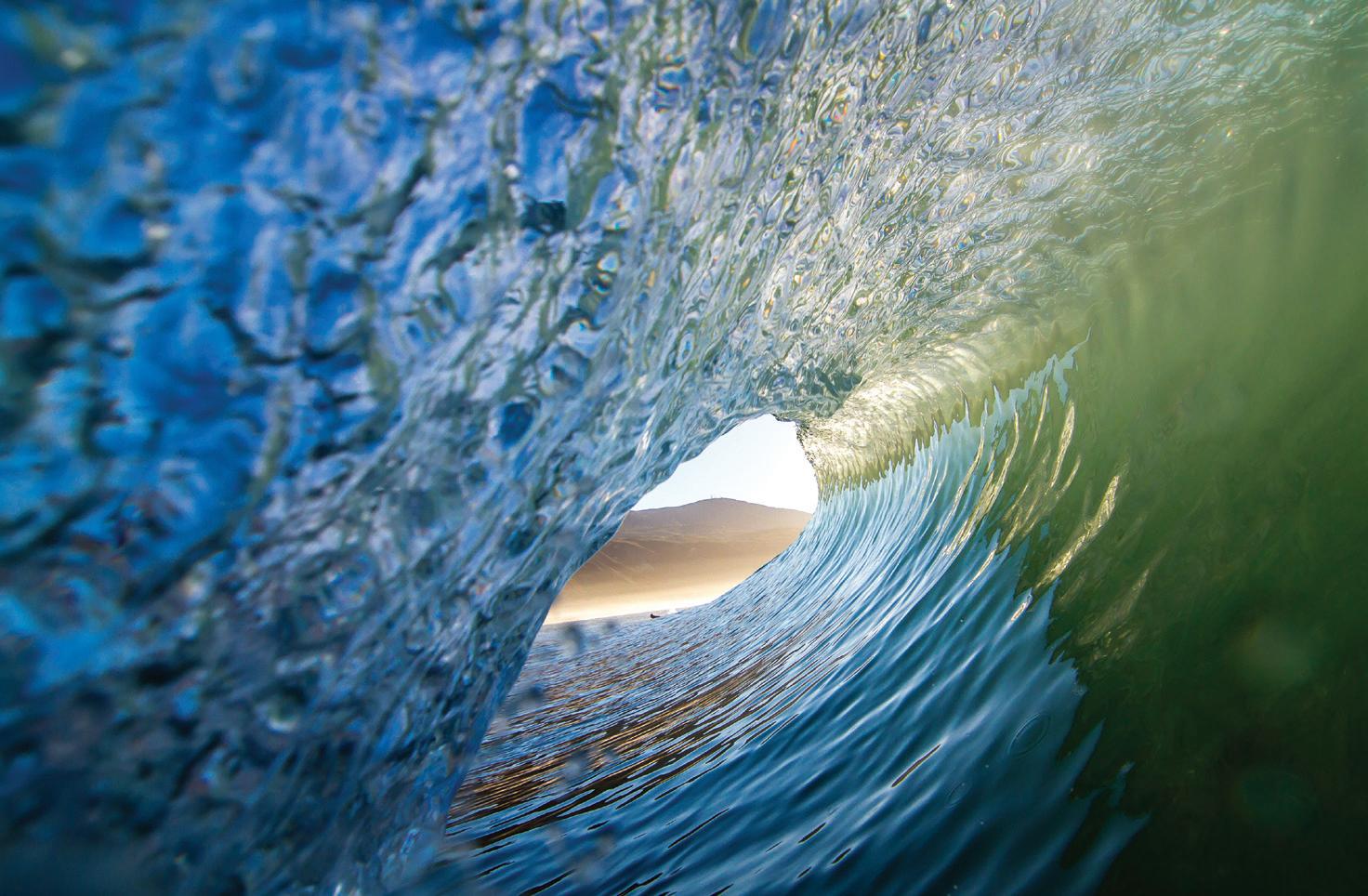 The real breakfast of champions. Sunrise through the tube along the coast of California.
Branden Aroyan
Sarah Grangeon | Tyler Nyman launches above the barrel.
The real breakfast of champions. Sunrise through the tube along the coast of California.
Branden Aroyan
Sarah Grangeon | Tyler Nyman launches above the barrel.
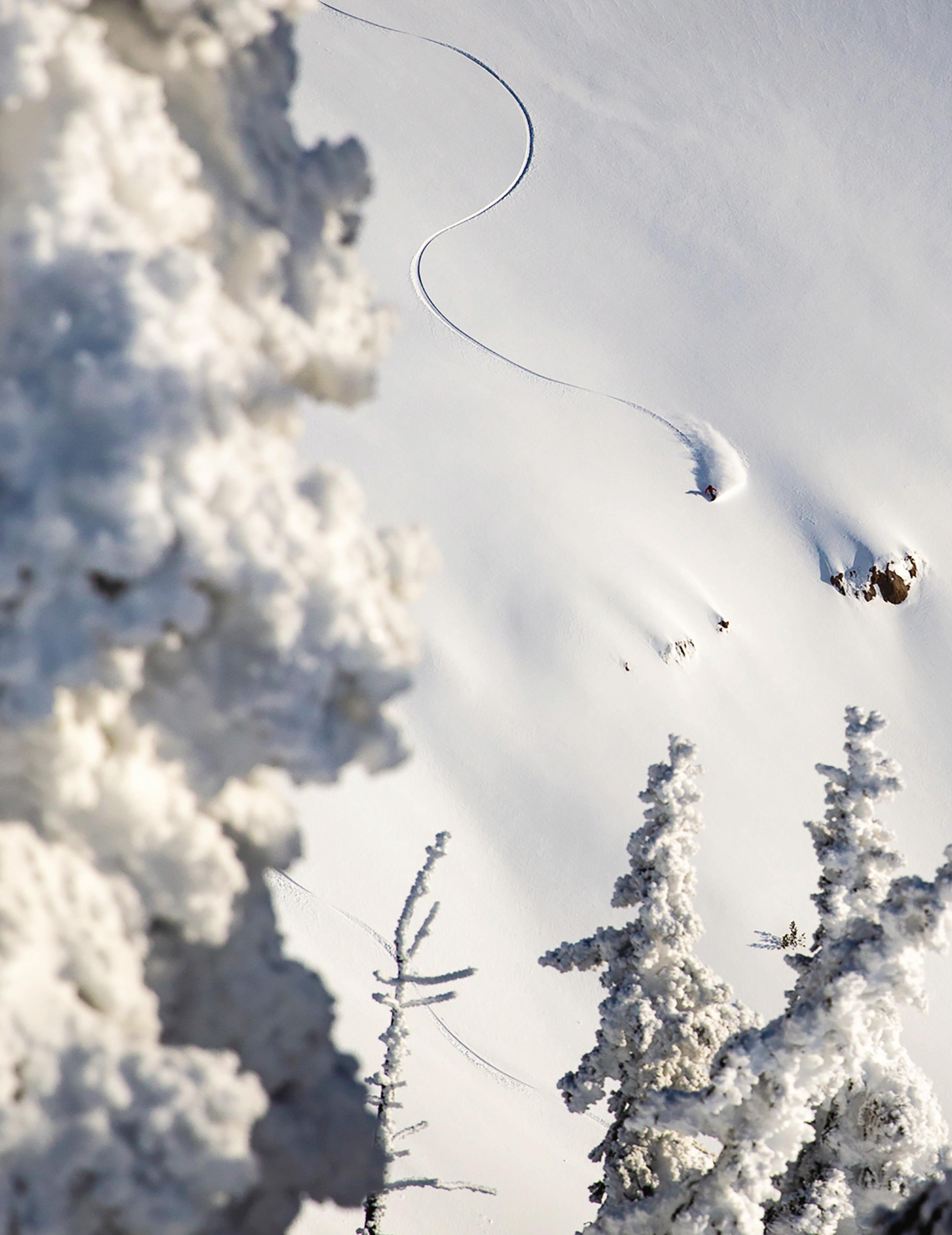 Iris Lazzareschi paints her canvas. Amy Jimmerson
Iris Lazzareschi paints her canvas. Amy Jimmerson

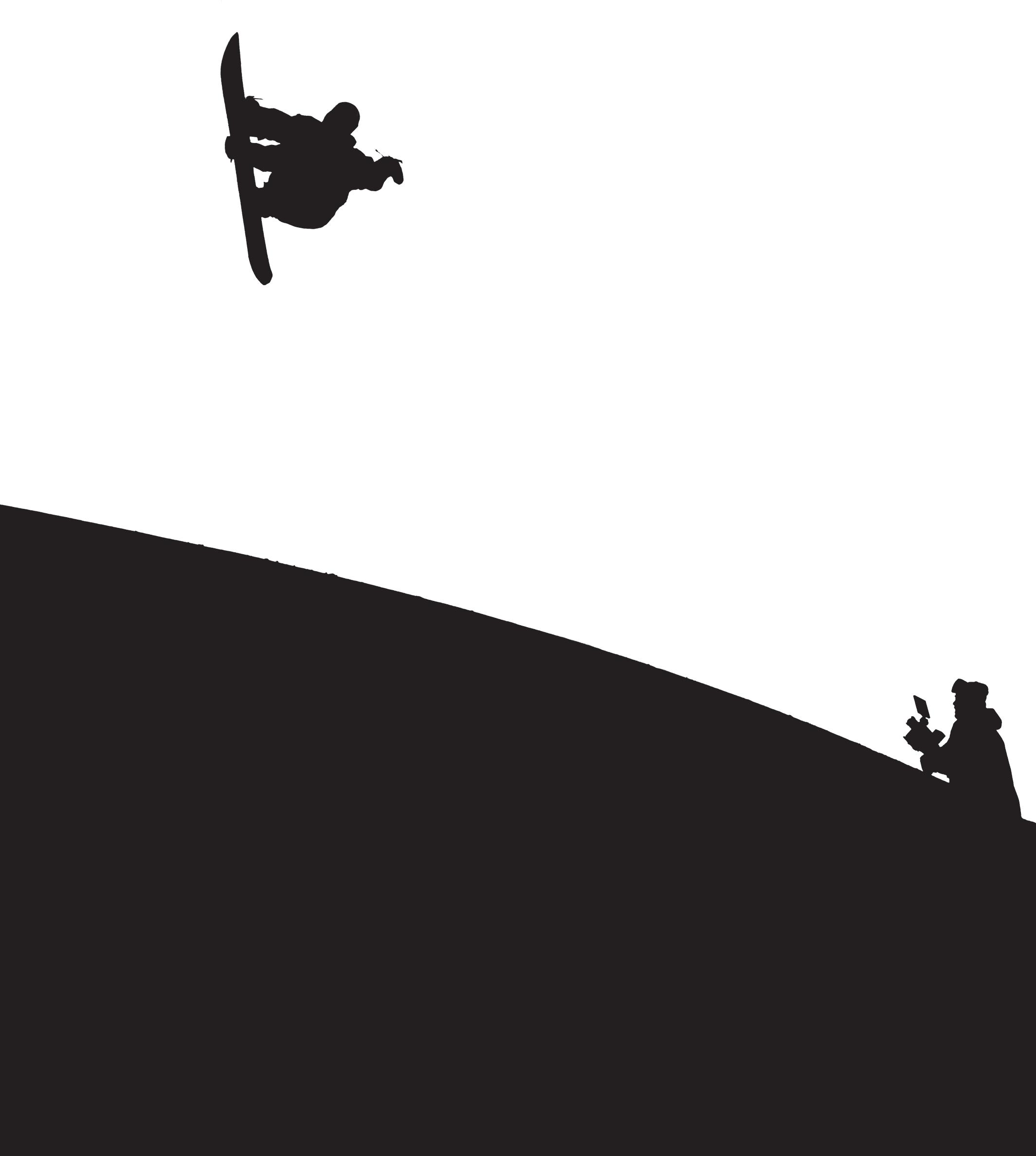
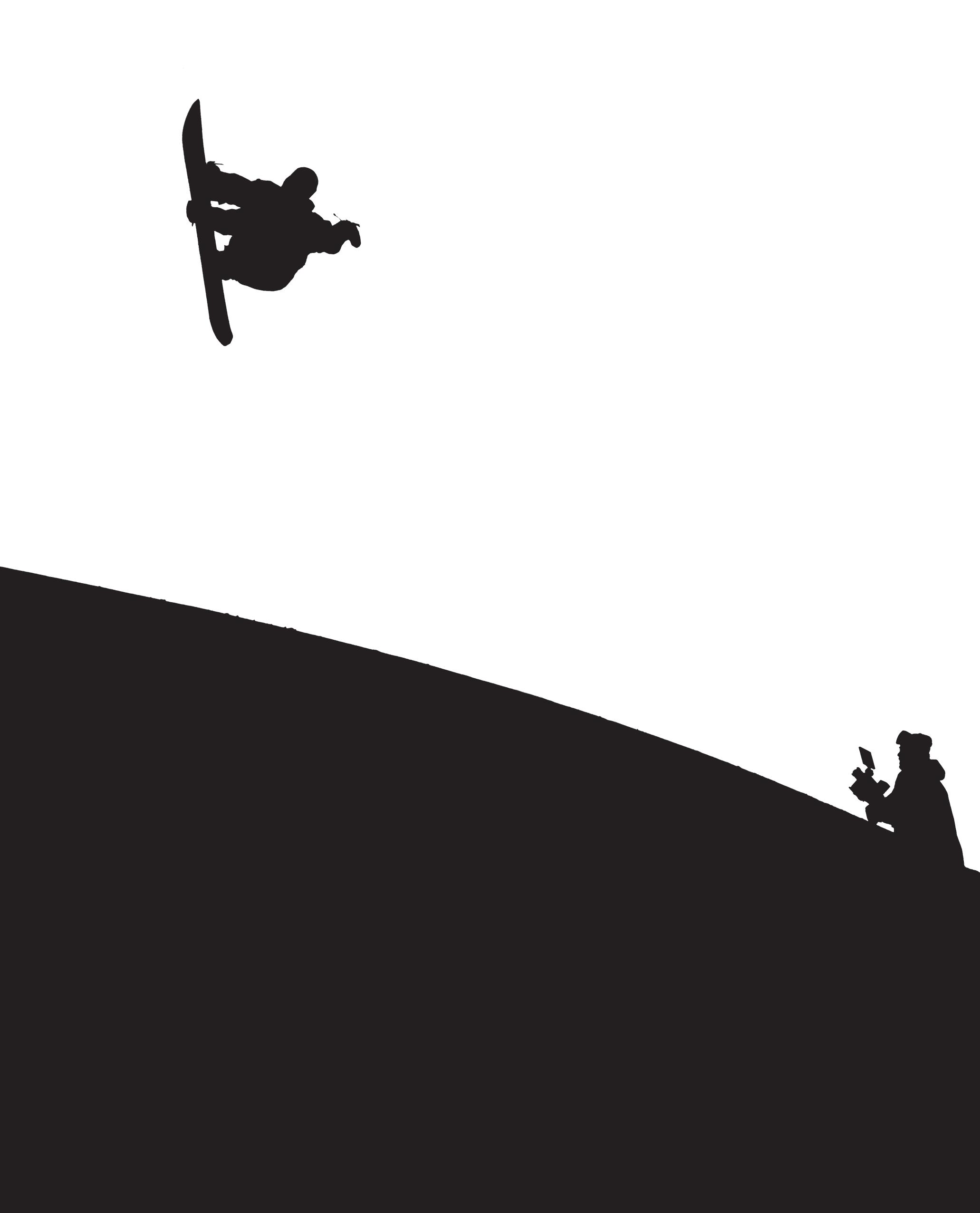
Keegan Rice
| Spring weather can be fickle, with lots of convective activity happening in the alpine. Some days you have to ‘window shop’ for some light and this day was one of them. Bruce Johnston laying one in between the clouds.
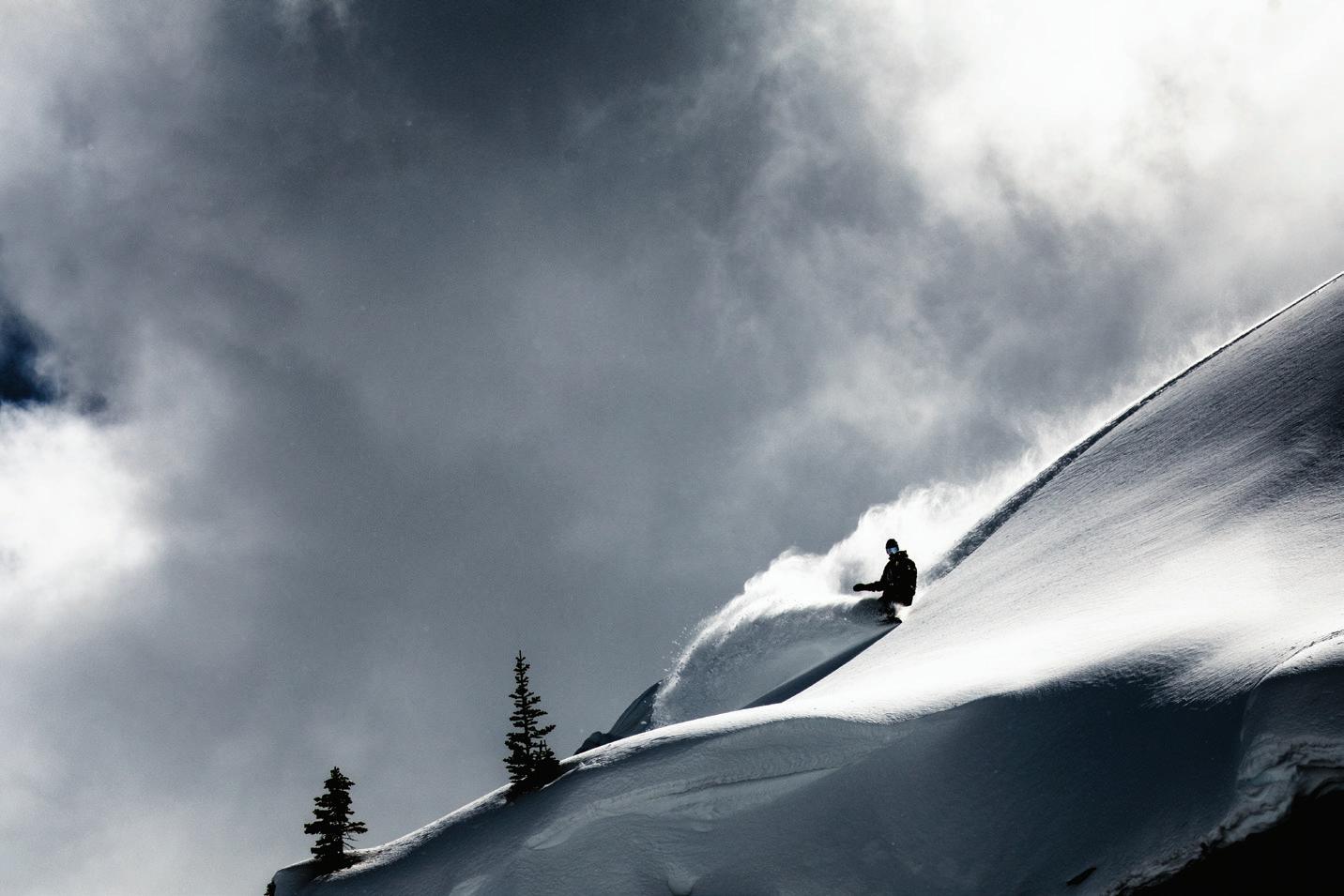
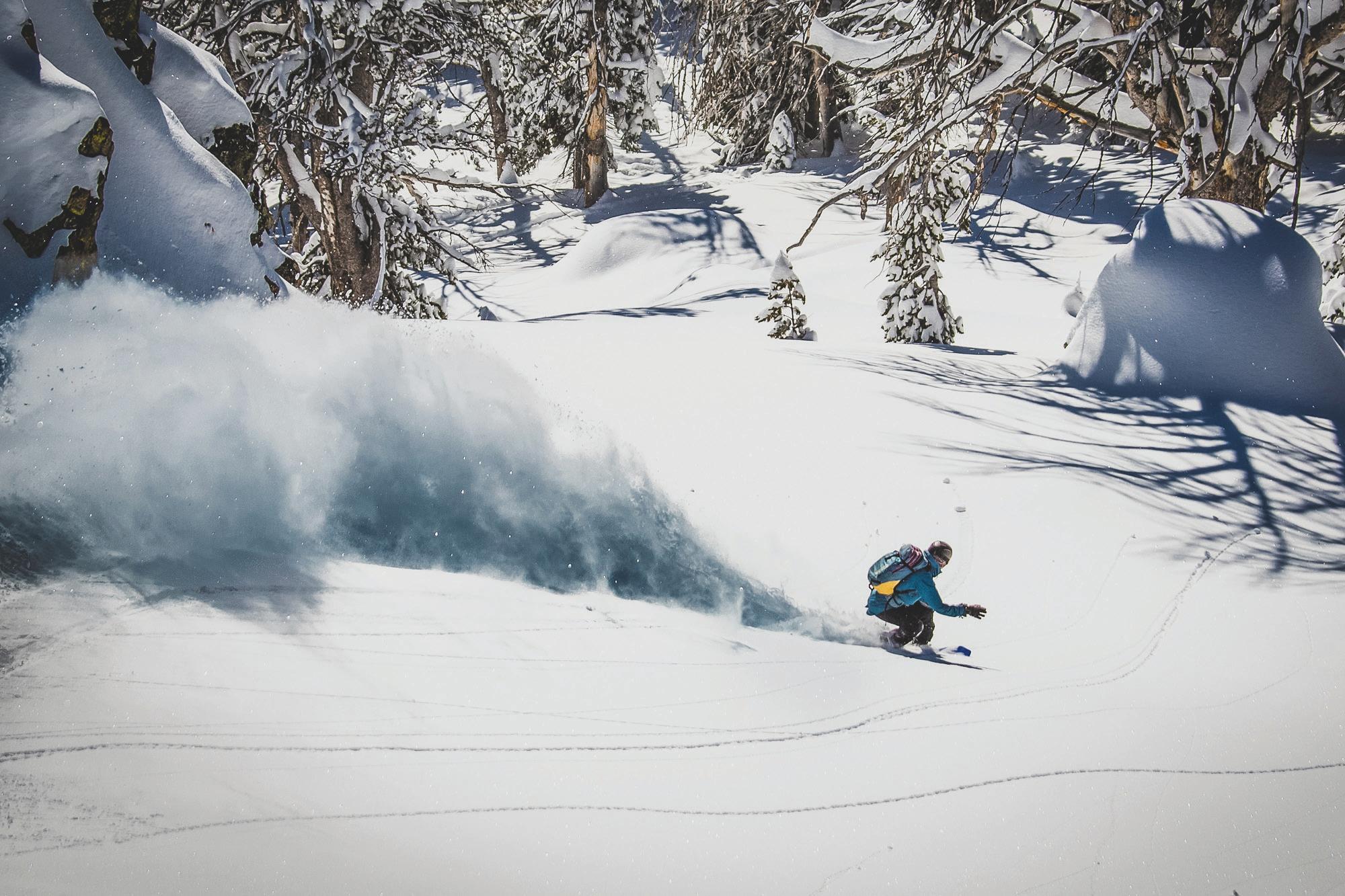 Daniel Stewart
Amy Jimmerson
Camila Brown post speed check.
Daniel Stewart
Amy Jimmerson
Camila Brown post speed check.
 Tal Roberts | Sawtooth Mtns. Double Exposure
Tal Roberts | Sawtooth Mtns. Double Exposure


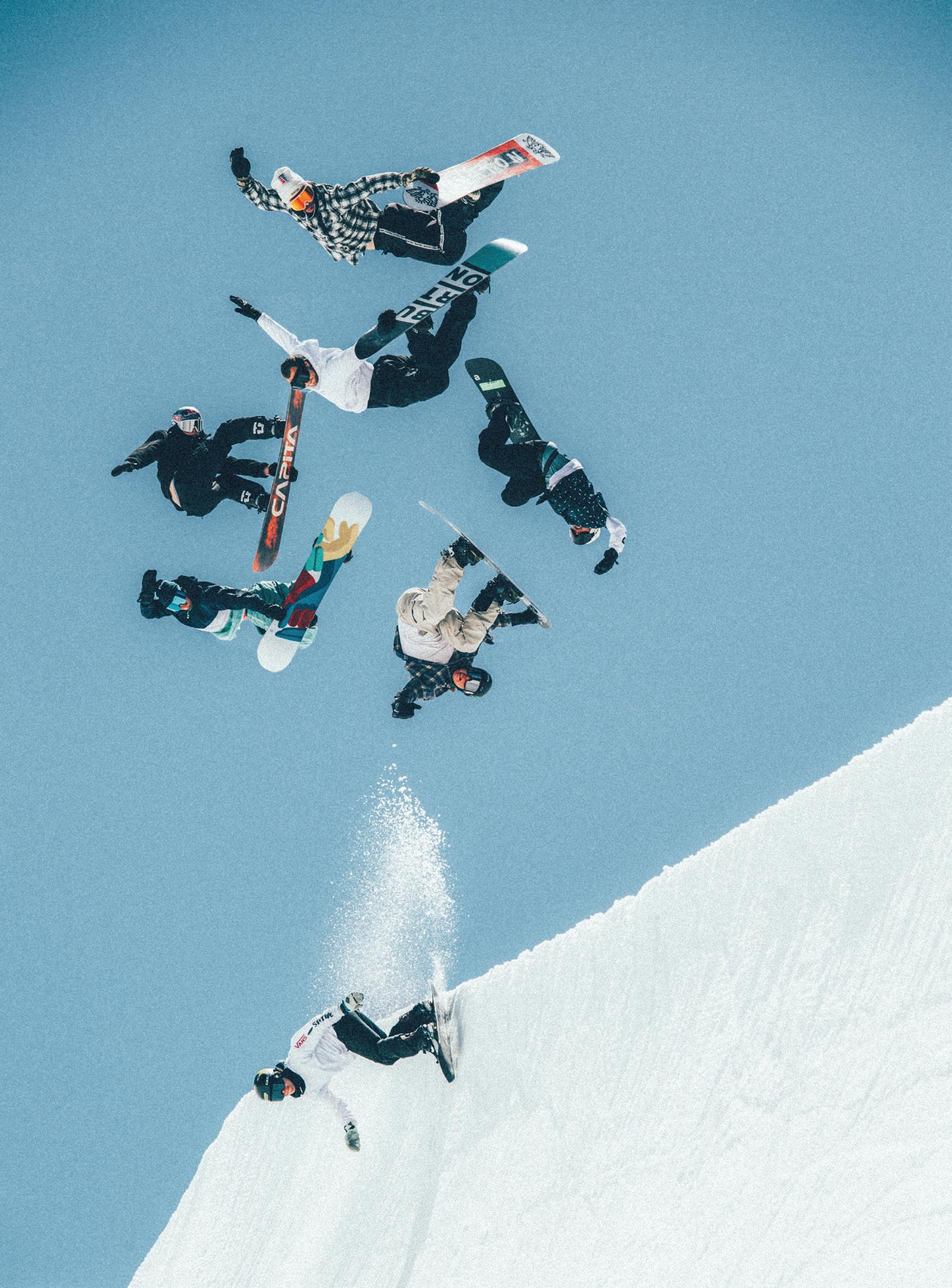
| During the Peace Park Championships at Woodward Tahoe, I set my camera up to capture a static angle of this quarterpipe feature, snapping an image as each rider landed their maneuver, then organizing them all together in one frame, displaying the athlete’s trick choice.
Blotto
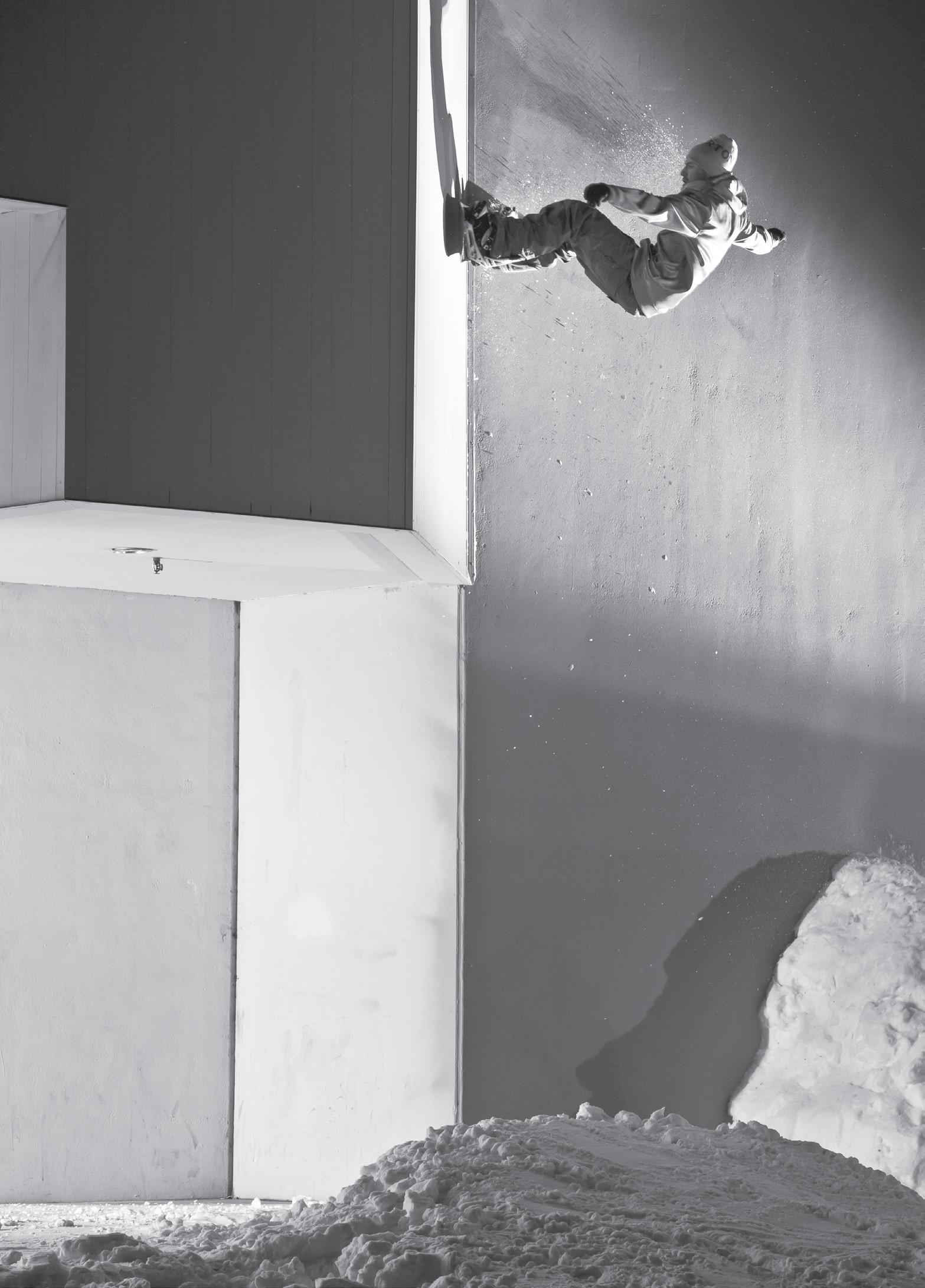
| Mark Sollors with a corner wall ride to backside 180 in Anchorage, Alaska. I’m consistently amazed at the riders’ ability to see a spot, visualize a trick, build the feature, and eventually ride away clean.
Blotto

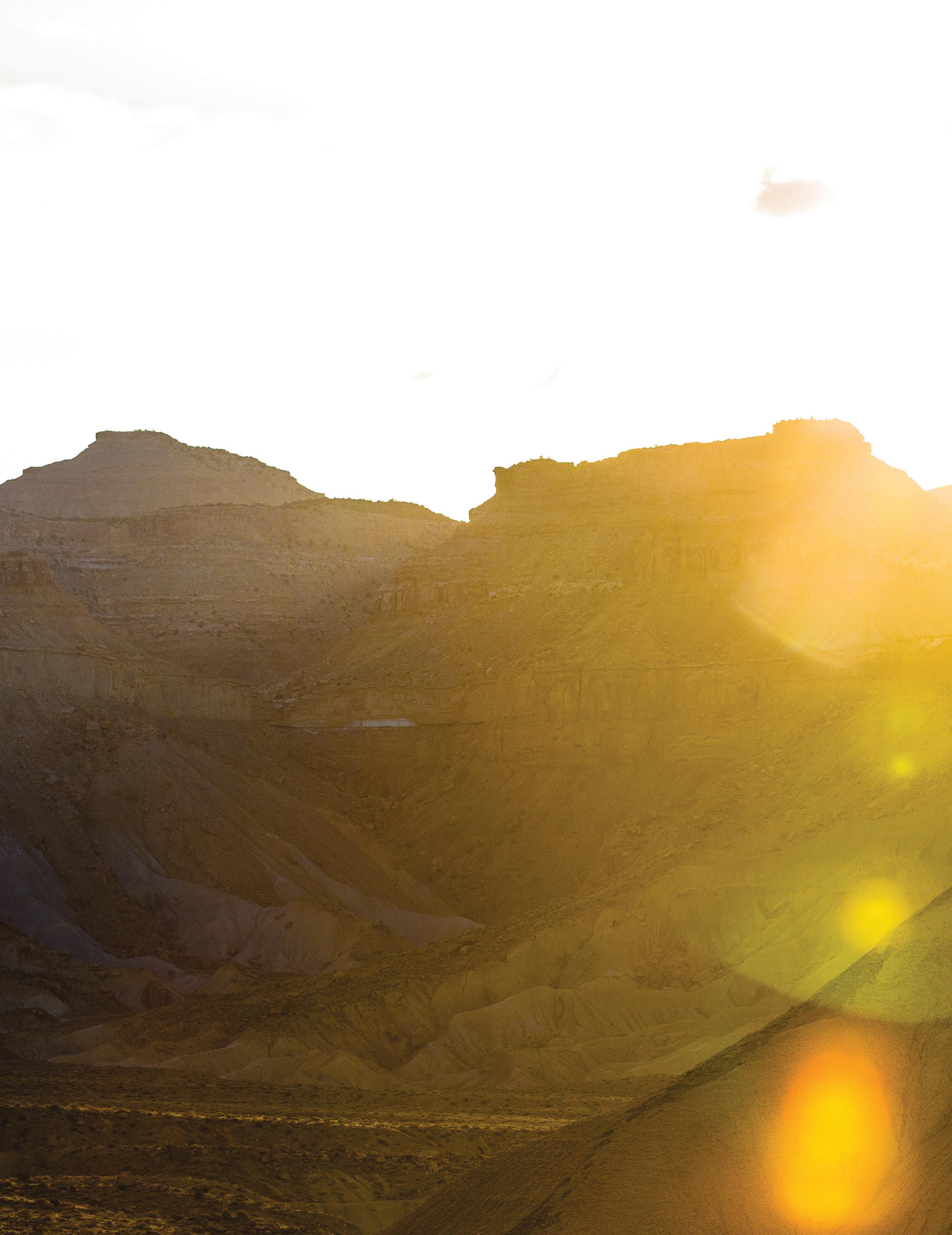
 Grant Gunderson | Rider: KC Deane
Grant Gunderson | Rider: KC Deane

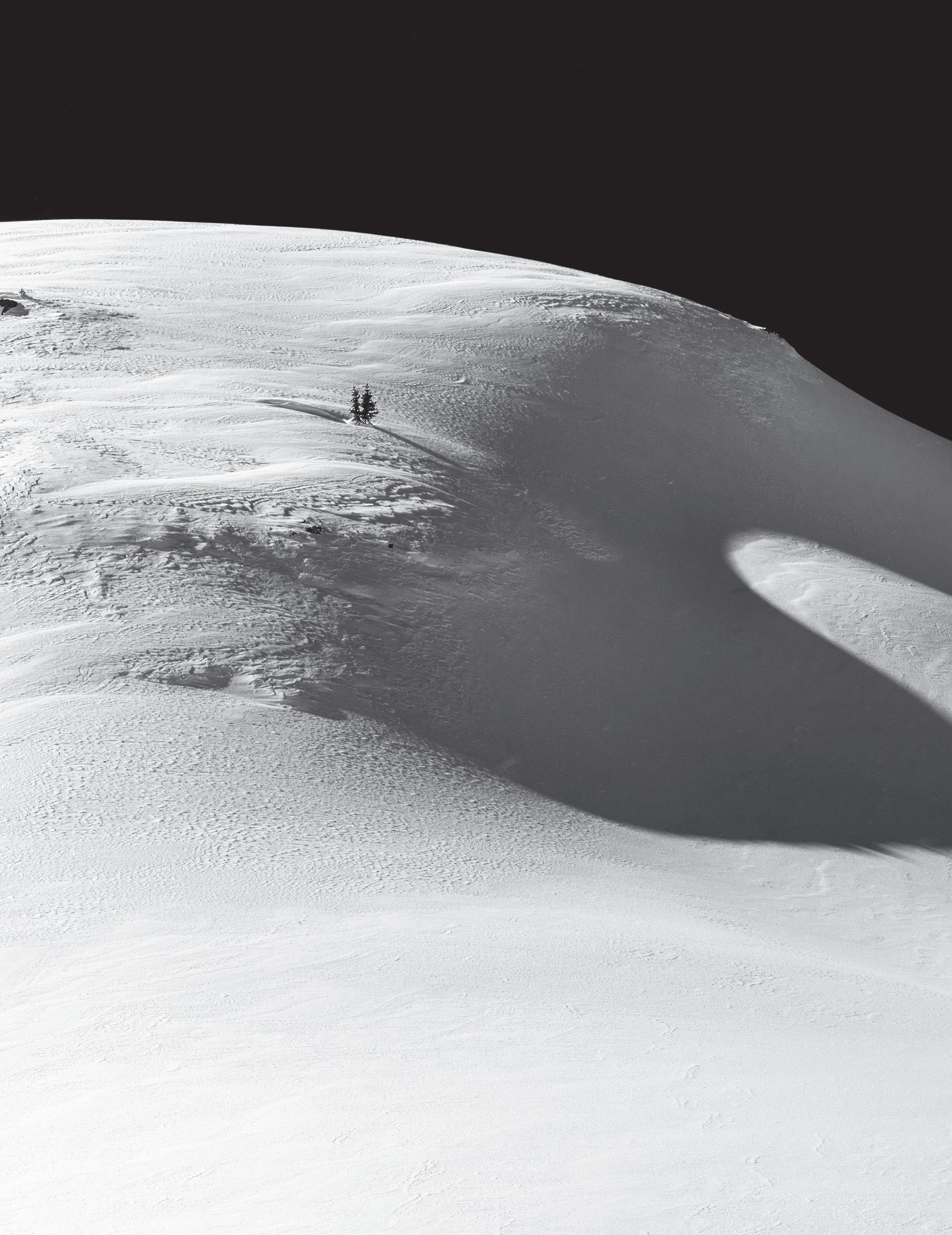 Colton Stiffler | Early morning moonset, over an other-worldly landscape, deep in the Montana wilderness.
Colton Stiffler | Early morning moonset, over an other-worldly landscape, deep in the Montana wilderness.

 Colton Stiffler | Traversing through the infinite labyrinth of crevassed icy spires on Perito Moreno Glacier in the Argentine Patagonia.
Colton Stiffler | Traversing through the infinite labyrinth of crevassed icy spires on Perito Moreno Glacier in the Argentine Patagonia.
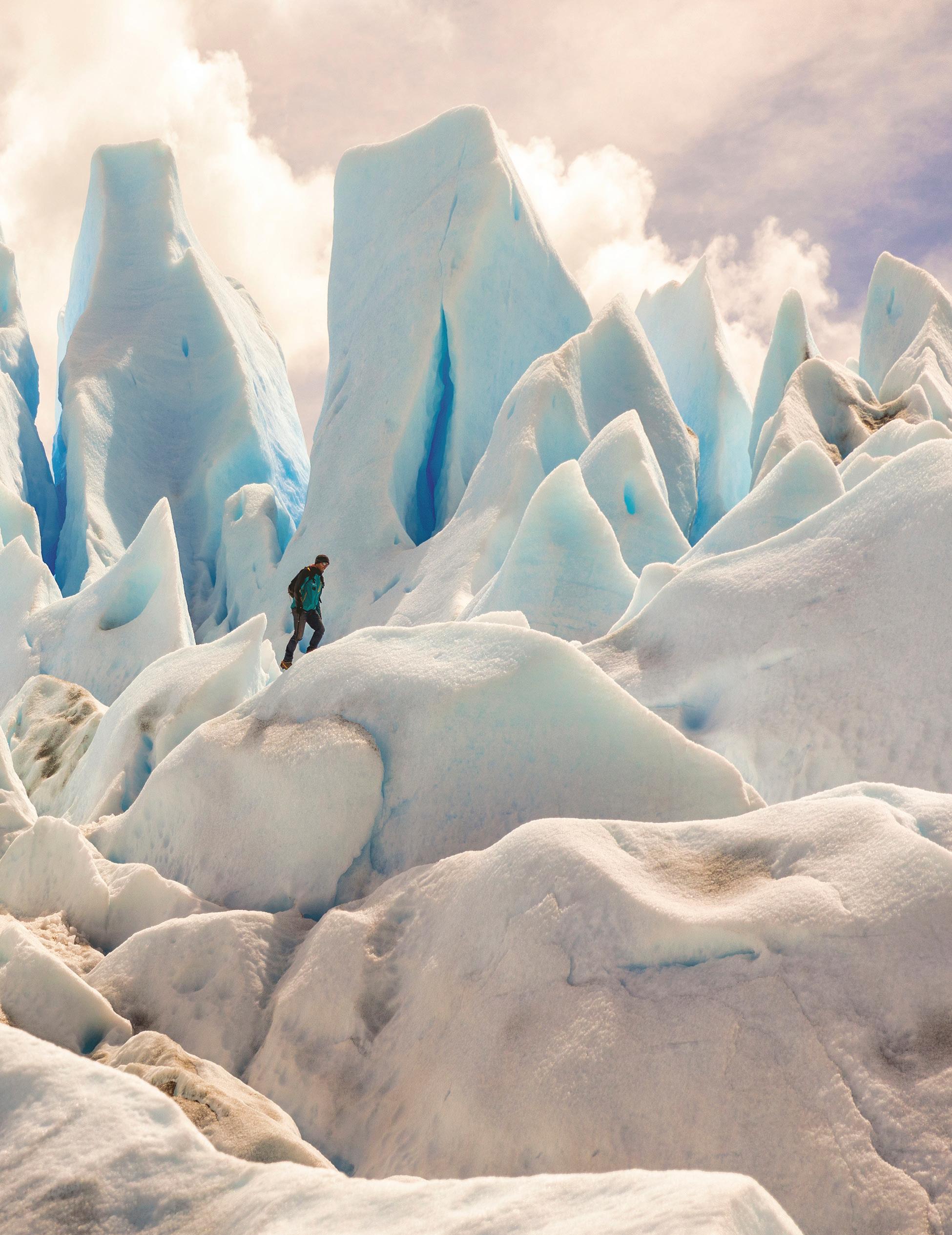
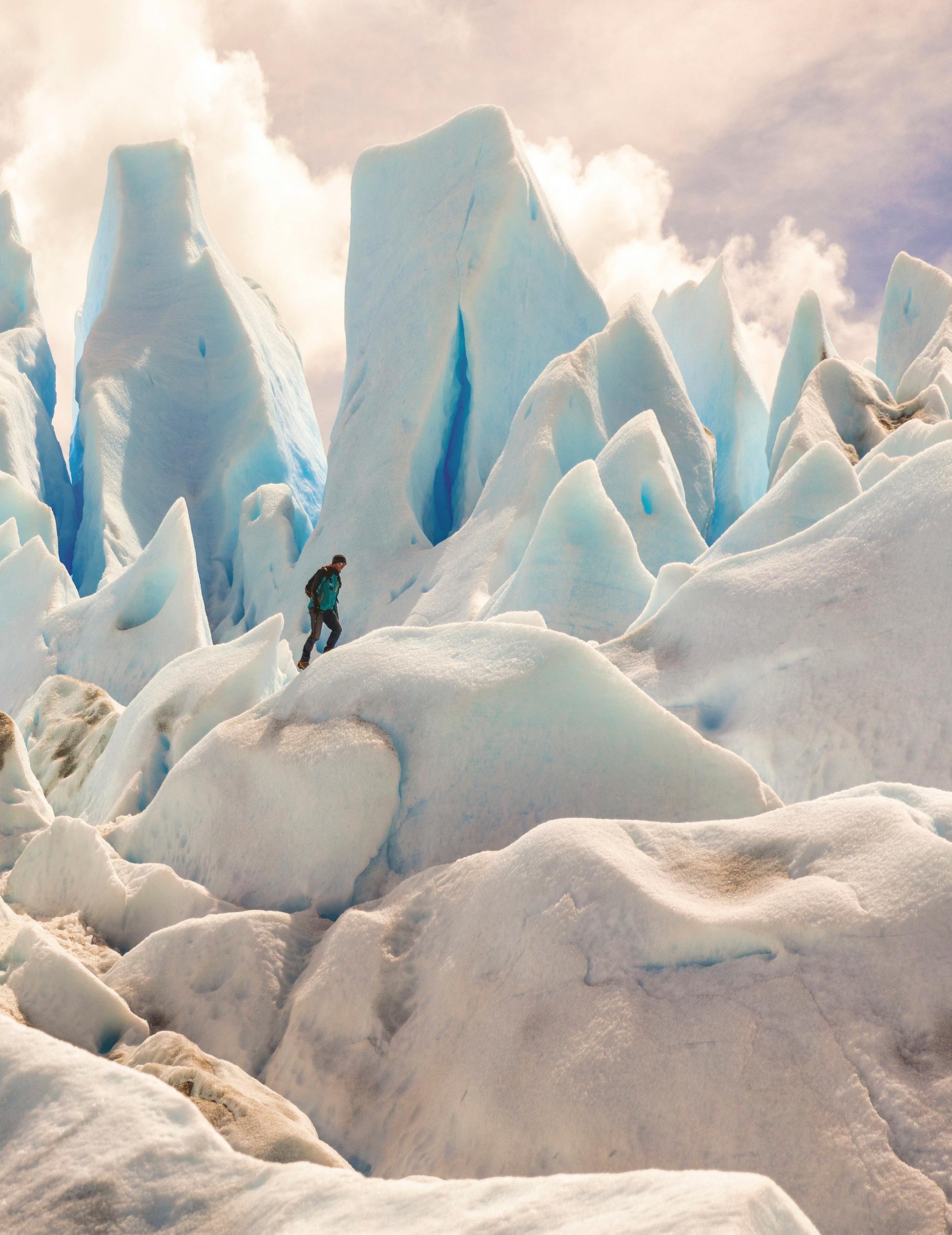

Liam
| Norway
Doran
“The main thing is to be moved, to love, to hope, to tremble, to live.” - Rodin
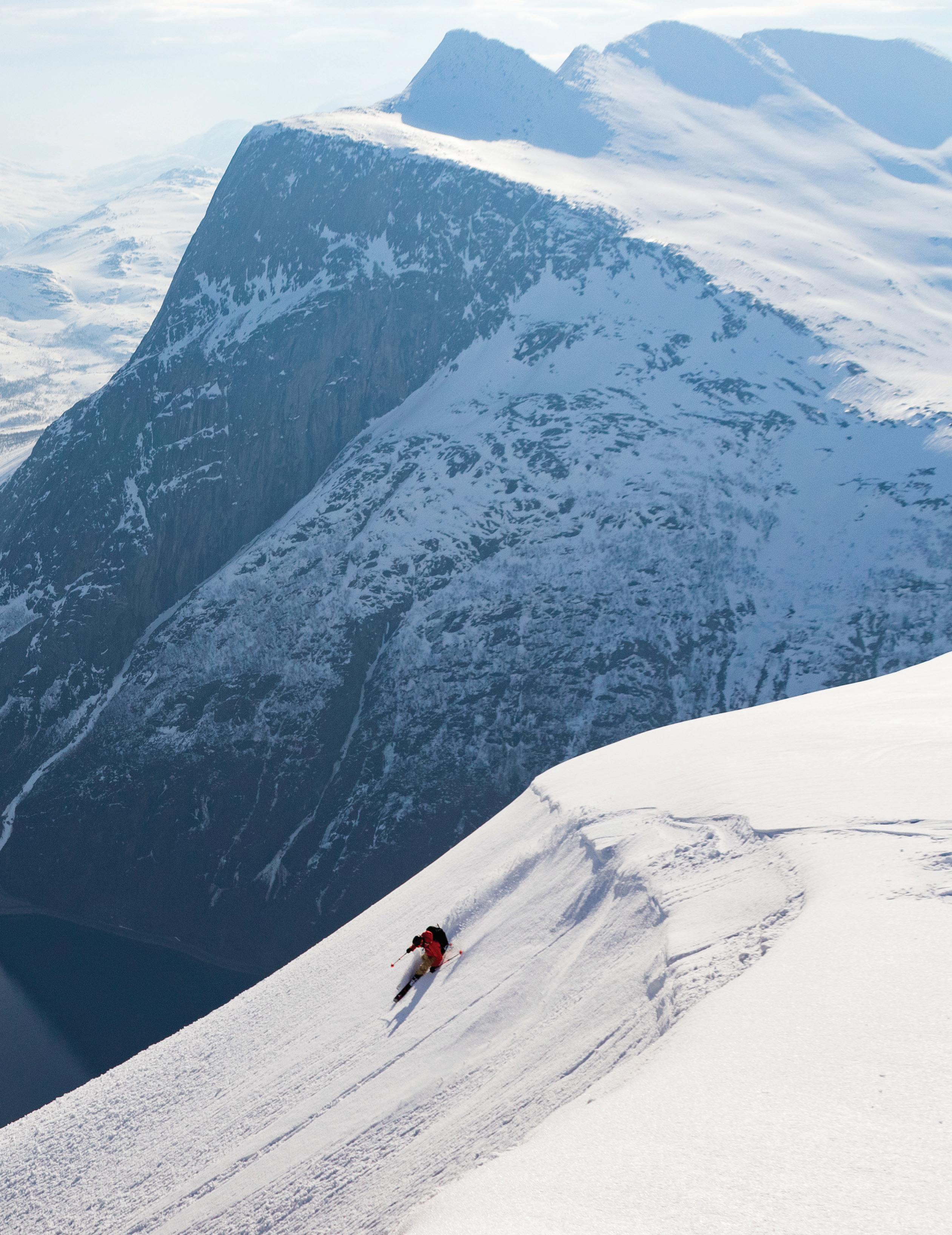
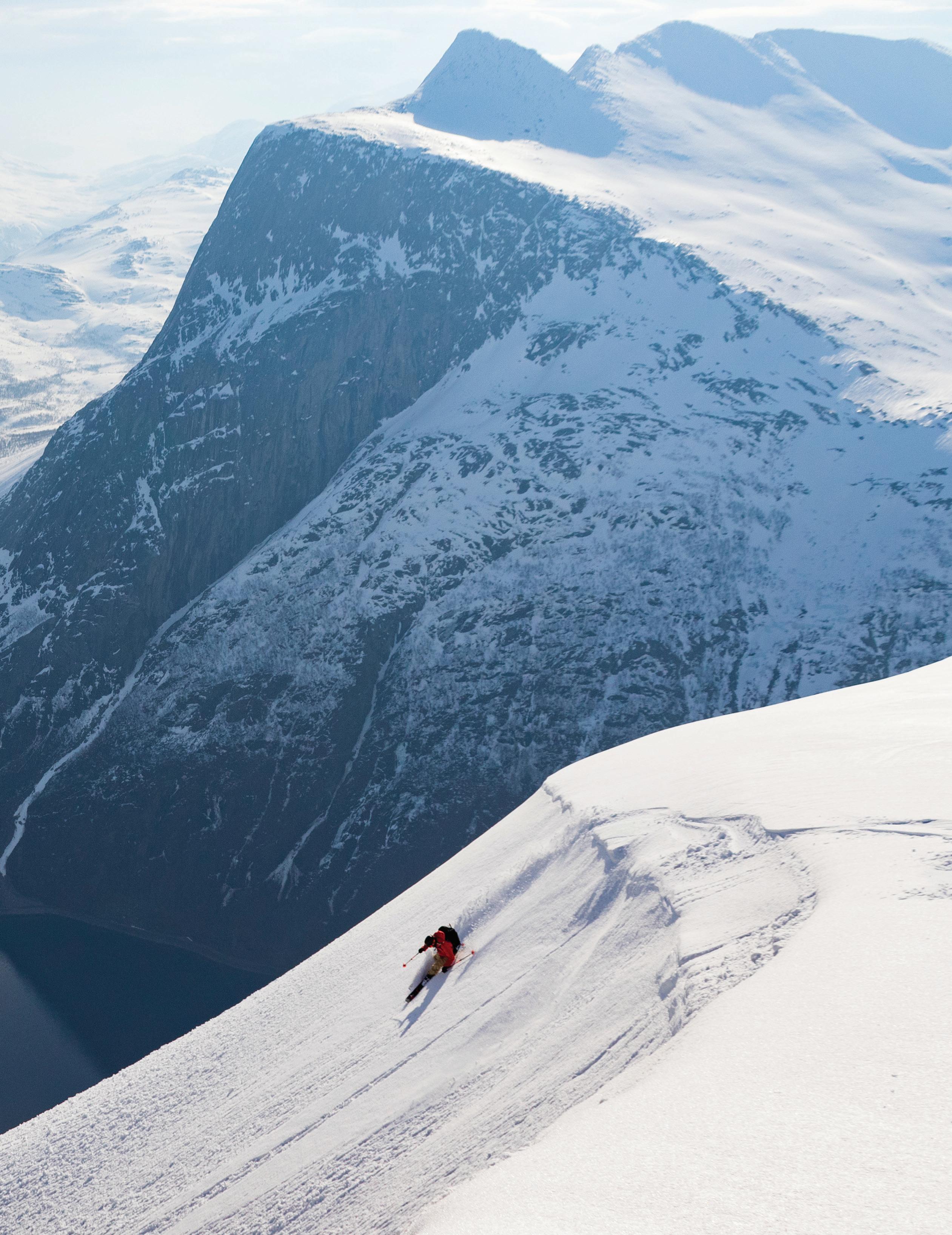

“LAYERS“ LAYERS”
with TAL ROBERTS
WORDS Ethan A. Stewart
From the push and grind of concrete jungles to the weightless wonder of dancing with gravity on a snowy mountainside, Tal Roberts has an eye for the artistry of action. He plays with perspective and lighting as creatively as anyone in the game. But it is his feel for the moment that is perhaps his greatest photographic super power, his ability to anticipate and then frame up a shot that celebrates is uncanny. Simply put, the man is excellent at what he does.
Based out of Ketchum, Idaho, Tal makes a good living as a commercial photographer with an enviable host of clients from the action-sports industry and beyond. His skillset is in high demand these days and rightfully so. But he remains an artist at heart, one who loves

i26 Photo & Art Annual | 84 |
Artist: Miguel Almedia Skater: Myles Laurion
Talkin’

 Artist: Matt Stikker Skater: Frank Shaw
Artist: Matt Stikker Skater: Frank Shaw
the unpredictable chemistry of collaboration. His ongoing series, LAYERS, is a brilliant and often beautiful testament to this. Since 2016, Tal has been working with an ever widening network of artists and friends to create unique, one-of-a-kind pieces for LAYERS. The concept is an easy one; take a black and white print of Tal’s making, maybe a skate photo or a snowboard picture or some abstract landscape, and send it to an artist for them to use as a backdrop for his or her artwork. There are no guidelines or rules, just a humble expectation that an artist will work with the print like it is a canvas of sorts and put their art on top of it in some meaningful way. “I don’t even give them a deadline.” says Tal, “I tell them to keep it until they are happy with it.”


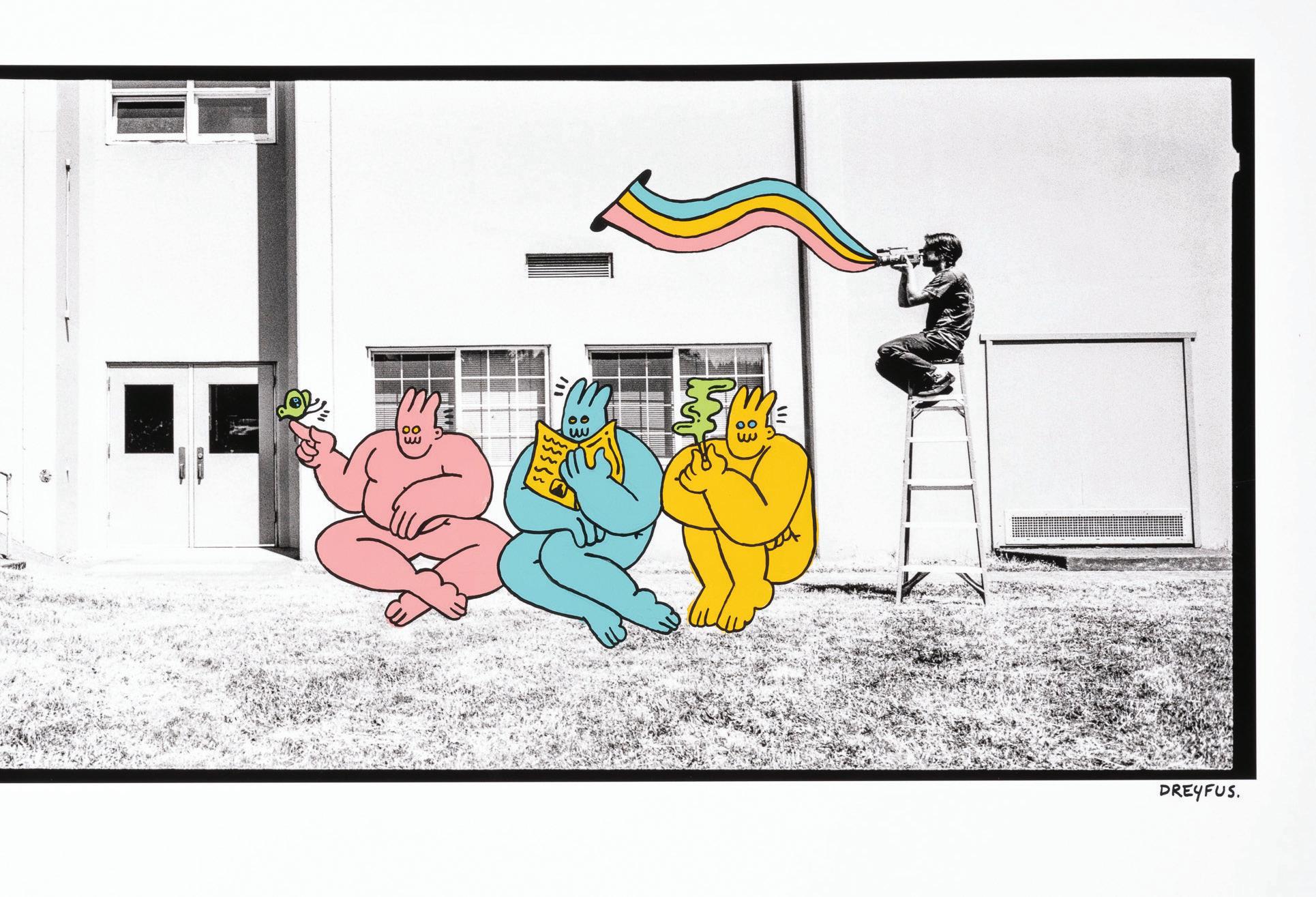
THIS PAGE
 Artist: Ashley Dreyfus
Skater Above: Mikey Carpenter
Filmer: Adam Robo
Snowboarder: Len Jorgensen
Artist: Ashley Dreyfus
Skater Above: Mikey Carpenter
Filmer: Adam Robo
Snowboarder: Len Jorgensen
The results, which include the cover of the magazine you are currently holding in your hands, are always a surprise. Sometimes its pen and ink, sometimes it’s stencils and epoxy resin, sometimes it’s paint or collage, sometimes its cartoon vibes and sometimes its geometric and hyper detailed. “You never know what someone is going to do with it- that’s part of why I love it.” explains Roberts. Over the years, collaborating artists have included Lucas Beaufort, Ashley Dreyfus, Philip Morgan, Charlotte Hemmings, and Hayden Burge.
“I started this at a time when I really wanted to do something more tangible and more permanent than all the pixels and digital stuff.” sums up Tal, “It came out of a desire to have something to show and hold in your hand other than a stack of old hard drives. Six years on and I still feel the same way.”
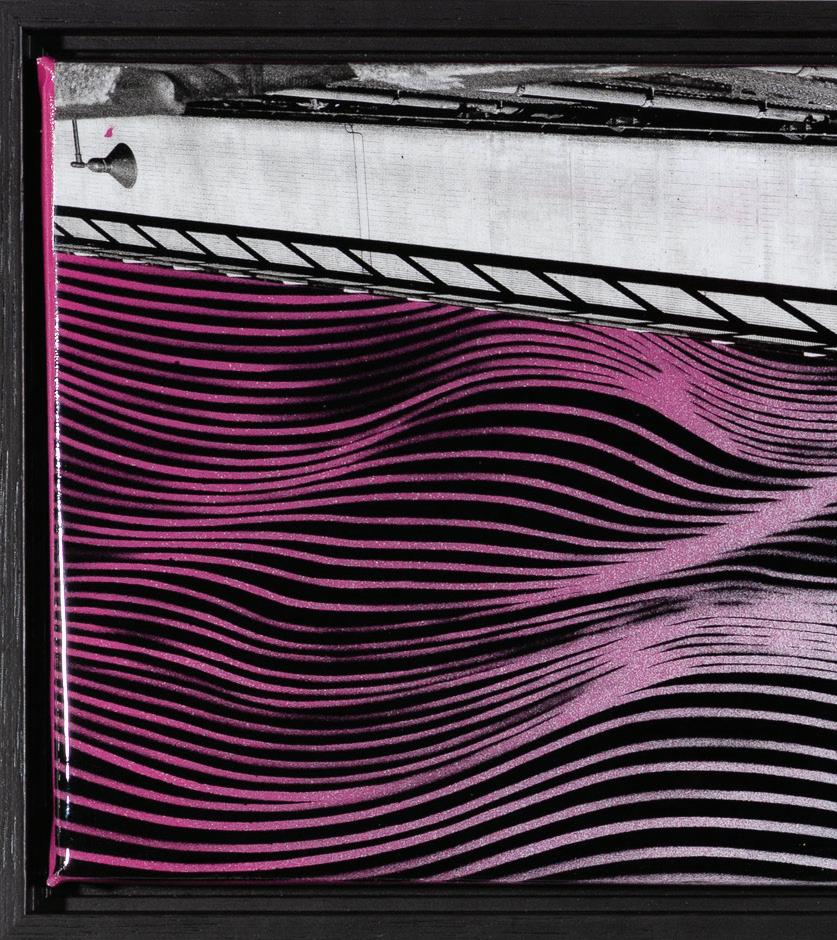

 Artist: Lucas Beaufort
Artist: Lucas Beaufort

 Artist: Rudi Broschofsky | Skater: Jess Mudgett
Artist: Rudi Broschofsky | Skater: Jess Mudgett
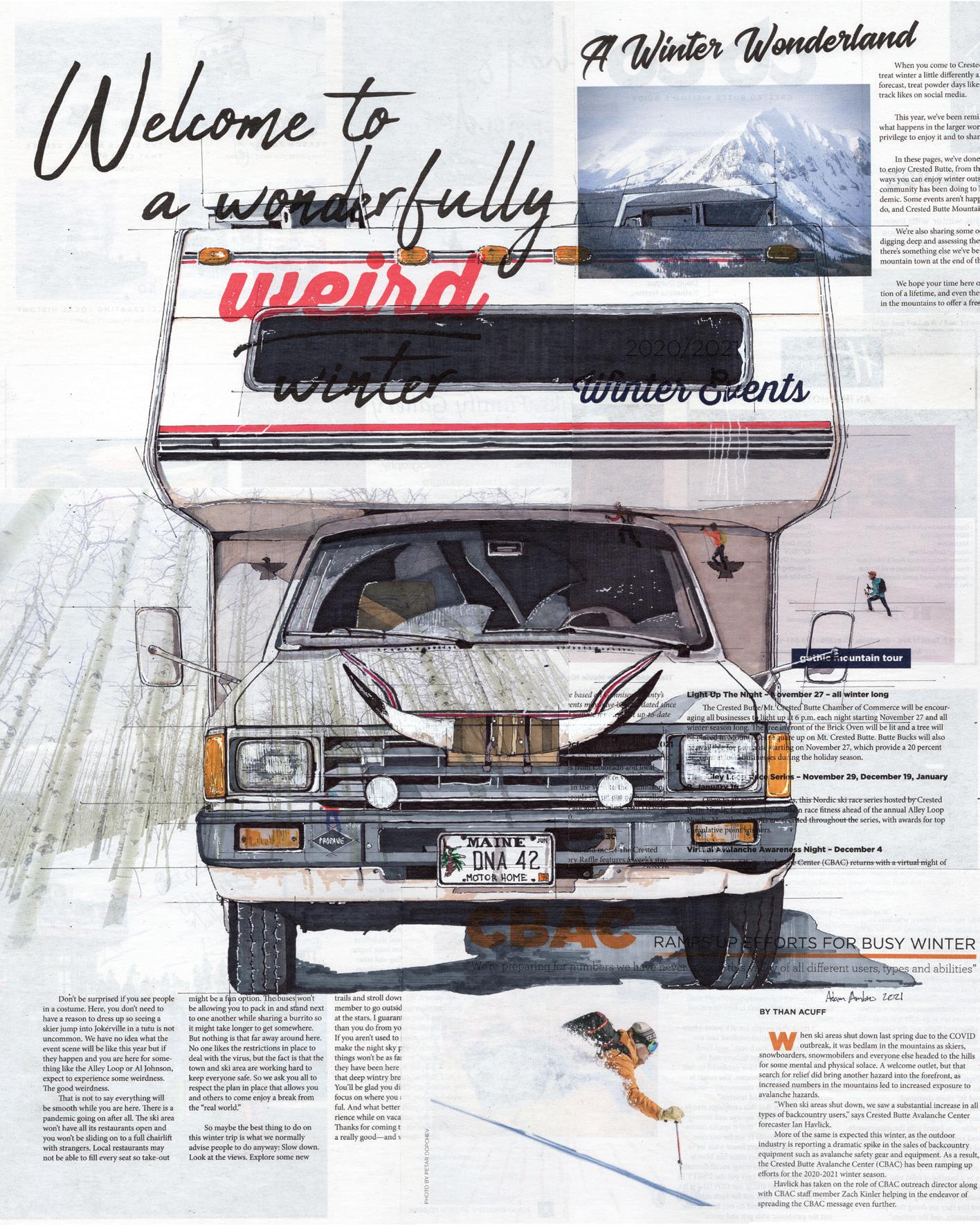
i26 Photo & Art Annual |

Beginning with a recycled canvas of newspaper, layers of pen, marker, and whatever else happens to be within arm’s reach, Adam Ambro creates imperfect interpretations of adventure mobiles he finds in the wild. Check out more at:
VAN ART
www.adamambro.com


VECTORIZED MANTRAS
Roberlan is a graphic designer and vector artist from Brazil. He has a penchant for old adverts, pinups, posters and a crazy assortment of vintage collectables. Check out more at: www.roberlan.com
i26 Photo & Art Annual |


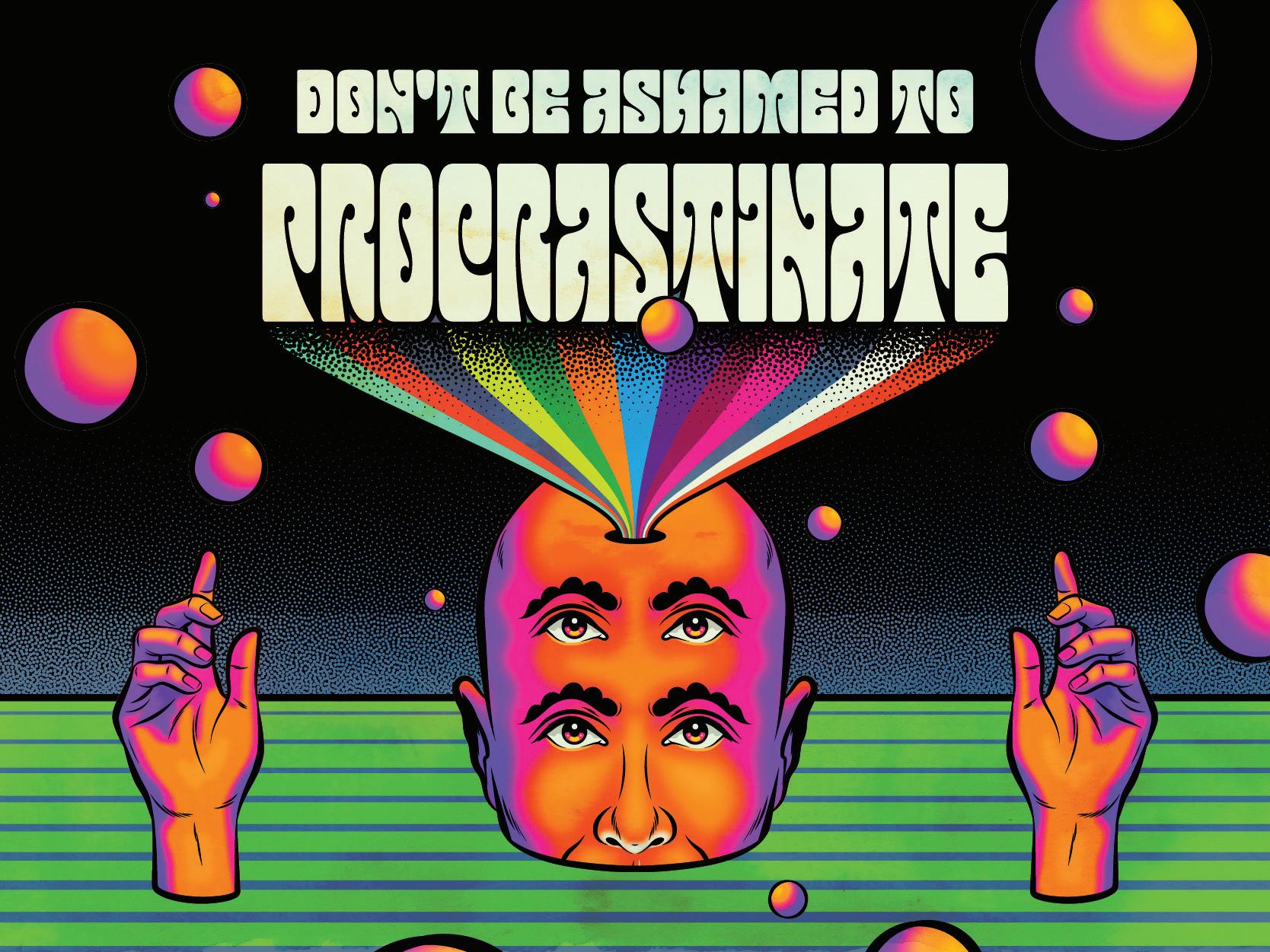

i26 Photo & Art Annual |
PAINTING REALITY
Celebrating the Mundane with Montana’s Andy Cline

96 |
For the uninitiated, Andy Cline is a paint er , n ot a photographer. A cursory scope of his portfolio might leave you thinking that he is, in fact, an artist who creates with the camera, especially if you peep one of his landscapes or highway views from across the room. But his is a language of brush strokes on canvas boards, not f-stops and light. Such is the radical realism of his art.
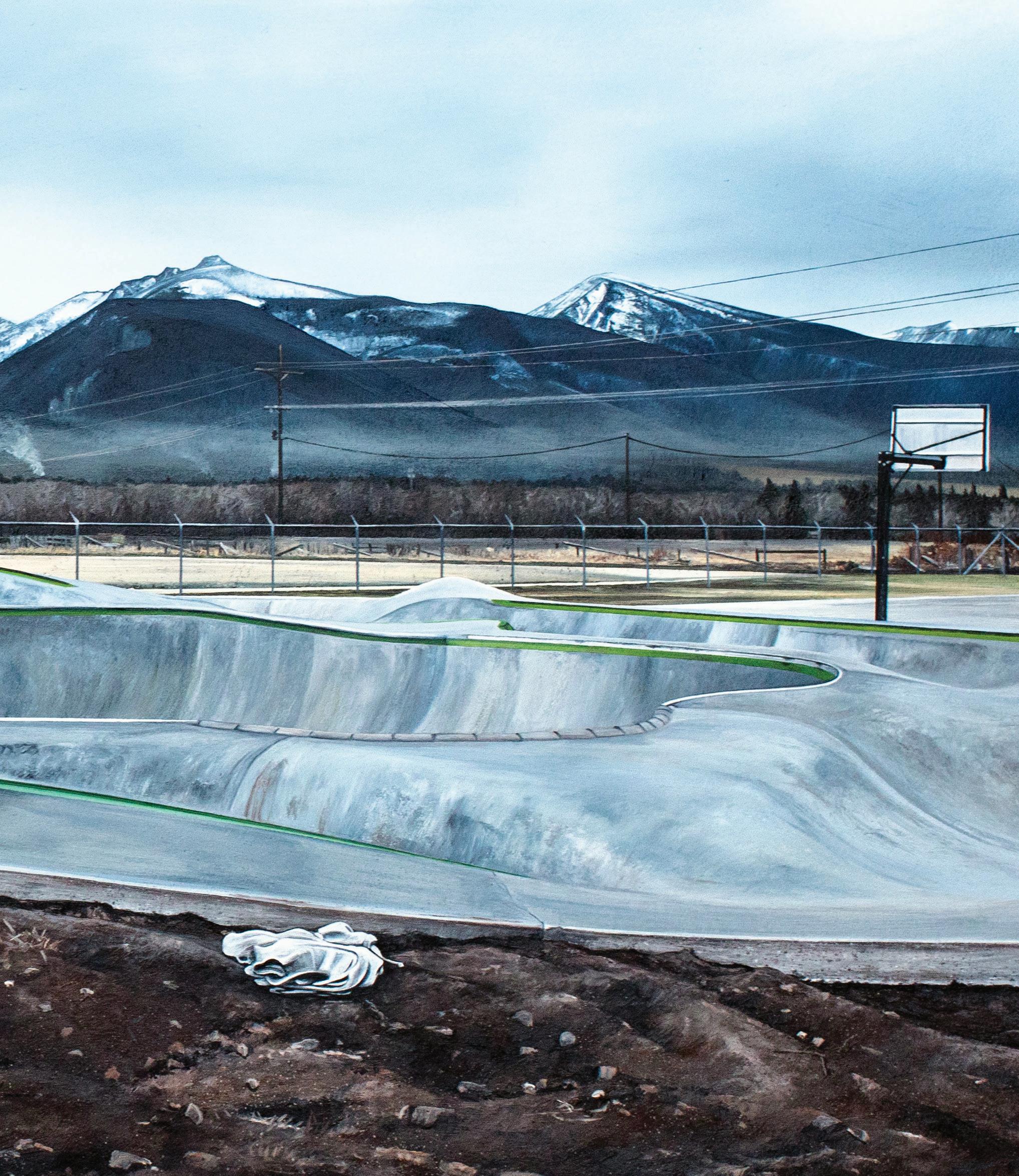

Crime Scene (Stevensville, MT)
BBorn and raised in Red Lodge, MT, Cline, who has an MFA from the University of Montana, paints pictures of moments you will instantly recognize and resonate with if you have spent any real amount of time in the Last Best Place. Trash cans thrashed about by a bear, a decomposing slab of roadkill on the side of a lonely highway, old cars rotting into a vibrant pastoral landscape, porta-potties with a view, rusted out double-wides, snowy peaks and tractor trailers parked at a rest stop- these are the things that capture Cline’s eye. He wrings the romance out of the mountains west and lets it die in the dirt. He captures the mundane with the accuracy of a historian, and yet, through his own unique sorcery, Cline is able to combine vantage point, subject, and juxtaposition in such a way that the finished product sparkles with an urgency and magic all its own. Nostalgia for the now, if you will.
A father of two young girls, Cline nowadays calls Missoula home, but family trips back to Red Lodge are frequent. The 400-mile rambles often serve as a form of interstate inspiration for the painter; the nameless dirt turnouts, the small towns, the rural highways, the quiet, forgotten moments of a state in transition all conspire to capture Cline’s attention. His intrigue is in the irony. “I am interested in the intersection of reality and pristine,” writes Cline. “We want to protect and preserve this place AND we want to access it. We live here. What does that look like?”
Bomb
Snow: How did you come to this style of art?
Andy Cline: It was shortly after graduating in 2003, while on a road trip across Montana with my girlfriend (now wife). Oddly enough, I didn’t really paint much while I attended art school at University of Montana. I started taking pictures with my camera through the windshield of our car as we drove down backroads on that trip. Really, it was just an attempt to pass time. But, after I developed a few rolls of film, I had this one image that I thought would make a “real nice” landscape painting. However, after laying it out and blocking in my canvas with the first layers of paint, I could tell that I was correct in my earlier assumption: “Yep, this is gonna make another nice yet boring-ass landscape painting that could be of anywhere or nowhere, and who’s gonna give a shit about this?” So I took another look at the original photo, and realized I was missing the most important part of the image: the highway!

All of a sudden, my landscape became a place that I recognized immediately. I had grown up looking out the window at this painting my entire life.
BS: Your art feels like a breath of fresh air when taken alongside some of the more traditionally romantic renderings of the west. Are you simply trying to reflect contemporary Montana?
AC: My snowboarder self wants the powder field with the perfect pitch and those first few turns. My painter self calls attention to resource overuse and the tension between backcountry exploration and assorted manmade environmental impacts. The scenic pullout might actually be a Town Pump outside
i26 Photo & Art Annual |
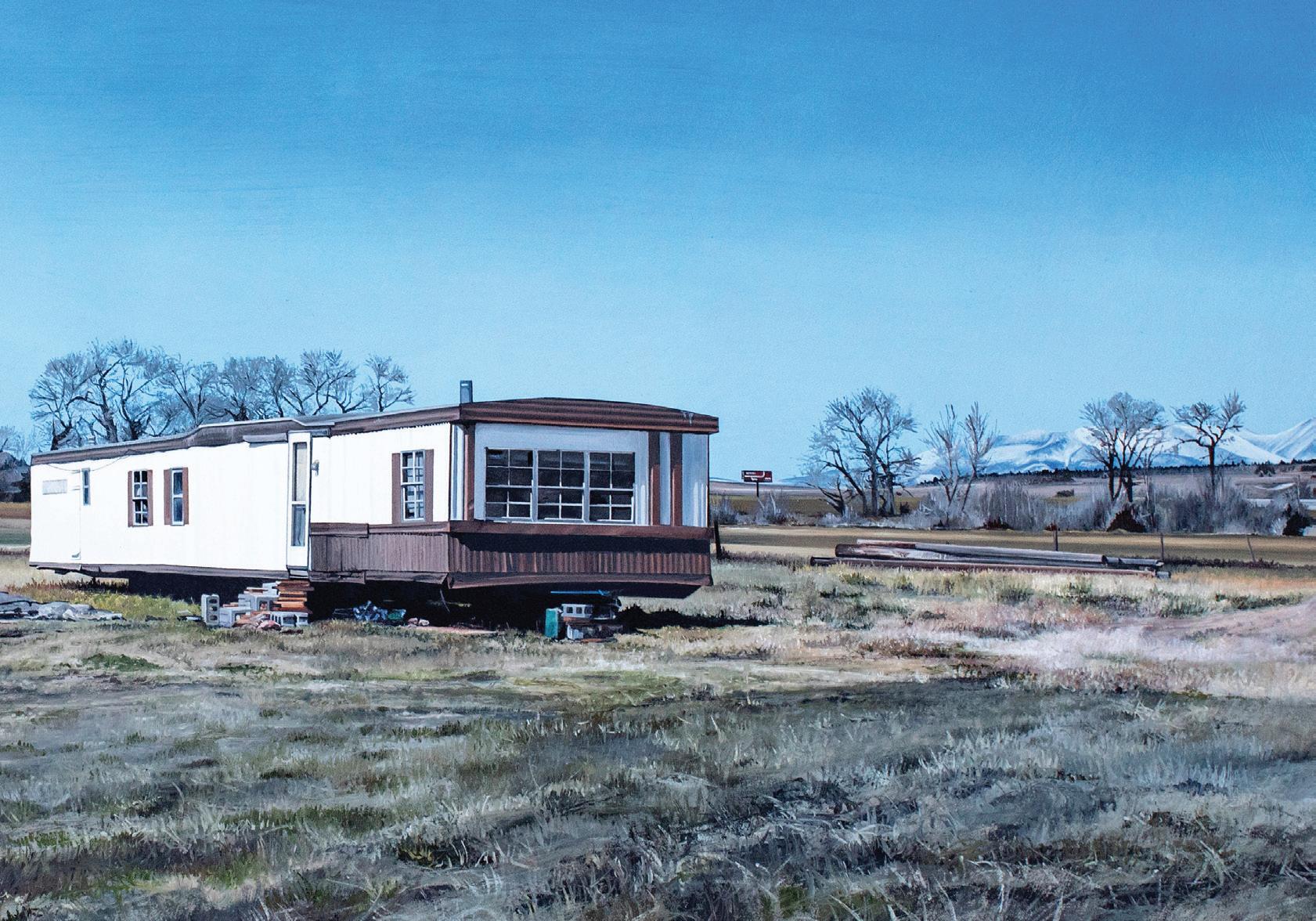
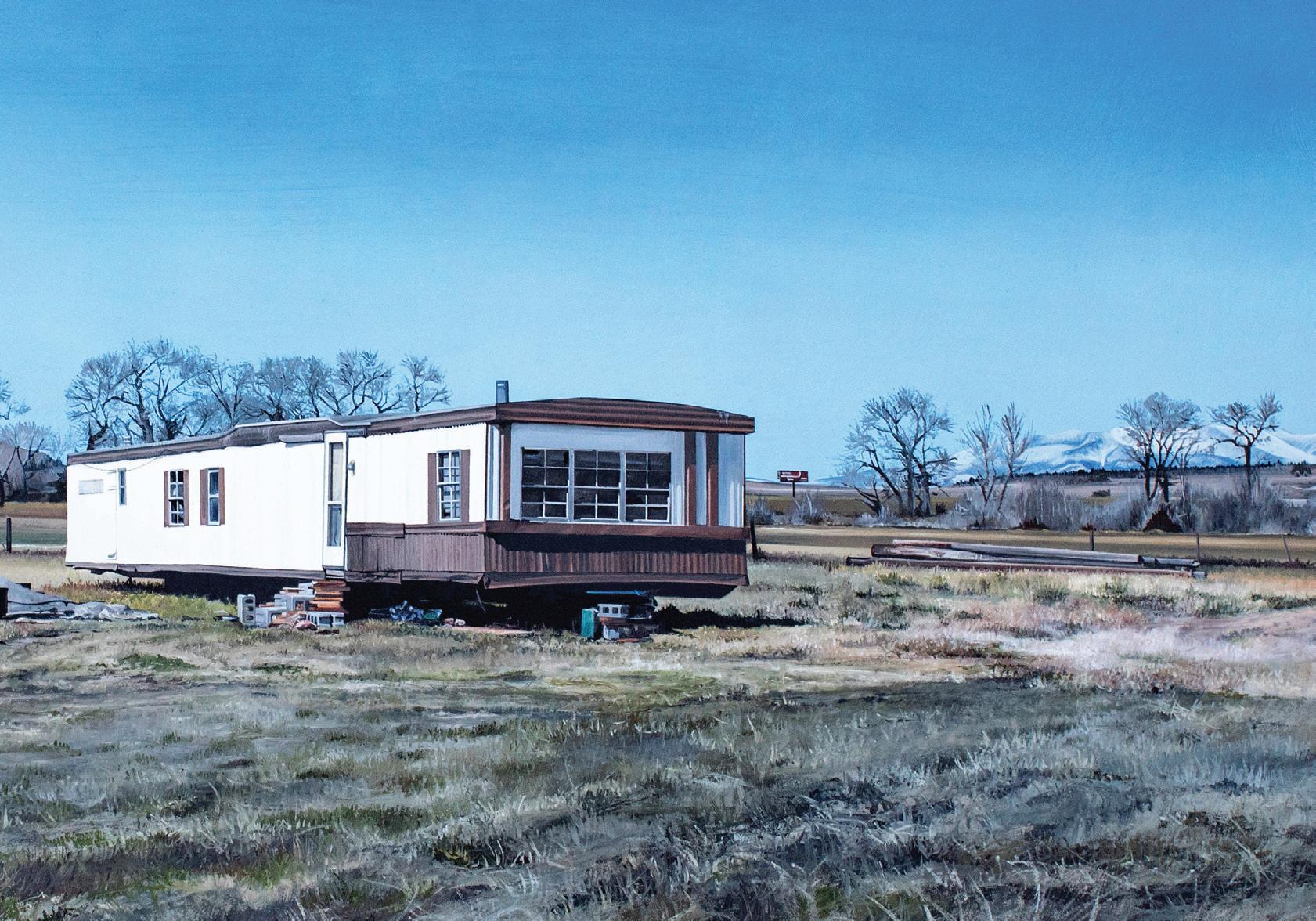
“Change is hard, and romanticizing the west is easy.
of Butte, the pristine forest is probably on fire, etc. Change is hard, and romanticizing the west is easy. The cowboy now checks the pastures from a car instead of a horse; people want to build a house in front of that mountain view. My paintings are really about the developing west, tourism, and the climate crisis. On family road trips, I might need to pull over to take pictures of a porta-potty by the river or a dead deer along the road. I think most of us imagine ourselves playing in the
mountains in our spare time. You know, getting away from everyone and finding that perfect campsite, that secret fishing spot, or that single track to ride. But I like to document the reality of the journey to and from adventures.
BS: If you had to describe your painting style/ subjects to a stranger sitting next to you on a barstool, what would you say?
AC: As an introvert, I can’t imagine myself at a bar talking to a stranger. (Laughs). Maybe, after a few, I’d have the liquid courage to describe my work as “representational paintings.” If you look close, you can still see the brushstroke. It’s very close to photorealism, but not quite that refined. I paint on a smooth panel, so there isn’t even the texture of a traditional canvas. They are frameless, and the paint bleeds all the way to the edges. At first glance they look like photos on the wall, and most viewers will often take a lap through a
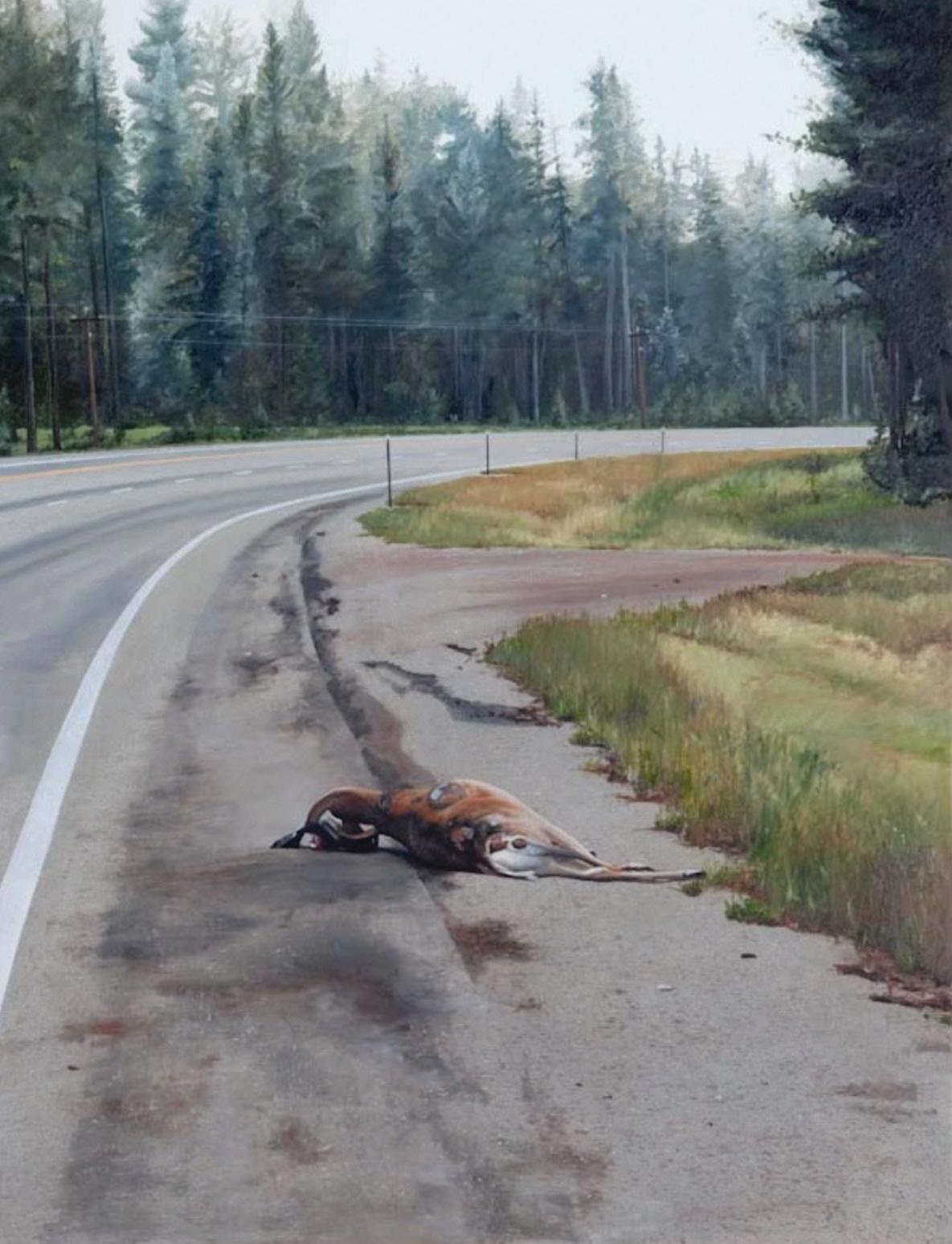

gallery of my work keeping their distance. Once they find out that they are actually paintings they’ll take a second look, often searching for proof of a brushstroke. I hope the juxtaposition of the traditional landscape with the realities of actually living in that landscape challenges the viewer to reconsider things they speed by every day. One of my favorite aspects of witnessing people view my art is when they recognize the highway corner or the spot where farmland turned into a development. They’ll excitedly tell me their story about that place, and then my painting becomes an experience we share. It’s like when I meet someone who was also there that one time in 2003 when Bridger Bowl got 68 inches in 24 hours…The serious imagery [of my work] is often combined with a tongue in cheek title to give clues as to what I was thinking for that painting, and to maybe lighten the mood. For example, one painting with the Anaconda smelter in the background is titled “Landscape with an Erection,” while in the foreground of “Oh Deer” a dead deer lays on the side of a highway.
BS: How long does a painting of this sort take you? What’s your work flow like?
AC: Each painting takes a fair bit of time to complete depending on the image and size. I work from photos because I am capturing an exact place at an exact moment. I like to study that moment. In all honesty, the original pictures really aren’t that impressive, but I’ve always had a knack for mixing color and building rich texture through layering oil paint…Smaller pieces take about a month or two, while larger paintings can take over a year. I’m not actually a full-time painter; most of my time is spent working as an electrician. Turns out having a couple of kids and wanting them to grow up skiing and mountain biking is sorta expensive. I recently opened my own electrical construction company. We also have a couple of vacation rentals and a long-term rental in Missoula. Finding time to paint is always a challenge, and especially so after having kids.
Cruising the Strip (Colstrip, Montana)
Oh Deer (Somewhere between Bonner and Seeley Lake on Hwy 200, Montana)

“
The cowboy now checks the pastures from a car instead of a horse; people want to build a house in front of that mountain view. My paintings are really about the developing west, tourism, and the climate crisis.
You learn to be very efficient with your time and energy. My windowless studio is in the basement of my house and is about the size of a closet (5’x6.5’). When the kids were younger, I’d wake up around 4am to paint before heading to work at 7. Covid has definitely thrown me off my rhythm, though, as my electrical work and my wife’s business both picked up at the same time that the kids were stuck staying home all the time. Needless to say, my production in the studio has slowed to a crawl, and I’m currently averaging a painting or two a year. But I am looking forward to finding more time to paint soon.
For more info about Andy and his art, find him on Instagram at @andycline or check him out at the Radius Gallery in Missoula, www.radiusgallery.com/artists
Window Shopping (Cooke City, Montana)″

The of
Picnic
WORDS Mike Harrelson
BOMB CHOW
Noah Wetzel

(a.k.a. Pic-a-nic - with a nod to Yogi Bear & Boo Boo)
We’ve all experienced that empty belly moment of regret. Out on an alfresco adventure – your caloric intake not nearly keeping up with your glycogen burn – the lightheaded swirl of properly bonking creeps up from behind. Out of seemingly nowhere, your outdoor accomplice pulls out the perfect sandwich.
Framed with stout yet airy bread (à la baguette or ciabatta), stacked with an artfully layered charcuterie sampler of stinky cheeses, fat-dappled genoa salami, and dank, glistening pesto or spicy sriracha mayo to grease the skids. Finished off with sprouts, red onion or perhaps avocado oozing out of the edges. Saliva glands now pumping, your mouth a pond of spittle and drool, you reach for your rucksack and pull out a petrified PowerBar®.
Regretfully, this scenario has played out one too many f’ing times for this hombre. Hence, I’ve made a pinky-promise-pact with myself to up my picnic game. And so should you.
It starts with giving yourself a few extra minutes in the morning blur to whip up some inspired grinds before blowing out the door: to the trailhead, the put in, the campsite, the ski hill, what-have-you. With just a wee bit of pre-planning at your local bodega, you can stockpile all the ingredients for an enviable submarine sammie, big mountain burrito, or wilderness wrap with all the trimmings. Tin canister full of cashews? Check. Nalgene jar full of Kalamata olives? Voilà. Seeded rye crackers and sardines bathed in Dijon mustard? Why not? Seriously, who doesn’t love fish breath when ambling about the great outof-doors?
There are infinite ways to freestyle your off-piste menu and revel in free-range culinary bliss. Whether vegan, carnivore or somewhere in-between, think of those favored recipes and snacks that pack durably and can endure being smashed up against a rack of
quickdraw carabiners or the sabertooth avy shovel at the bottom of your backpack. And remember, style points matter. Use the P-Tex base of your skis or snowboard as a makeshift cutting board upon which to fan out the elegant vittles (see #charcuteski on IG for inspiration). Bust out a red-checkered bandana as an impromptu tablecloth. The smallest details can make all the difference.
Also remember the sage maxim, “sharing is caring.” Be the guy/gal that shows up at the trailhead with freshly baked lemon scones. Or, pulls out the bento box of sushi pre-rolls on the summit. And – in my experience – a goatskin Bota bag, even with lowgrade chianti, goes a long way towards eliciting adulation and bringing smiles.
Which brings up the all-important après. I have outdoor amigos who, regardless of how god-awful early the dawn patrol or how frigid the ill-advised river put in, always have the presence of mind to pack an icy cooler full of skunky IPAs or lower octane “river beers.” Perhaps some bubble waters for the kids and/or your buds in recovery. And don’t forget sweets – like cookies! – as a critical component to dial in your palate’s sugar vs. salt harmony. Lastly, you can never go wrong with a fresh jar of pico de gallo salsa. And, of course, chips… Lots of stoneground, blue corn chips.
They say that life imitates art. I say a well-curated picnic imitates art. Keep that in mind as you set forth to express your inner backcountry Bourdain.
| 103 i26 Photo & Art Annual |
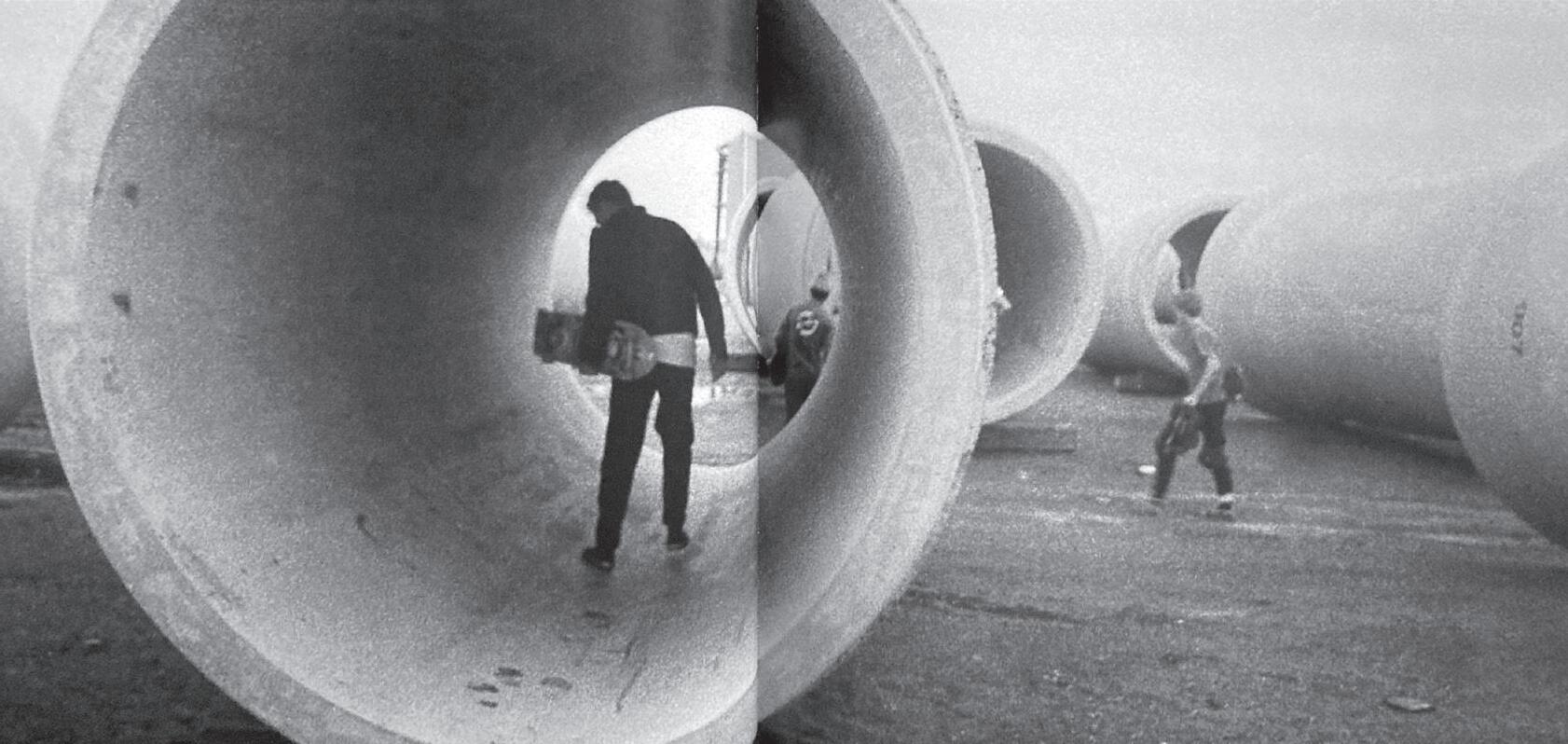
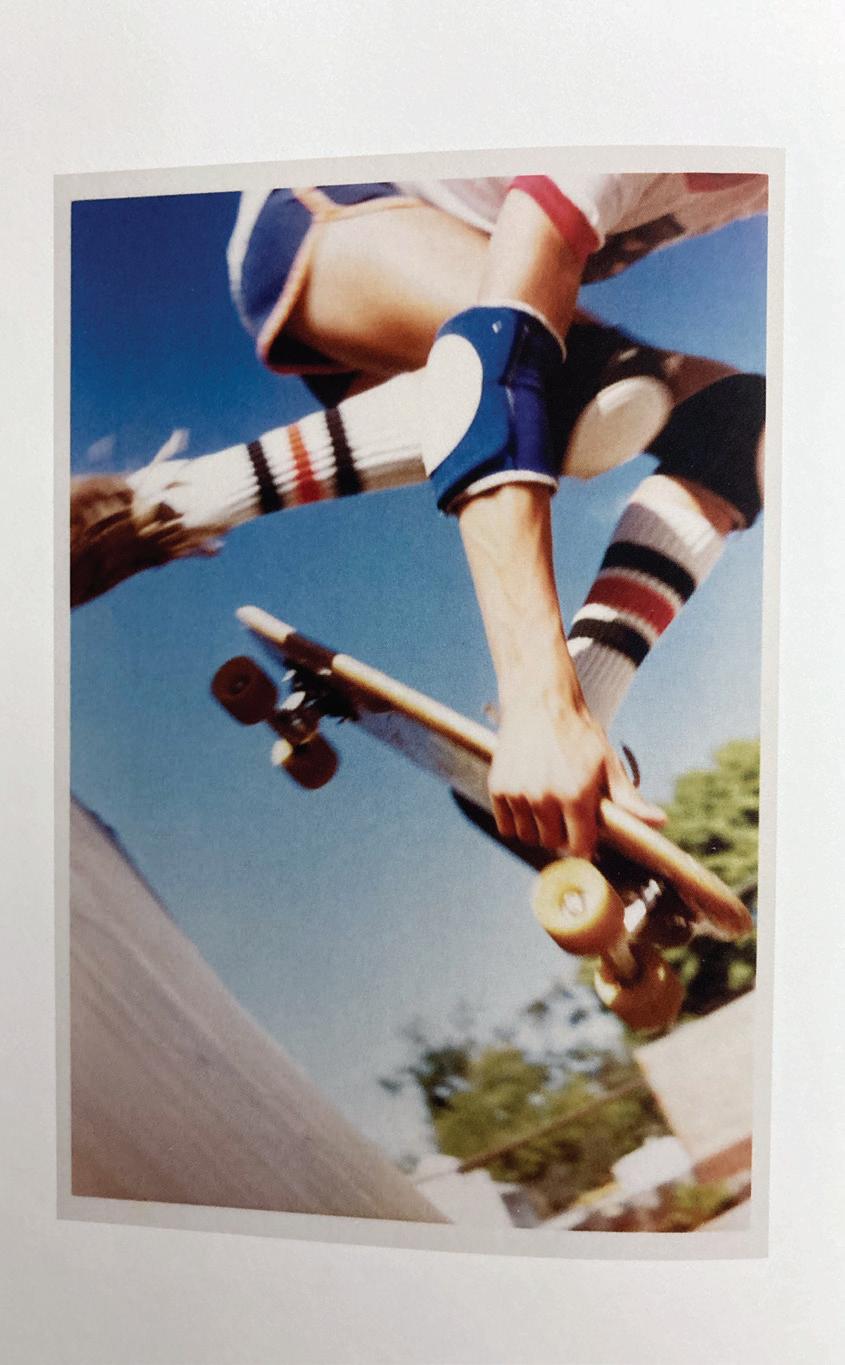
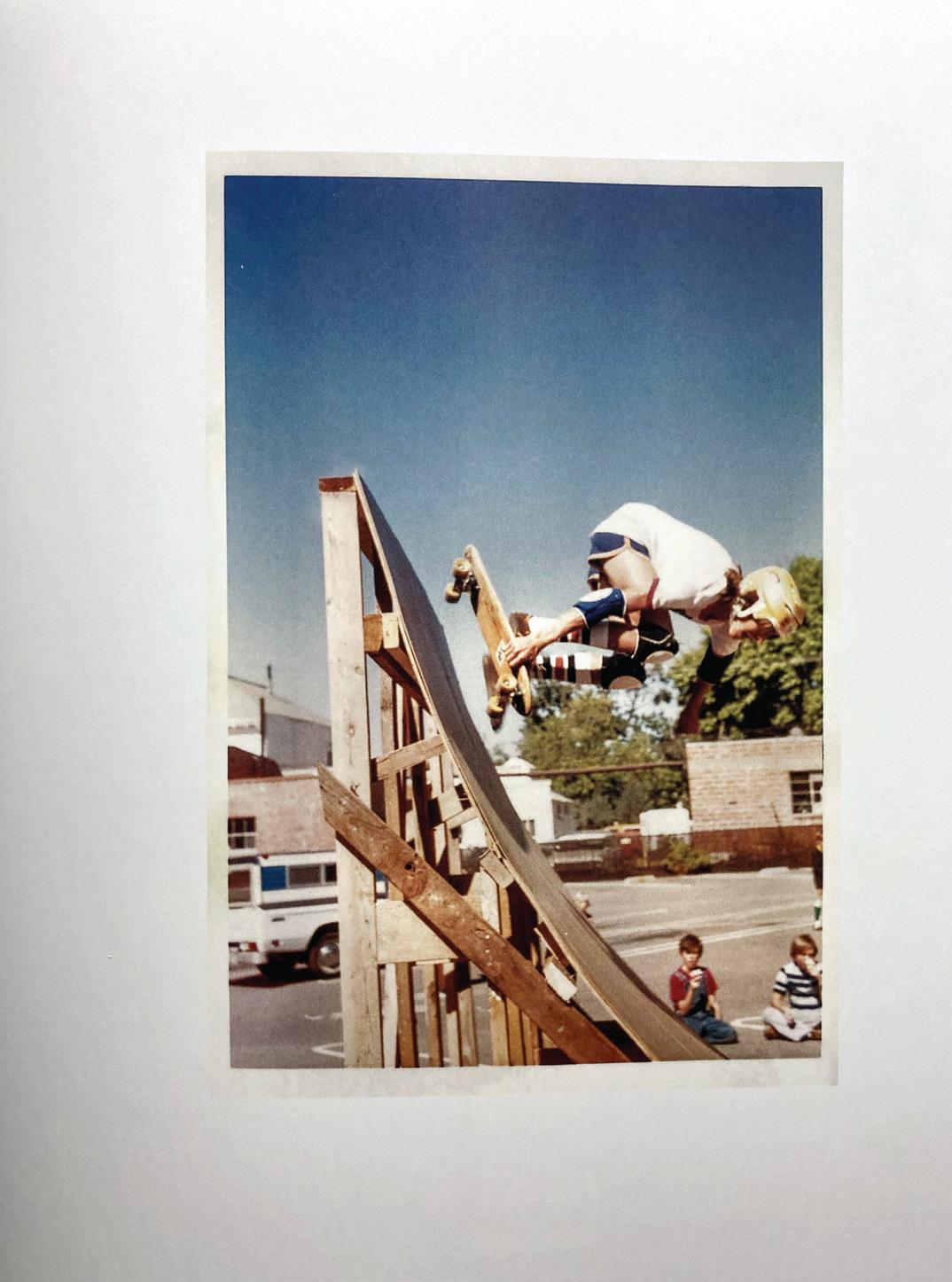
i26 Photo & Art Annual | Images from the book, Way High Kick Turn.

i nspiration bound
Way High Kick Turn: East Bay SF ’75-’89
Author: Jeff Johnson
Say what you will about all the sports that happen when riding sideways, but there should be no debate about which is the most authentic and hardcore. Skateboarding takes that prize, and it isn’t even close. Despite periods of commercial success, it is a sport that remains impressively unsoiled by the vapid bullshit of modern America. A big reason for this is the DIY, fuck the police, and “get up and try again after you slam on the pavement” ethos that has underscored skateboarding for the better part of the last 50 years. It is these formative values that shine in the coffee table-worthy art book Way High Kick Turn: East Bay SF ’75-’89
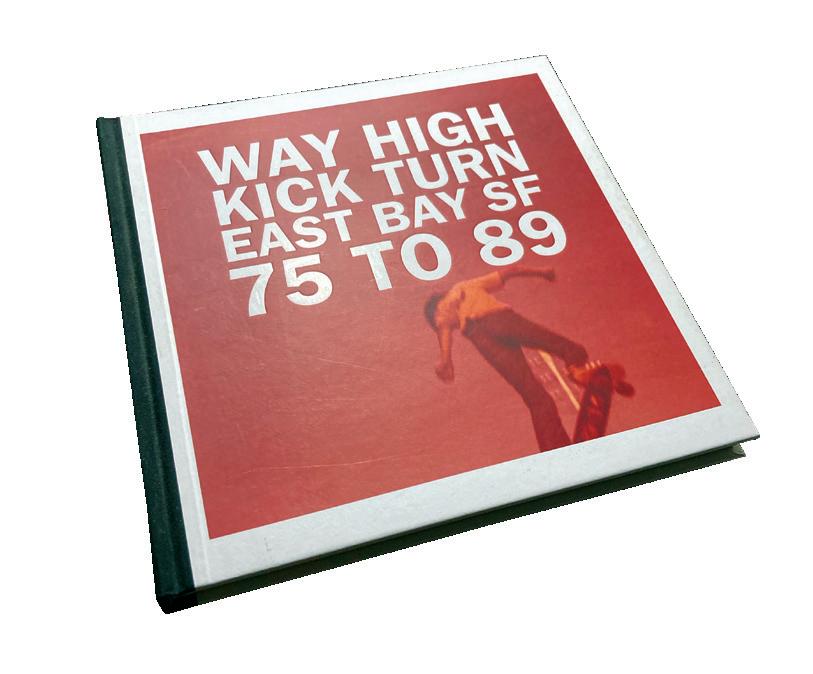
Curated by famed photographer and all around funhog Jeff Johnson, the photodriven book is an out-and-out love poem to the hyper-local skate scene found in the East Bay neighborhoods of San Francisco between 1975 and 1989. Those were some dark years in skateboarding, long before communities sanctioned things like skate parks, and the suburbs of the East Bay were no exception. Only punks and derelicts rode skateboards then, and they had to do so with little to no support from an industry that hadn’t really been created yet. It was the heyday of the sport’s subversiveness. Johnson, long before he was the first staff photographer at Patagonia and star of the dirtbag classic 180 South, was a kid growing up in Danville, California and he and his buddies were doing the thing, their criminal records be damned. Way High Kick Turn is a collection of photos and stories from that era. It’s the best darn skateboard scrapbook you have ever seen. Even better, because of the brilliant photo curation, a process which took Jeff the better part of a decade, the book serves as a time capsule of sorts for any boy or girl that was in love with skateboarding during those formative years. Flipping through the pages feels like sipping a fine, well-aged wine; intoxicating, timeless, and classy as fuck. And, as an added bonus, super model Christy Turlington wrote an absolute banger of a foreword for the book that she affectionately titled “Skater Boys.” -EAS
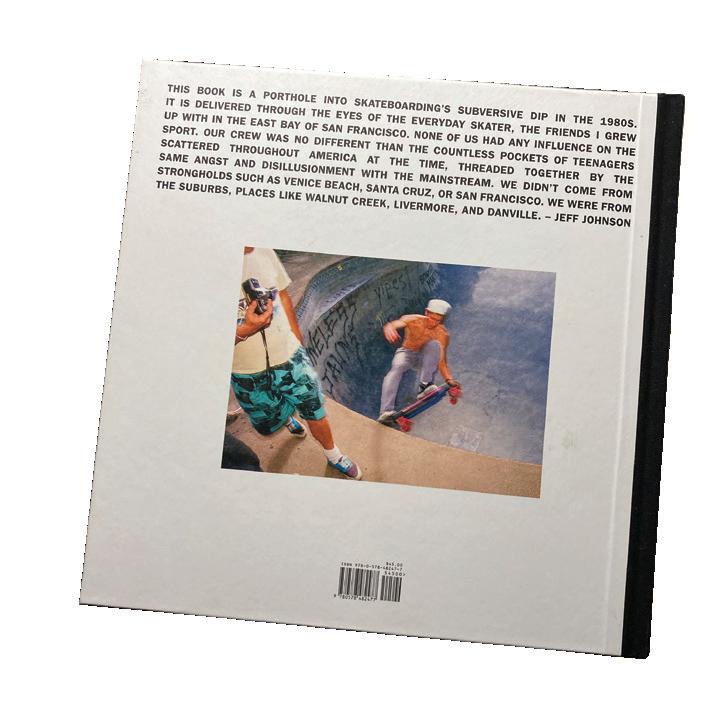 The Guide Author: Peter Heller
The Guide Author: Peter Heller
A good, page-turning read is a beautiful thing. It distracts from a broken world, entertains, and enriches. If you are on the hunt this summer for just such a thing, look no further than Peter Heller’s newest, The Guide. A fast reading, actionpacked, and timely bit of fiction, The Guide works as a sequel of sorts to Heller’s 2019 hit The River. It picks up with one of the main characters of The River, a young man named Jack, a year or two down the road from the life-changing conclusion of the last book. He has landed a dream summer gig working as a fishing guide at an elite and uber expensive lodge in Colorado. A destination for the rich and famous, with world class trout fishing out the backdoor, the Kingfisher Lodge quickly turns out to be much more than Jack bargained for.

Balanced with brilliant nature descriptions and a take on lodge life that only an experienced outdoorsman like Heller could yarn about, The Guide gets your pulse pounding as the action heats up. There is a forbidden romance, beer drinking, gun play, evil tourists, sinister billionaires, a mysterious virus, and a truly dark and disturbing plot twist that is sure to make you think twice about the future that awaits us all. Heller, a former Contributing Editor at Outside Magazine and author of several books, both fiction and non, is an absolute master of outdoor noir. The Guide is just the latest piece of evidence to this legacy. -EAS
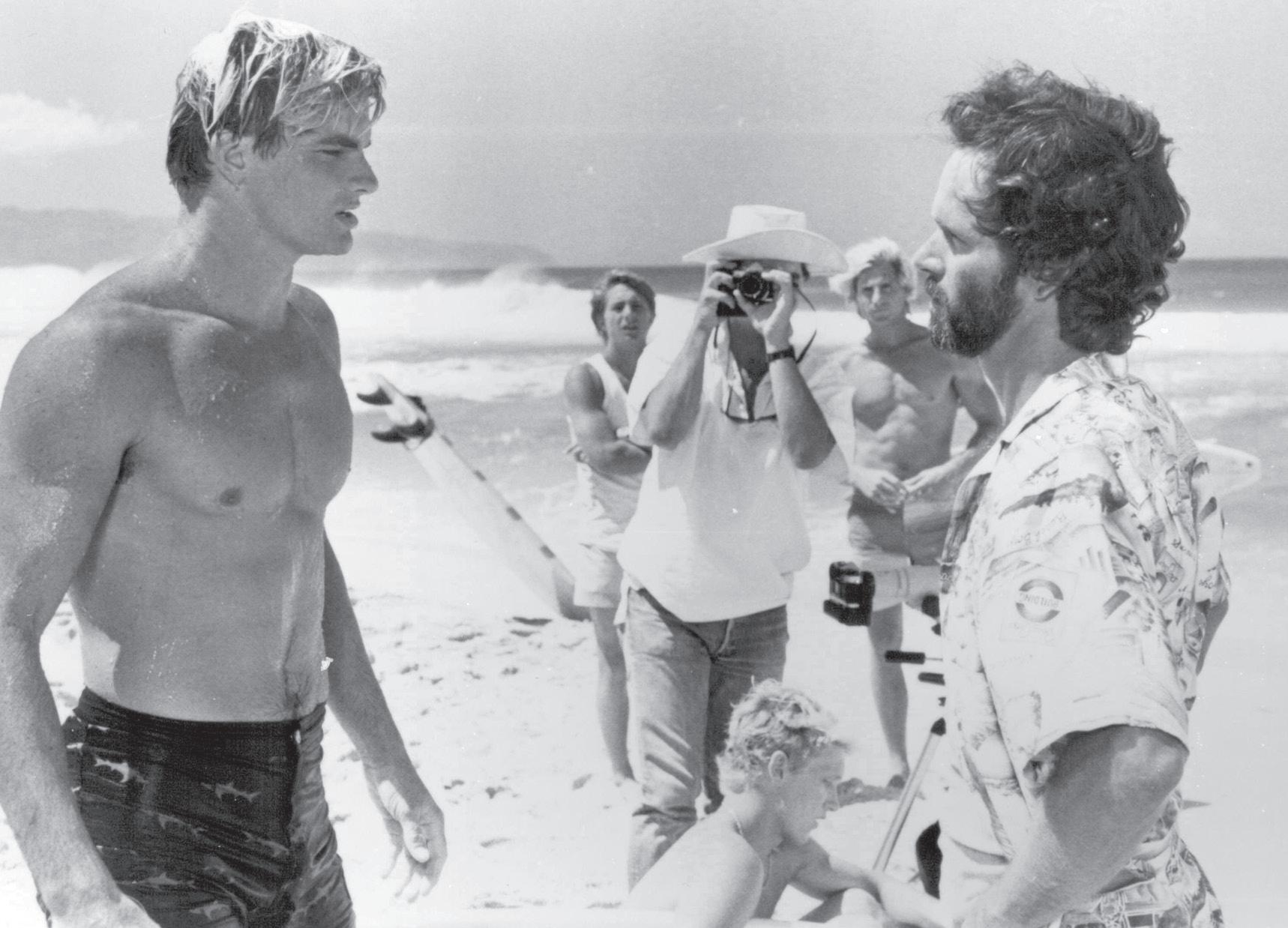
Soundings:
For the better part of the last decade, The Surfer’s Journal has been the only U.S.-based surf magazine worth reading. Its name is synonymous with excellence in the periodical publishing universe, a reputation earned for being both a high-end bit of surf porn as well as a catch-all of culture worth writing about. The same team is now making a podcast, Soundings. Hosted by former pro surfer turned writer/bon vivant Jamie Brisick, the podcast offers intimate conversations with some of the most interesting and illuminating figures from the Sport of Kings. Far from the typical industry blowjob that so many action sports podcasts end up becoming, Soundings, thanks in no

small part to Brisick’s worldly intellect and wit, delivers conversations and interviews that entertain as well as educate. The way that surfing unpacks into the world at large is on full display as guests like the Beastie Boys’ Mike D, original Dogtowner Tony Alva, and 7-time World Champion Stephanie Gilmore pay a visit to the studio to talk some story. Certainly, there is no shortage of surf geekiness going down, but there are also regular detours into topics with much broader significance, such as creativity, style, drug addiction, sexism in sport, and the sneaky benefits of irony. You don’t have to be a core surf slider to enjoy Soundings; you just have to be a curious human being. -EAS
The Surfer’s Journal Podcast with Jamie Brisick
Laird Hamilton playing Lance Burkhart in the infamous ‘80s classic, North Shore.

TASTY WAVES

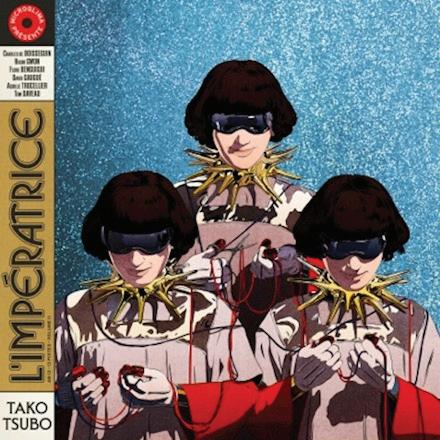
L’Imperatrice
Tako Tsubo
Nu-disco darlings L’Imperatrice charged back with a pandemic album packed with more of their signature sound, which blends ‘70s disco funk with space rock. On Tako Tsubo, female vocalist Flore Benguigui bears her heart and soul, delivering beautiful songs, mostly in French, about her broken heart. Check out the dance track “Fou,” which showcases Flore’s dainty vocals over a bopping funk bass line, which then strips back to sparse drums and synth etherea before ramping back into a solid funk groove. Close your eyes during the pulsing synth funk bridge of “Off To The Side,’’ and you might catch a feeling of running through a crowded city street looking for a lover lost in the fray. Tako Tsubo is a tight package of grooves built to fuel a mid-day yacht party on the French Riviera or an impromptu slap-the-bag flotilla on the Yellowstone. And for those who still long for a group to fill the void left by Daft Punk, L’Imperatrice might just be the antidote. -PT
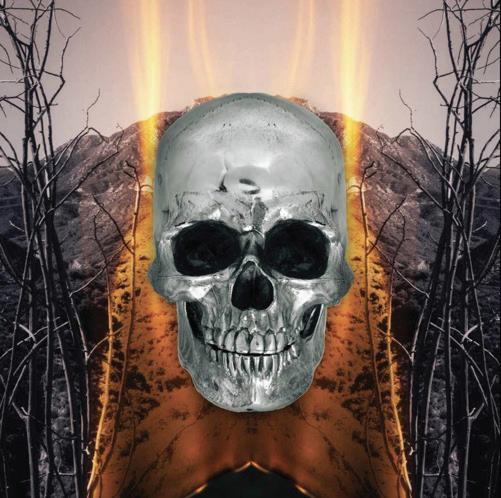
The Neverly Boys Dark Side of Everything
TV On The Radio’s Dave Sitek and Swedish troubadour Daniel Ledinsky seemed destined to form The Neverly Boys. The two mainstream music scene outcasts naturally feed off each other’s songwriting strengths, and crafted a beautifully melancholic album, sparing no details of personal strife on Dark Side of Everything. The opening ballad “Burn Hollywood” envelopes you with a celestial reverb slide guitar over an easily digestible guitar progression and plodding piano, while Sitek comes to blows with his hometown by crooning “Burn Hollywood, burn, ‘cause you don’t give a fuck about me.” Standout track “Mushroom Cloud” features layers of slack tempo acoustic and electric guitars that push the novocaine-soaked love story towards the precipice as the world succumbs to the apocalypse from an atomic bomb. Finishing the album is the refreshing palate cleanser “Your Life Is Blooming,” which lifts you up off the floor and swirls you around in the clouds (think Pink Floyd’s “The Great Gig In The Sky”) before sending you back to reality. Sitek and Ledinsky don’t need to lean heavily on studio tricks to entice the listener to spin the album another time. Rather, honest lyrics and rich soundscapes built over lush guitars embed their melodies in your consciousness and beckon you back for another odyssey. -PT
i26 Photo & Art Annual |
Reviews by: Parker Thompson
TASTY WAVES

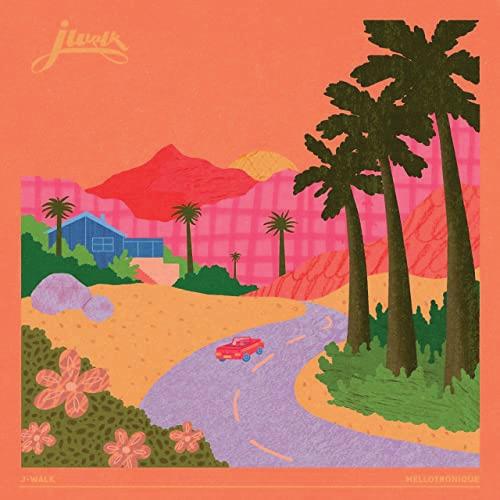
J-Walk
Mellotronique
As I listen to Mellotronique for the twenty-seventh time, I can’t help but imagine J-Walk as an adult who always dreamed of making beats for a spacewalk outside the International Space Station. His cosmic beats are unrelenting and push you further beyond the Kármán line with each listen. Beats like “Chill Bien’’ conjure vibes of ‘80s Miami Vice with a deft xylophone riff over a lo-fi bass line and psychedelic drums. Take one sweet toke of Daddy’s Dirt Weed, and “Fait Accompli” will make you think you’re watching the sunrise over planet Earth from Saturn. Given that J-Walk will likely be crafting sonic journeys for years to come, perhaps he will get the honor of a “spacewalk” in a NASA training center swimming pool and fuel yet another decade of epic trip-hop. -PT

Guts
Philantropiques
On Philantropiques, Guts set aside his passion of producing hip hop beats and assembled a live band to flesh out an infectious homage to Afro-Caribbean music. Over his career, Guts has collaborated with hip hop legends Rahzel, Common, Masta Ace, and De La Soul, but his love of the southern hemisphere lured him to transverse genres and build music beyond his usual boundaries. Don’t be surprised as Philantropiques explores subgenres from Brazil, the Caribbean islands and Africa – and does so with style. The lead single “Kenke Corner” is a straight Afrobeat homerun; “Daddy Sweet” is a driving tribute to Afro-funk-soul; “Já Não Há Mais Paz” has the band emulating samba soul from Rio de Janeiro; and “Li Dous Kansa” draws inspiration from Haitian jazz, but pushes the tempo, and adds a healthy dose of Afrobeat horns. If Guts doesn’t hit his goal of making your life more beautiful with this LP, be sure to check out his many hip hop bangers and beach diggin’ compilations. -PT

OUR TOP THREE ESTEEMED ALBUMS ON SPOTIFY RIGHT NOW.
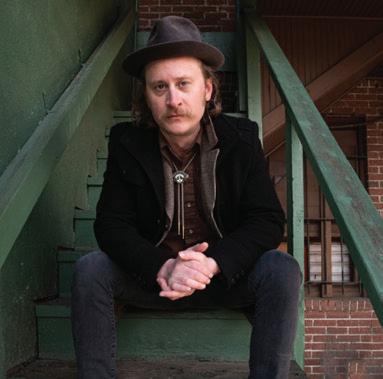

DURAND JONES & THE INDICATIONS Private Space / 2021

TWELVE POINT BUCK Fuzz / 2016
i26 Photo & Art Annual |
Peter King I Been Gone / 2021
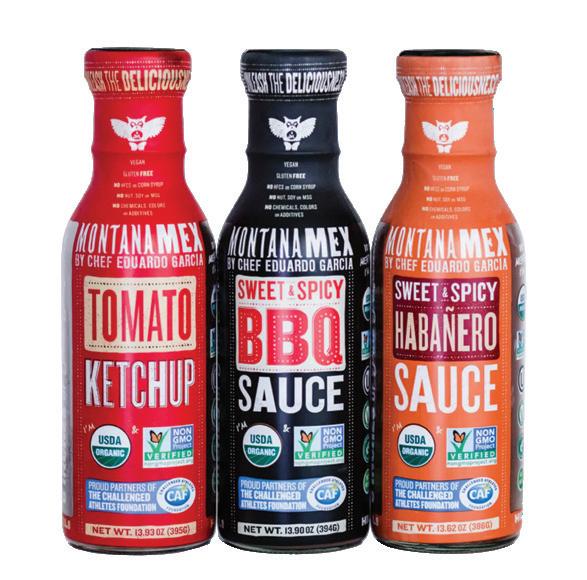





AGiVEHoOT.
30% of proceeds from all cooking kits sold through October 31st will go directly to supporting our community in its recovery. AGiVEHoOT.
South Towards Emigrant Peak in Paradise Valley, Montana.
When a 100 year storm hits you roll with it and do what you can where you can. We make fine foods and kits meant to feed hungry people and lift community.
This is How we
Looking

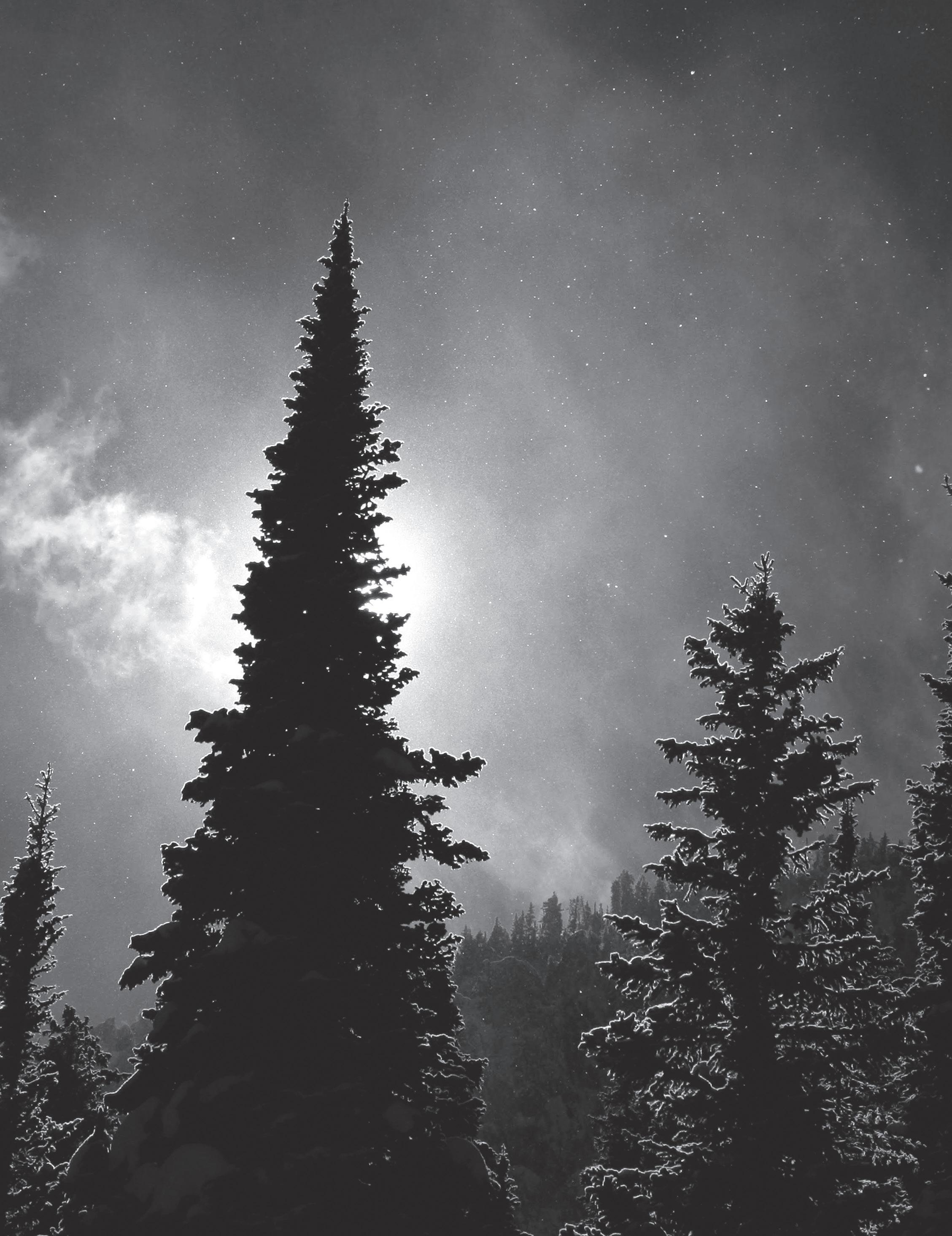

110 |
Remember when we were cold?
Our bodies, the way they curled in or together, snow turning water washing under clothes soaking nylon shields introducing us to how earth feels when she’s resting.
Remember how we wished for summer beneath the bleak grey of early March and how “spring break,” for a while, for some, was our escape from muddy walks and sleet?
Remember the fuss of snow pants and the sting of frostbite on the tip of your nose and the deep freeze that turned hair to ice between home and the bus stop?
Or what about those later years of hands stuffed into armpits between wild hammer swings attaching rough cut oak to the side of someone’s second home?
How many complaints did we levy in our careless calls for the cold to go awayfor the heat of July in January or consider relocating “someplace warm,” like warmth or comfort or salvation was the answer?
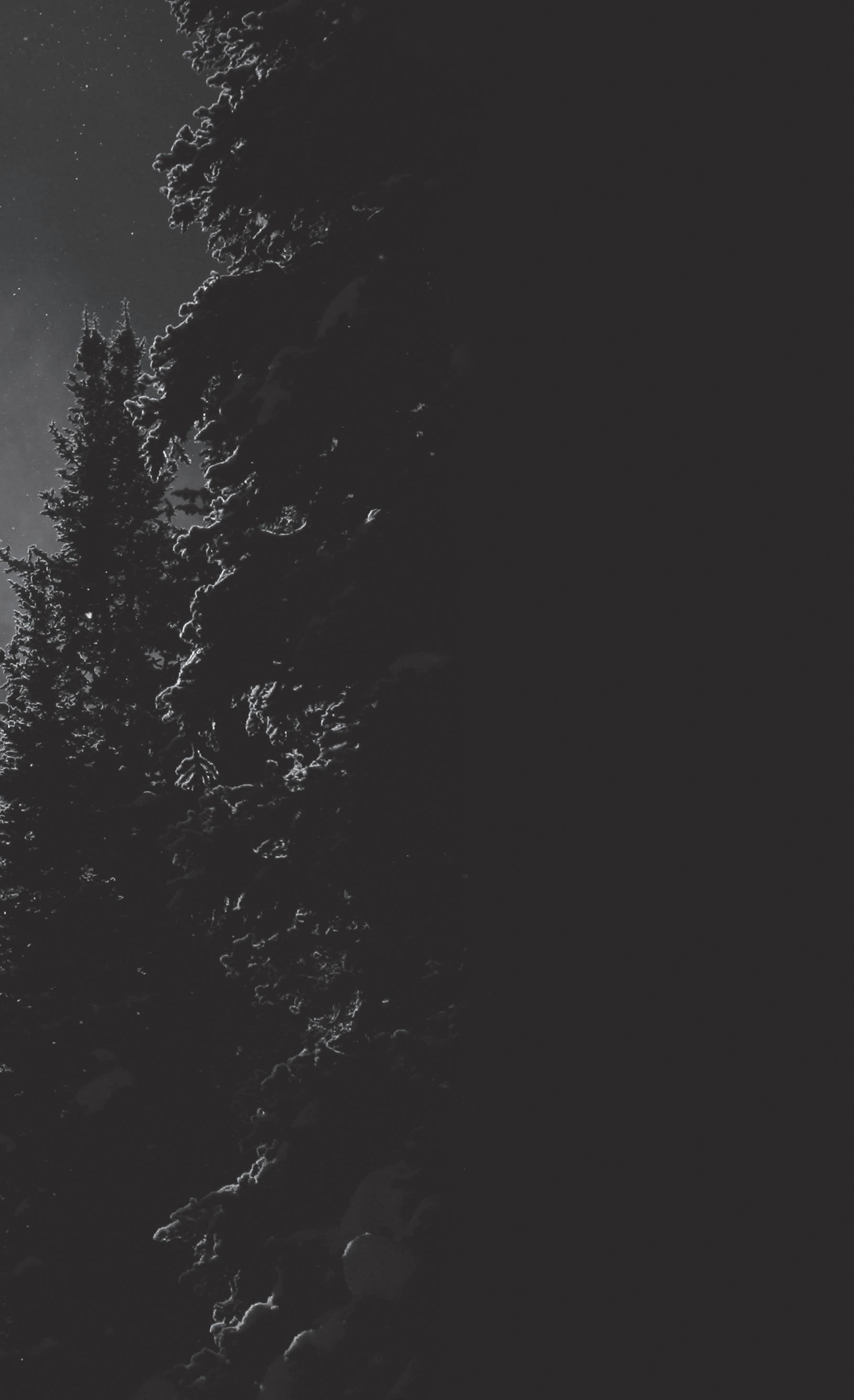
conversation I might have in 2040


I’m thinking of that Christmas morning, walking out back into a fresh dusting marked with deer tracks, meeting that sparkling clarity in the stillness
Jesus must have been talking about. I turned and went inside so easily hungry for the stacks beneath the martyred Ponderosa, not lingering the way I would now.
If I could meet the cold again and know the ache of toes returning to life or the way hot chocolate makes icy teeth shout, or drink enough water to spell your name in the snow and deliver the perfect snowball as testament of my love -
If I could take back that restless wanting and have one last chance to feel the way stars pierce deeper on a crystalline February night
I don’t think I’d wish for something different. I think I’d just say goodbye. -Kristopher Drummond
Dan Armstrong
UNLOAD HERE
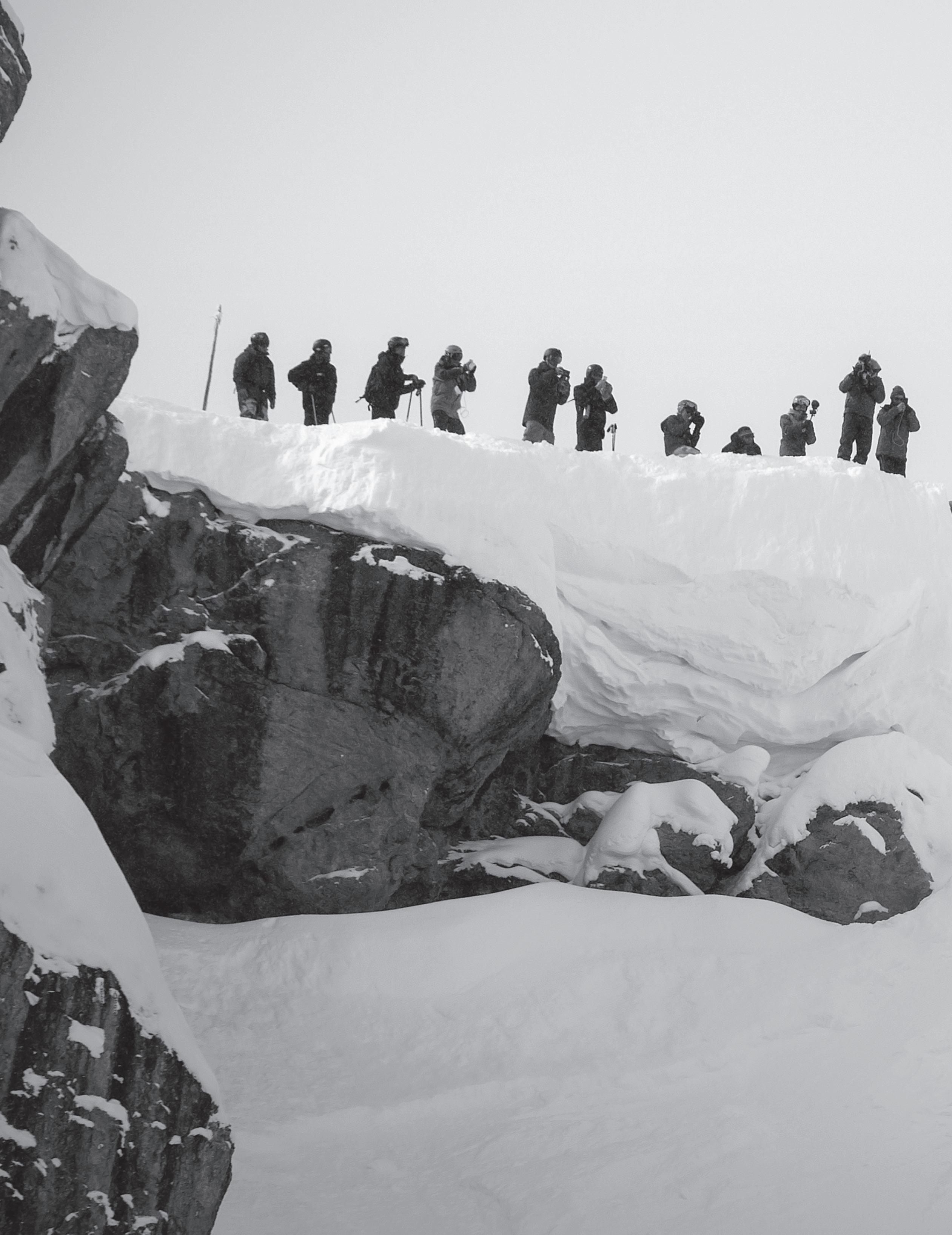
 Travis Andersen | Jeff Leger doing his signature leap into outer space with a backpack full of bubble wrap.
Travis Andersen | Jeff Leger doing his signature leap into outer space with a backpack full of bubble wrap.

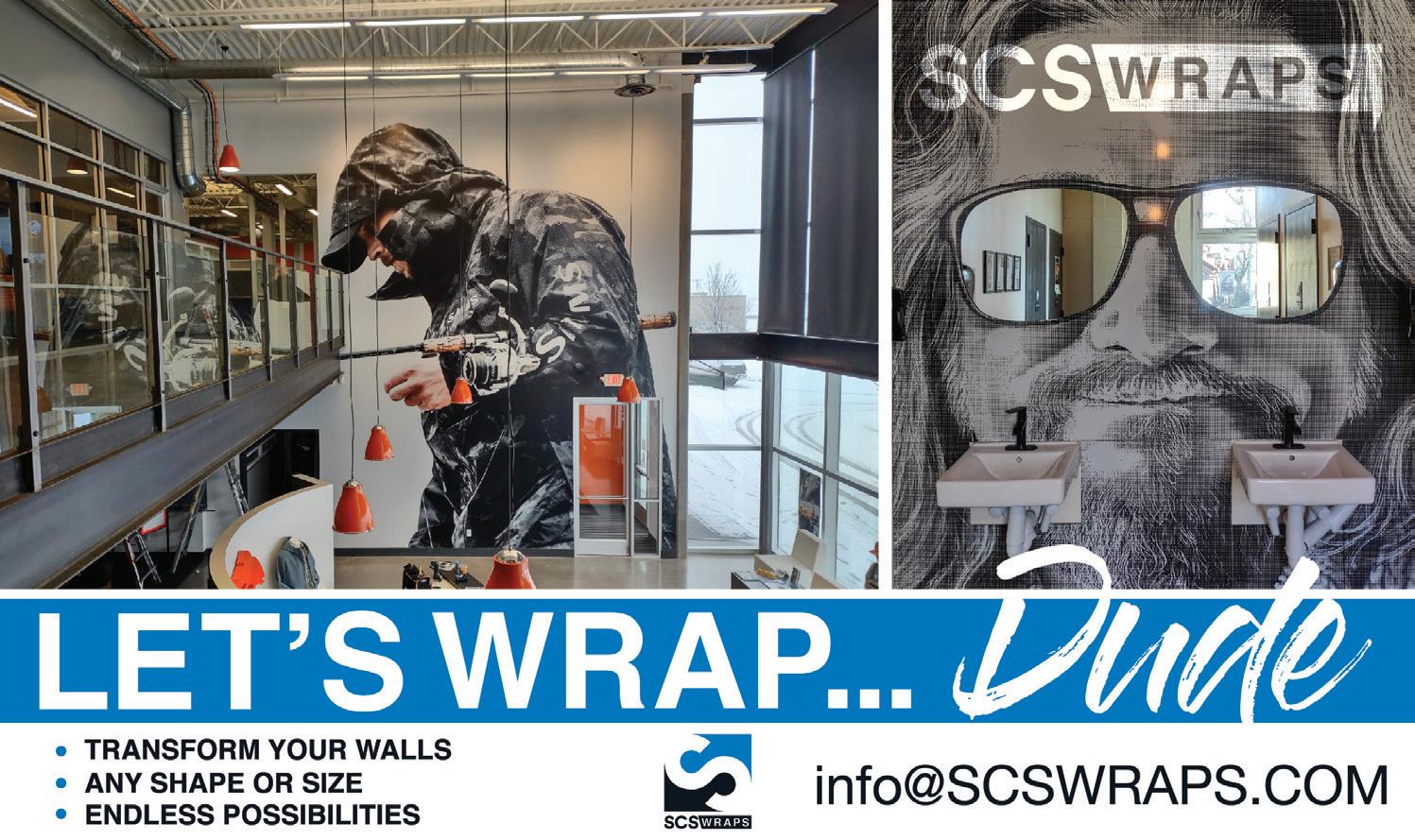

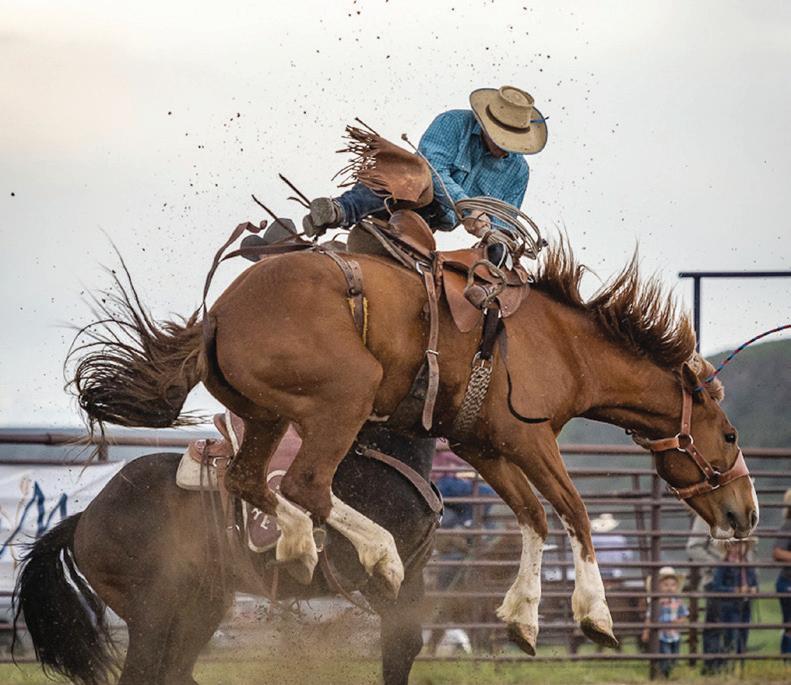
THANK YOUR LOCAL SPONSORS FULL REMODEL, FULL BAR, PIZZA BY THE SLICE + DRIVE THRU 1/4 Mile West of Four Corners OUTDOOR PATIO thebuckbozeman.com 406-522-9555
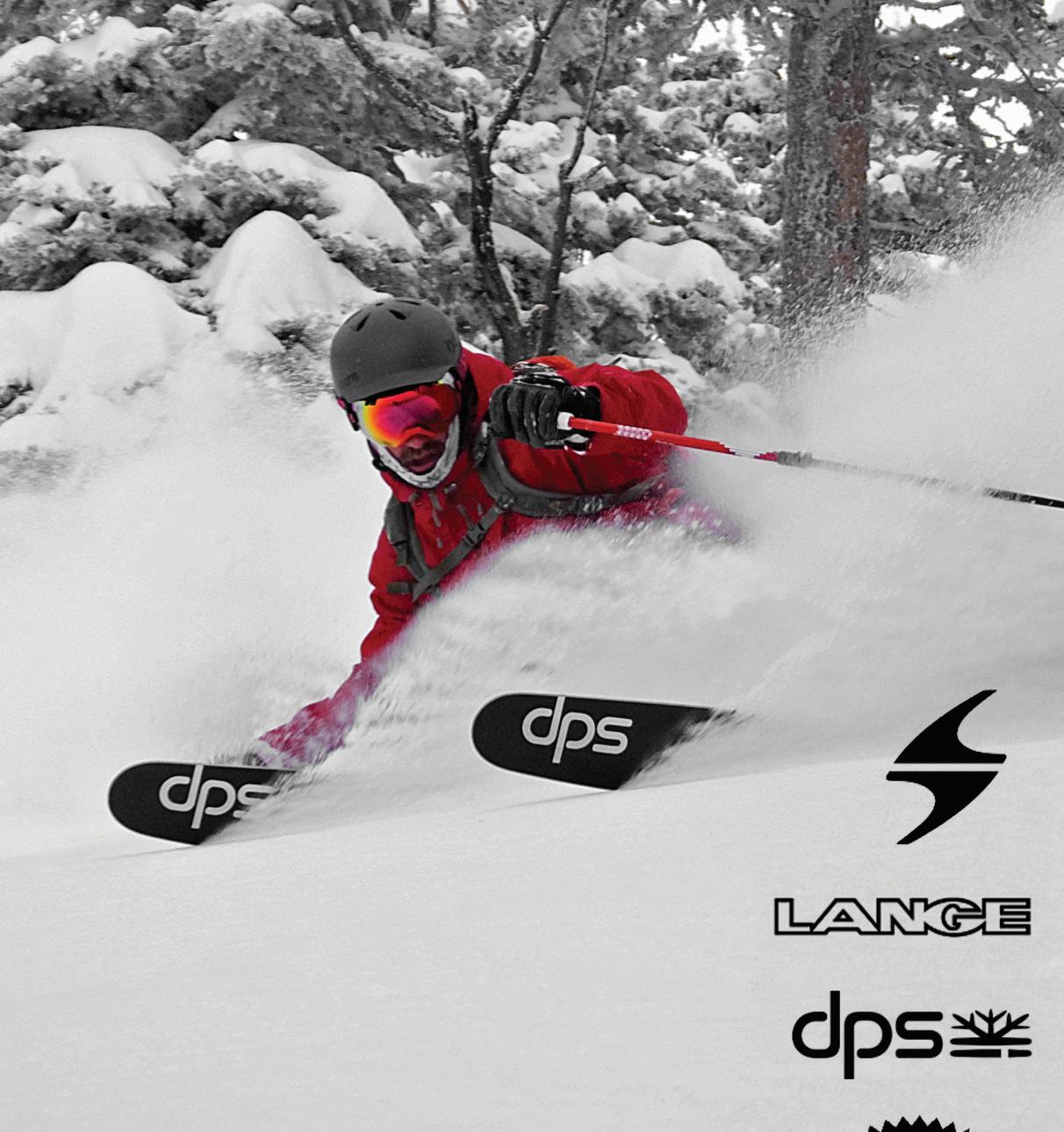


406 587 5227 SHOP LOCAL 2405 W. MAIN CALL More than snow skis. SUP | SURF | WAKE | SALES & RENTALS
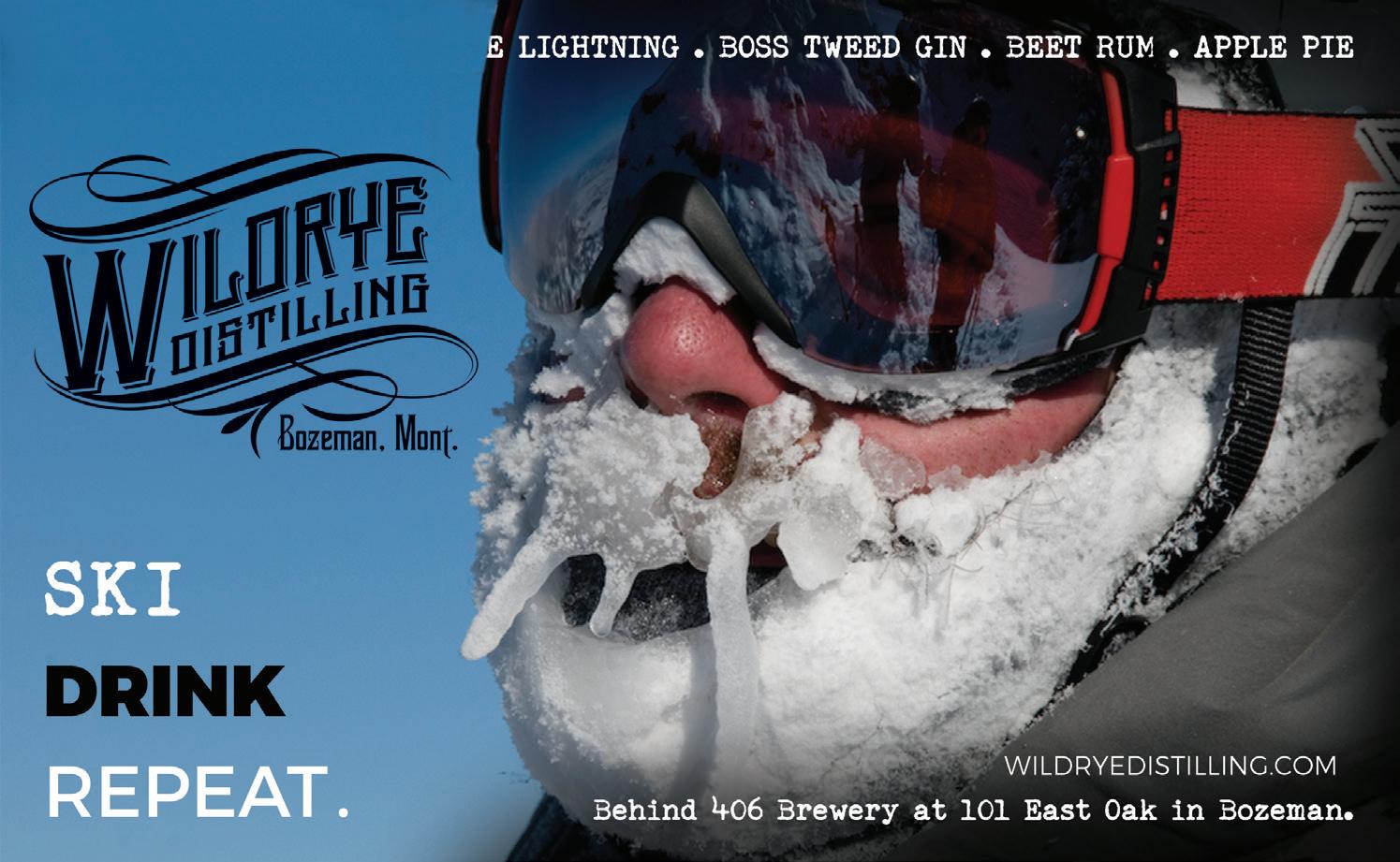



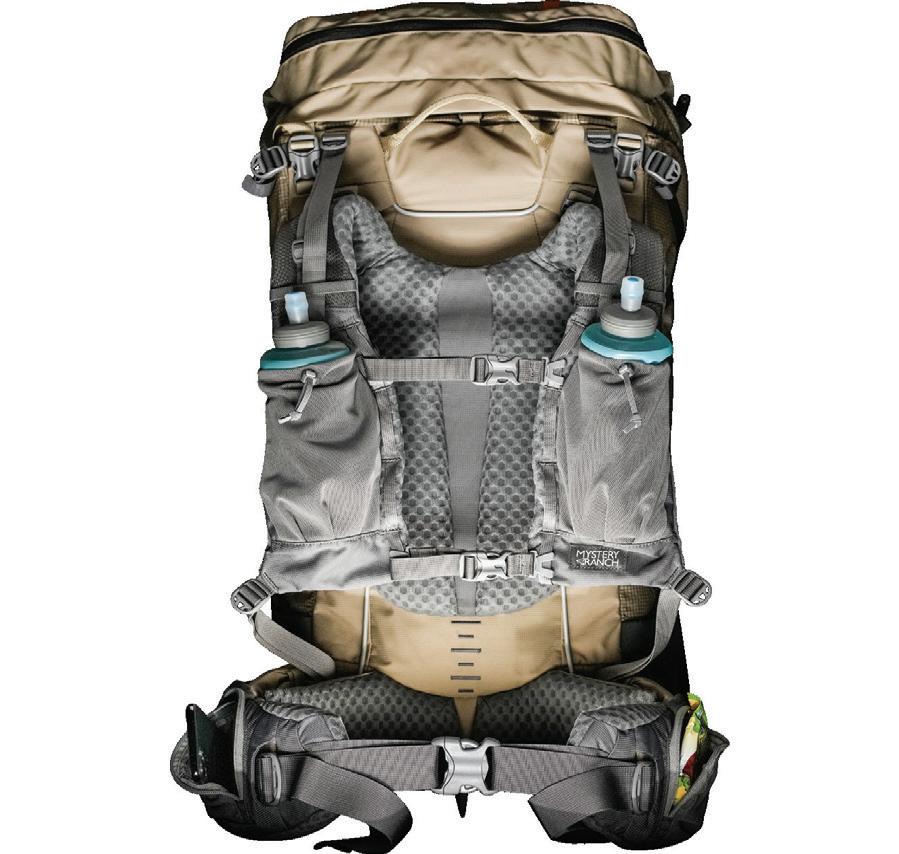
BOURBON RYE GIN VODKA APPLE PIE 111 E OAK ST. STE 1E IN THE CANNERY DISTRICT OPEN 3PM-8PM DAILY WILDRYEDISTILLING.COM REPEAT. THANK YOUR LOCAL SPONSORS 4900 EASY ACCESS TO YOUR ESSENTIALS Strategically placed pockets provide the perfect spot for all your go-to items. Mesh fabrics and a structured ventilation channel lets your heat escape. LET YOUR BACK BREATHE explore more at: mysteryranch.com INTRODUCING BRIDGER SERIES Super breathable and a place for everything.



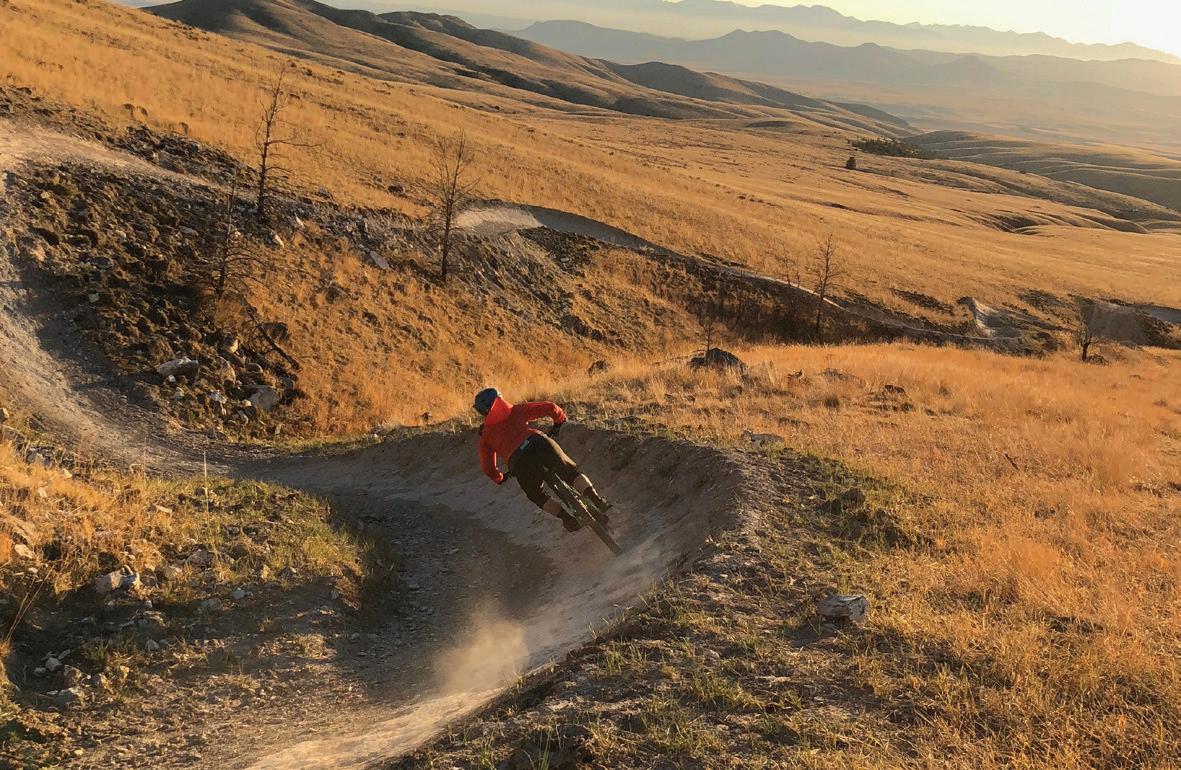

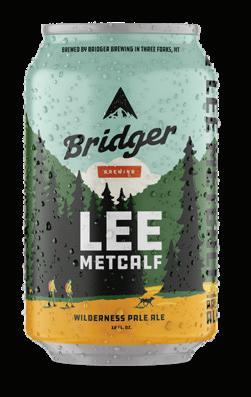
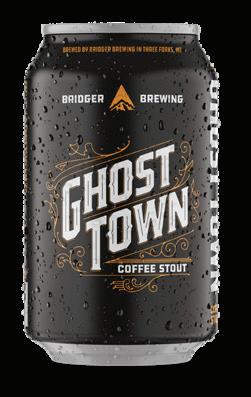
New bridger brewing location opening this summer bridgerbrewing.com BOZEMAN + THREE FORKS PACKABLE BRIDGER BREWS AVAILABLE THIS SUMMER.
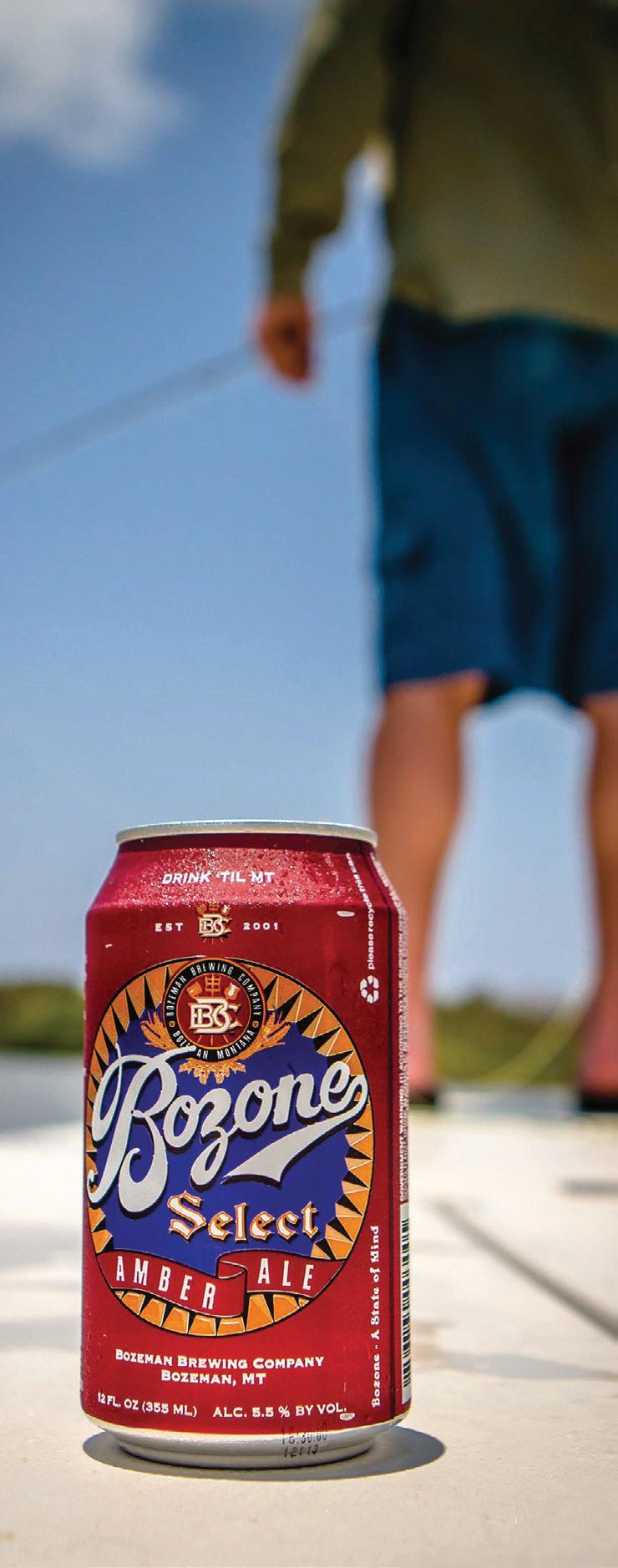


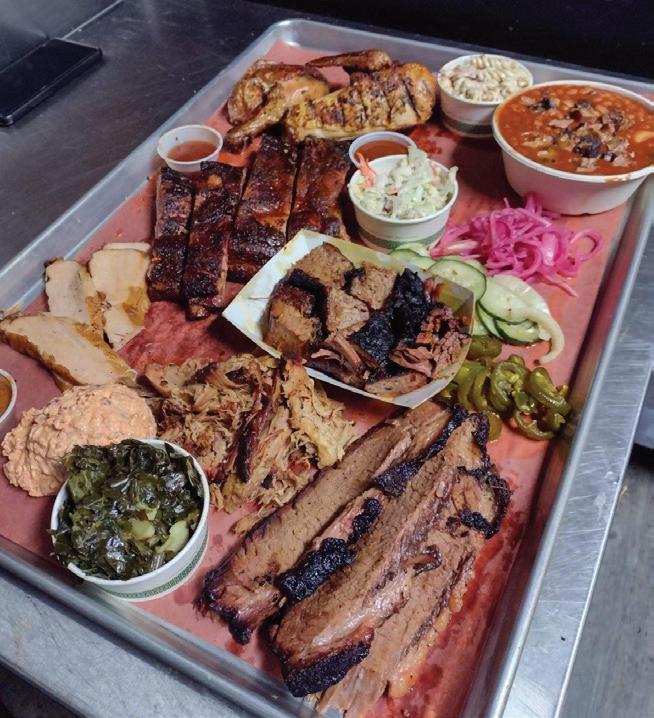




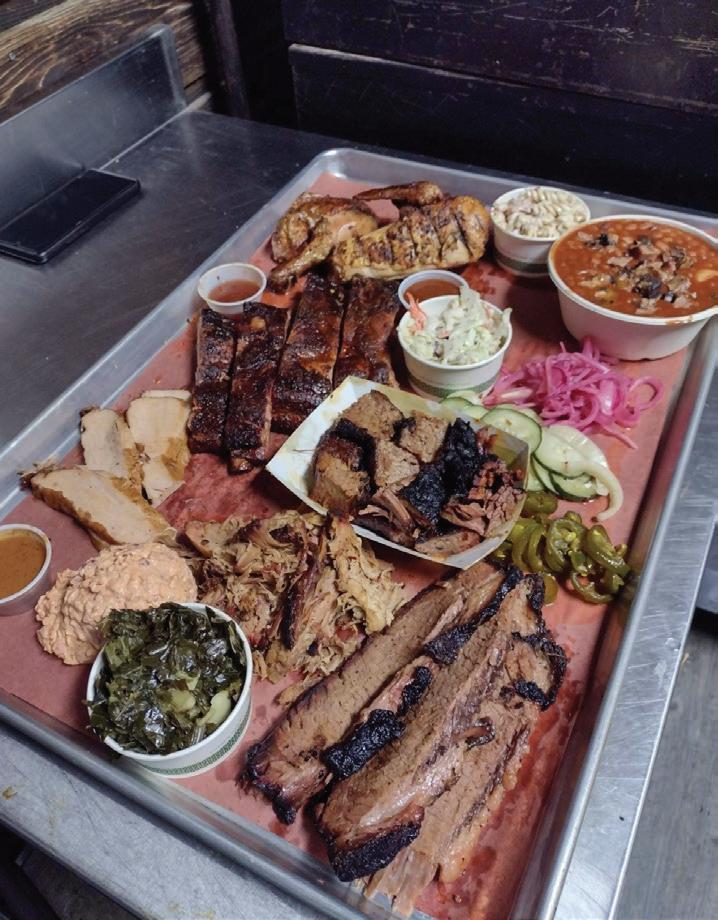

THANK YOUR LOCAL SPONSORS Gardiner, mt Smokewagon emigrant, mt 4 overlook rd. FollowYerNoseBBQ.com catering available catering@FollowYerNoseBBQ.com @followyernosebbq catering available catering@FollowYerNoseBBQ.com VIEWS, BREWS, & BBQs
SUMMER MUSIC LINEUP


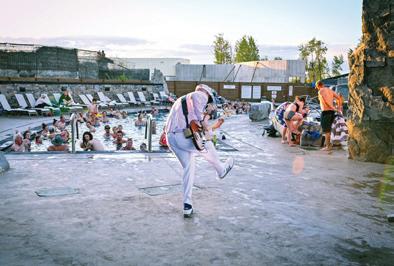
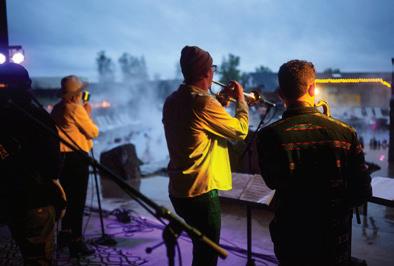
Thursday, July 14th: Charles Ellsworth: Americana | Sunday, July 17th: Benn & Abel: Americana
Thursday, July 21st: Ryan Acker: Acoustic Folk | Sunday, July 24th: Ticket Sauce: Cover Rock
Thursday, July 28th: Garrett Kuntz: Acoustic Folk | Sunday, July 31st: Mountain Standard Time: Rock
Thursday, August 4th: Tom Kirwan: Country | Sunday, August 7th: Hardwood Heart: Bluegrass
Thursday, August 11th: Sundae & Mr. Goessl: Vintage Jazz | Sunday, August 14th: Madeline Hawthorne Band: Country
Sunday, August 21st: Savvy – the Band: Cover Rock | Thursday, August 25th: Radio Ranch: Folk
Sunday, August 28th: Little Jane & the Pistol Whips: Country
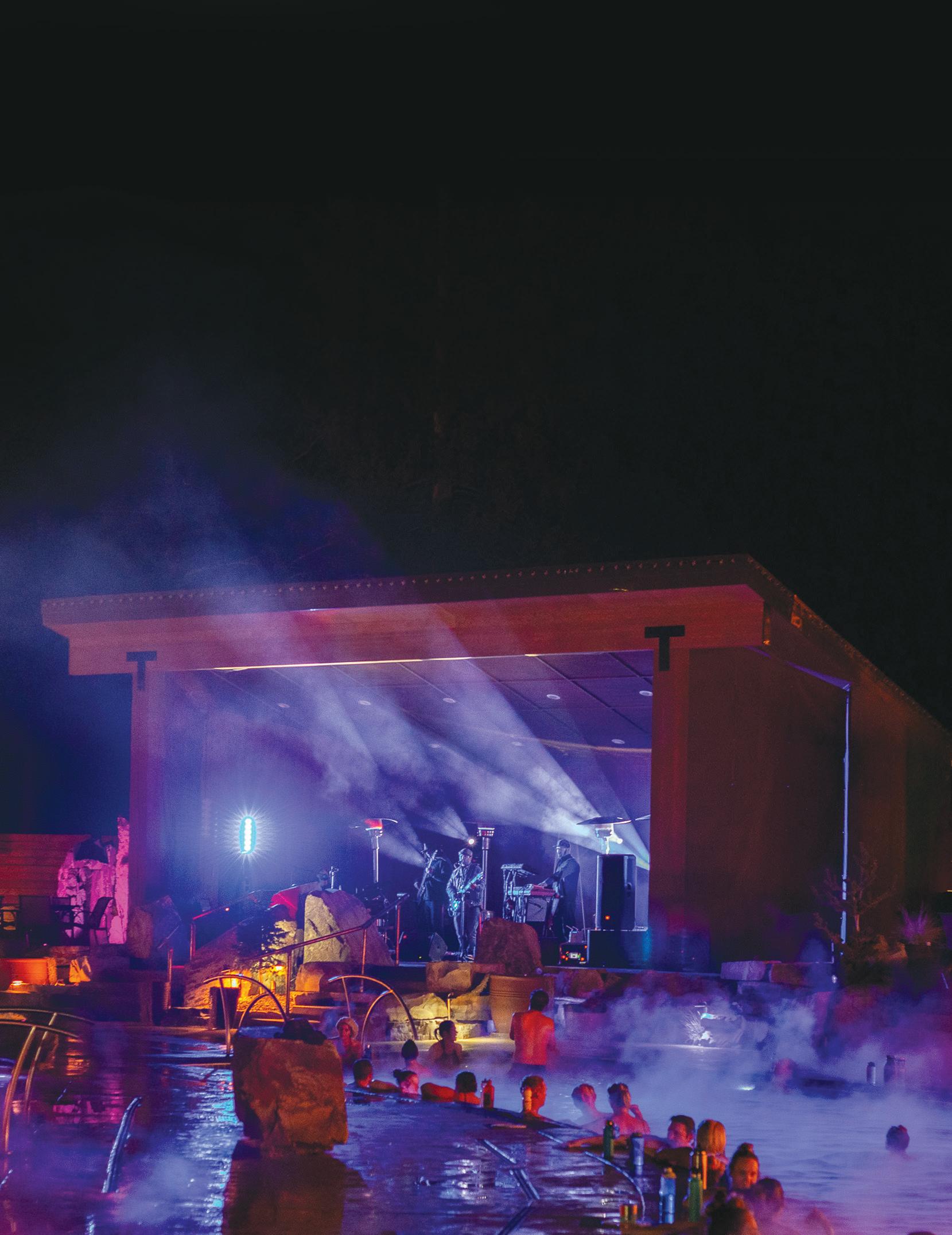


www.bozemanhotsprings.co


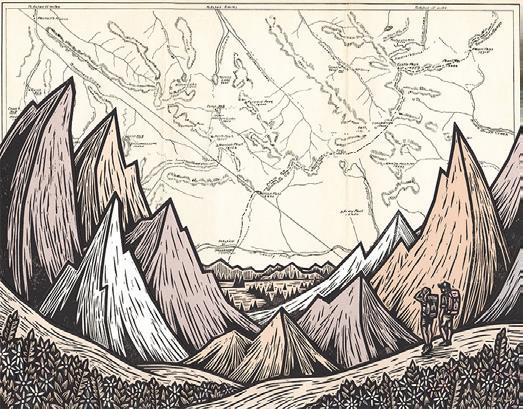

2230 W. Main / 406.586.7752 GRATEFULSHEDBOZEMAN.COM Top-Quality Products and Accessories for a Delightful Smoking EXPERIENCE THANK YOUR LOCAL SPONSORS www.johnfellows.bigcartel.com / instagram.com/jfellows56 The Artwork of JOHN FELLOWS For more information and to purchase prints, visit: John Fellows is a Crested Butte, Colorado based creative whos signature “contemporary folk” style weaves together layers of found paper, graphic block prints and handwritten text to create an old time, hands-on feel. He collects a variety of found paper, maps and books dating from the 1880’s to the present to create unique linoleum carving collages that while at the very base reflect his personal experiences, are more like a brief glimpse into someone else’s story. John has exhibited artwork in Japan, Spain, Australia, Canada and around the US and has worked with clients such as Patagonia, Smartwool, Element Skateboards, Salomon Skis, Weston Snowboards, the Banff Mountain Film Festival and of course, BombSnow Magazine. ORIGINAL ARTWORK, GICLEES, SCREEN PRINTS, BUFFS, ZINES & MORE CRESTED BUTTE, COLORADO

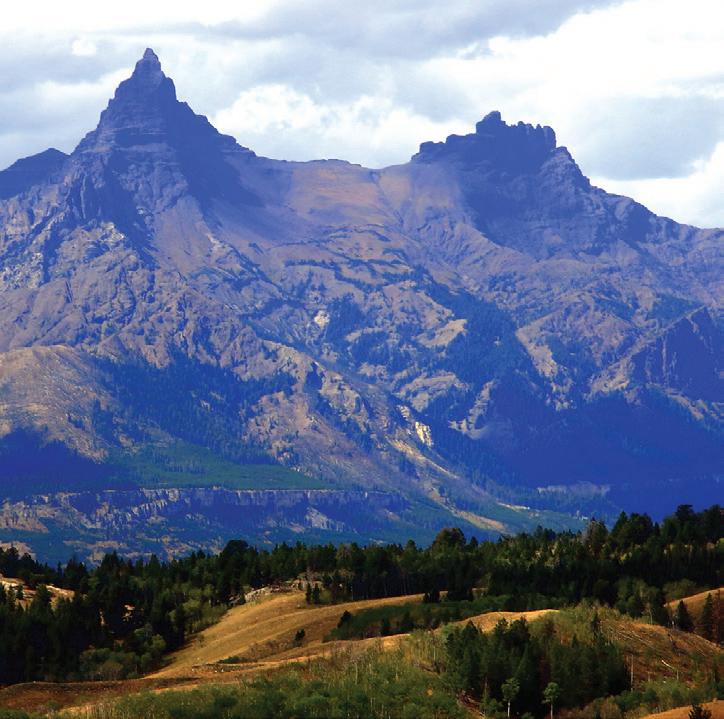
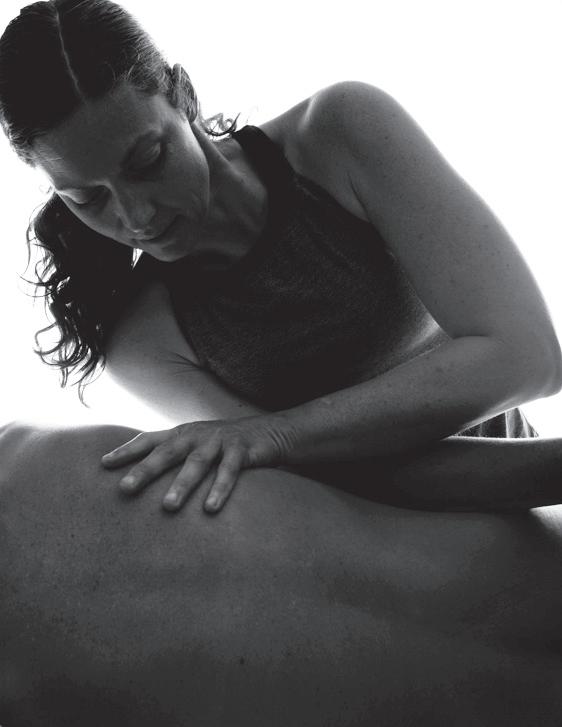
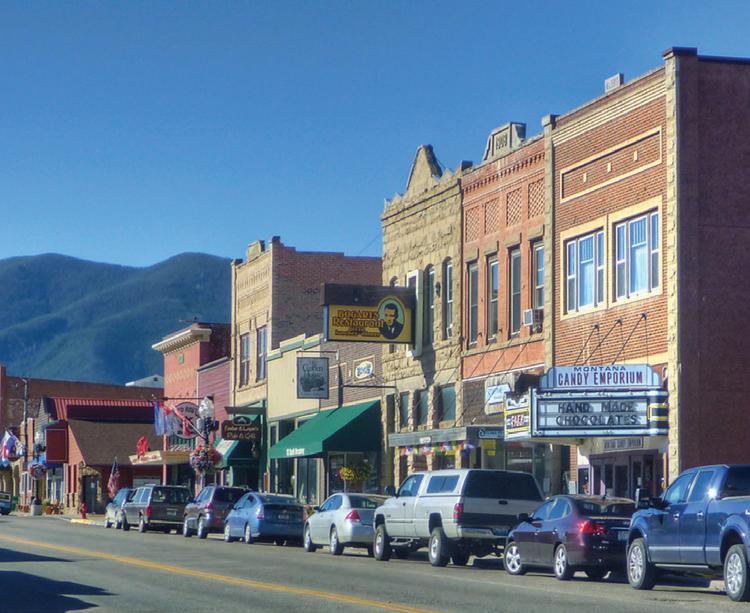
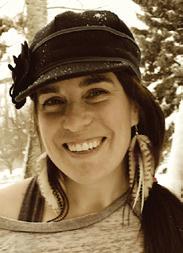


Liz Welles, Licensed REALTOR® at Small Dog Realty | 1970 Stadium Drive, Suite 1 Bozeman, Montana 59715 | www.lizwelles.com | lizwelles@smalldogrealty.com 406-581-4130 support your local communities support your local realtor. Yellowstone Gateway communities rely on tourism revenue and need your support now more than ever. www.lisalouisewortman.com LISA WORTMAN BODYWORK Now, until the end of August, I will be contributing 10% of my commision to the flooding relief fund.
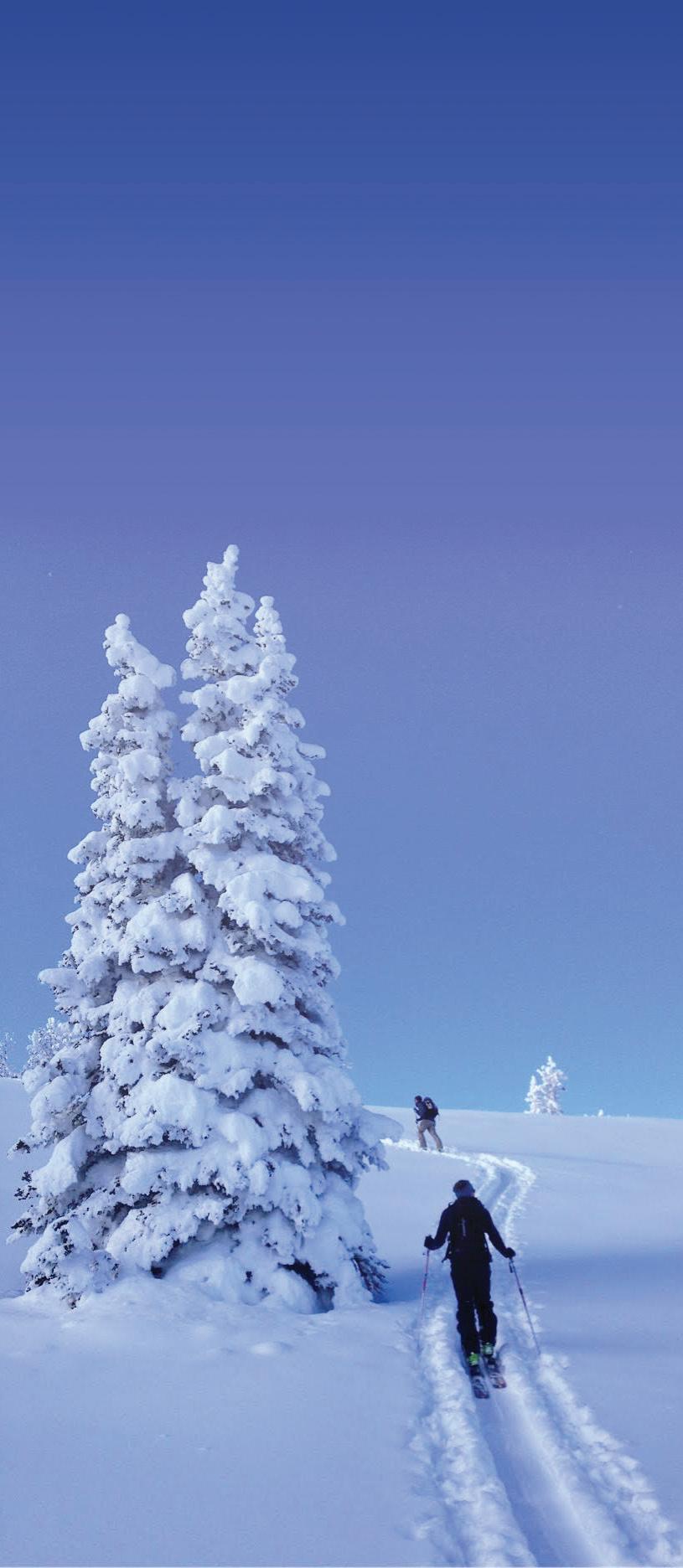


WED + THURS MUSIC! LIVE (406) KITCHEN IS OPEN 2-10PM MON-FRI and 11-10PM SAT-SUN HAPPY HOUR EVERYDAY 3-6PM | BOZEMANTAPROOM.COM THANK YOUR LOCAL SPONSORS
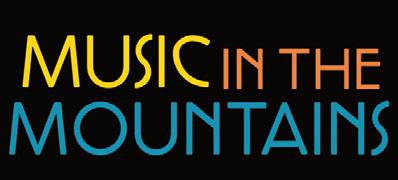
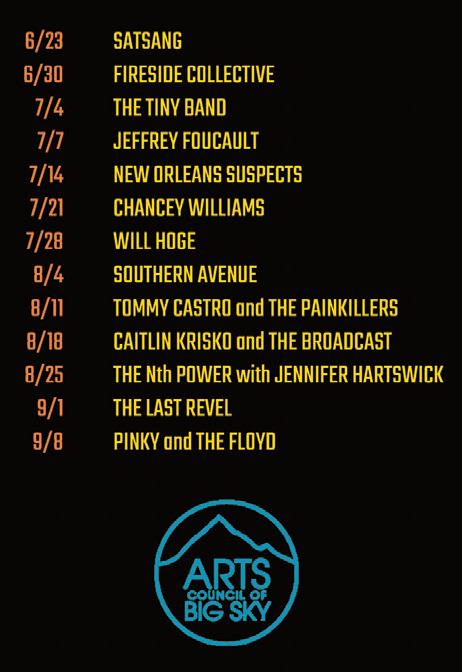
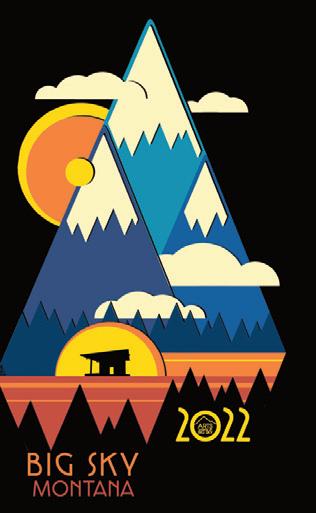
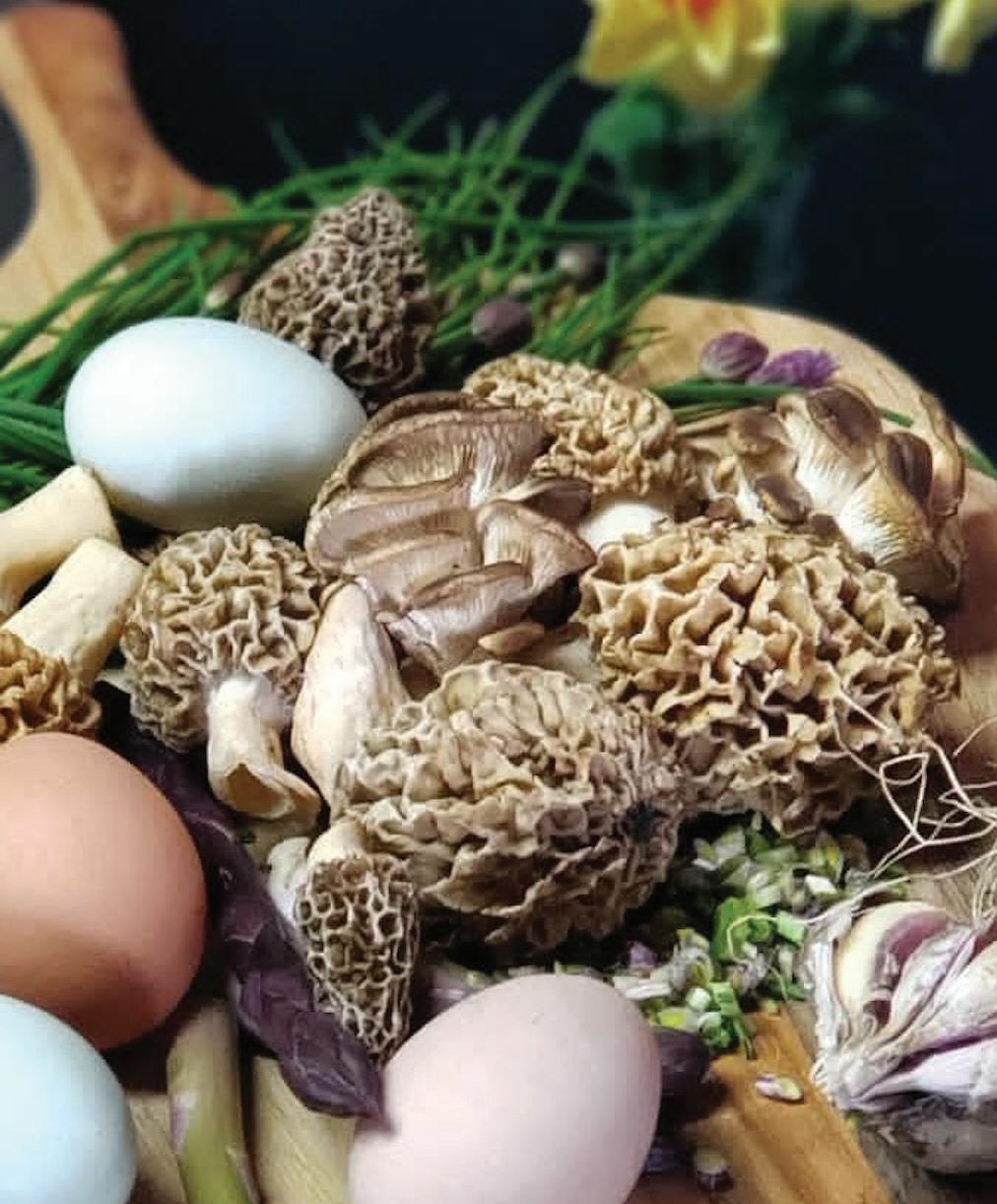
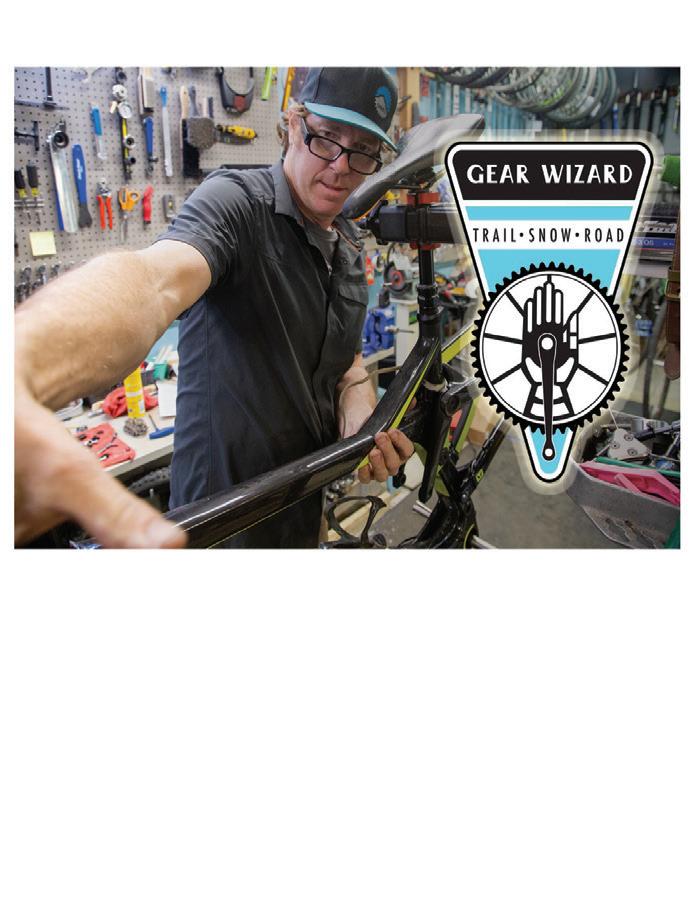


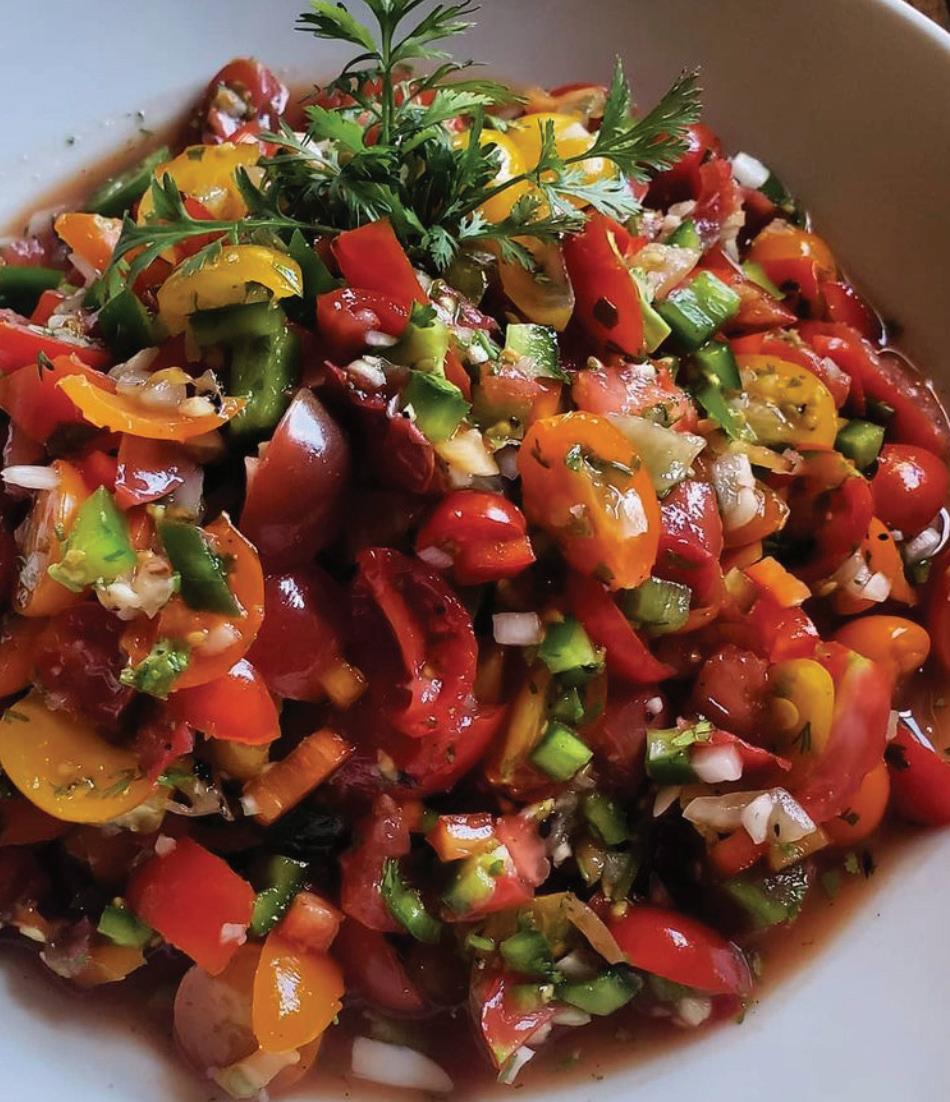
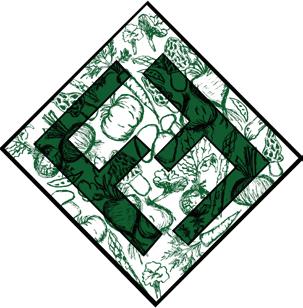



ALL CONCERTS TAKE PLACE IN BIG SKY’S LEN HILL PARK PARK OPENS AT 6 P.M. WITH OPENING BANDS AT 6:30 P.M. FOOD/BEVERAGES AVAILABLE NO PETS/GLASS/SMOKING BIGSKYARTS.ORG 2022
FARM PRIVATE CHEF OFFERING LOCAL, SEASONAL FOOD. 307-690-2339 FROM MY email: fcanterbury3@gmail.com SUSTAINABLE MEALS CATERED IN THE PRIVACY OF YOUR OWN HOME, CUSTOM FIT TO YOUR NEEDS. freshfrank406 FORK TO YOUR
Artwork by Andy Putnam
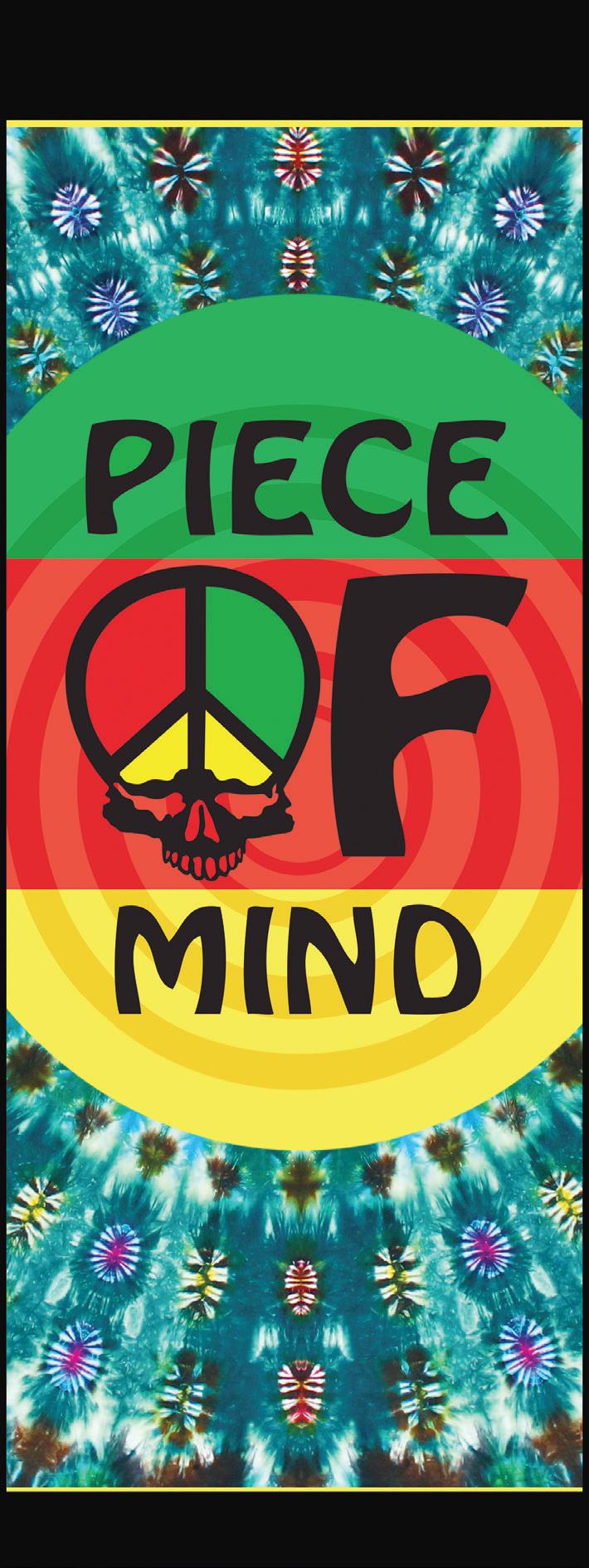
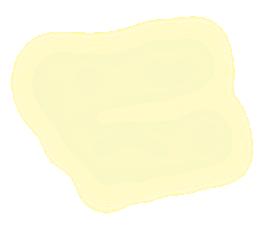
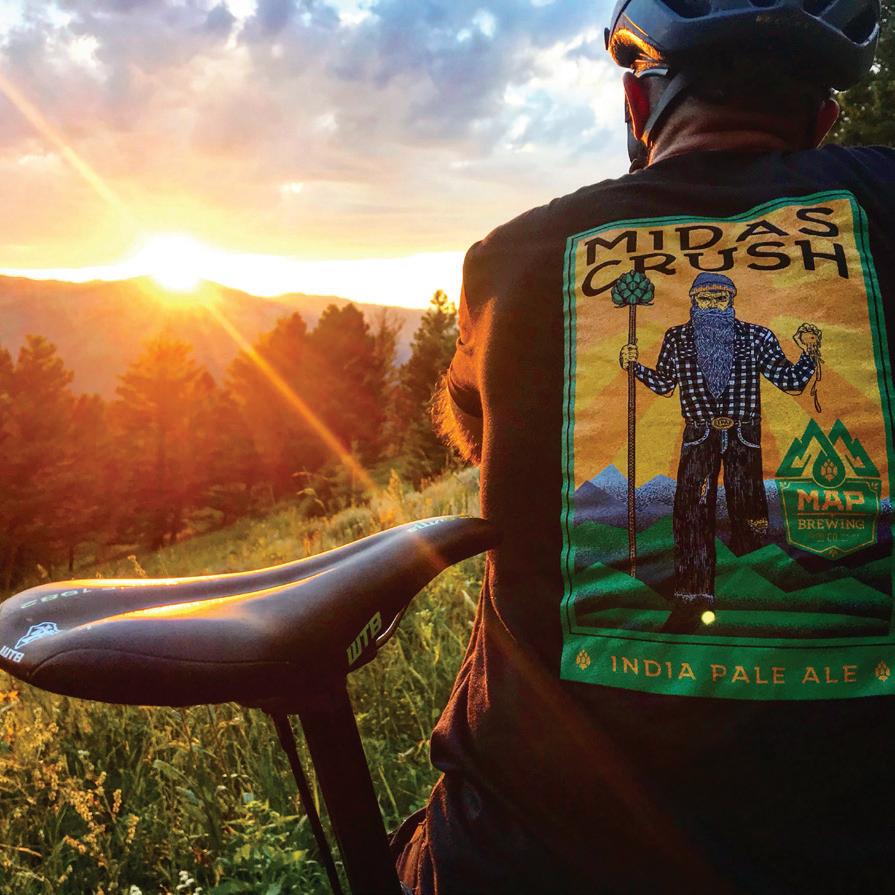

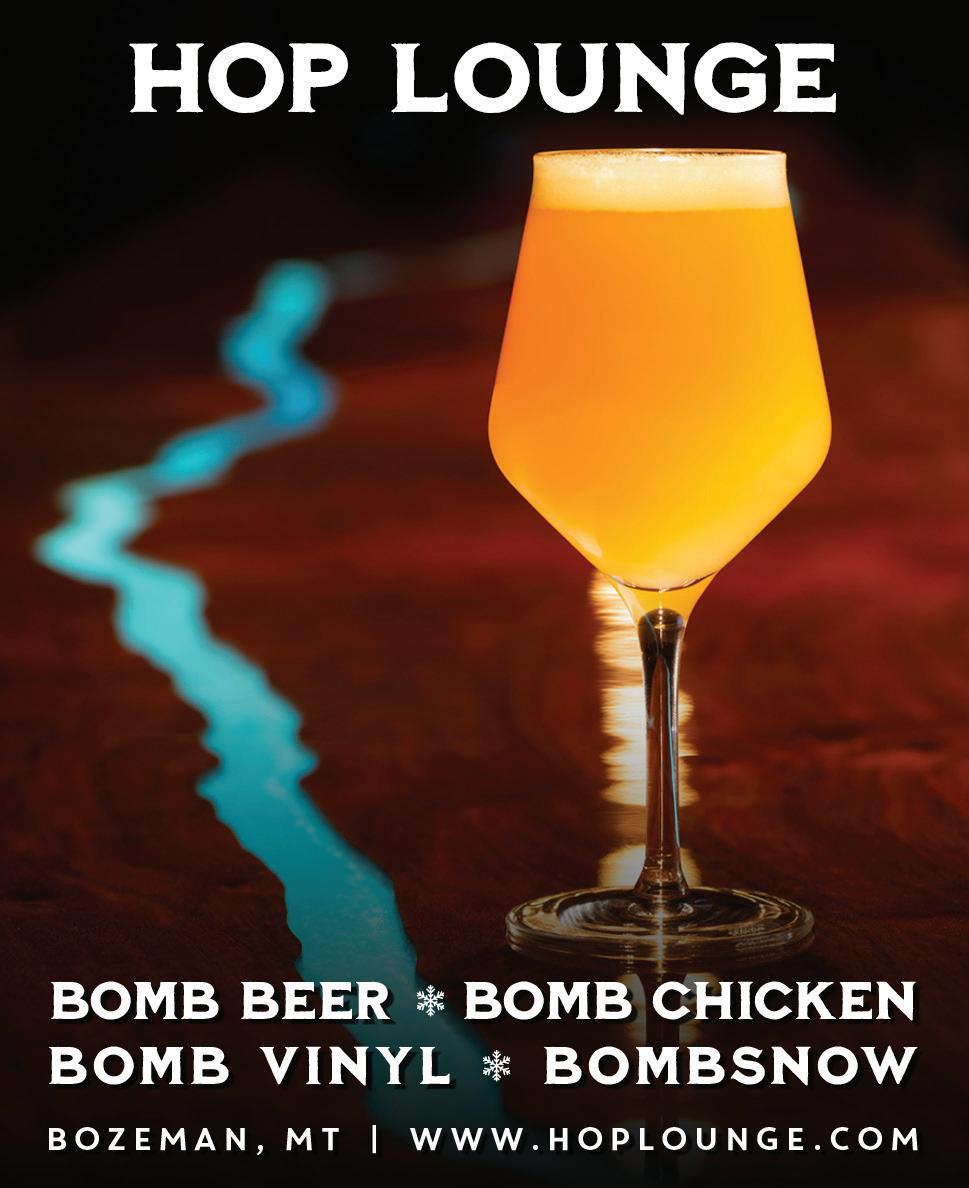


www.Mapbrewing.com BRINGING THE FINEST REGIONAL & LOCAL GLASS TO THE MISSOULA AREA. CALL- 406.830.3206 123 W. MAIN | OPEN MON-SAT 10AM-9PM AND SUN 12-8PM THANK YOUR LOCAL SPONSORS
“Need a house without wheels?”
Things can get a little messy if you buy a house without a professional.
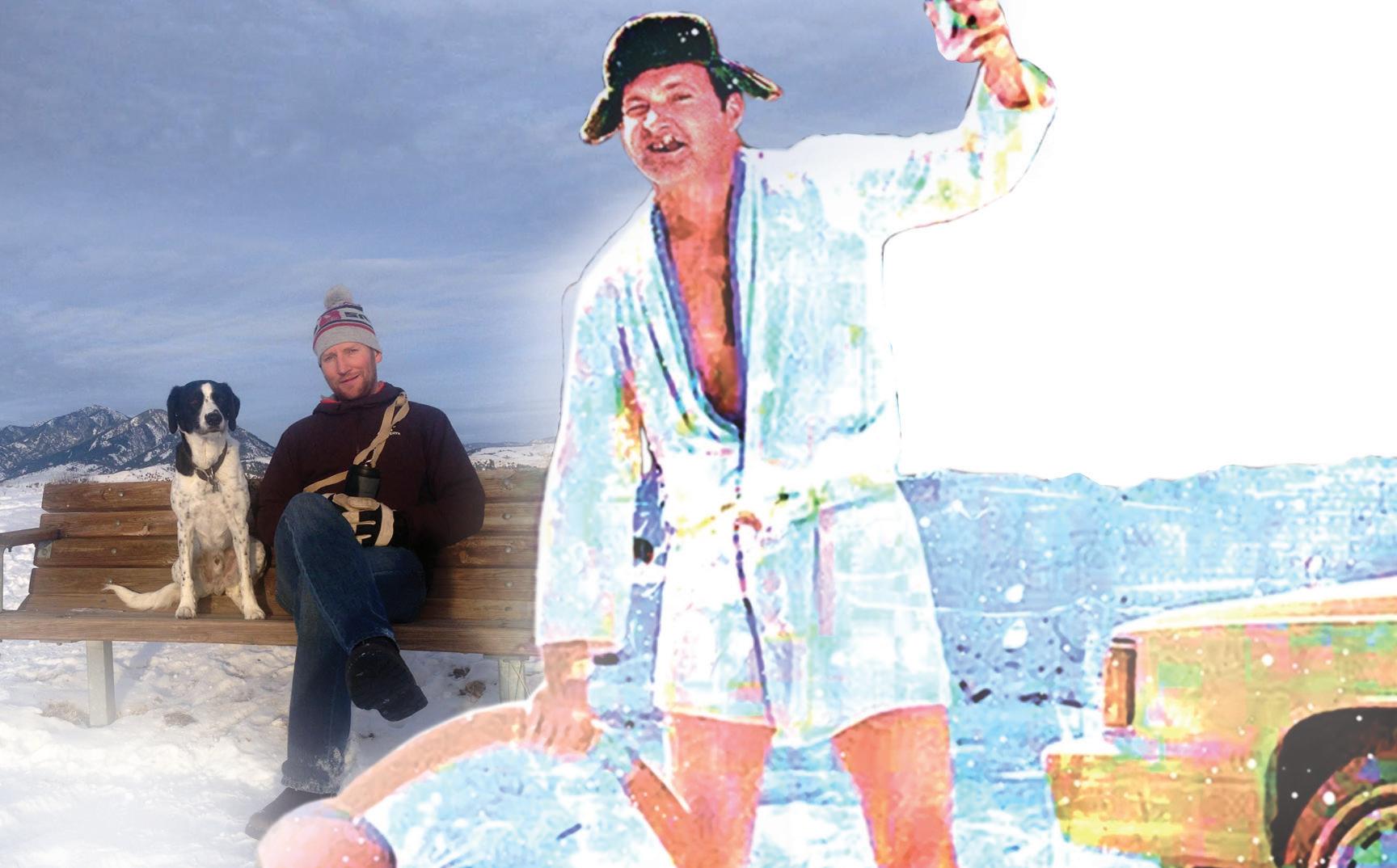 Eddie Steinhauer Broker/ Partner
Eddie Steinhauer Broker/ Partner


- Make sure you call the right Eddie.
HEADQUARTERS



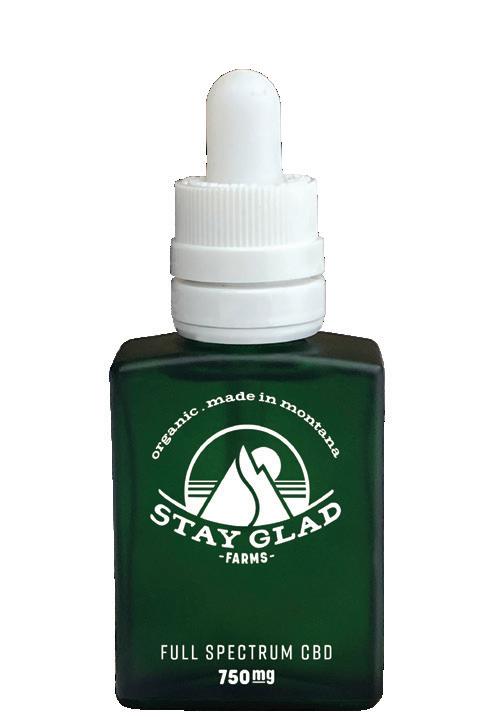
EFFECTIVE FULL SPECTRUM CBD OIL | STATE TESTED NOT YOUR GAS STATION CBD | A LITTLE DAB WILL DO YA Smiling all day keeps the doctor away Call us at: 406-600-8407 to receive 20 bucks off your first bottle. Planted, harvested, and bottled in Montana Organically grown on the banks of the Jefferson STAY GLAD FARMS, WHITEHALL MT STAY GLAD IS COMPLIANT UNDER MT STATE HEMP LAW + the 2018 FARM BILL | STAYGLADFARMS.com



mthappyhour.com Old Montana still exists Dude, Stay Happy, Drink Local: FIND ALL OF THE BEST HAPPY HOUR SPECIALS IN MONTANA. a few hours per day...

Support the Independent Print Revival. BombsNOW.COM
$14.99

 Photo & Art Annual Bomb Snow.
Photo & Art Annual Bomb Snow.






























































 Snowboarding allows endless creativity under any circumstances, even when the snow barely exists. Blotto | Jeremy Jones, Mt. Hood
Snowboarding allows endless creativity under any circumstances, even when the snow barely exists. Blotto | Jeremy Jones, Mt. Hood












 A good clean run-out for Frederik Kalbermatten, so satisfying for both the rider and film crew. Blotto
A good clean run-out for Frederik Kalbermatten, so satisfying for both the rider and film crew. Blotto


























 | Shea Dugall with Muzbe the pup. Copper City.
| Shea Dugall with Muzbe the pup. Copper City.


 WORDS Ethan A. Stewart Tate Chamberlin’s Tension-Filled Trajectory
WORDS Ethan A. Stewart Tate Chamberlin’s Tension-Filled Trajectory




 | High above the Blunderbuss compound.
Dan Armstrong
| High above the Blunderbuss compound.
Dan Armstrong



























 The day after the avalanche we tried to carry Kim out on a jury-rigged stretcher, but it was too painful on his broken vertebrae. Instead, we gave him morphine, and he walked the remaining three days to the trailhead.
Rick Ridgeway
Chris Chandler on the summit of Everest, in extreme wind, holding onto a survey tripod placed by a Chinese team the previous year. Bob Cormack
The day after the avalanche we tried to carry Kim out on a jury-rigged stretcher, but it was too painful on his broken vertebrae. Instead, we gave him morphine, and he walked the remaining three days to the trailhead.
Rick Ridgeway
Chris Chandler on the summit of Everest, in extreme wind, holding onto a survey tripod placed by a Chinese team the previous year. Bob Cormack


 Lear Levin Jennifer and Rick in 1982 shortly after we married, in front of my surfer’s shack “just south of Montecito.”
Tom Brokaw, on his first snow and ice climb, skirts a crevasse on the Kautz Glacier, Mount Rainer. Rick Ridgeway
Lear Levin Jennifer and Rick in 1982 shortly after we married, in front of my surfer’s shack “just south of Montecito.”
Tom Brokaw, on his first snow and ice climb, skirts a crevasse on the Kautz Glacier, Mount Rainer. Rick Ridgeway


 Chris Chandler (kneeling) and I puzzle-out a potential route through the Khumbu Icefall. This is the most dangerous part of climbing Everest from the Nepal side. Today teams of Sherpas scout and maintain the route for clients paying guide services over $100,000. Back in the 1970s, we had to establish the route ourselves. Johan Reinhard
Rick Ridgeway sporting one of the carts from his Tibetan Plateau expedition while en route to a booksigning event last December in Bozeman. Conrad Anker
Chris Chandler (kneeling) and I puzzle-out a potential route through the Khumbu Icefall. This is the most dangerous part of climbing Everest from the Nepal side. Today teams of Sherpas scout and maintain the route for clients paying guide services over $100,000. Back in the 1970s, we had to establish the route ourselves. Johan Reinhard
Rick Ridgeway sporting one of the carts from his Tibetan Plateau expedition while en route to a booksigning event last December in Bozeman. Conrad Anker















 -Cy Whitling
-Cy Whitling


















 Grant Gunderson
Grant Gunderson
 | Henrik Harlaut was in town visiting and shredding with Sammy, and we thought it’d be dope if they got in a doubles line to start up the day. Another magic day in the mountains.
Daniel Stewart
| Henrik Harlaut was in town visiting and shredding with Sammy, and we thought it’d be dope if they got in a doubles line to start up the day. Another magic day in the mountains.
Daniel Stewart


 Tal Roberts | Chase Josey
Tal Roberts | Chase Josey

 | The alpine meadow a day or two after the storm, in a highly trafficked meadow in Revelstoke. Even on this day we found the goods. You just gotta keep exploring around the next corner.
Daniel Stewart
| The alpine meadow a day or two after the storm, in a highly trafficked meadow in Revelstoke. Even on this day we found the goods. You just gotta keep exploring around the next corner.
Daniel Stewart



 | One man’s shipwreck is another man’s sandbar. Cutting back to the source in a faraway land.
Seth de Roulet
| One man’s shipwreck is another man’s sandbar. Cutting back to the source in a faraway land.
Seth de Roulet

 The real breakfast of champions. Sunrise through the tube along the coast of California.
Branden Aroyan
Sarah Grangeon | Tyler Nyman launches above the barrel.
The real breakfast of champions. Sunrise through the tube along the coast of California.
Branden Aroyan
Sarah Grangeon | Tyler Nyman launches above the barrel.
 Iris Lazzareschi paints her canvas. Amy Jimmerson
Iris Lazzareschi paints her canvas. Amy Jimmerson




 Daniel Stewart
Amy Jimmerson
Camila Brown post speed check.
Daniel Stewart
Amy Jimmerson
Camila Brown post speed check.
 Tal Roberts | Sawtooth Mtns. Double Exposure
Tal Roberts | Sawtooth Mtns. Double Exposure






 Grant Gunderson | Rider: KC Deane
Grant Gunderson | Rider: KC Deane

 Colton Stiffler | Early morning moonset, over an other-worldly landscape, deep in the Montana wilderness.
Colton Stiffler | Early morning moonset, over an other-worldly landscape, deep in the Montana wilderness.

 Colton Stiffler | Traversing through the infinite labyrinth of crevassed icy spires on Perito Moreno Glacier in the Argentine Patagonia.
Colton Stiffler | Traversing through the infinite labyrinth of crevassed icy spires on Perito Moreno Glacier in the Argentine Patagonia.








 Artist: Matt Stikker Skater: Frank Shaw
Artist: Matt Stikker Skater: Frank Shaw



 Artist: Ashley Dreyfus
Skater Above: Mikey Carpenter
Filmer: Adam Robo
Snowboarder: Len Jorgensen
Artist: Ashley Dreyfus
Skater Above: Mikey Carpenter
Filmer: Adam Robo
Snowboarder: Len Jorgensen


 Artist: Lucas Beaufort
Artist: Lucas Beaufort

 Artist: Rudi Broschofsky | Skater: Jess Mudgett
Artist: Rudi Broschofsky | Skater: Jess Mudgett
























 The Guide Author: Peter Heller
The Guide Author: Peter Heller



























 Travis Andersen | Jeff Leger doing his signature leap into outer space with a backpack full of bubble wrap.
Travis Andersen | Jeff Leger doing his signature leap into outer space with a backpack full of bubble wrap.




































































 Eddie Steinhauer Broker/ Partner
Eddie Steinhauer Broker/ Partner









